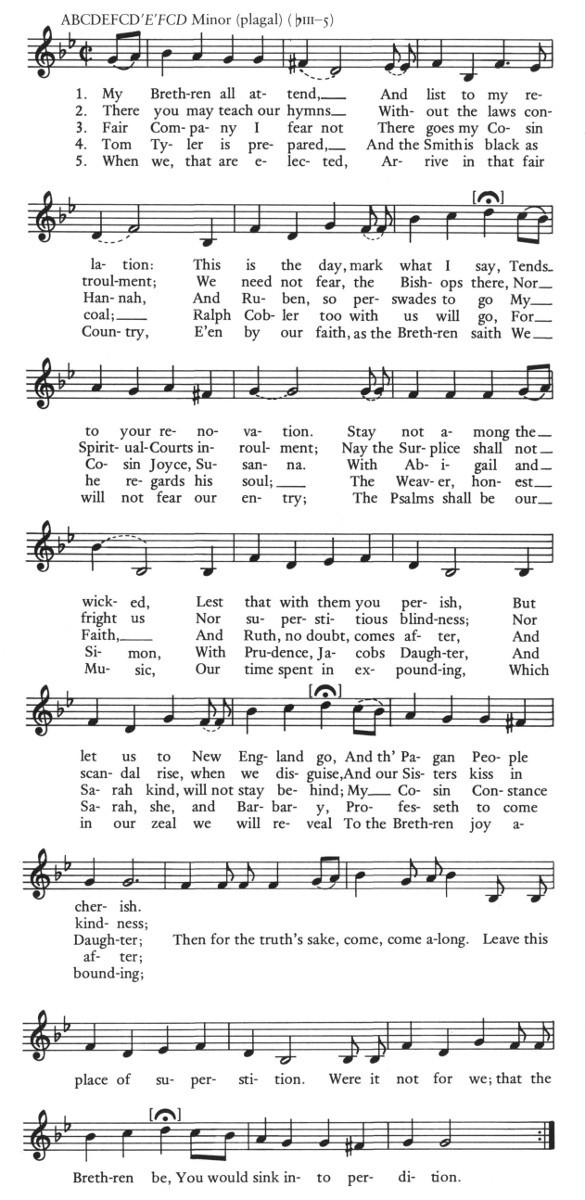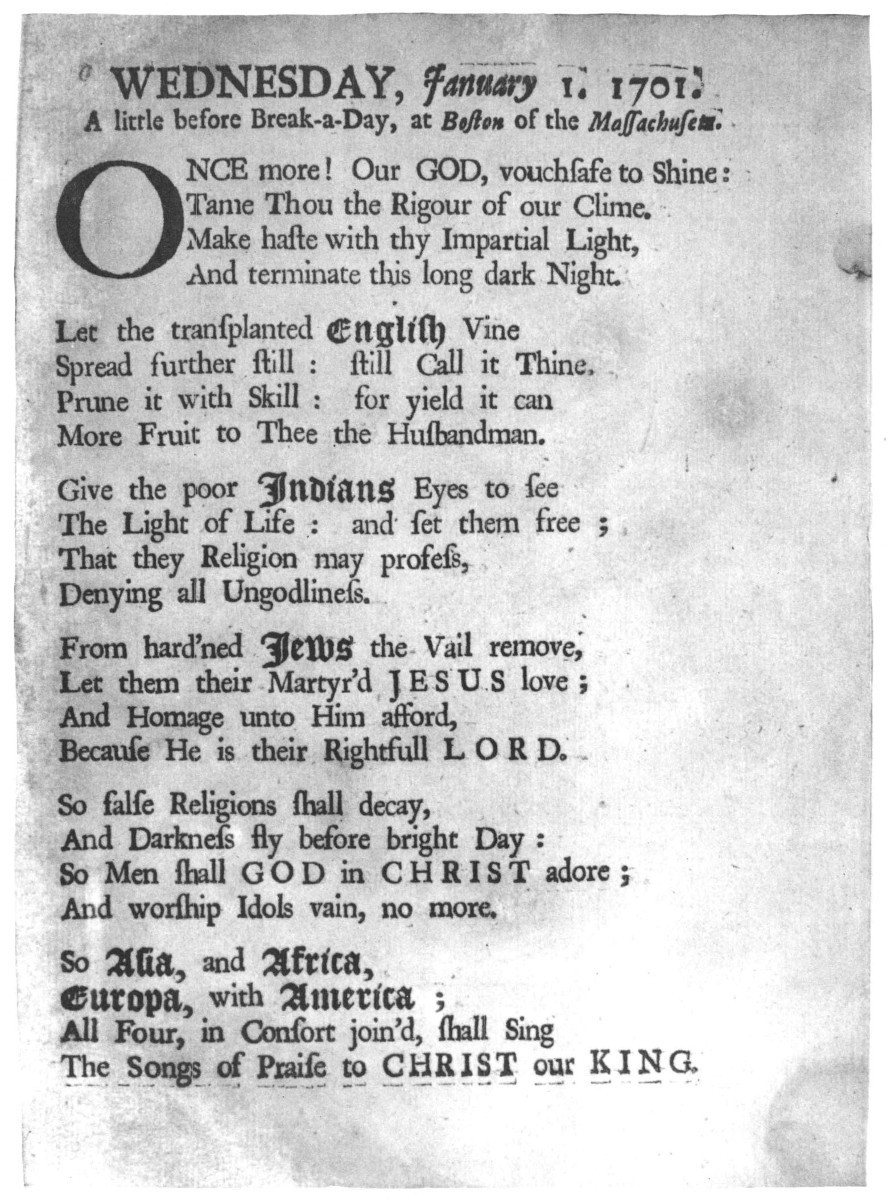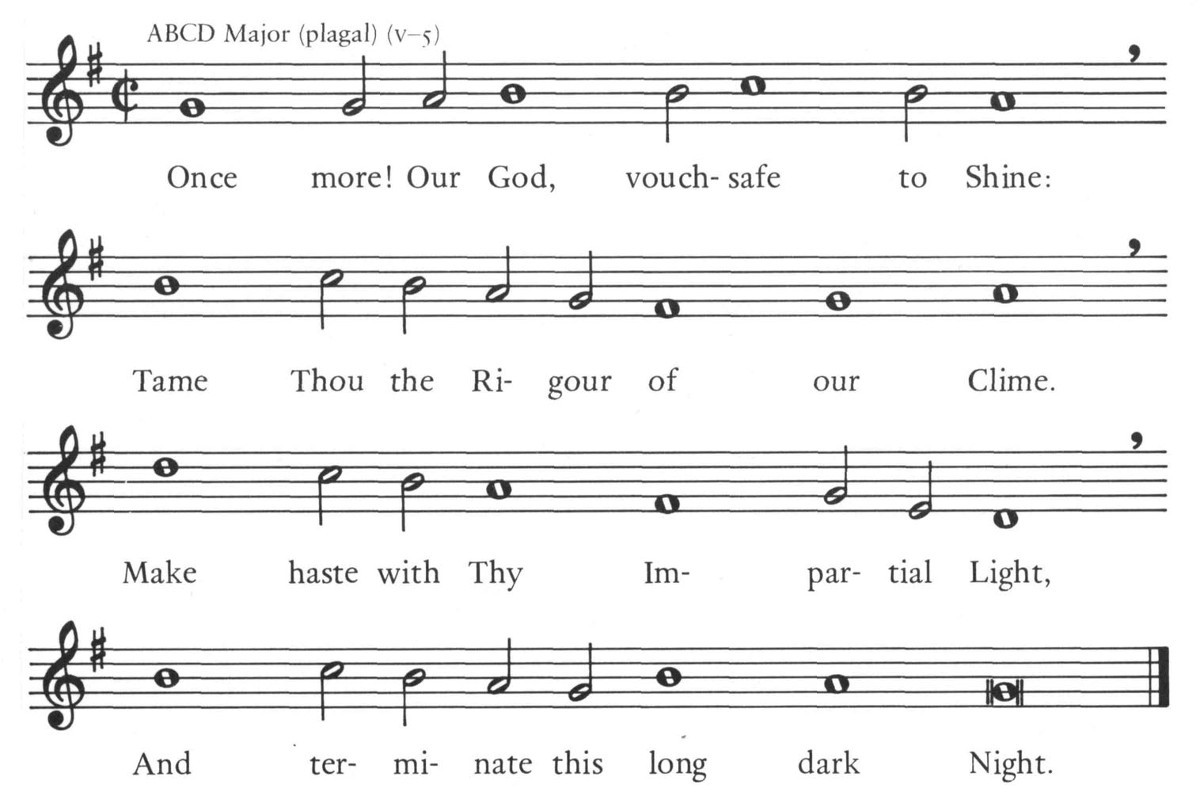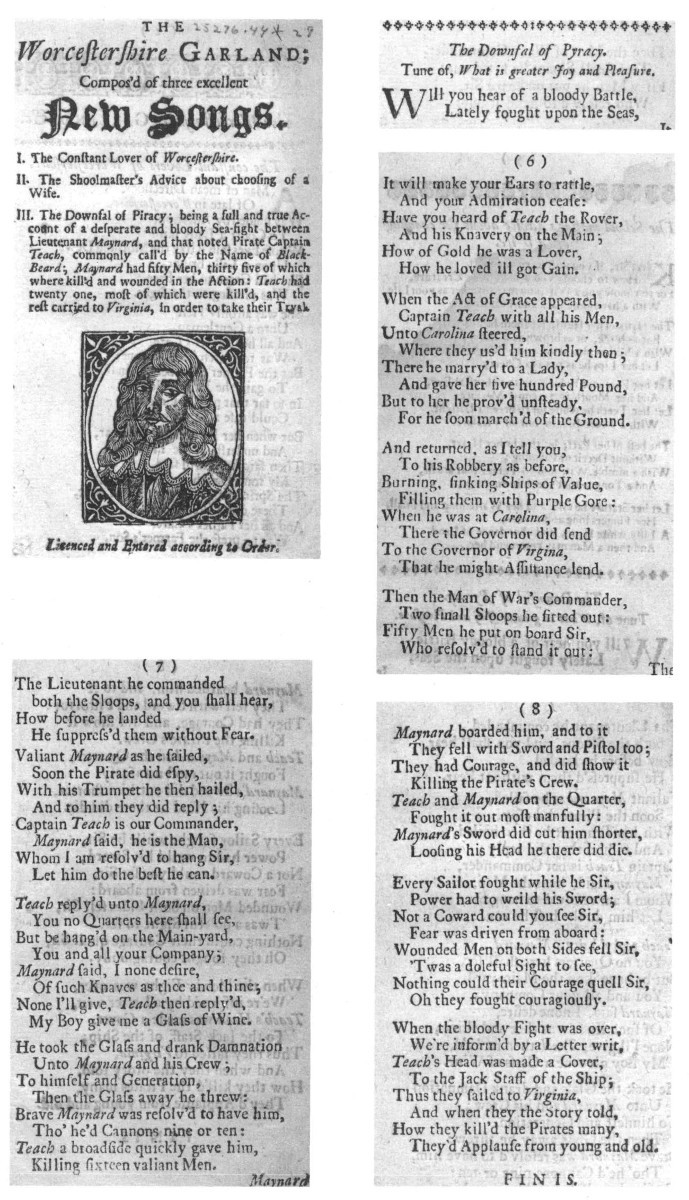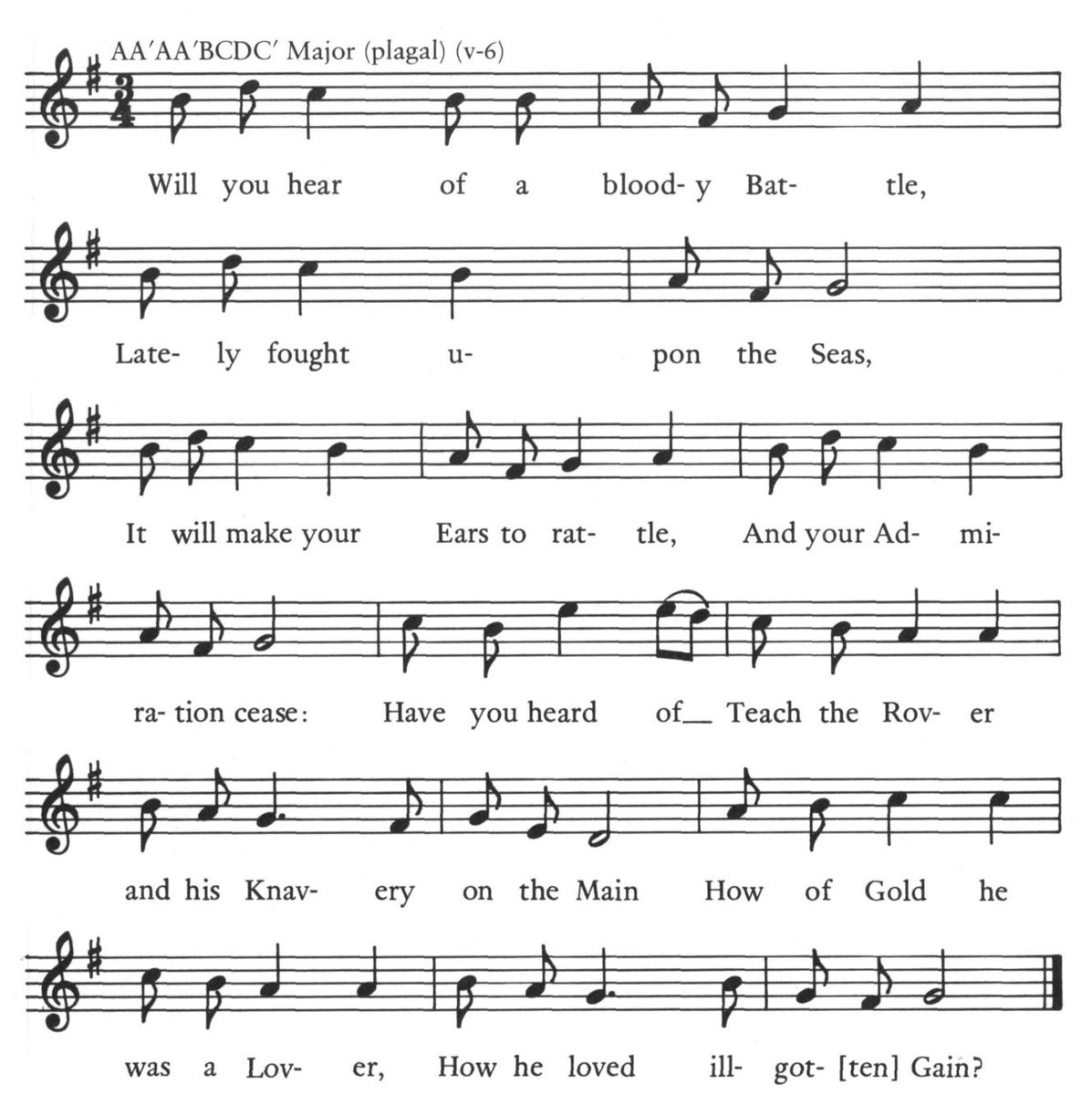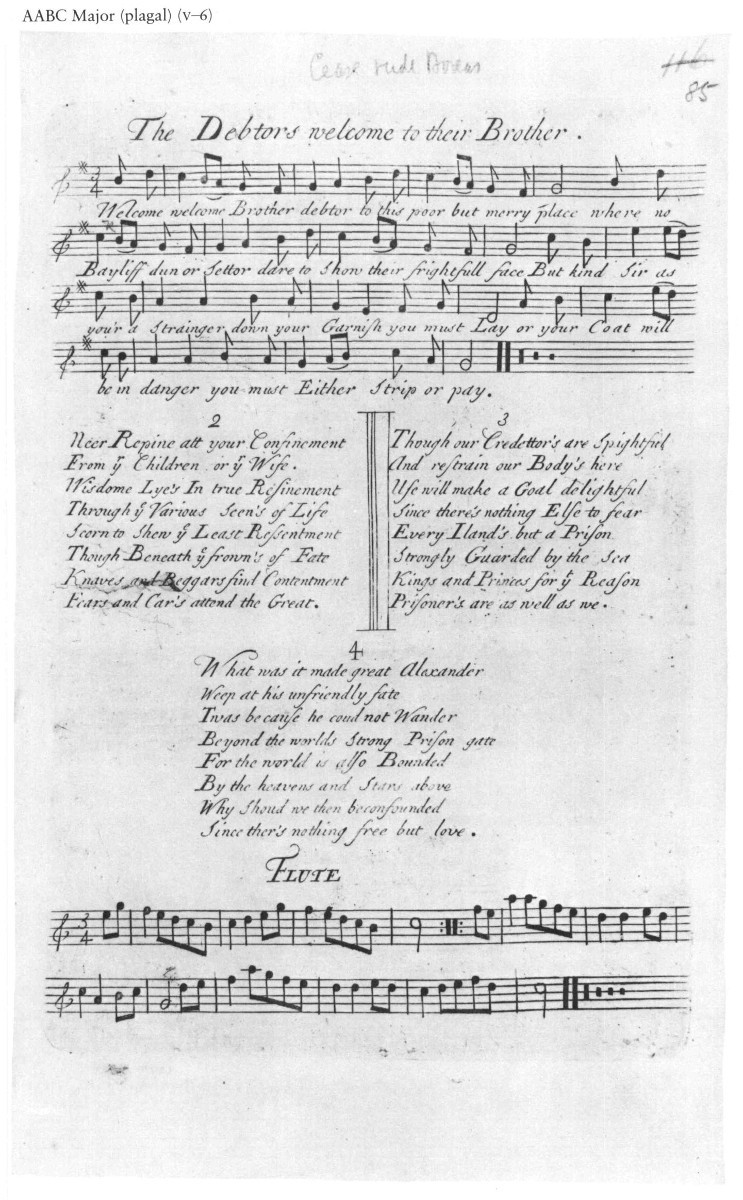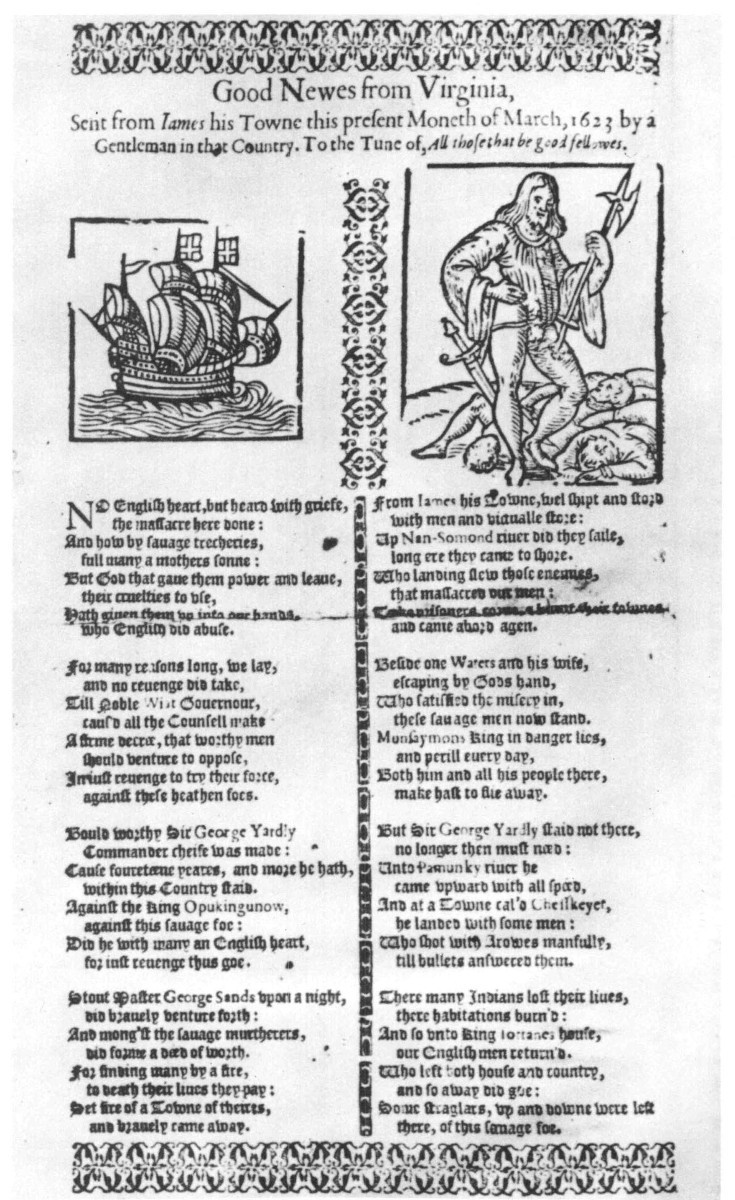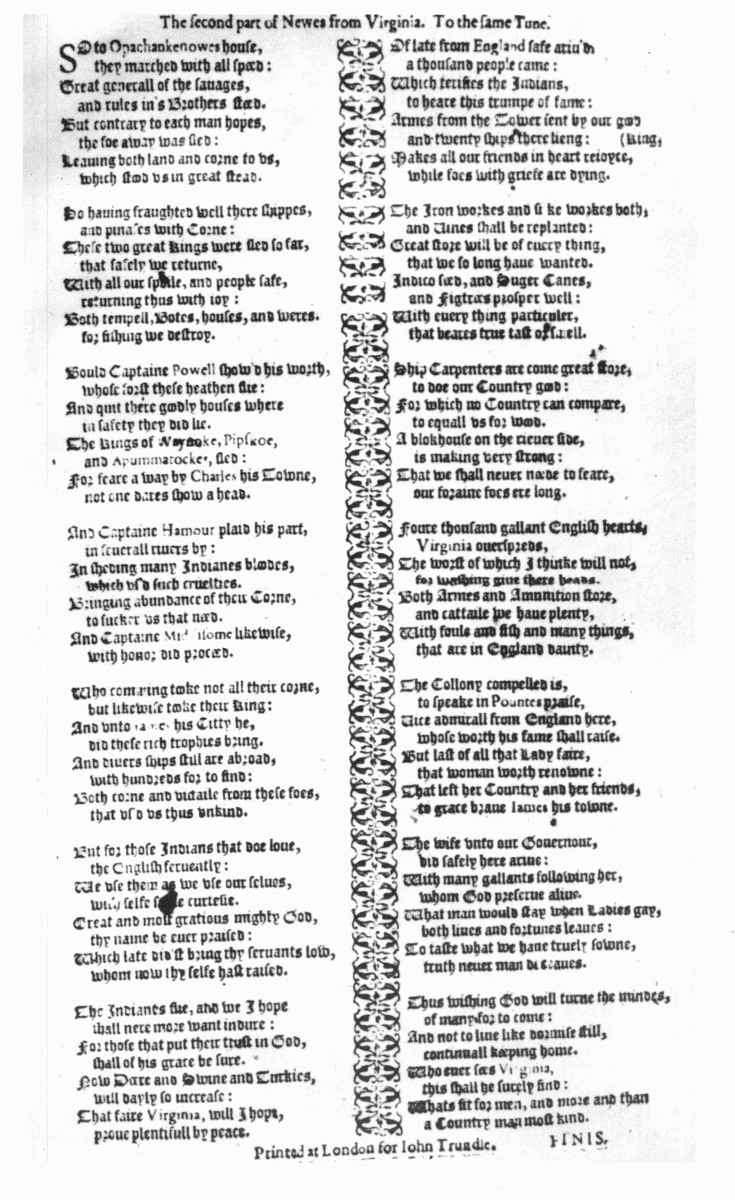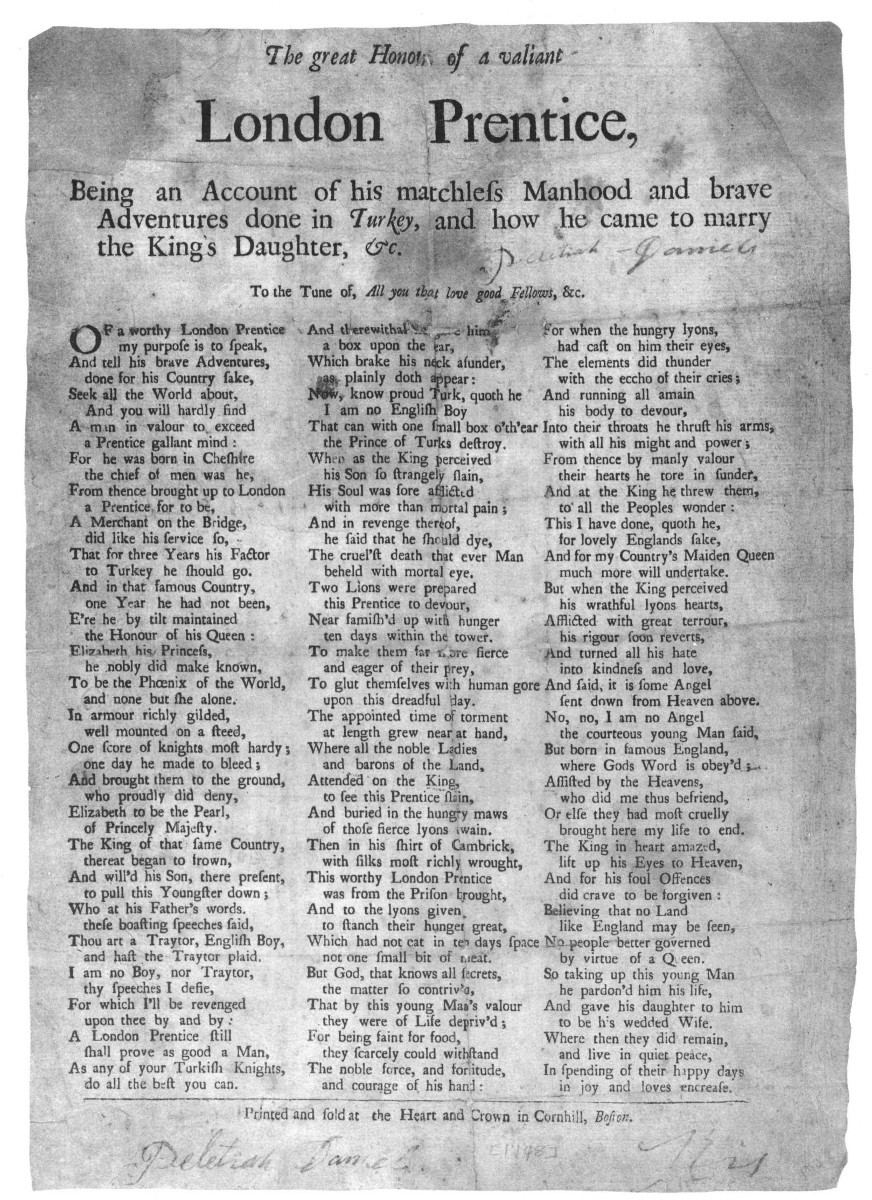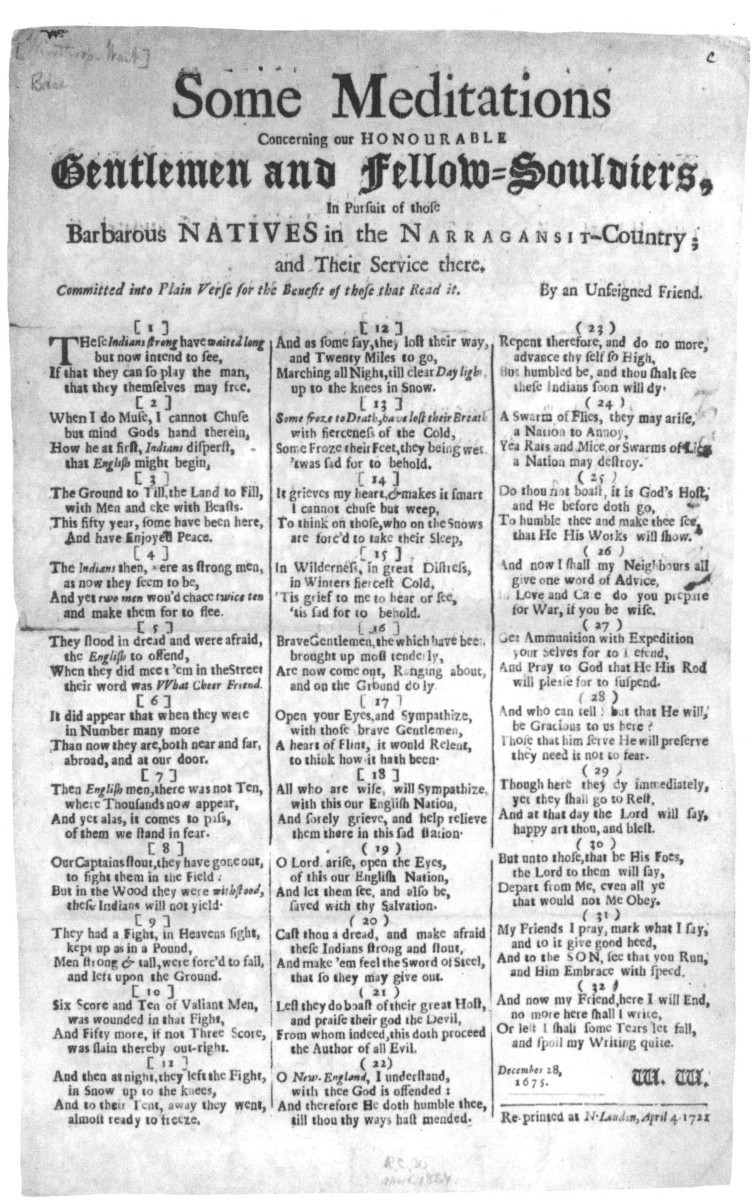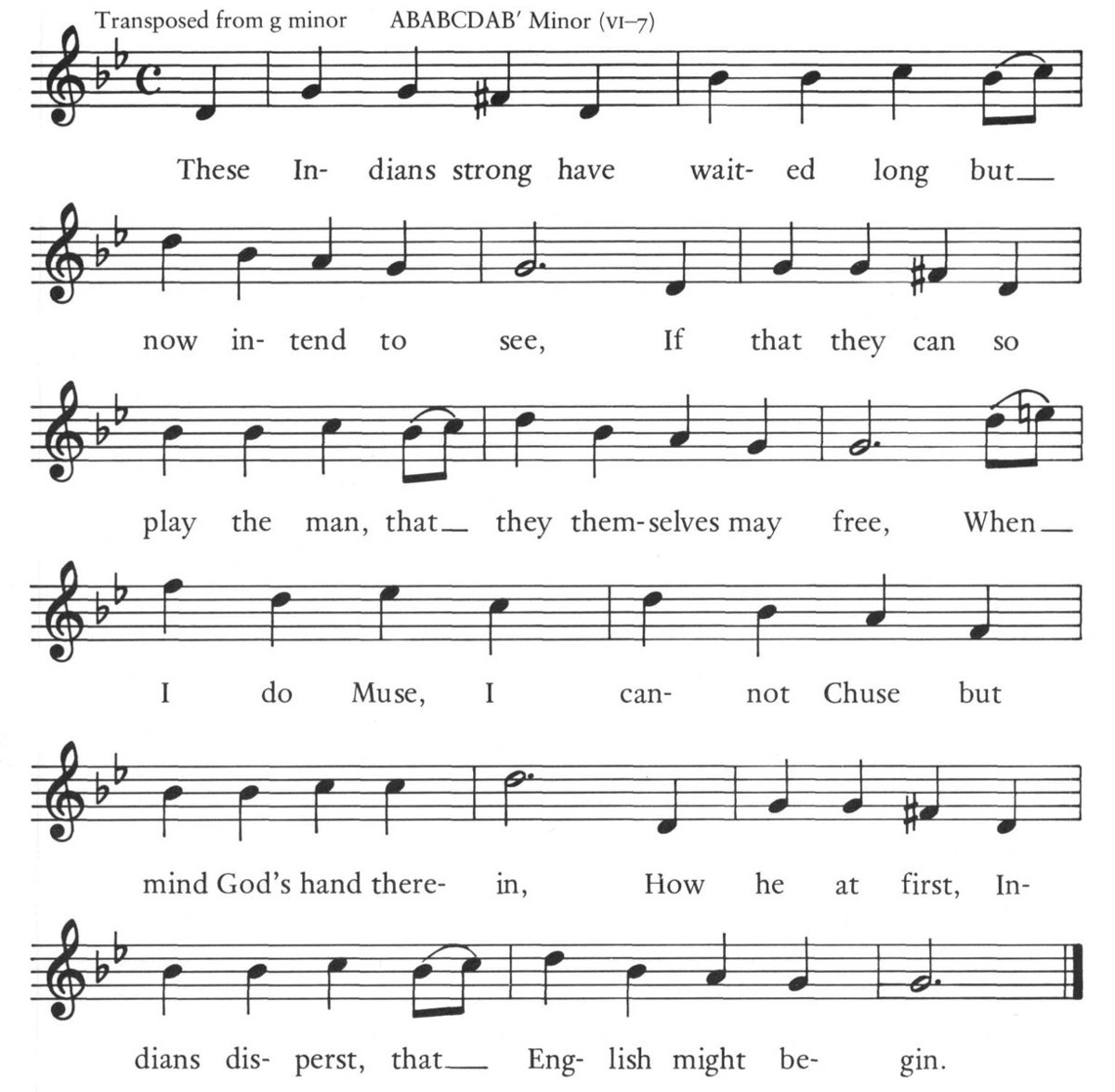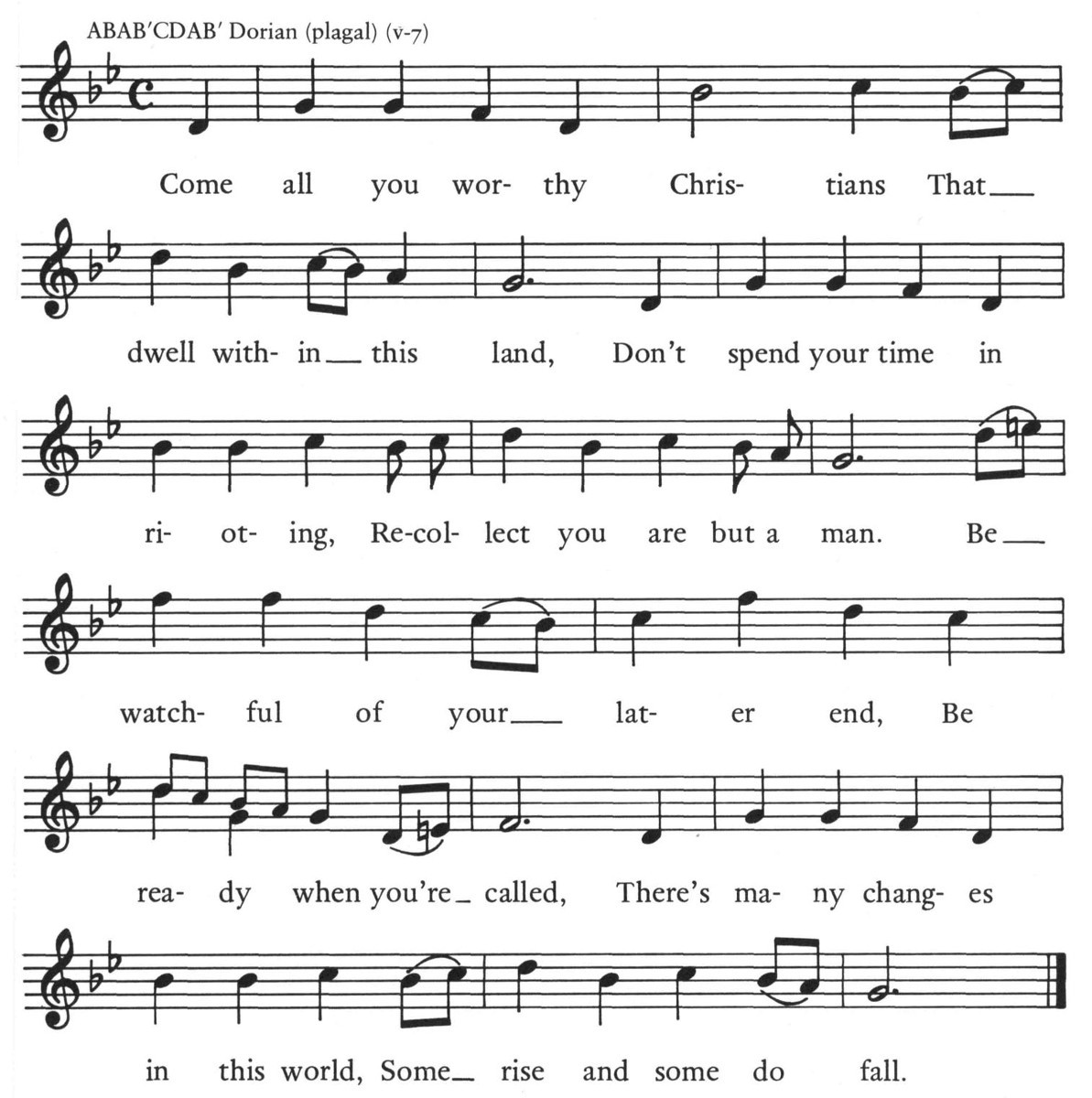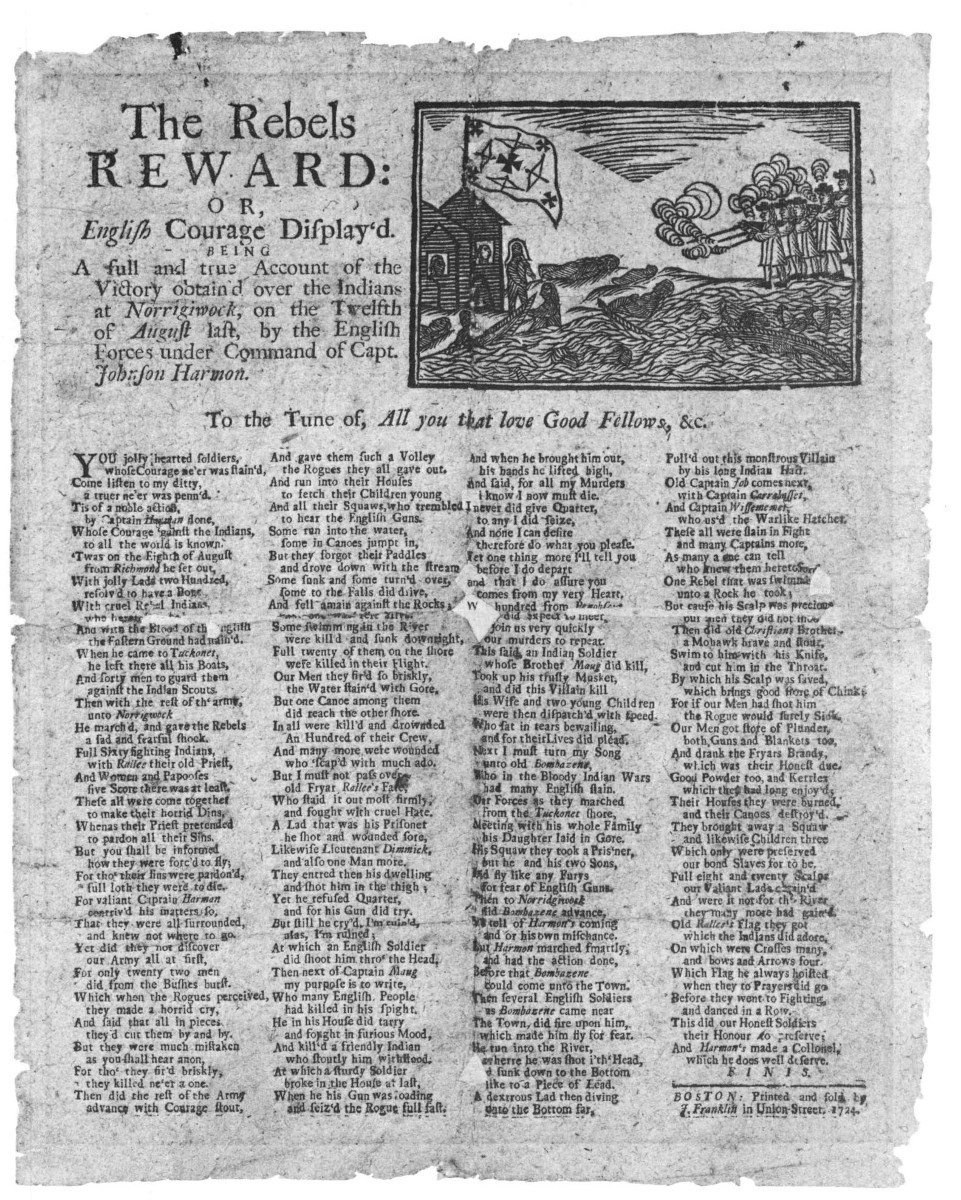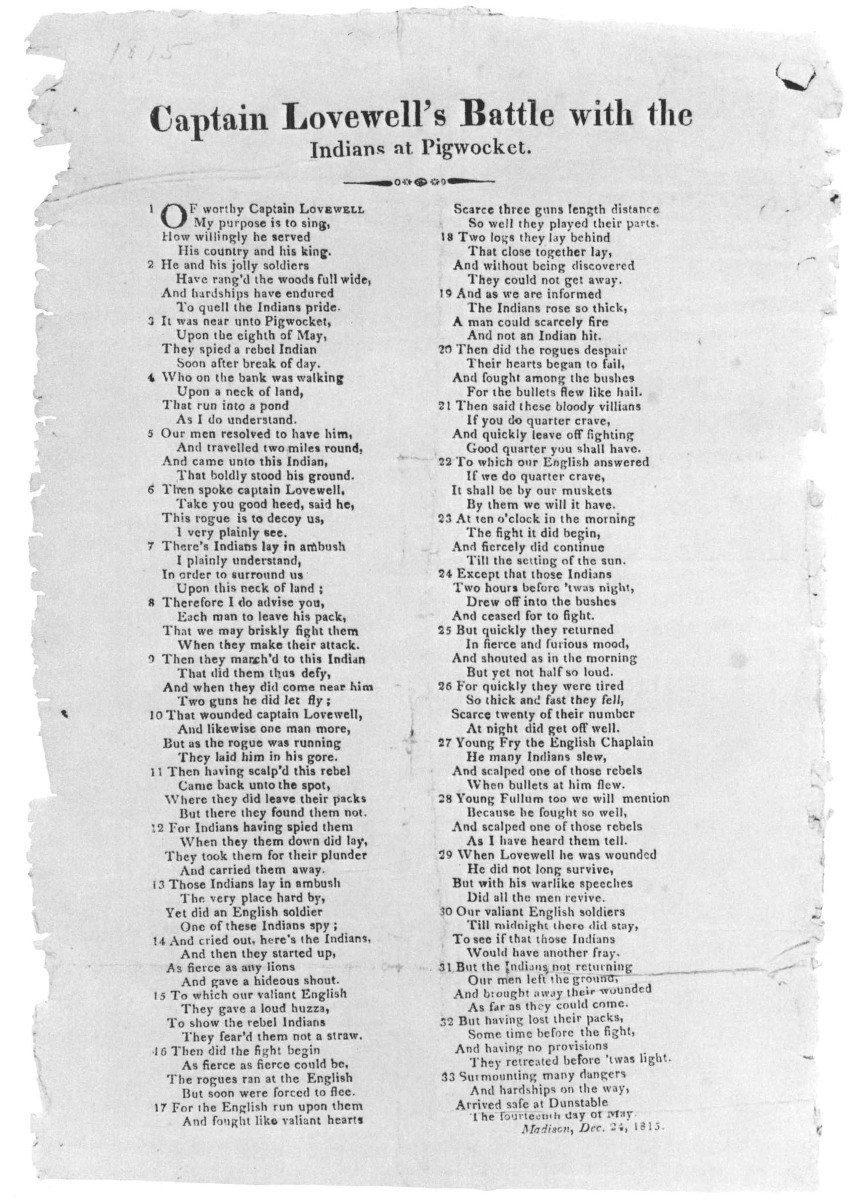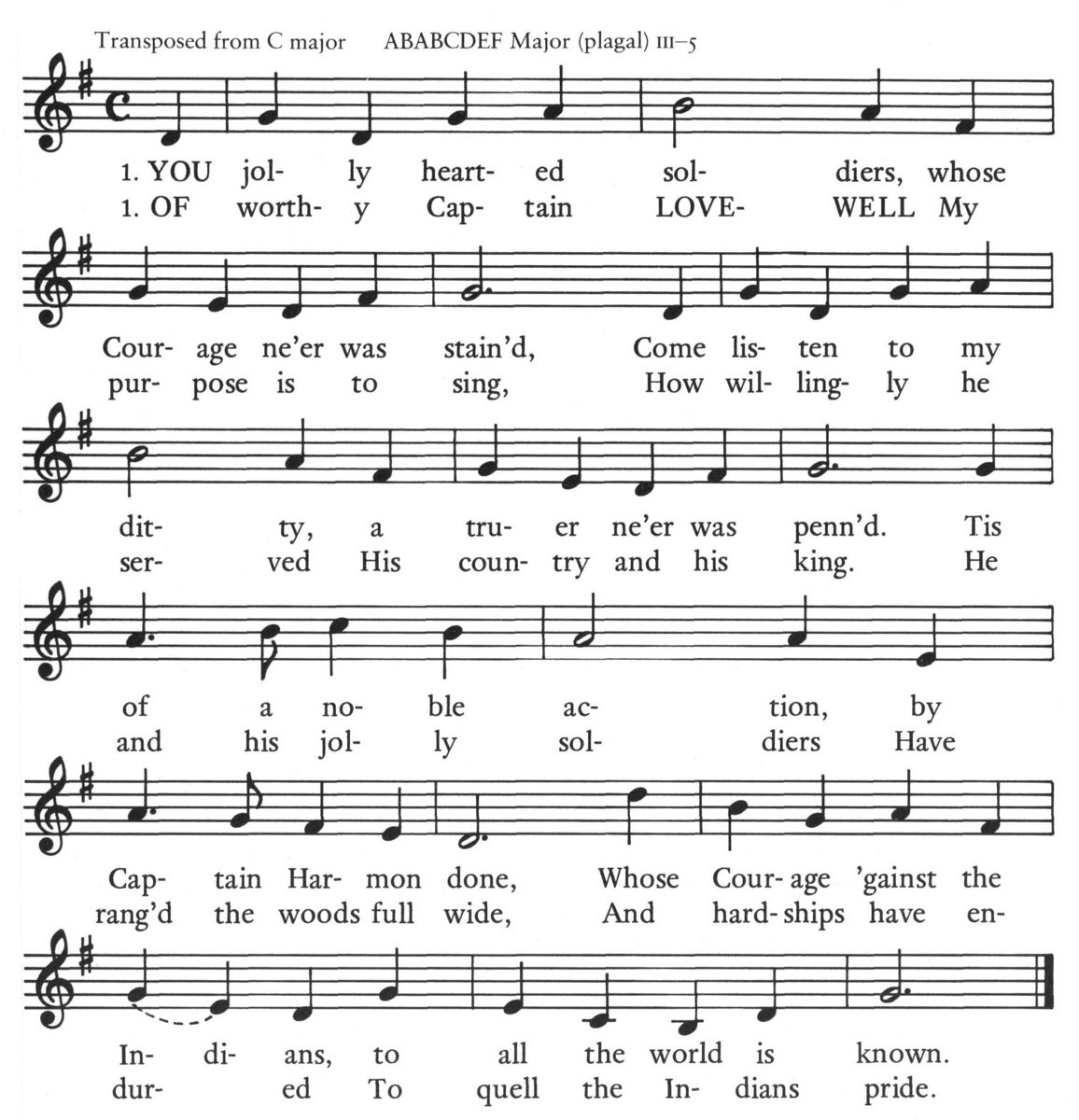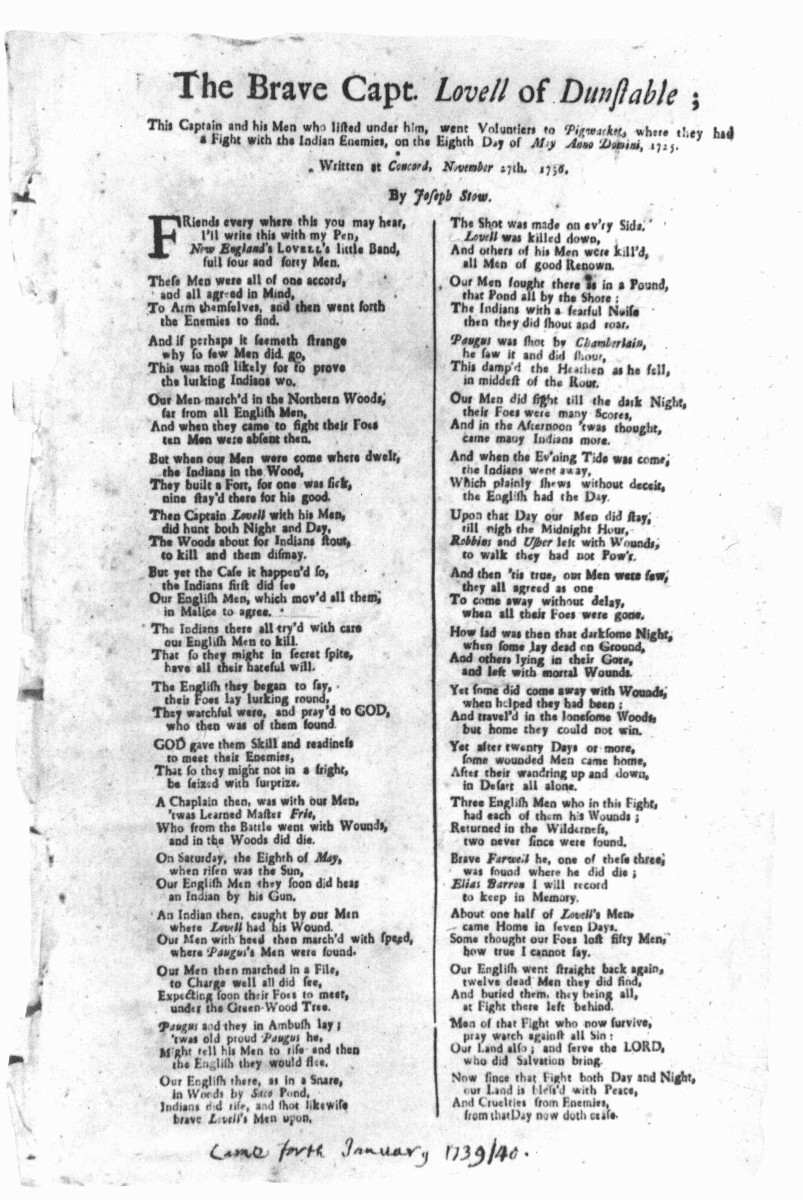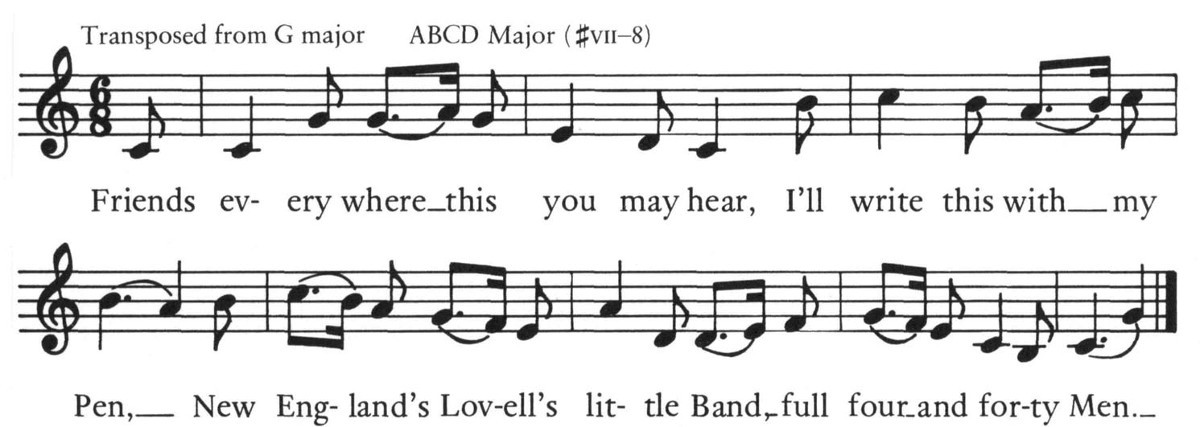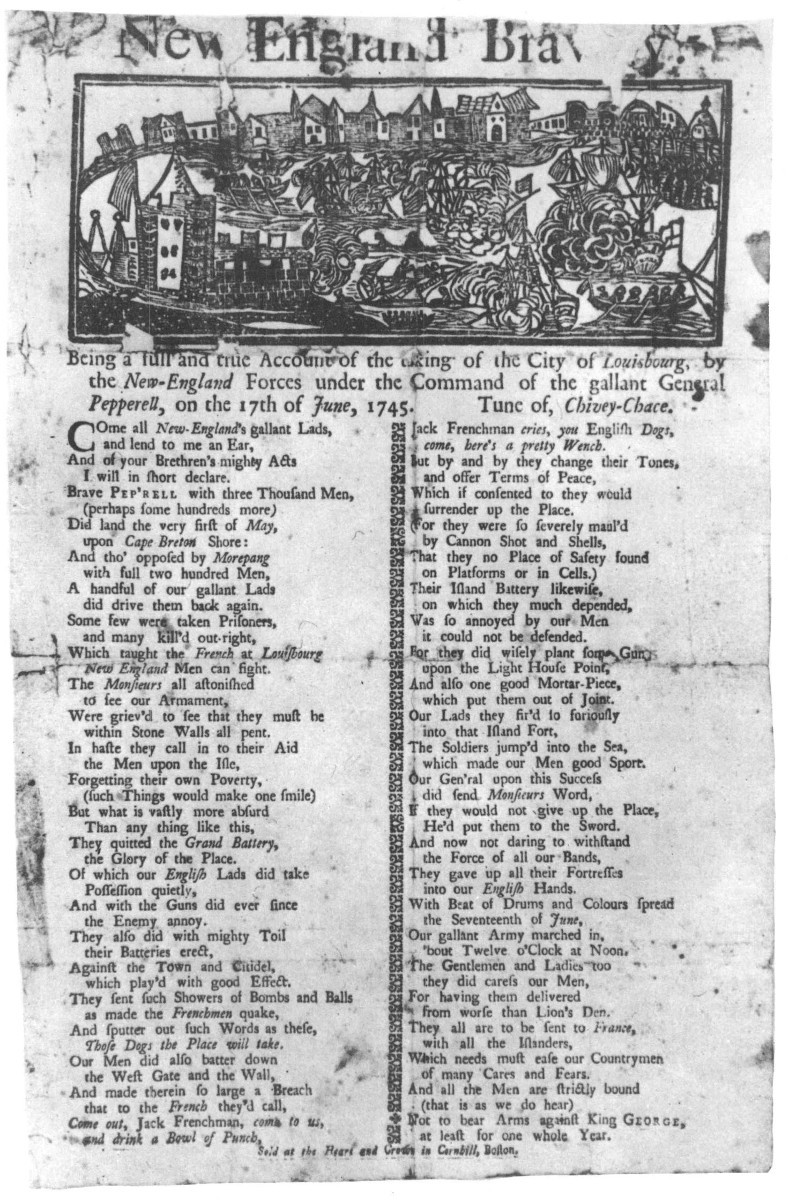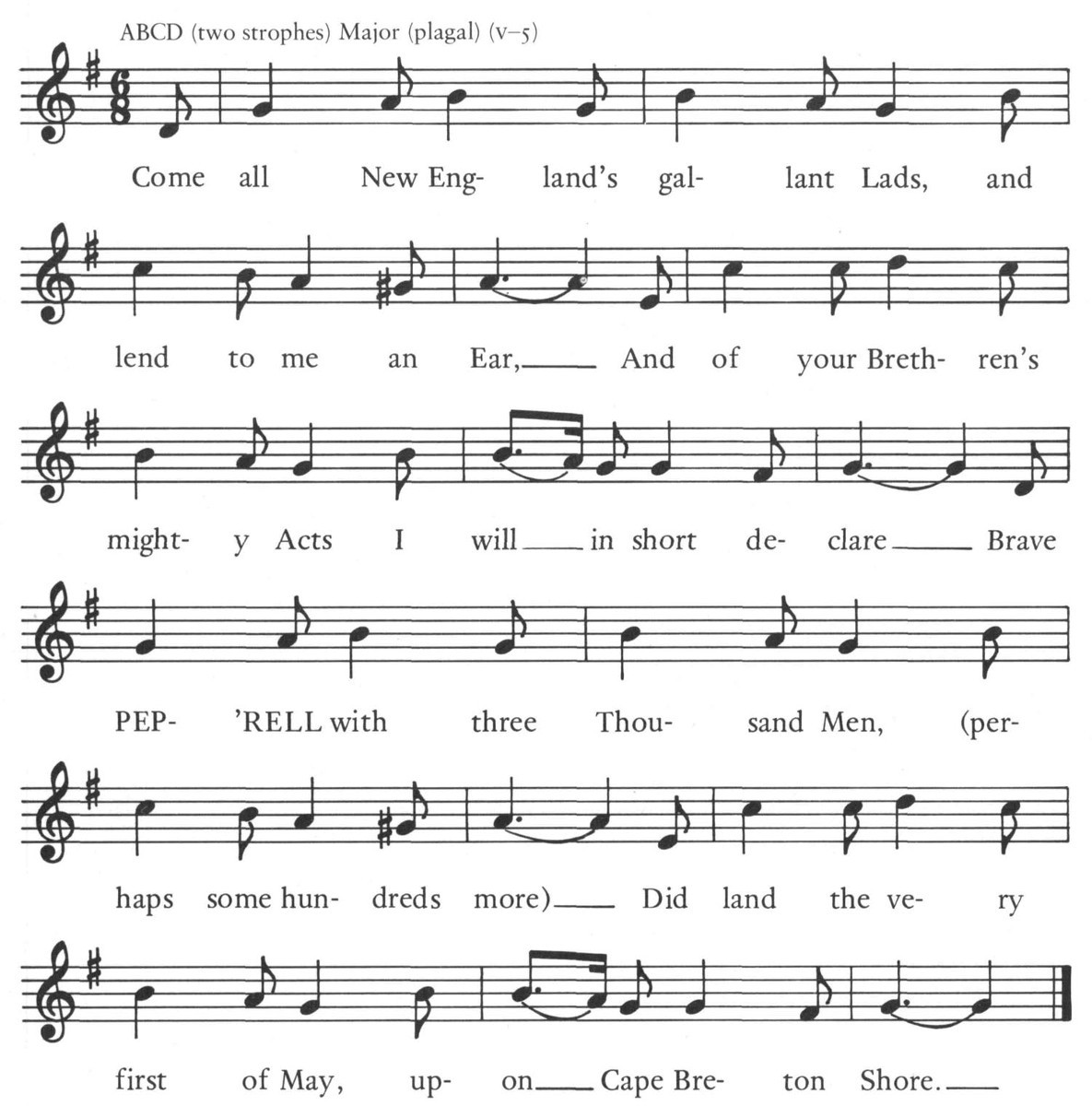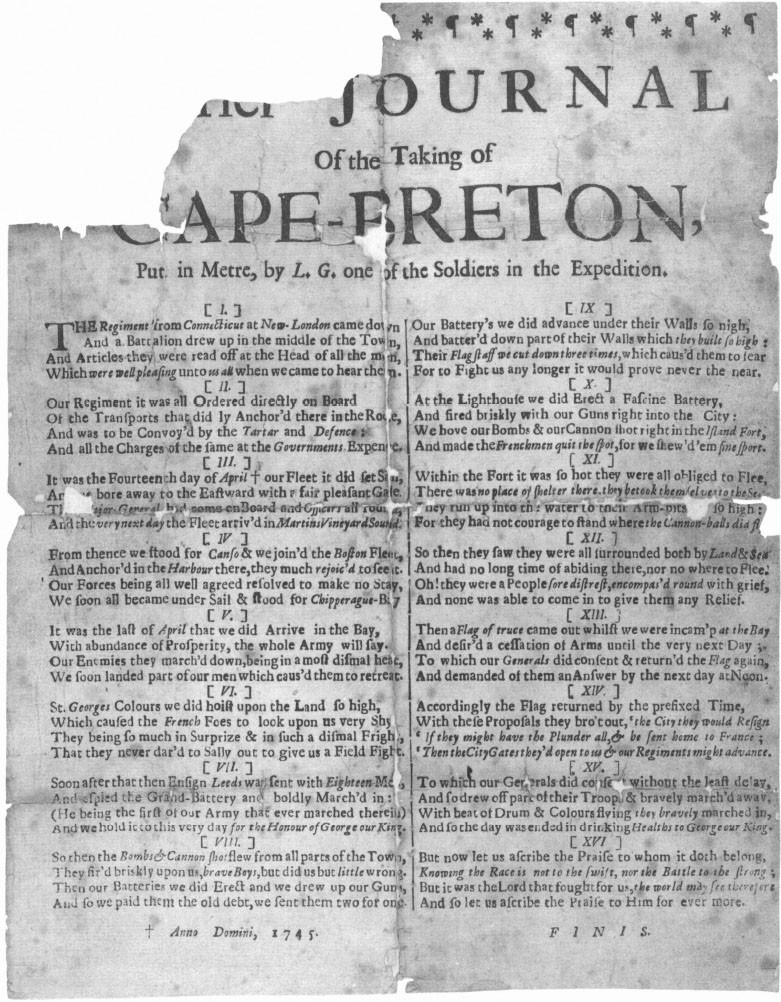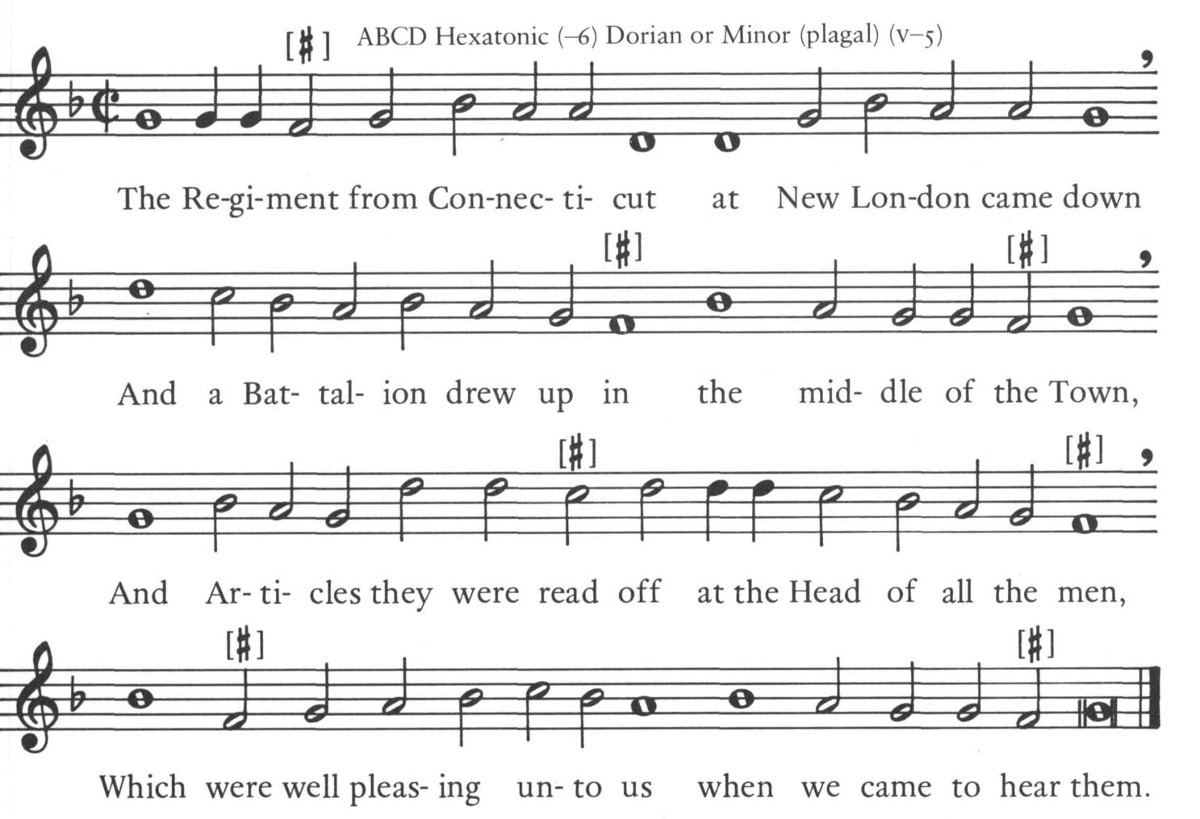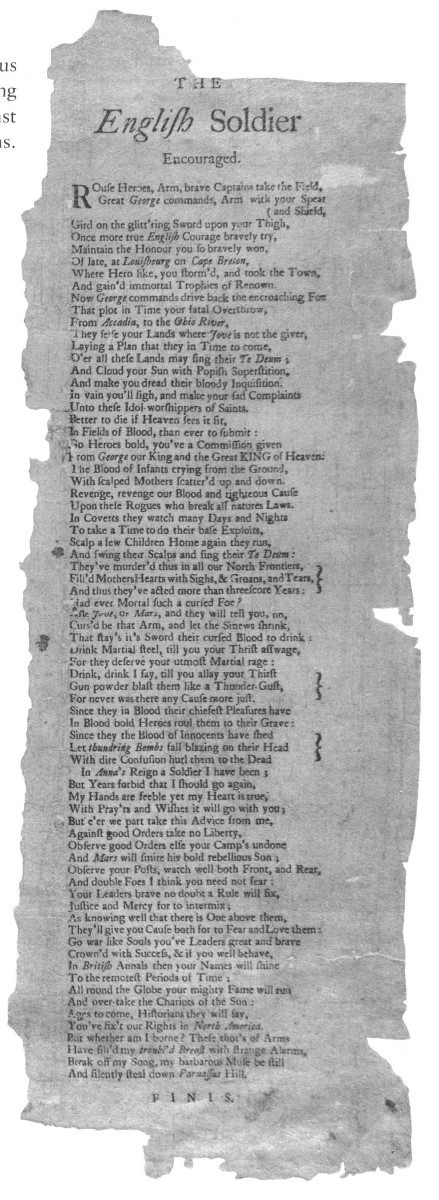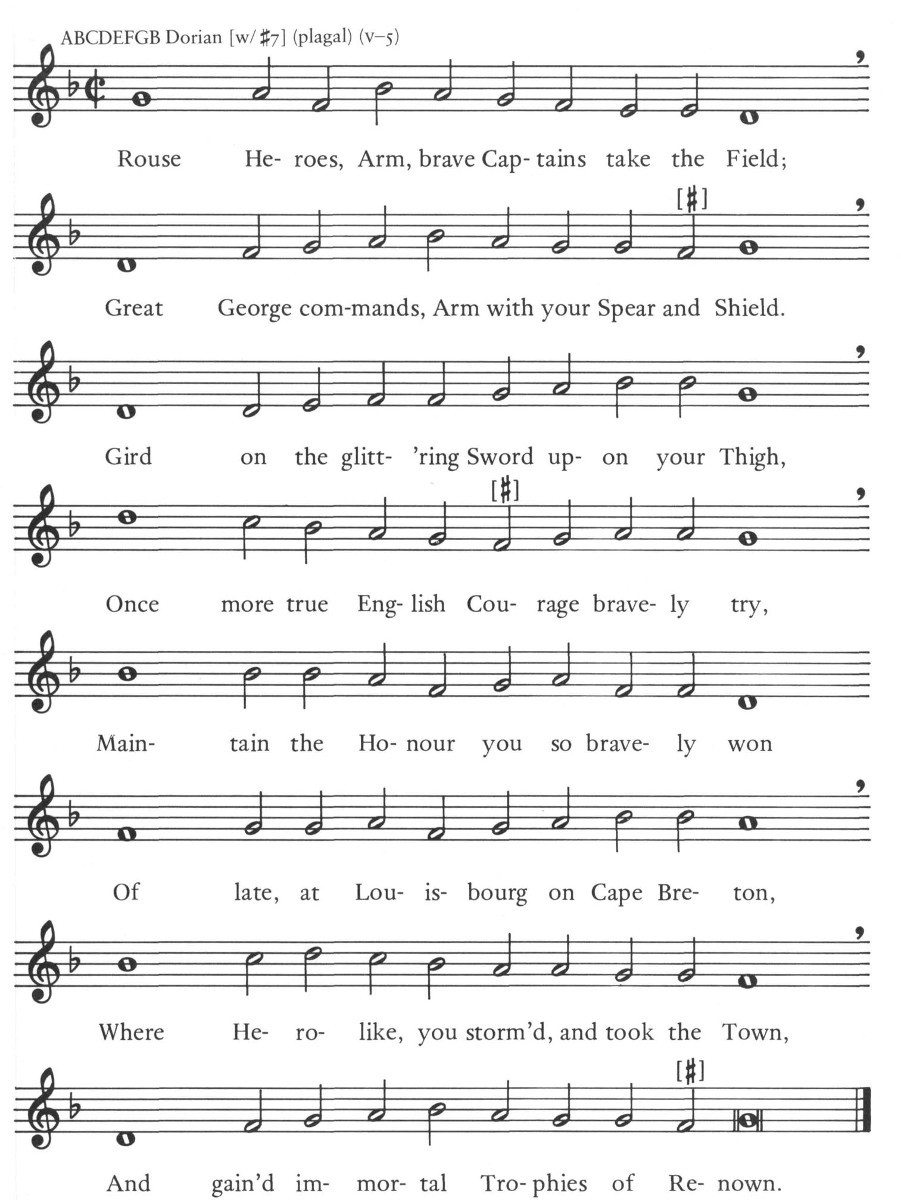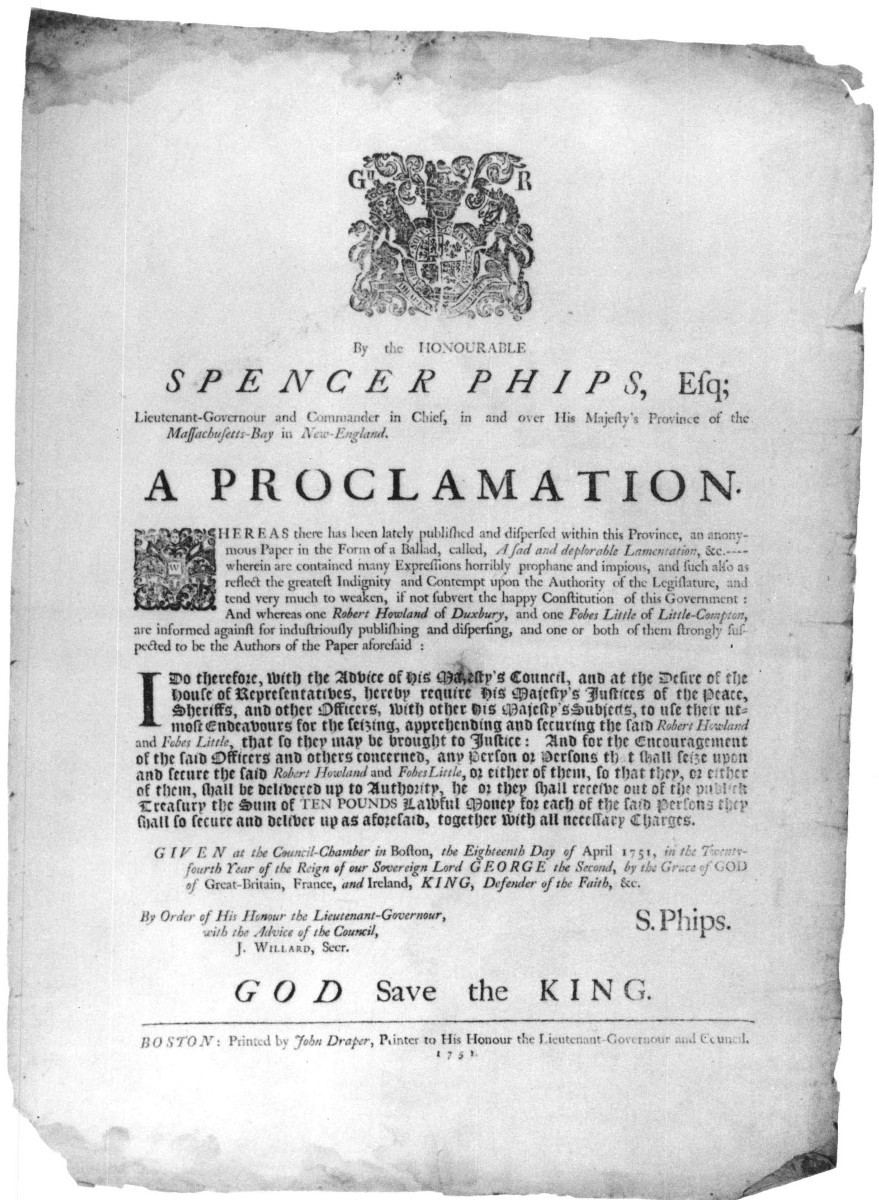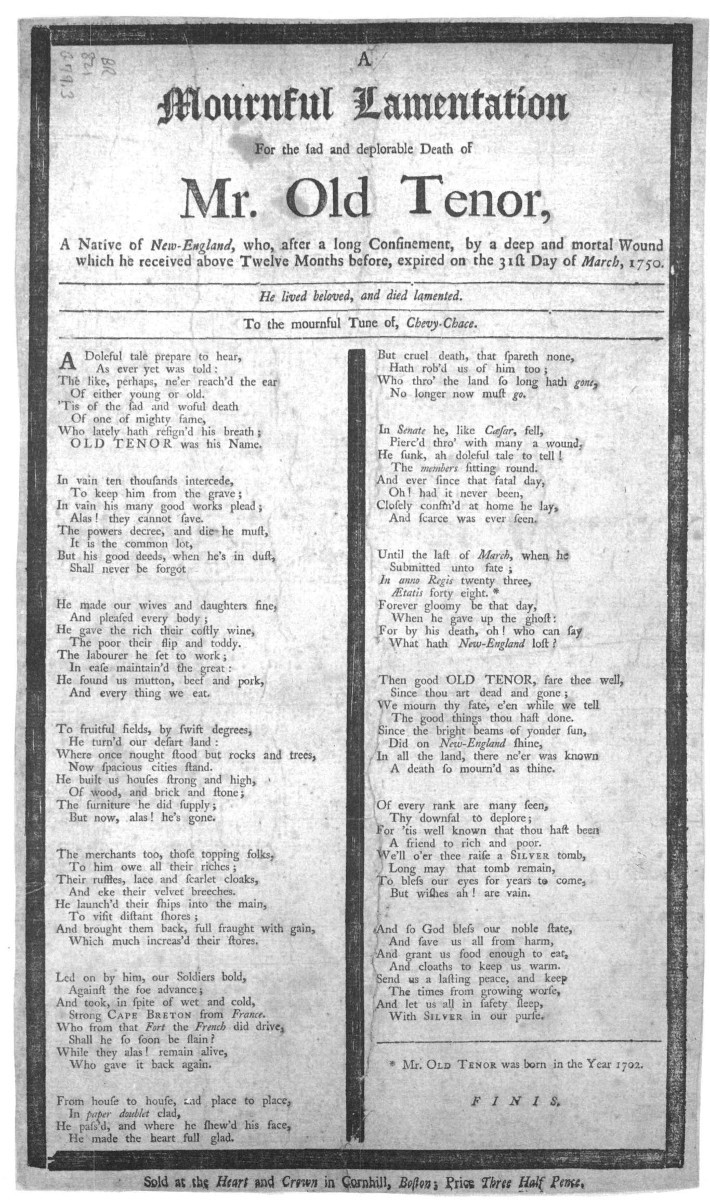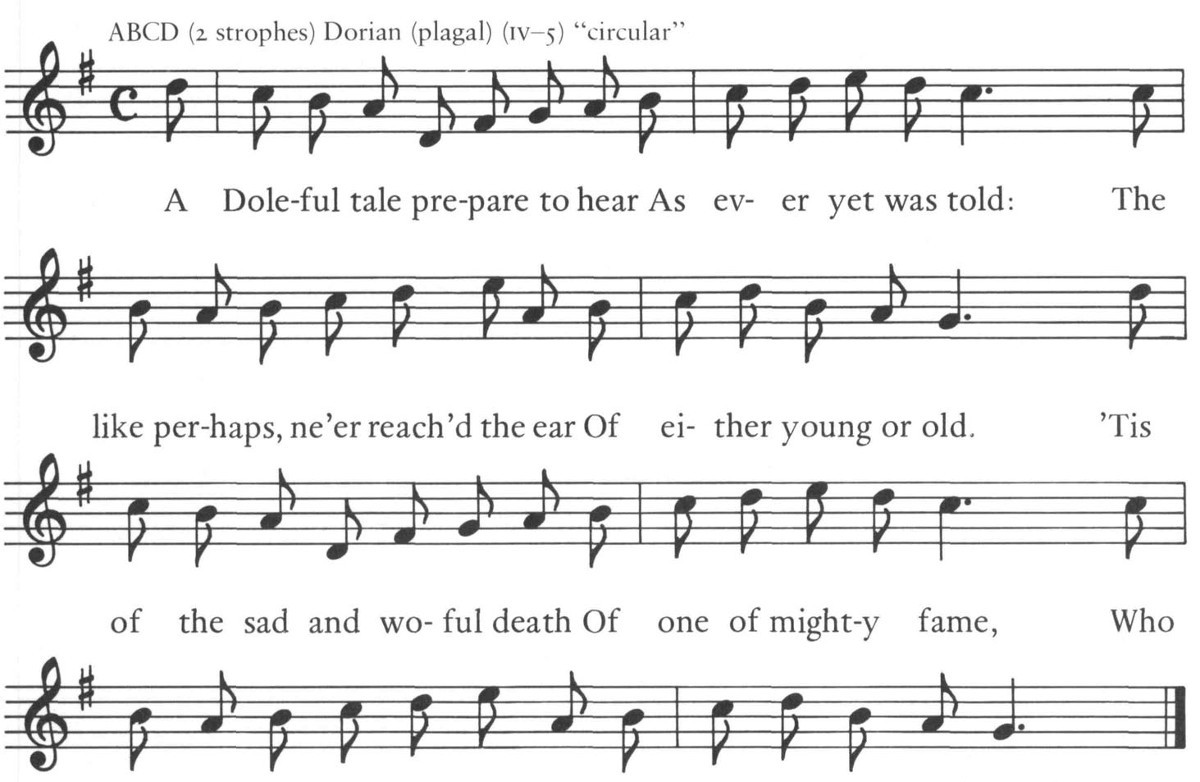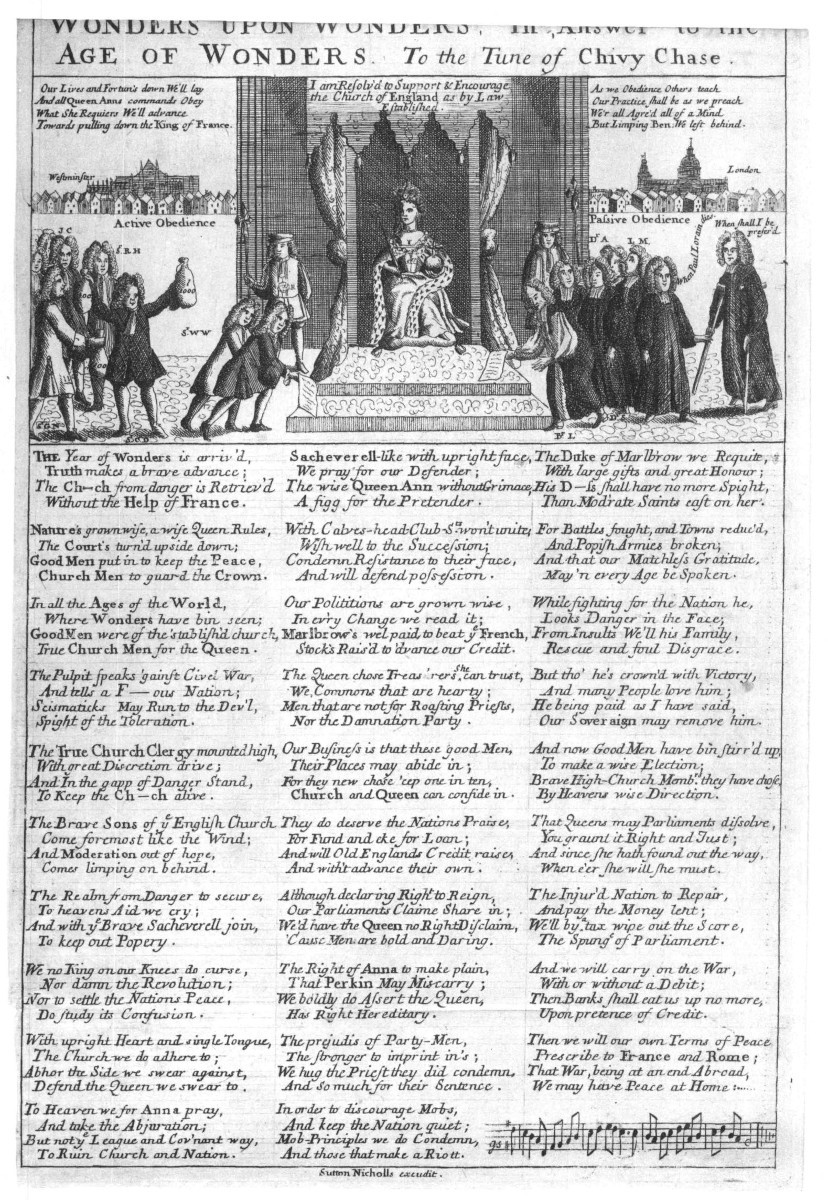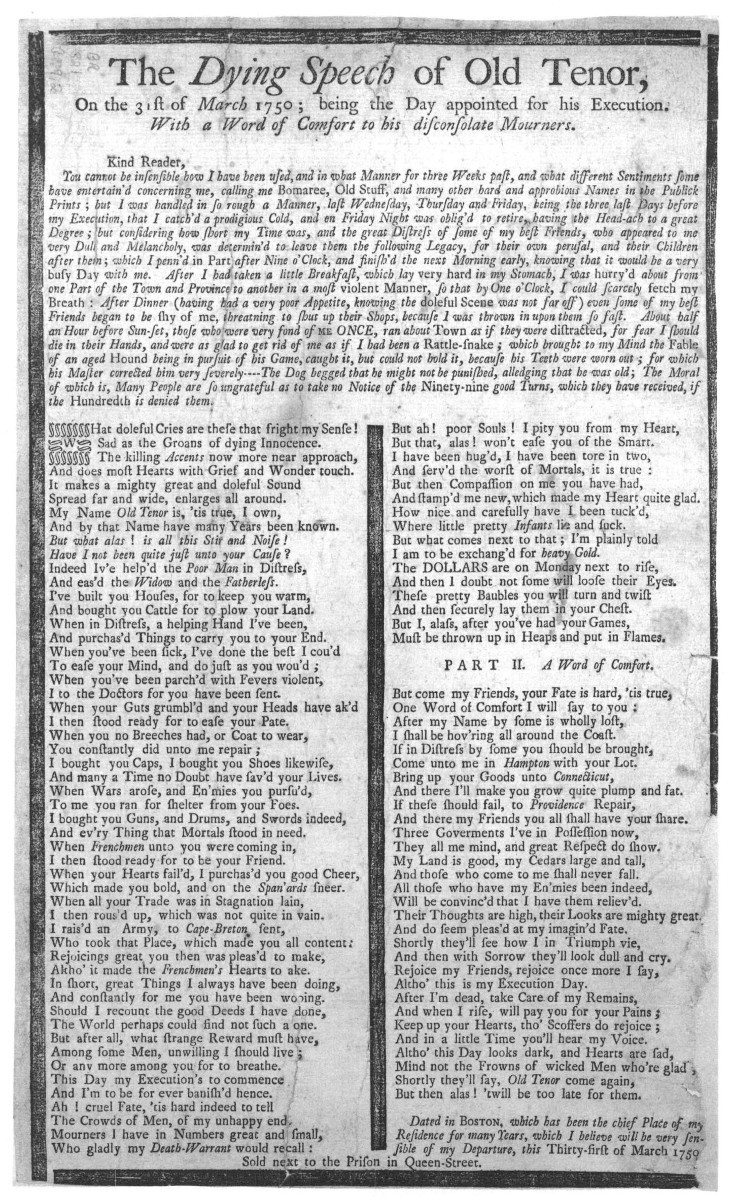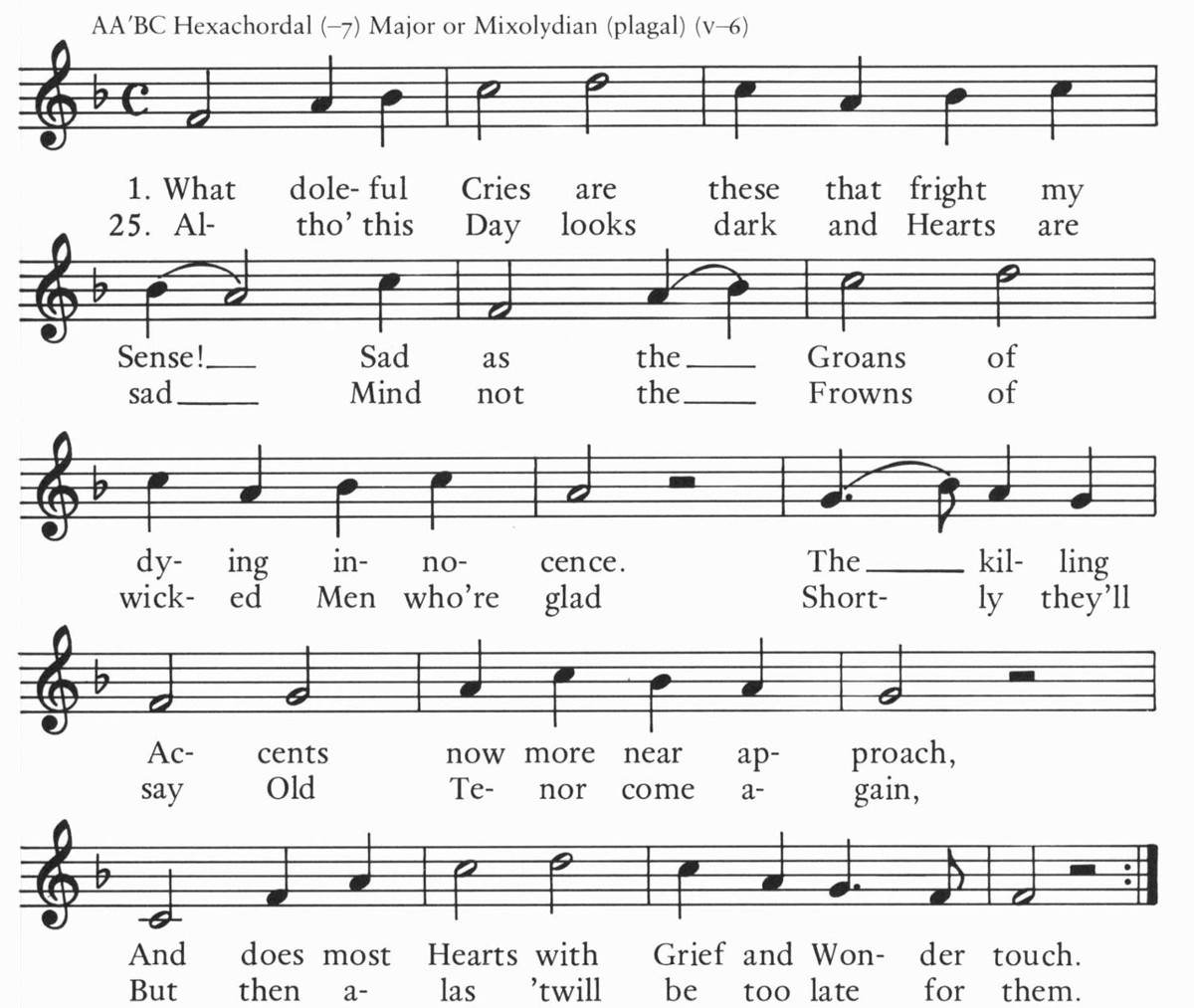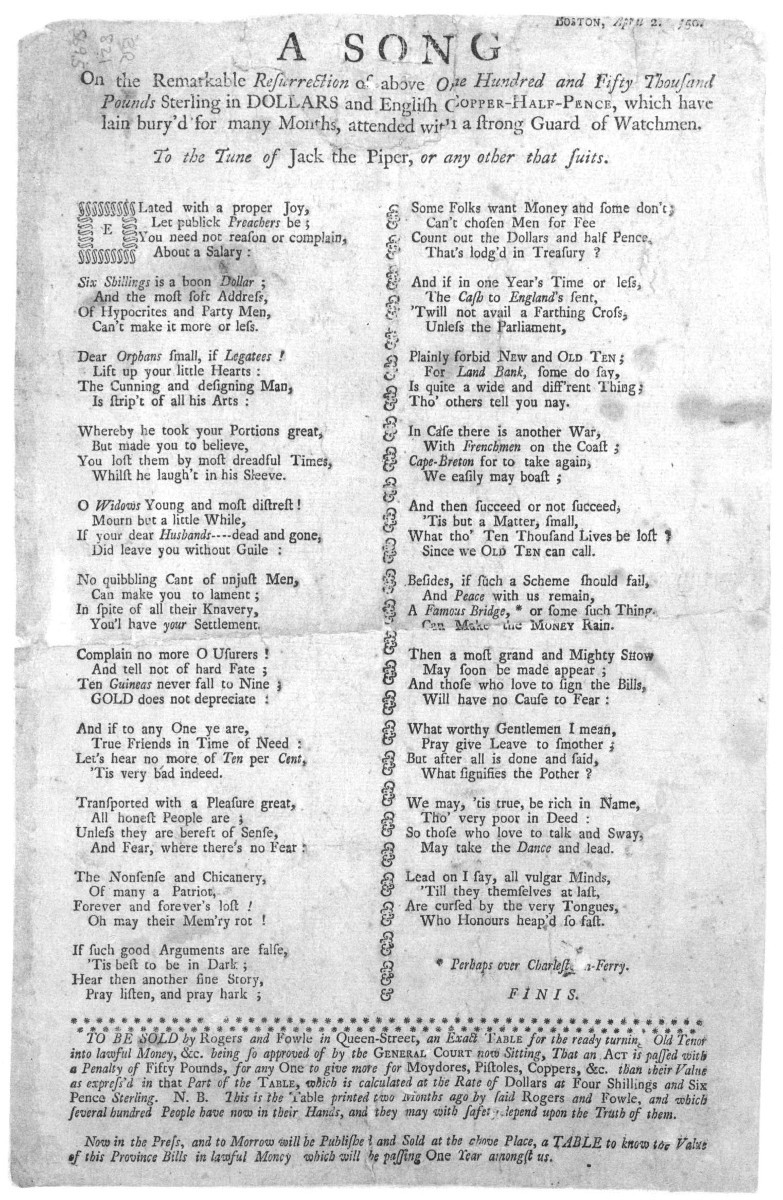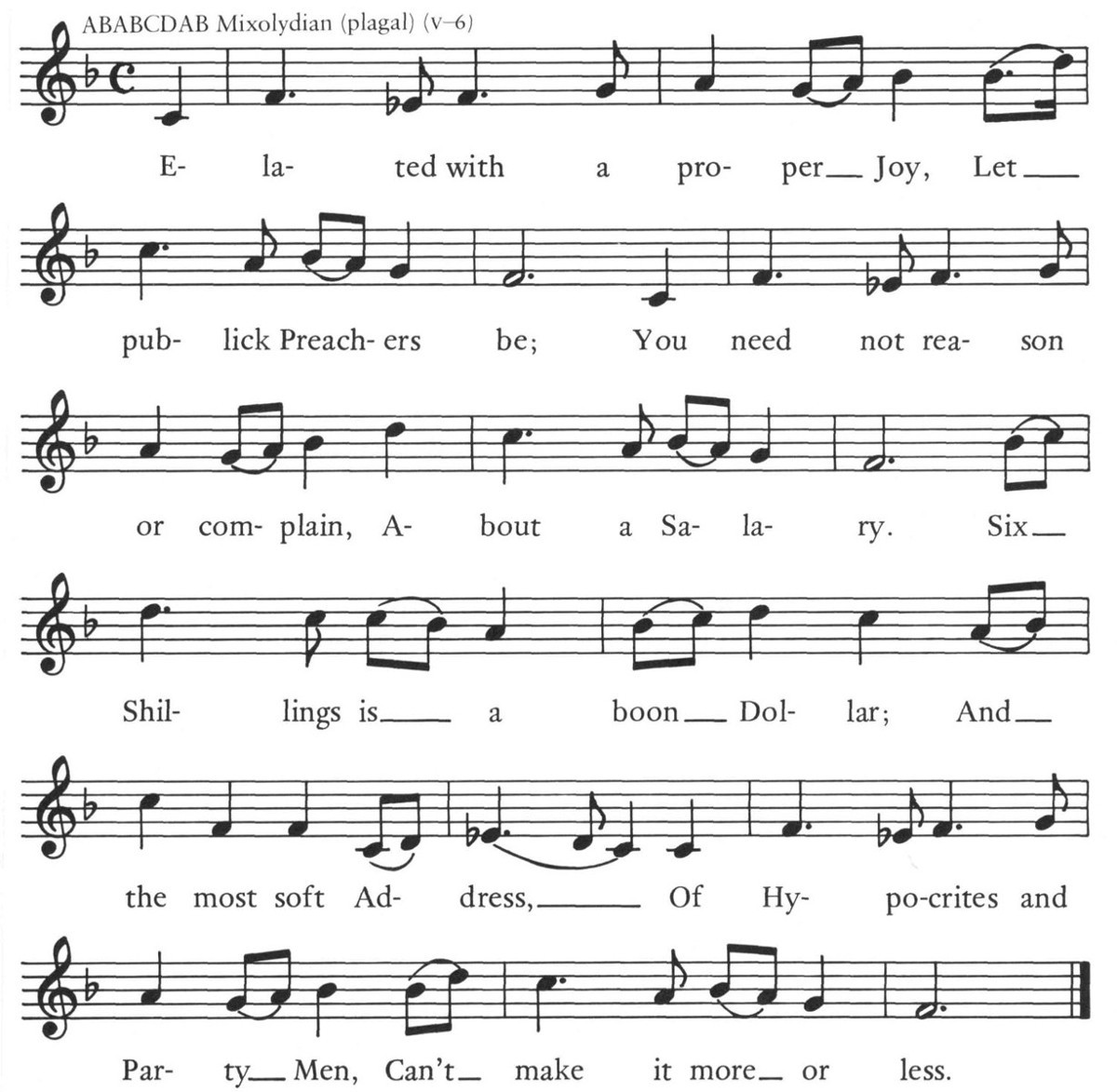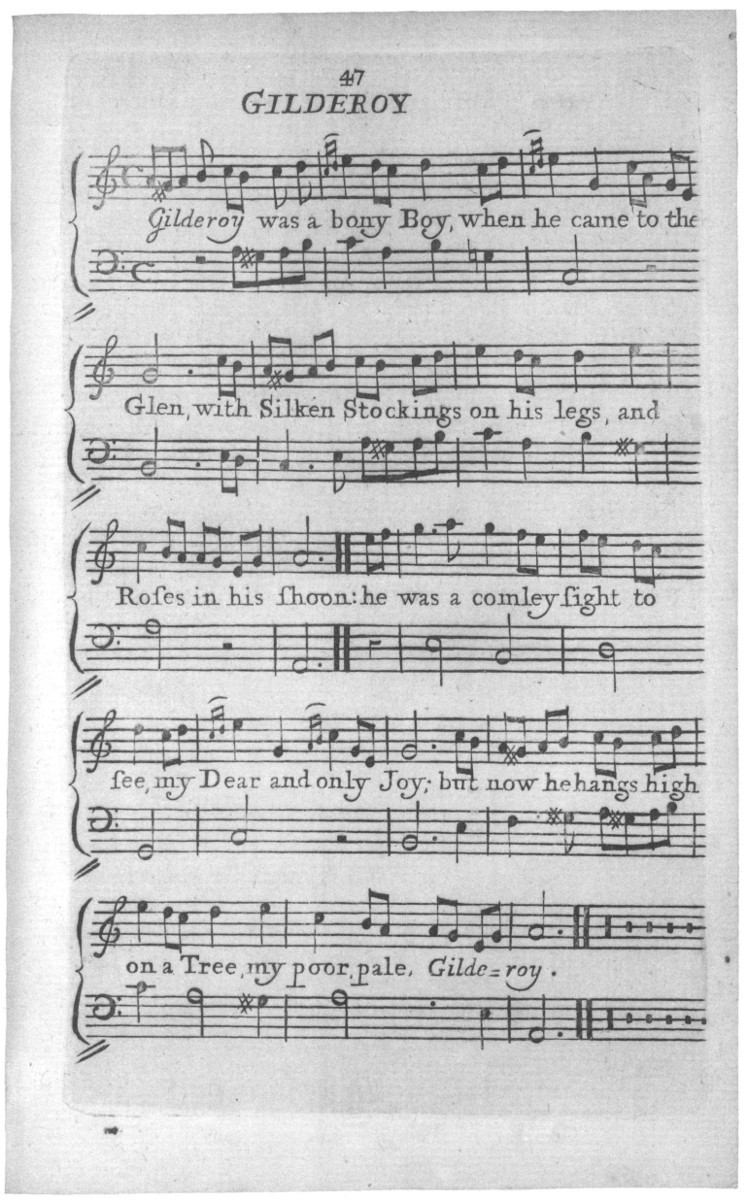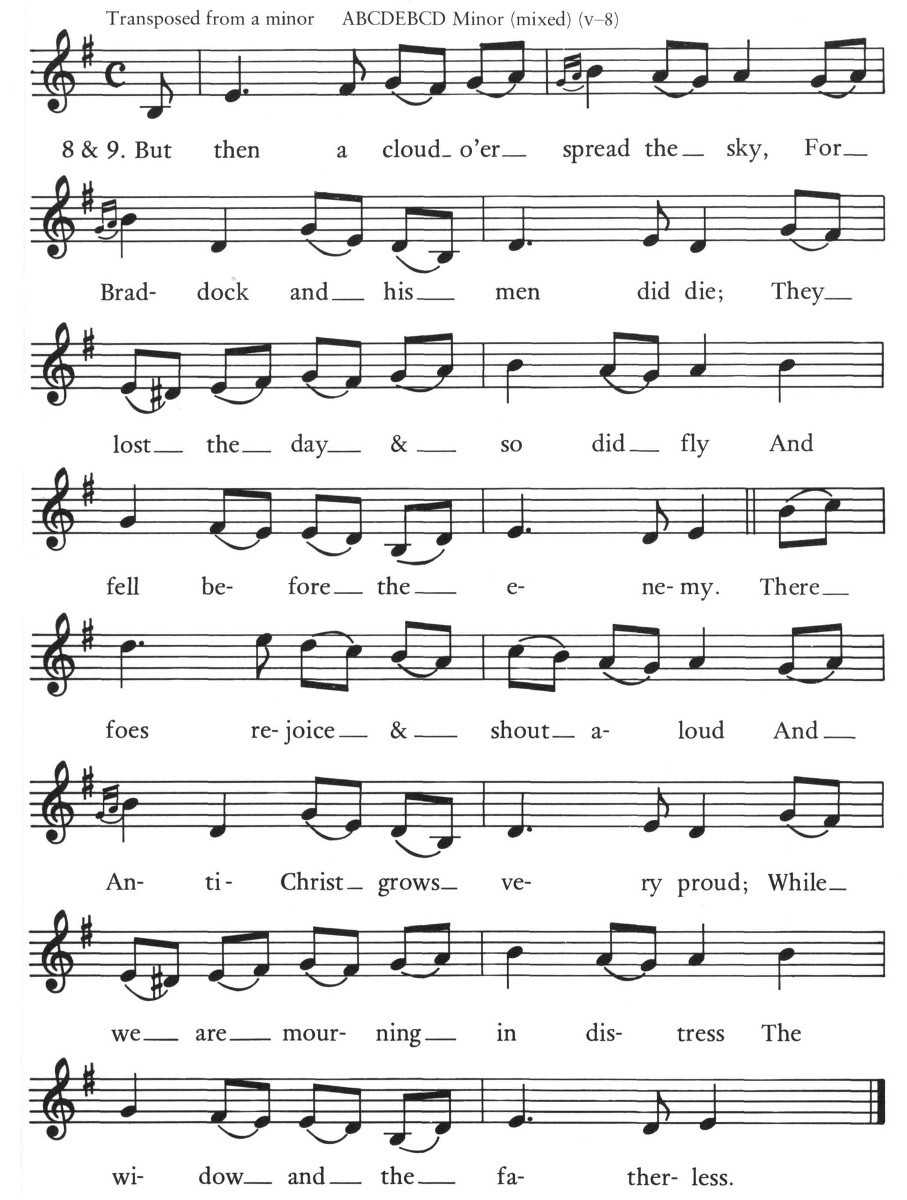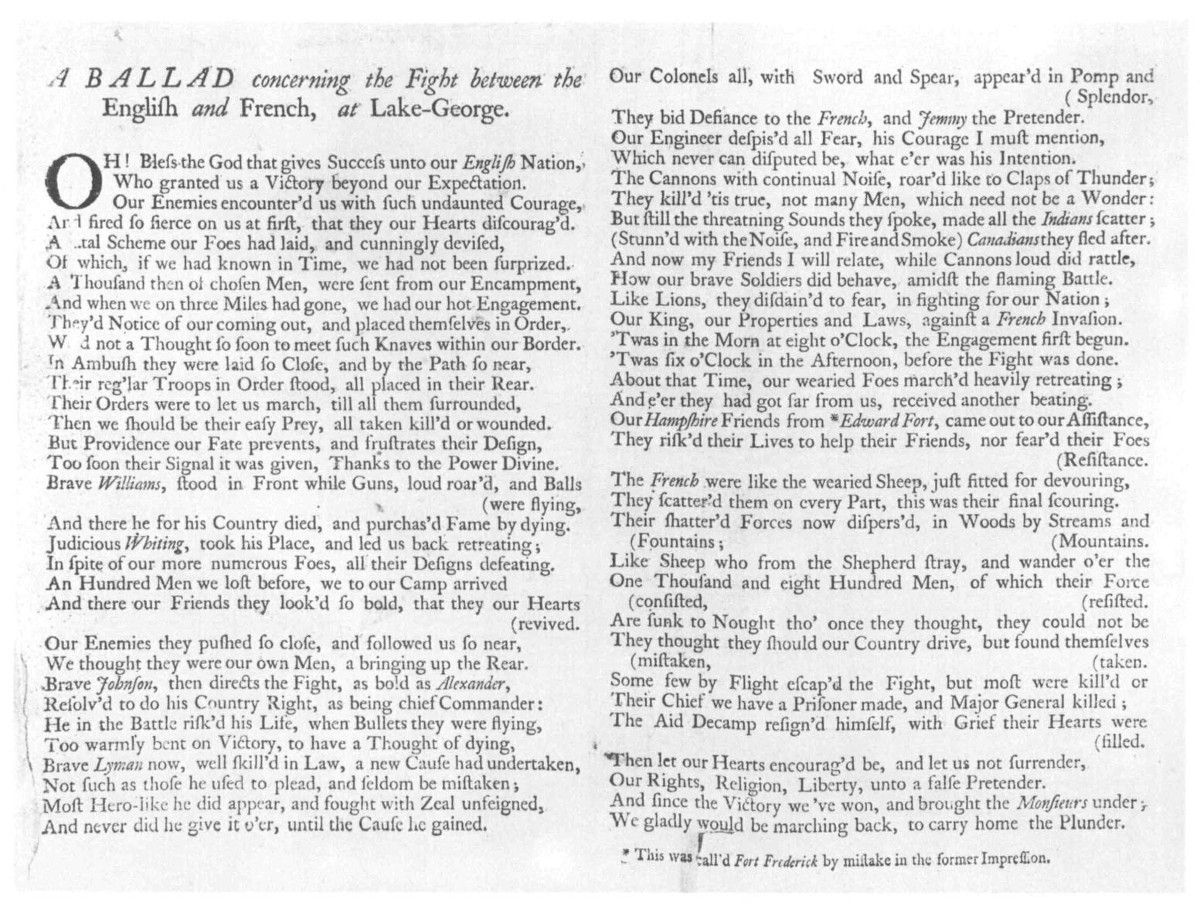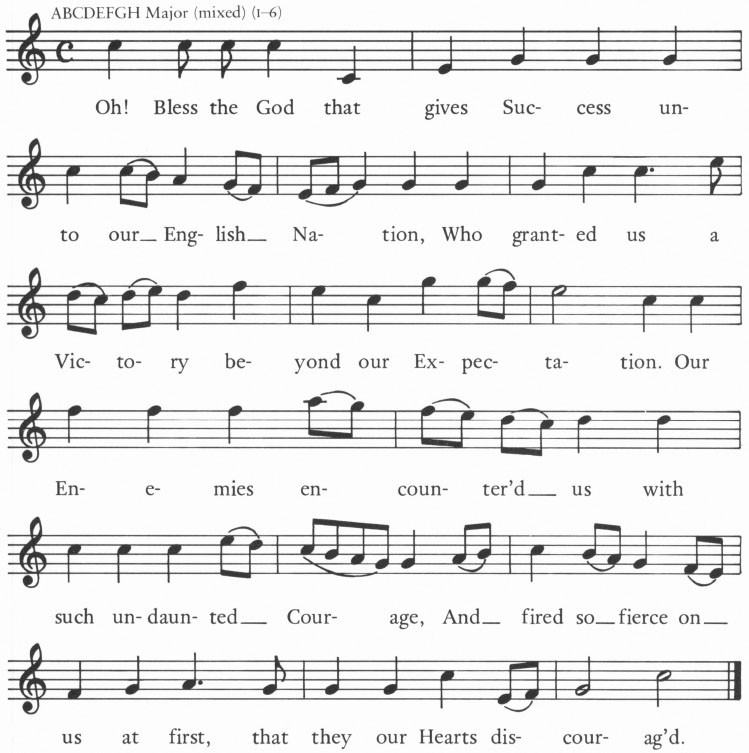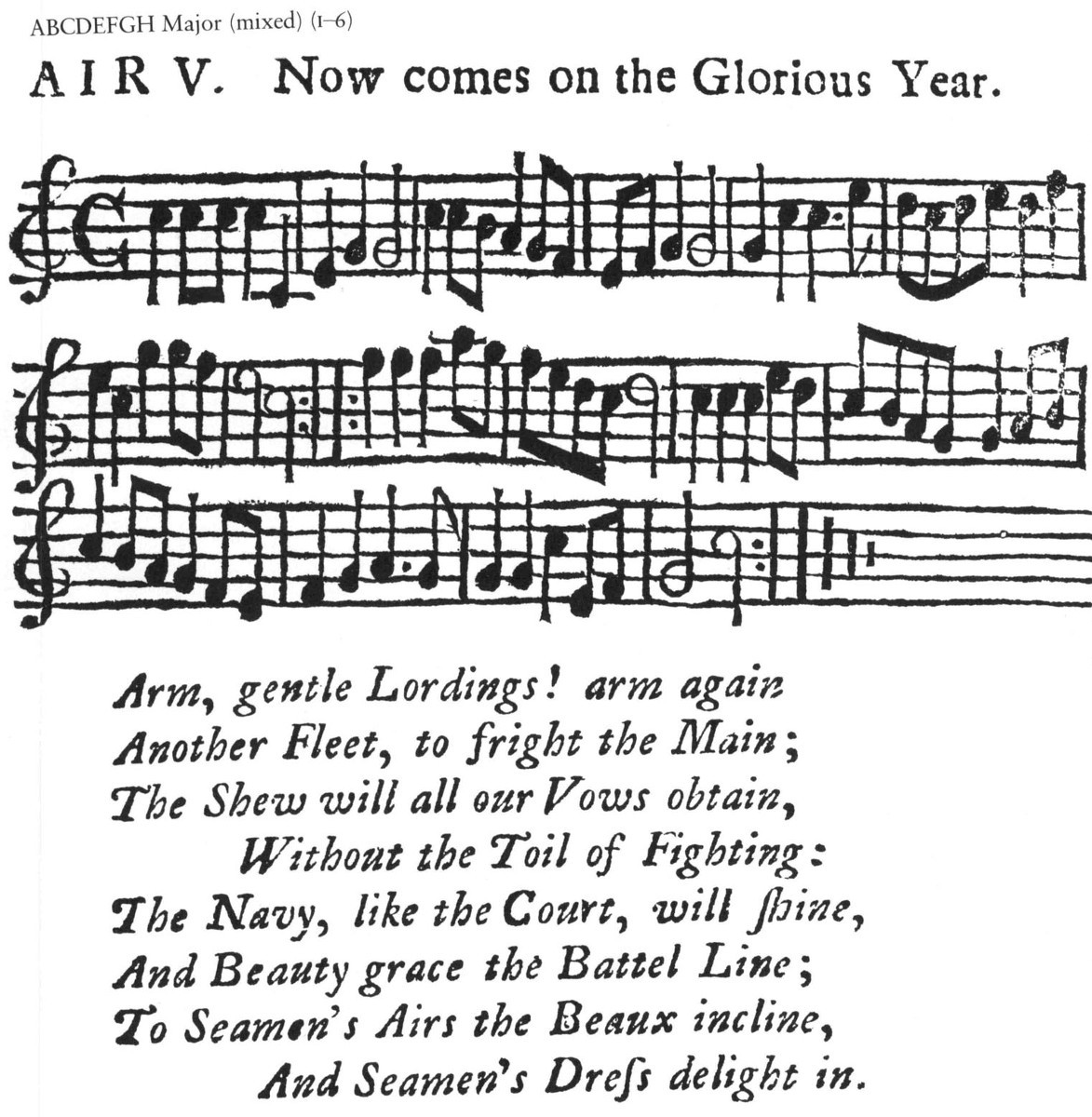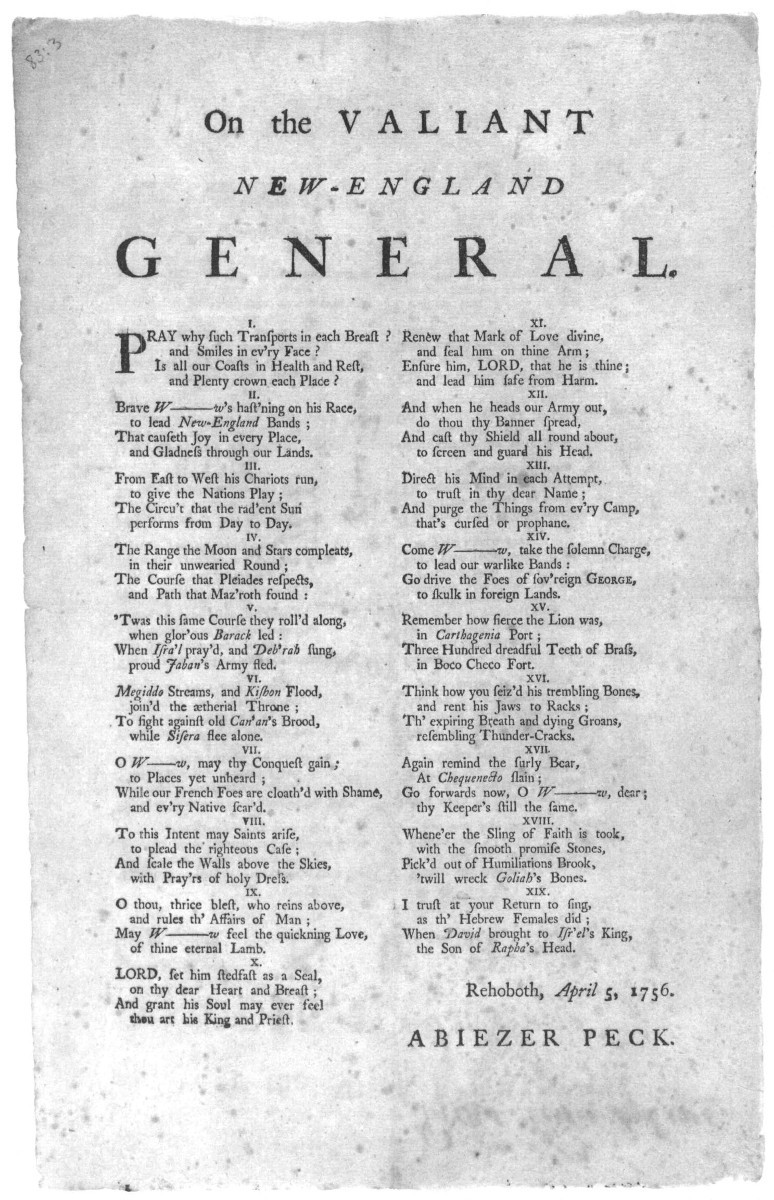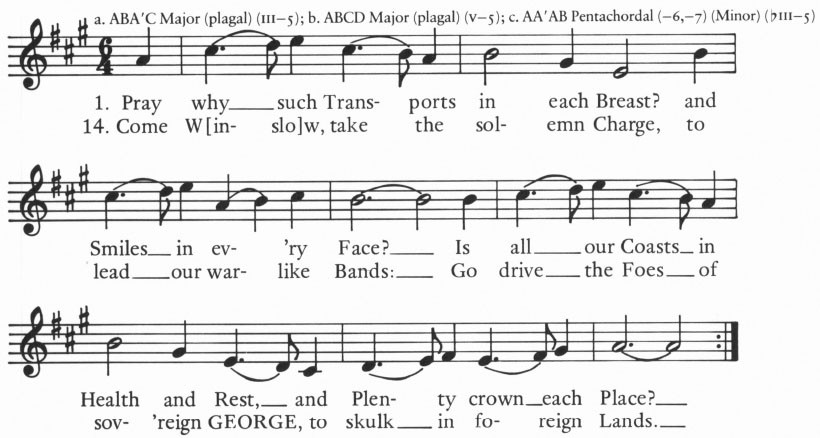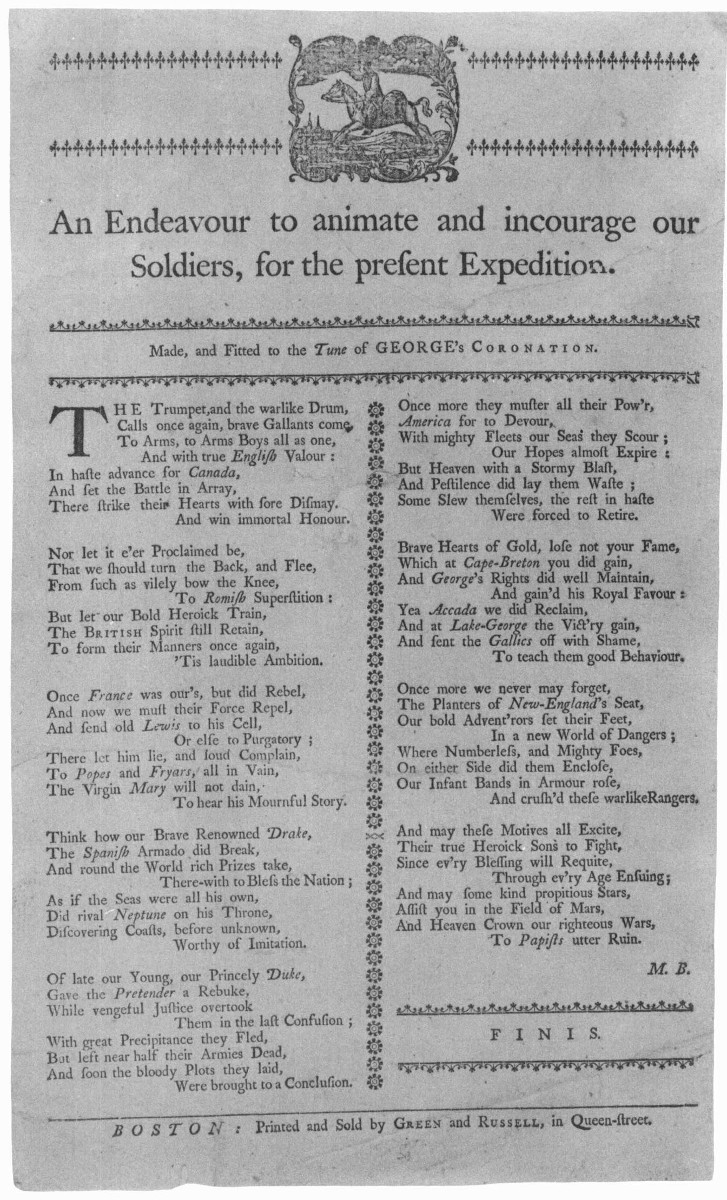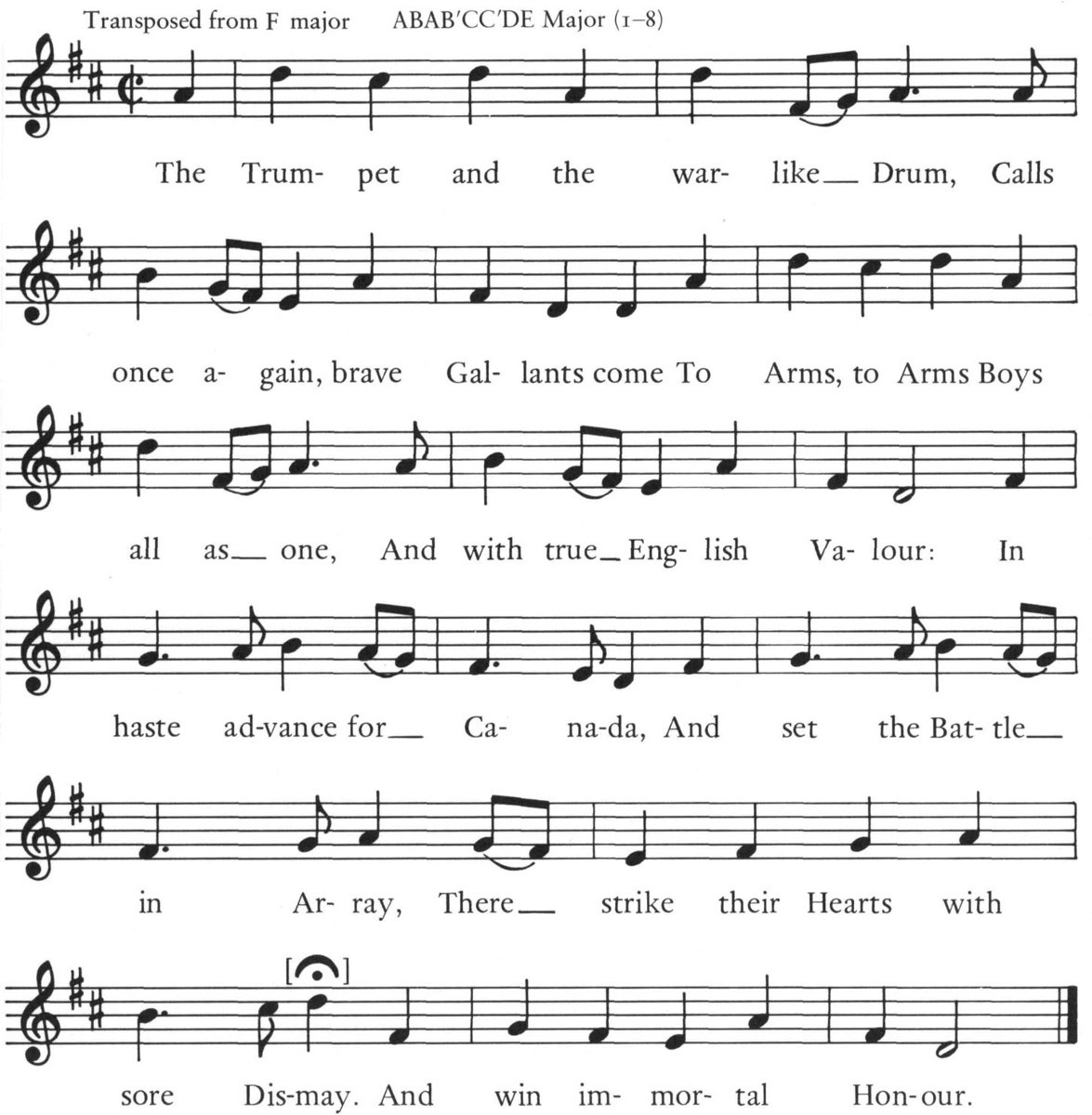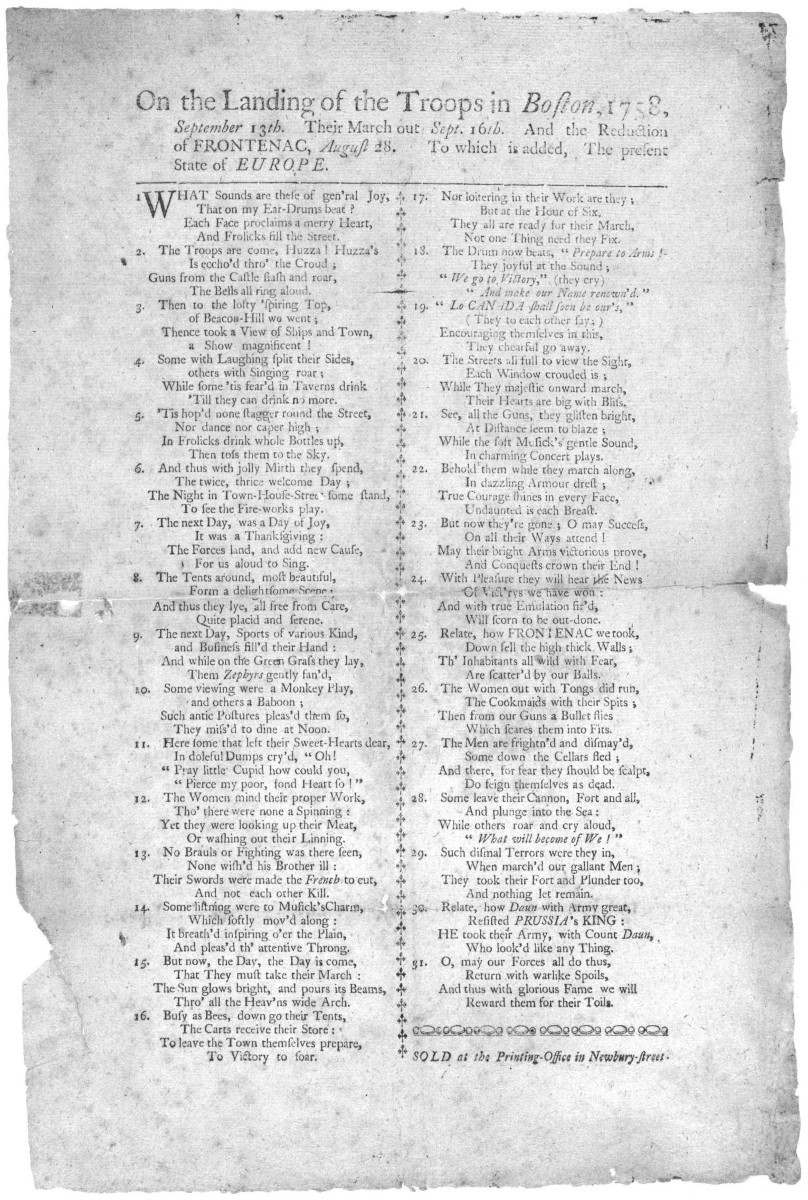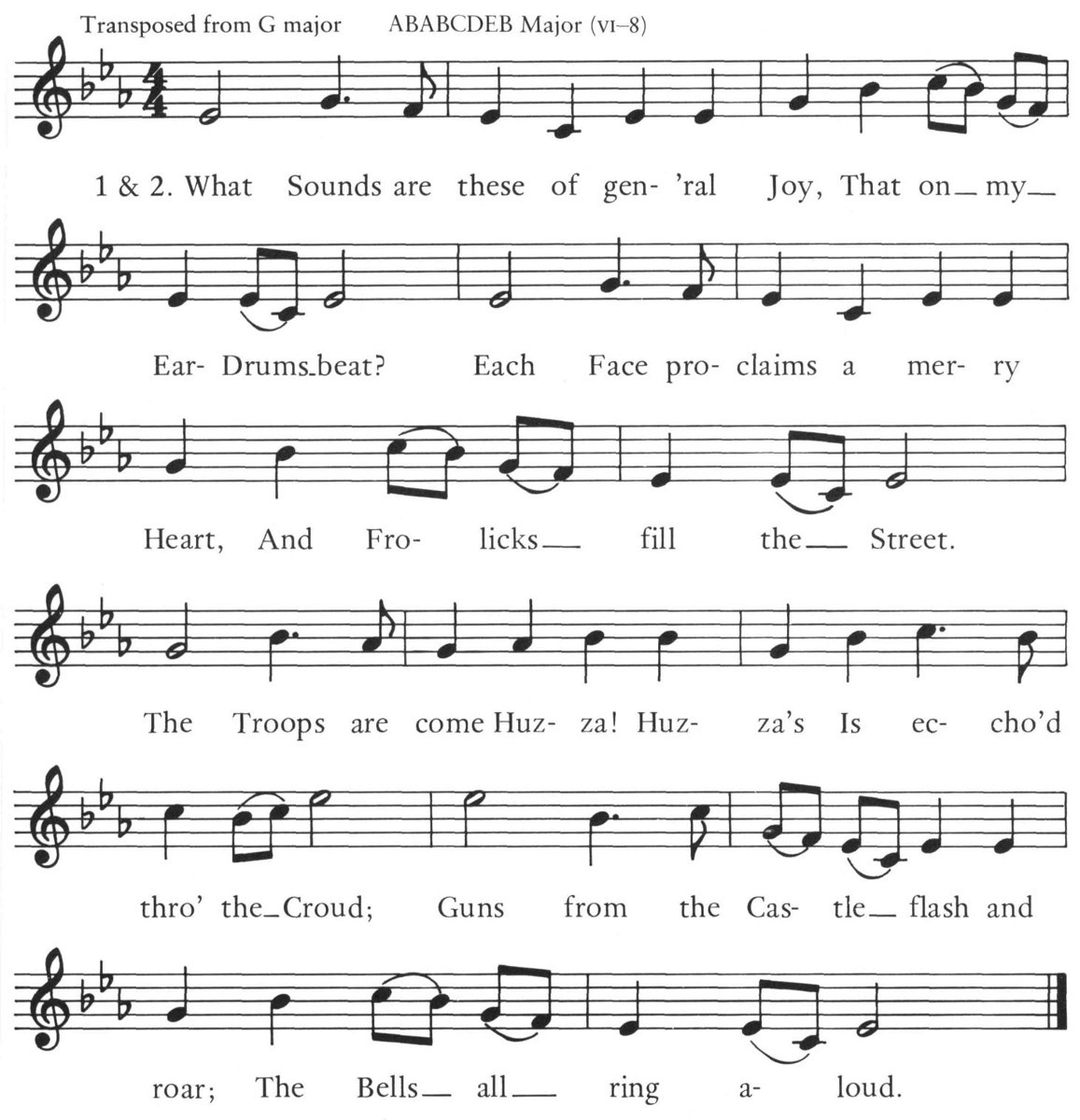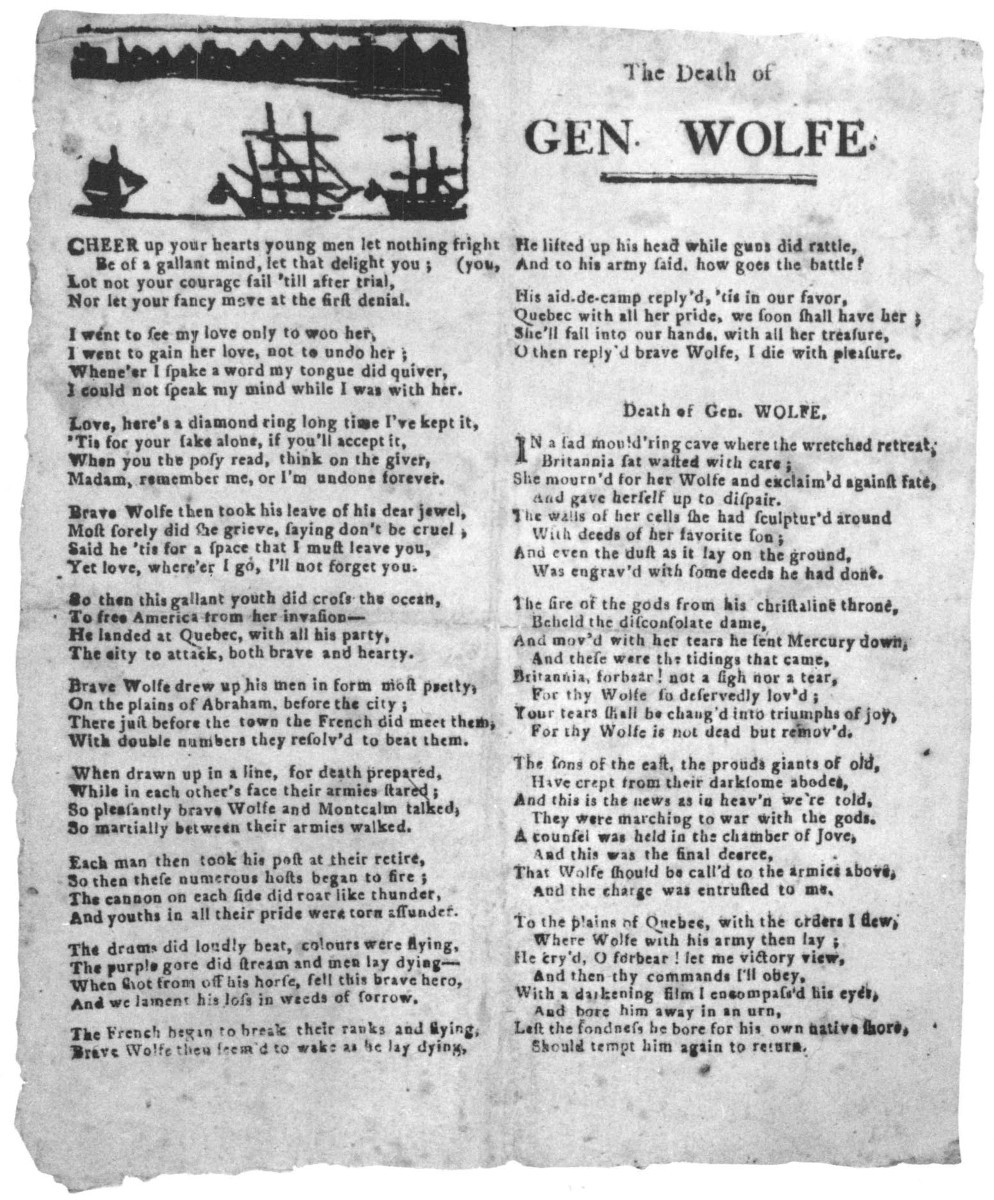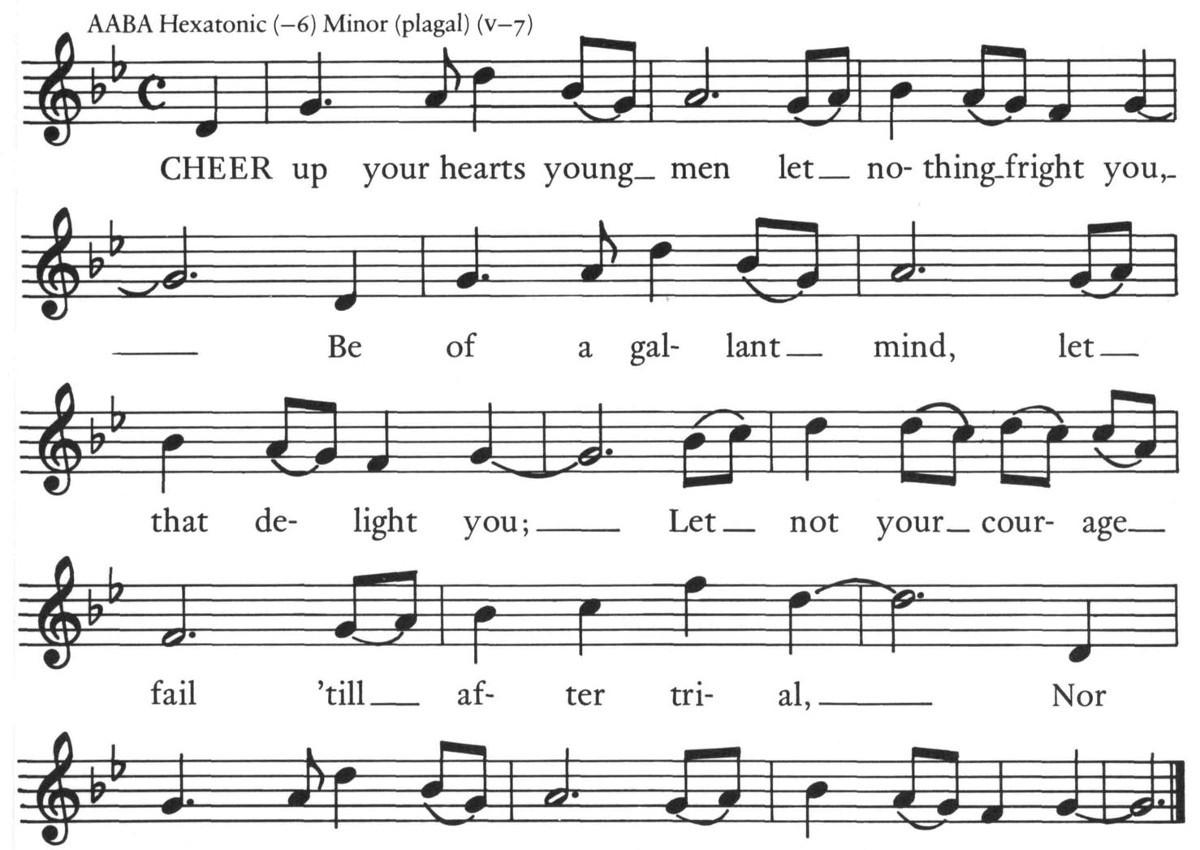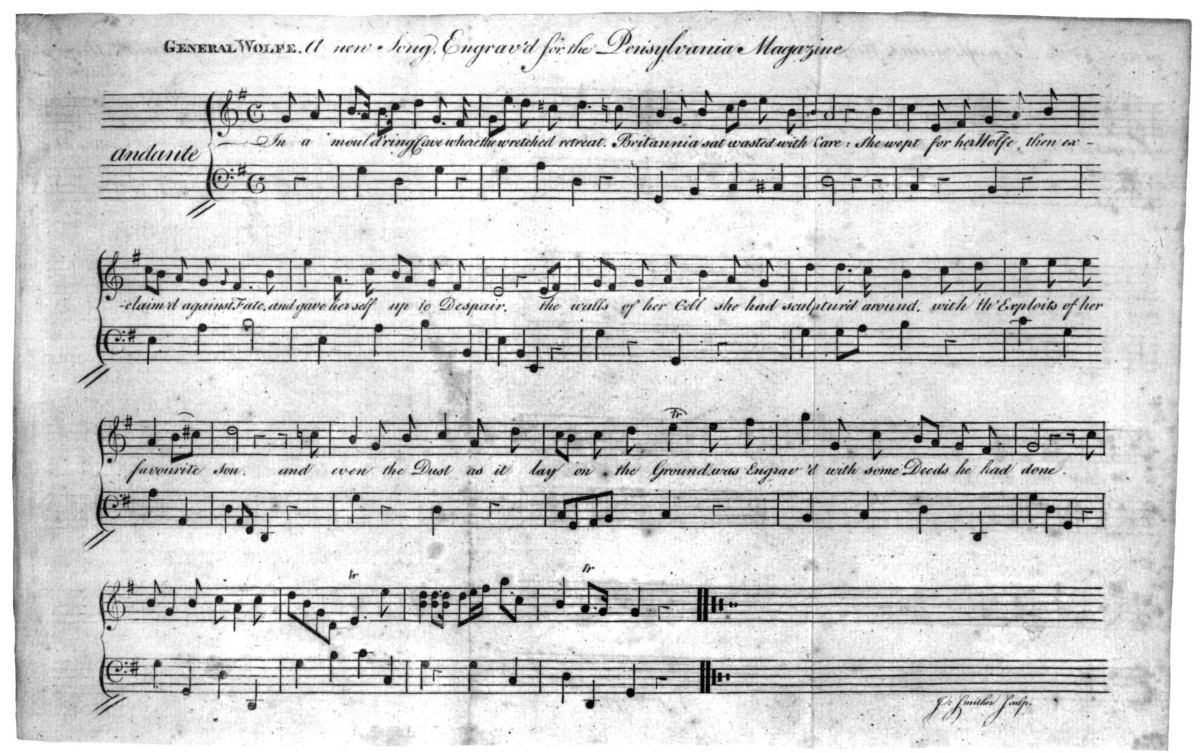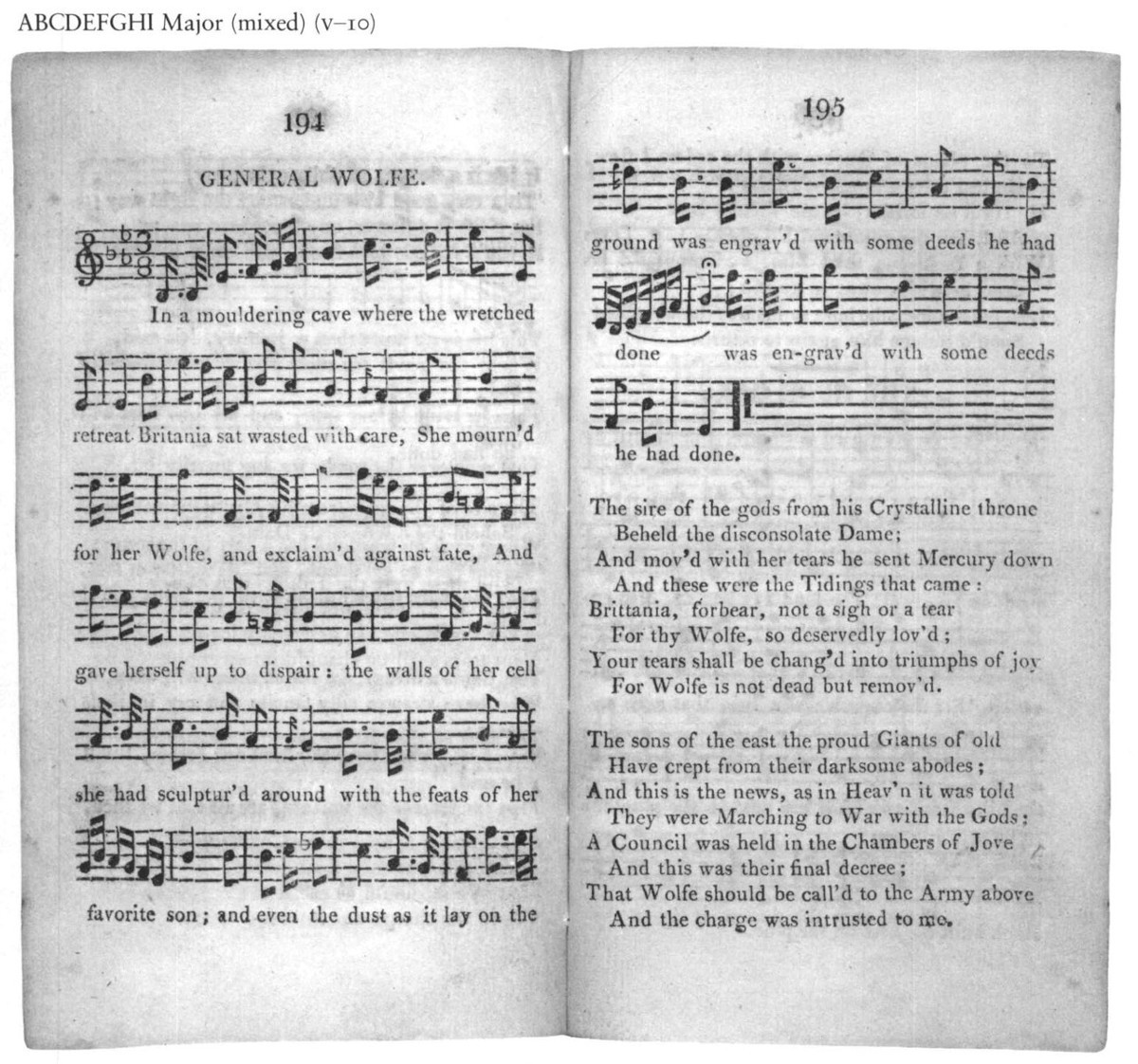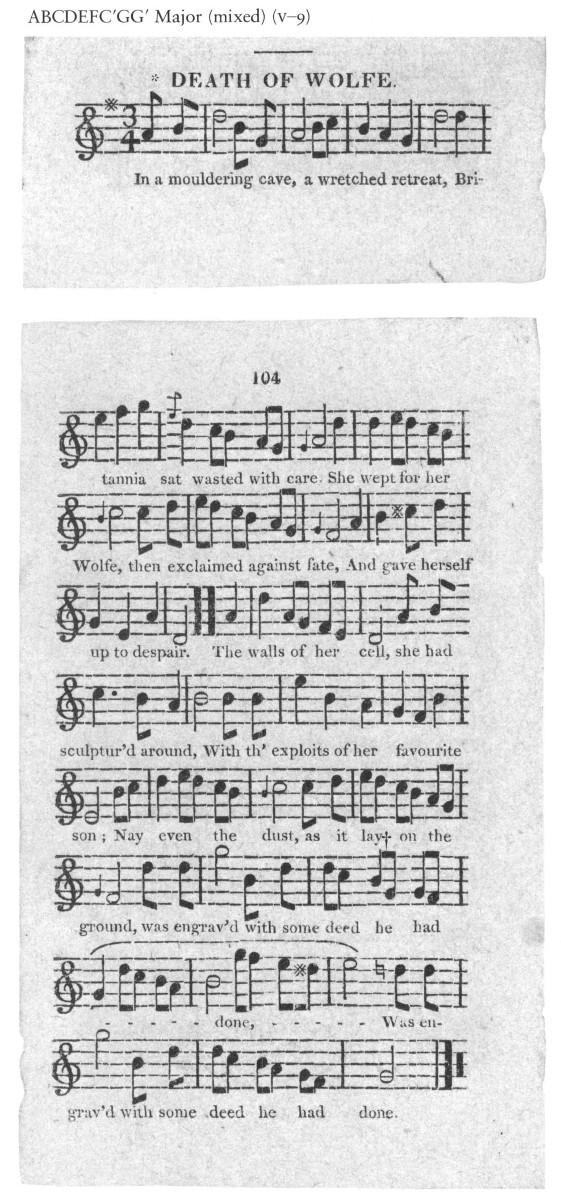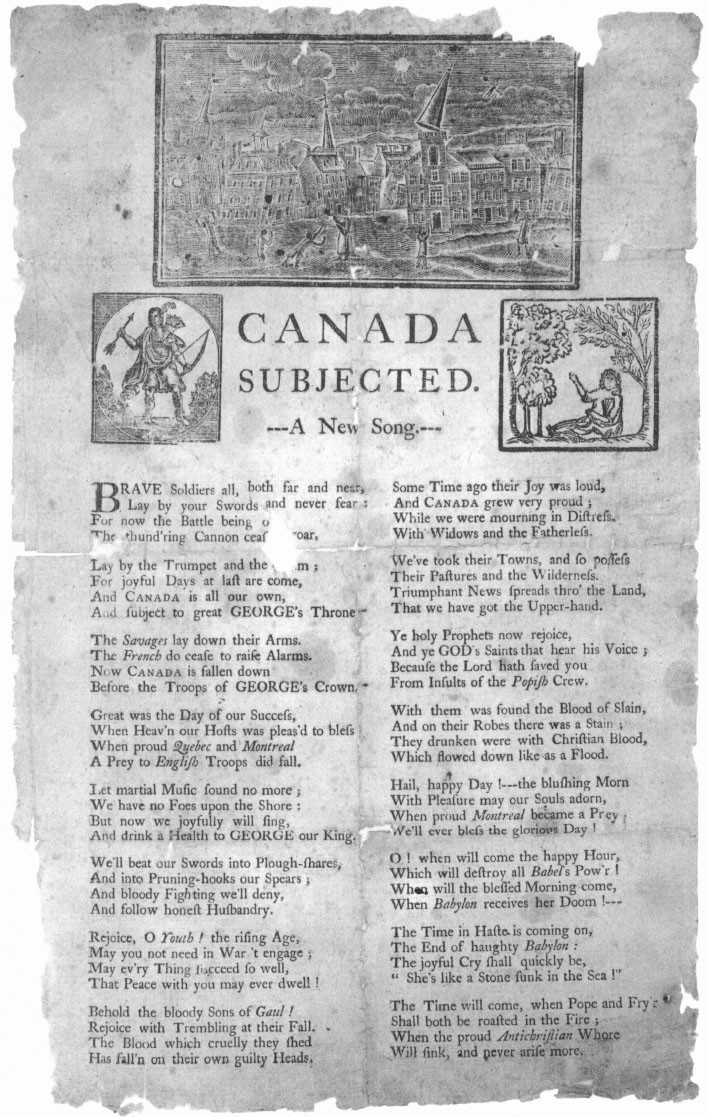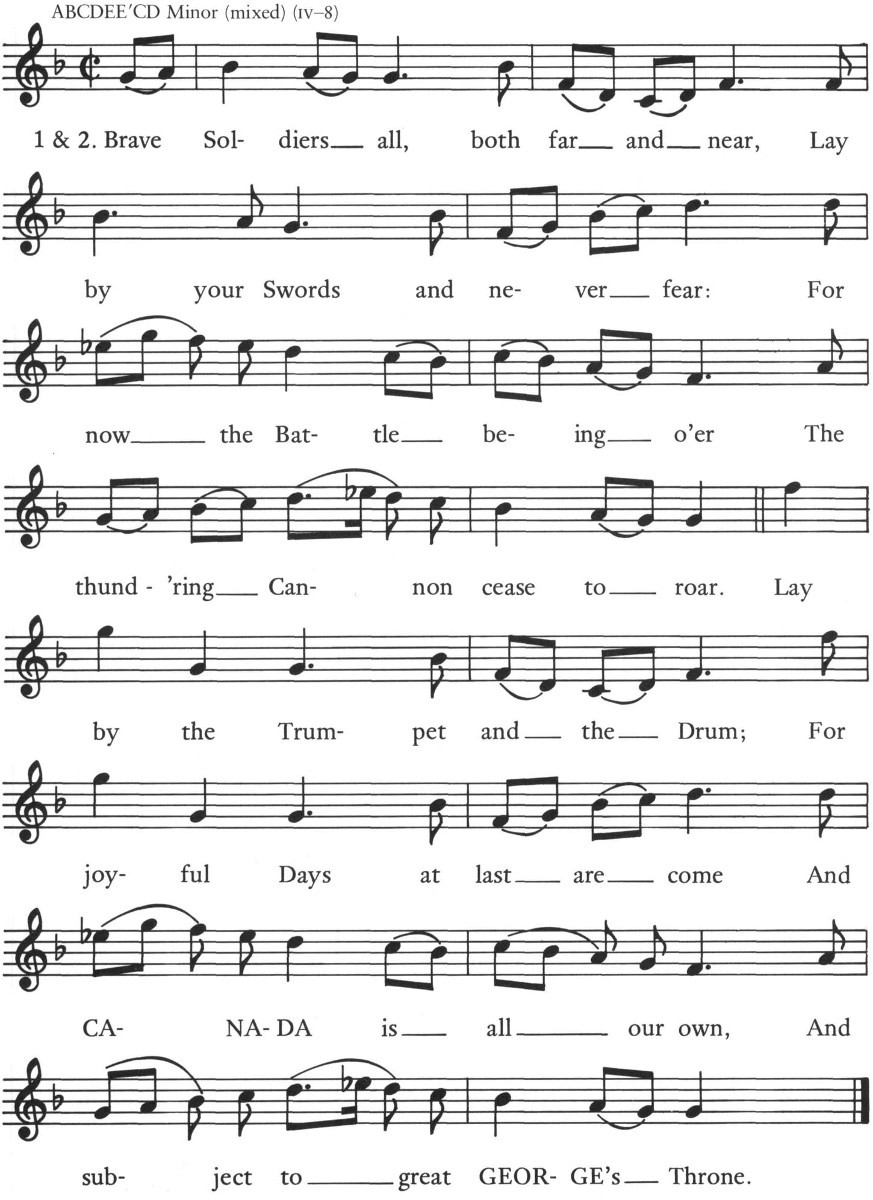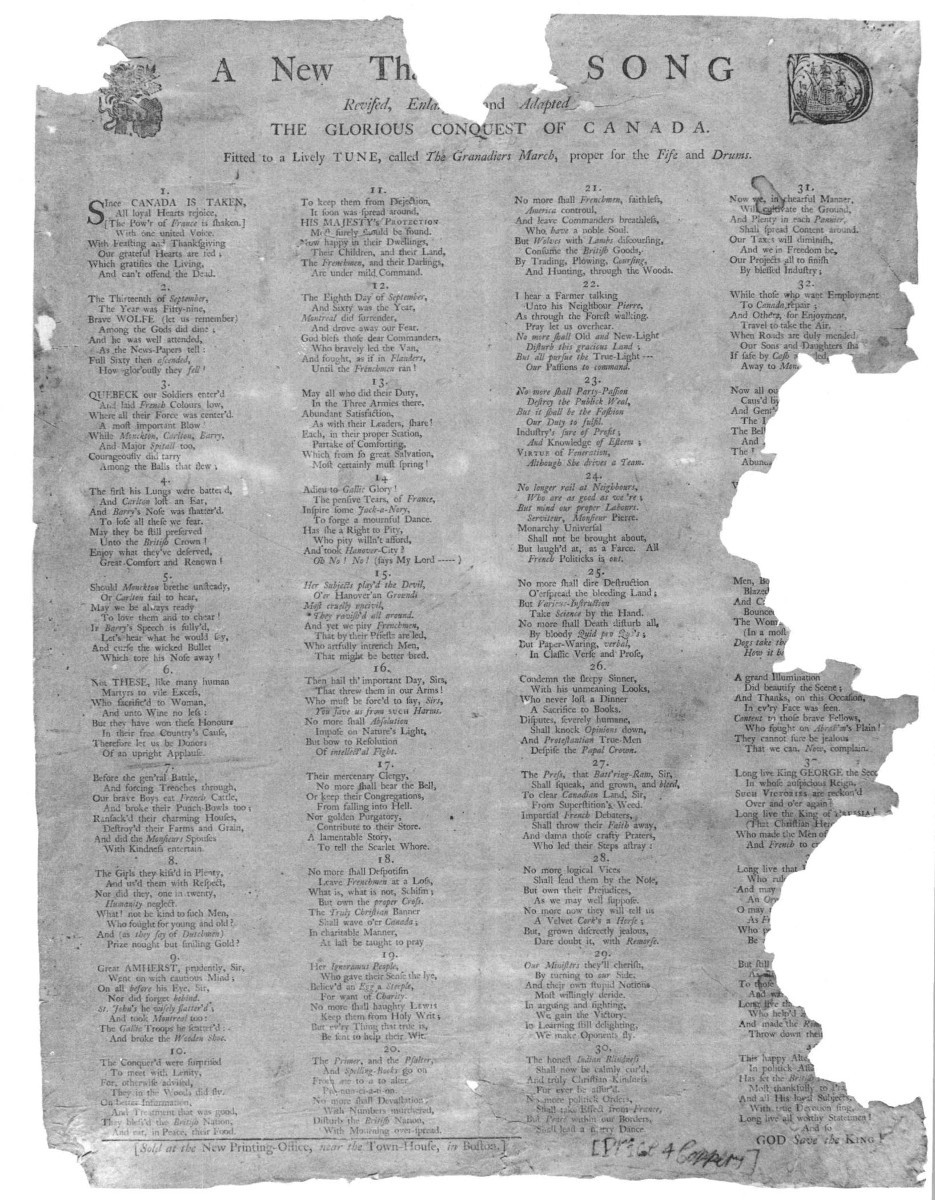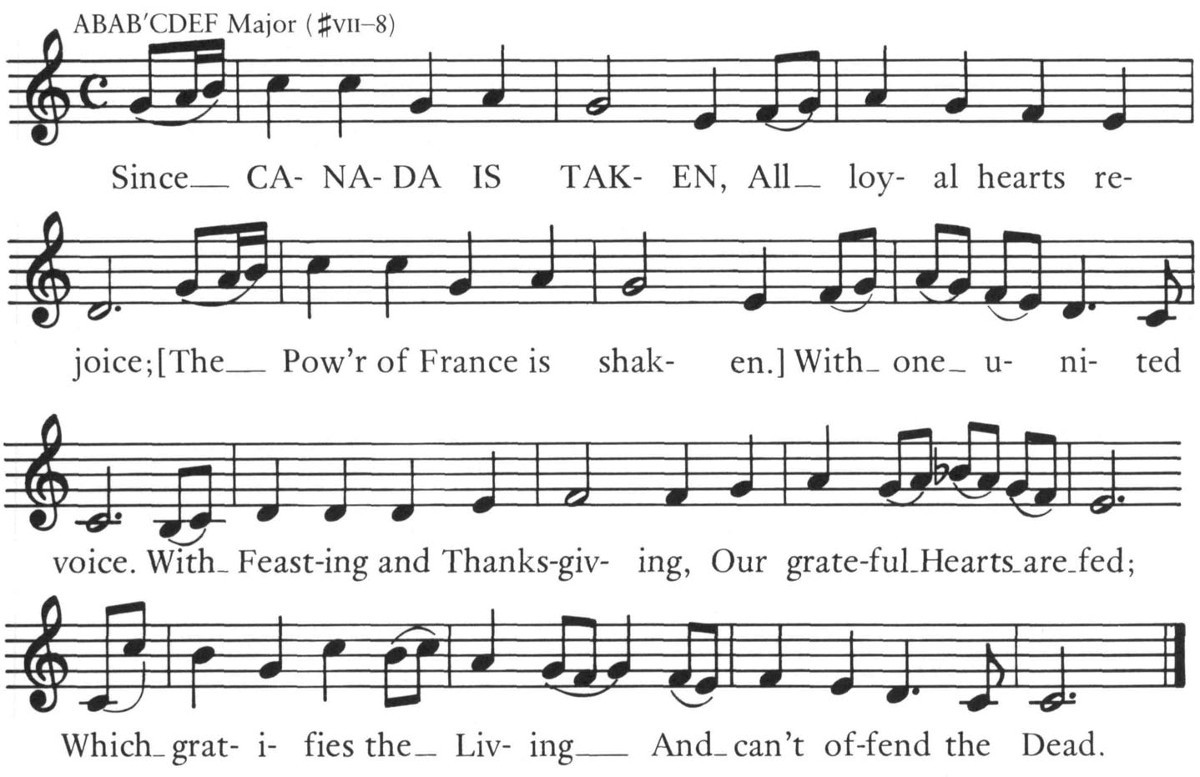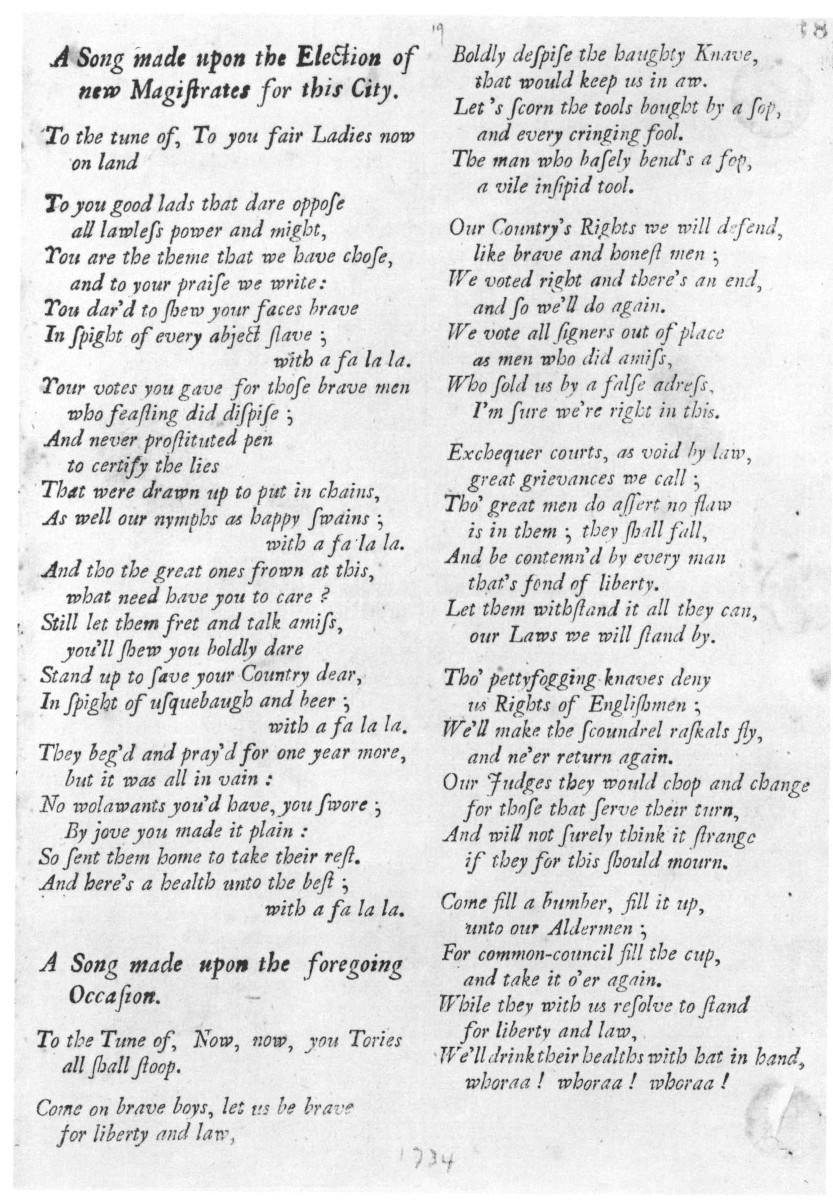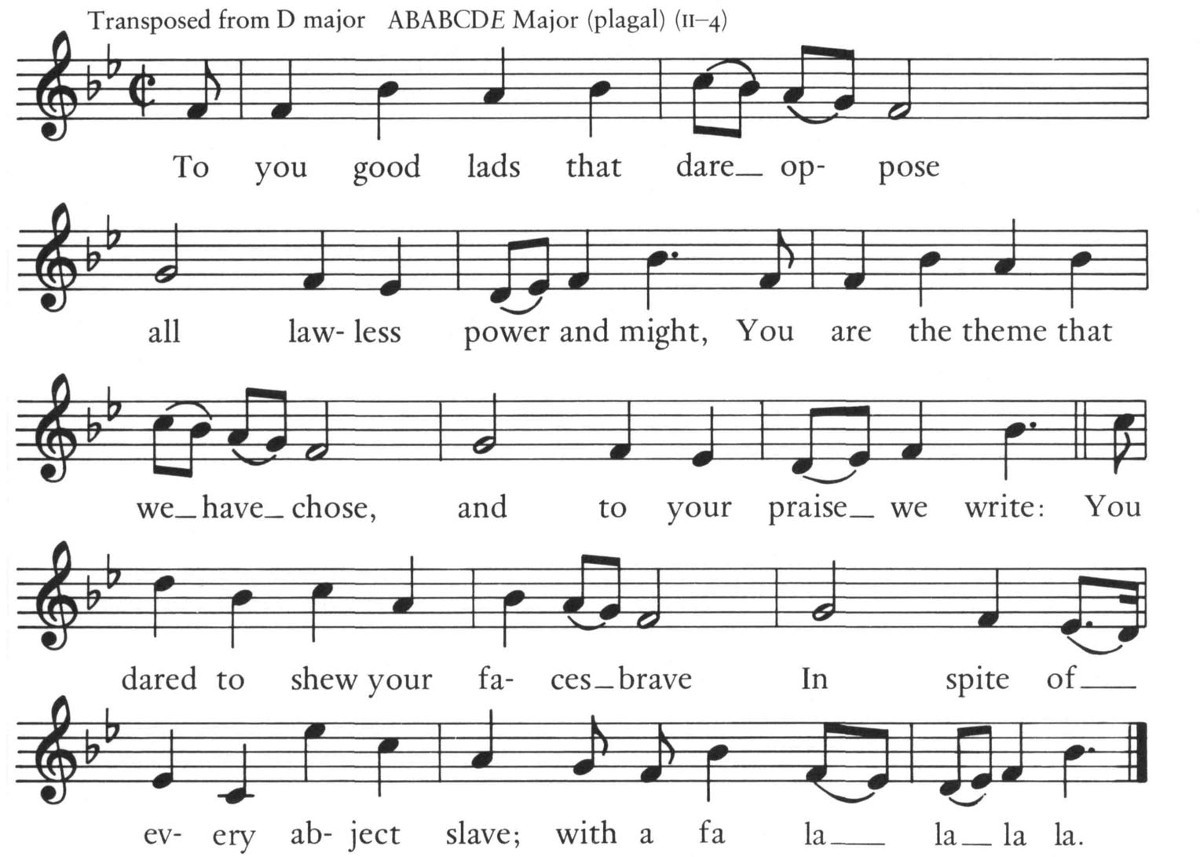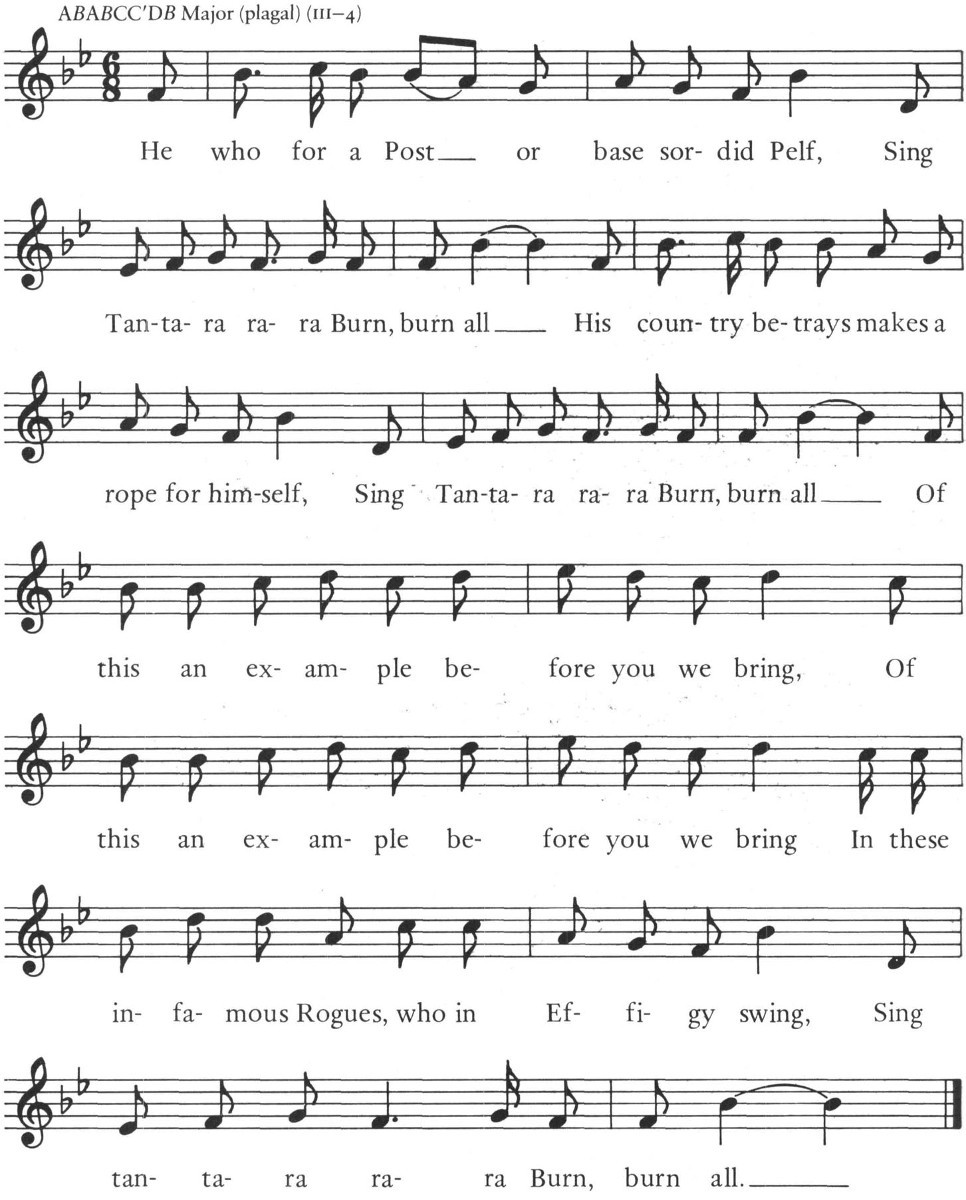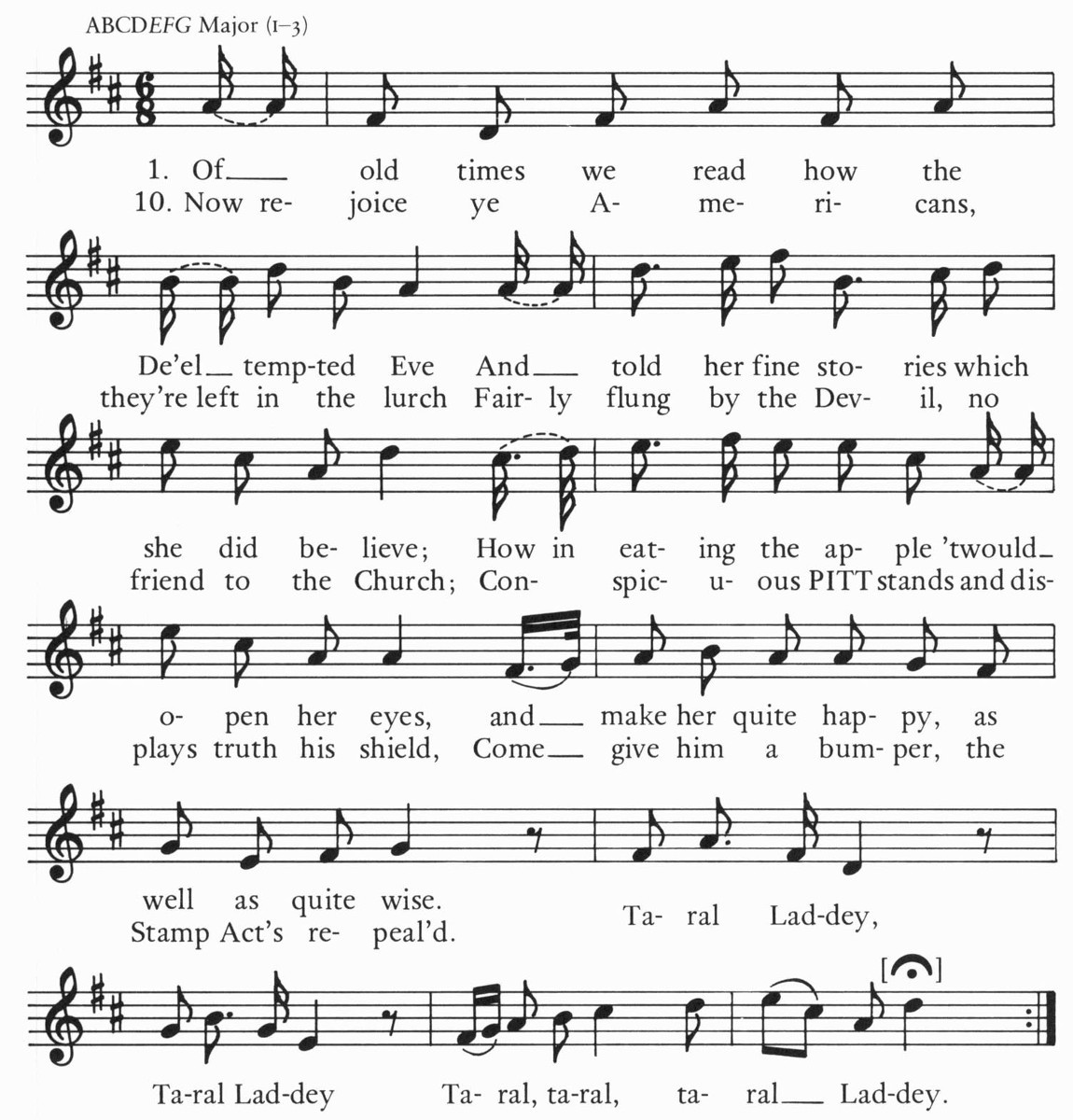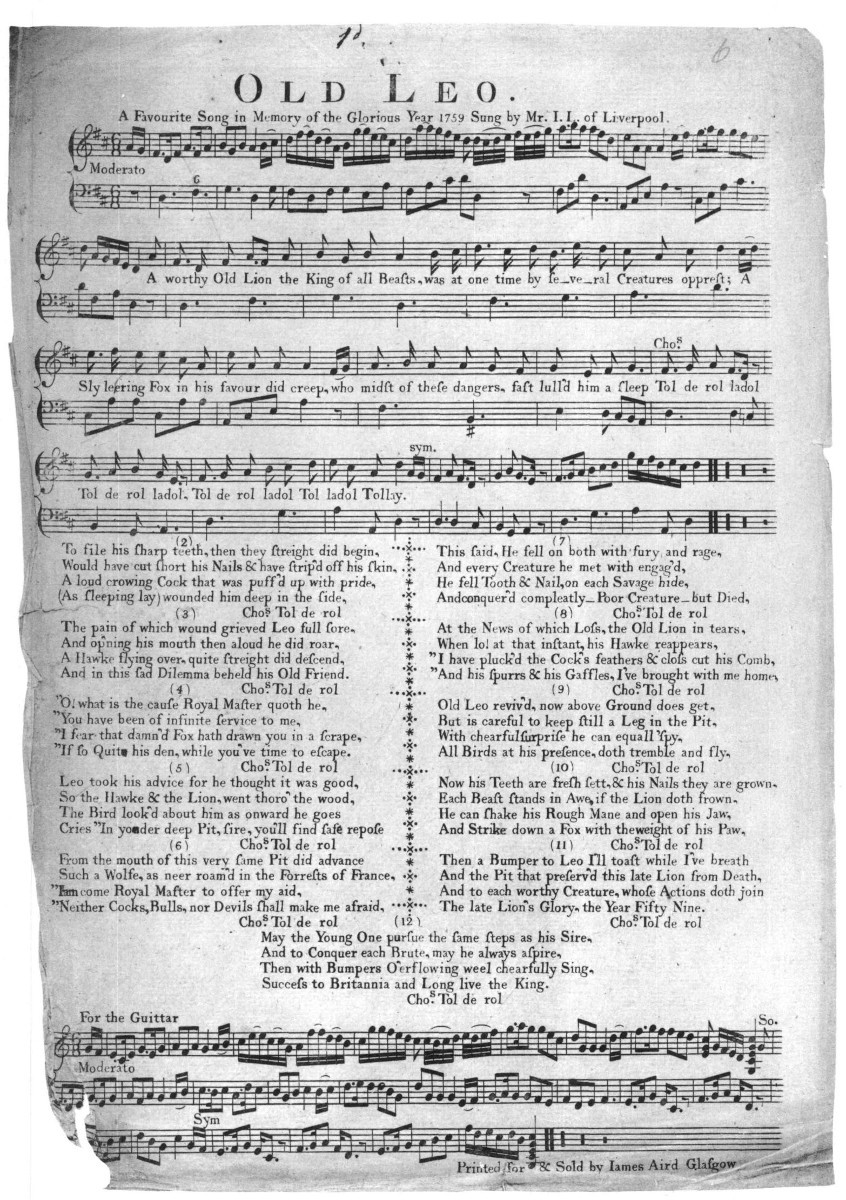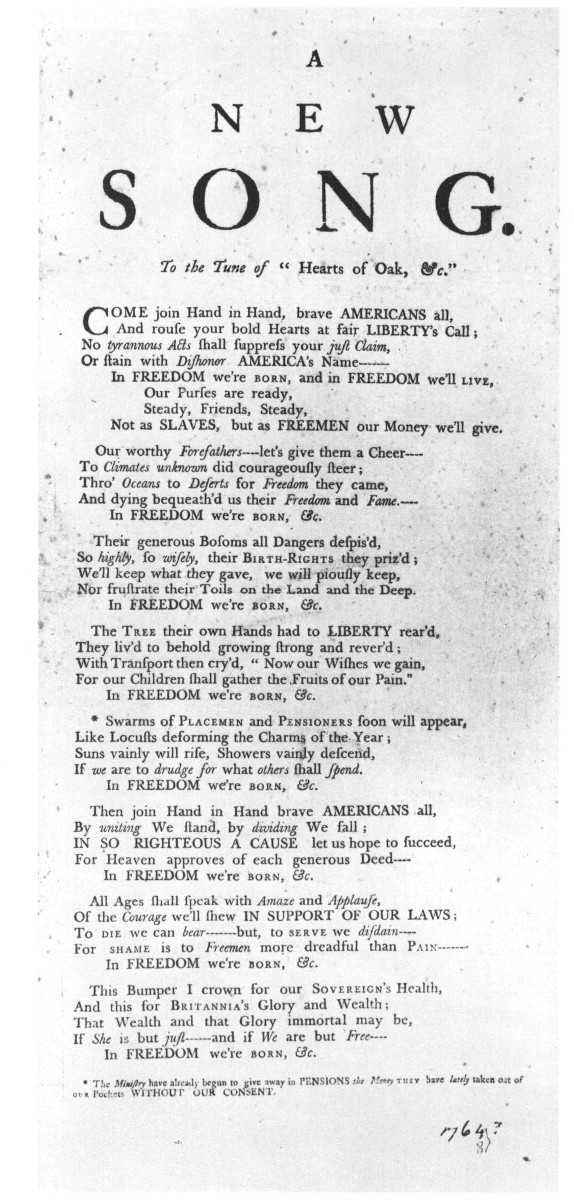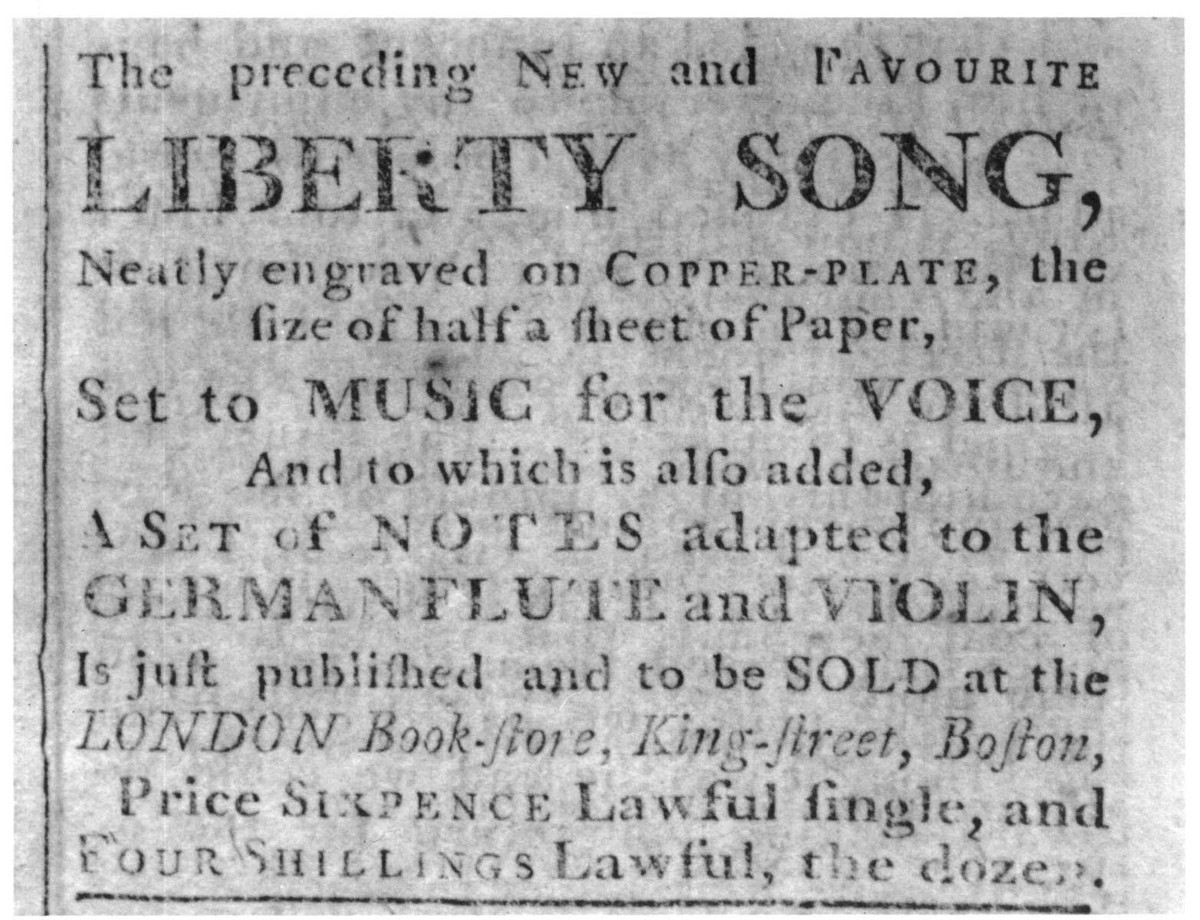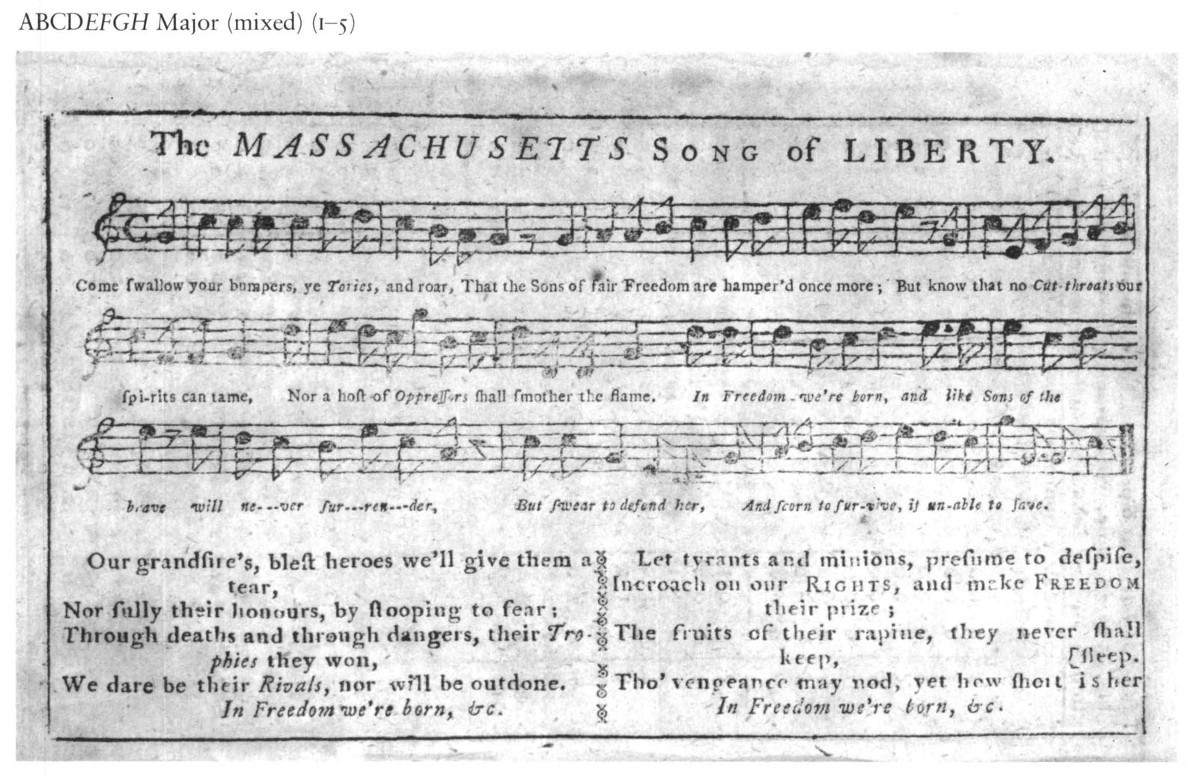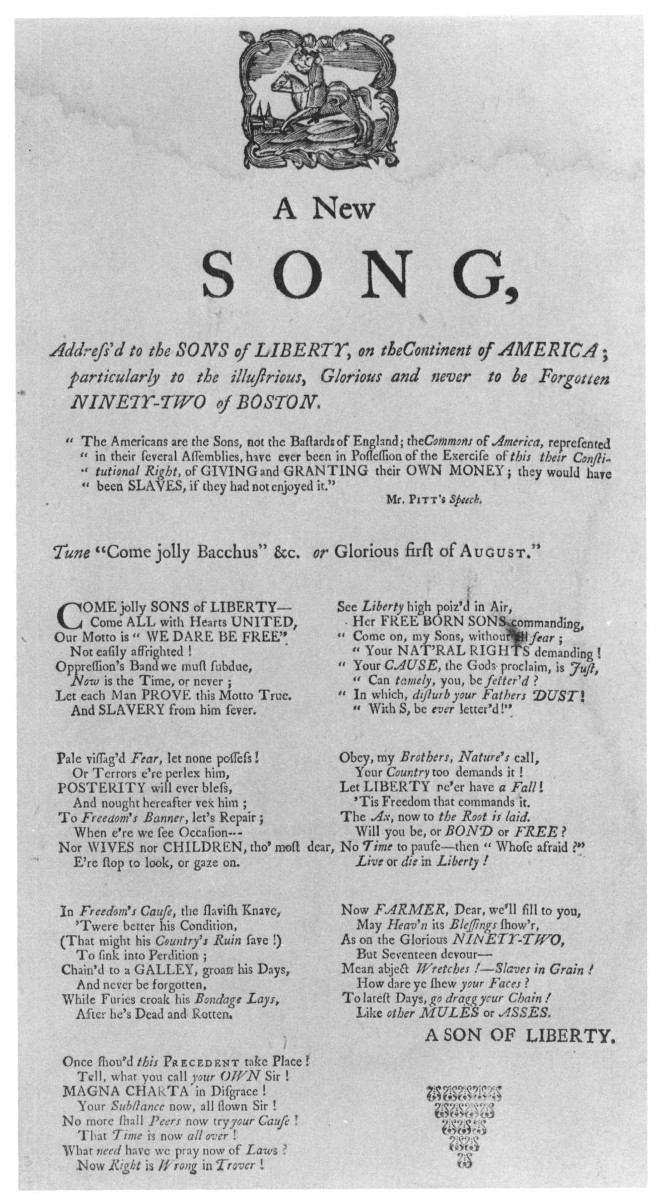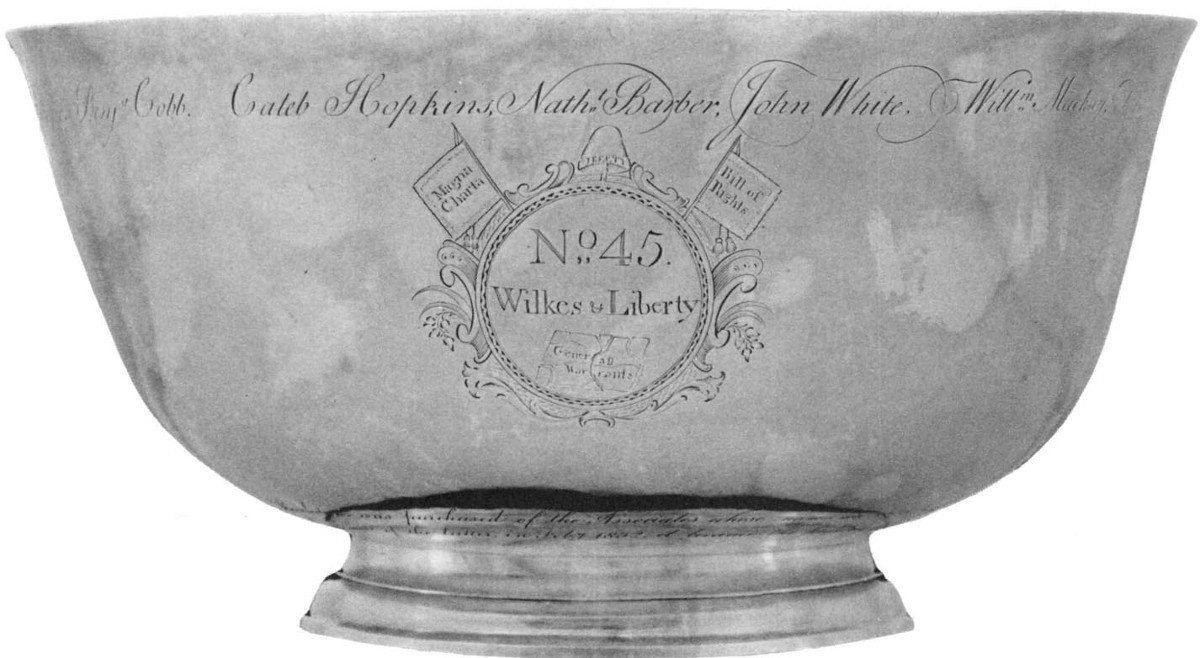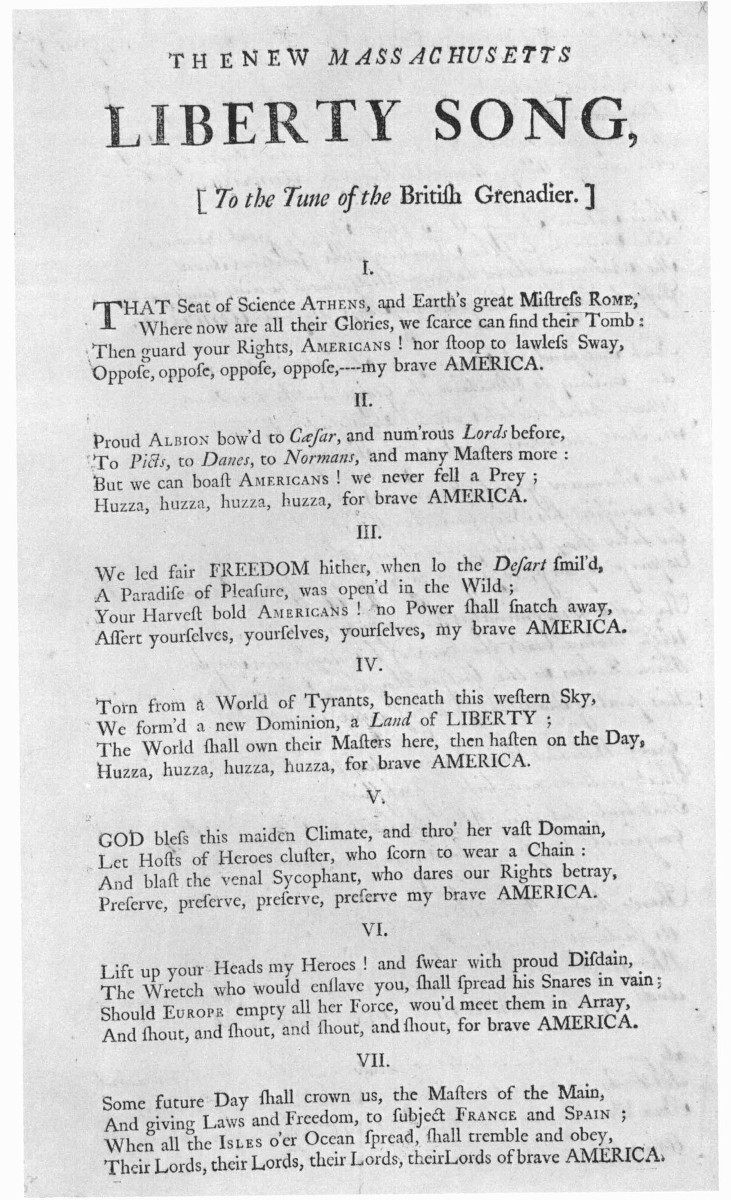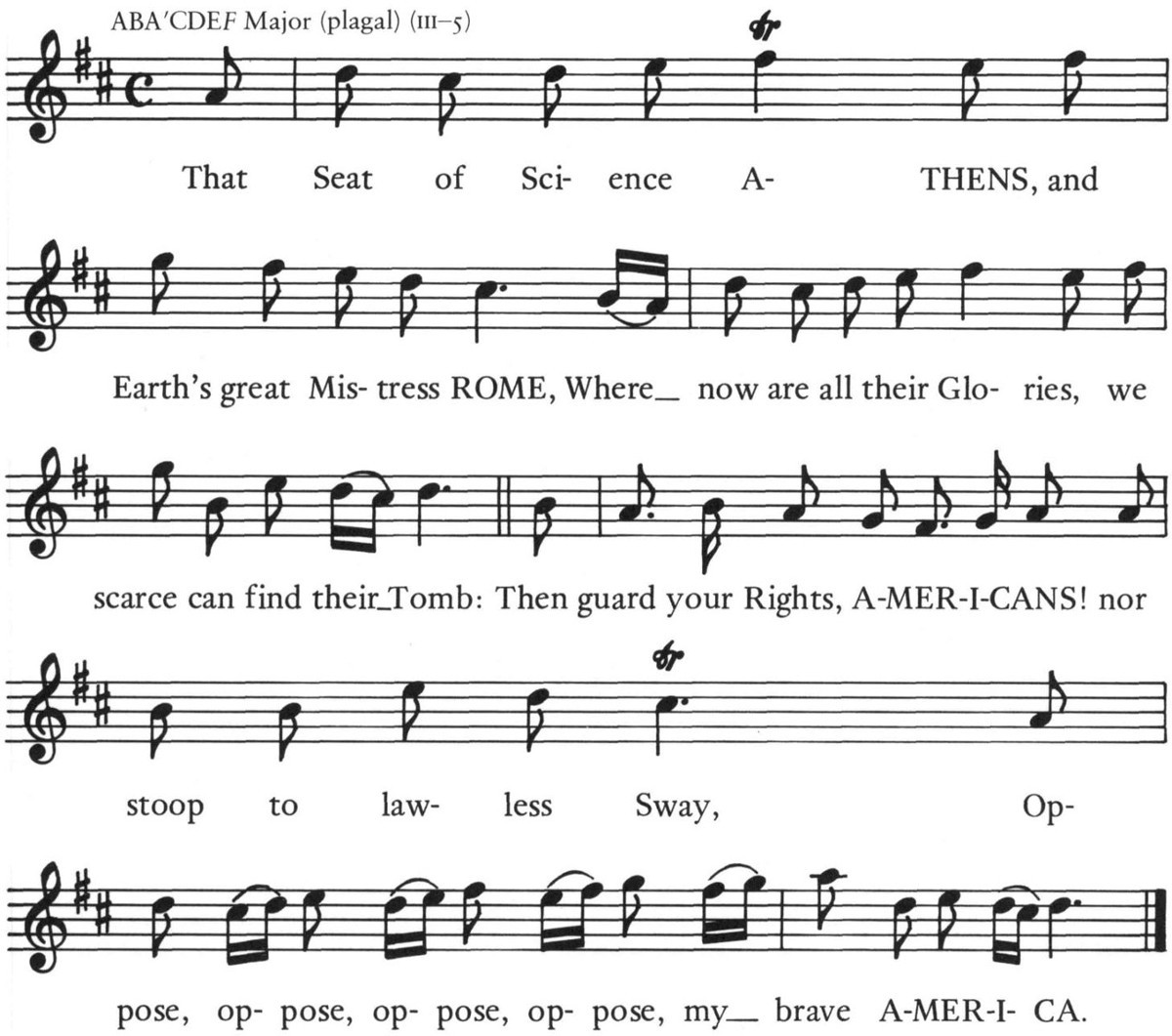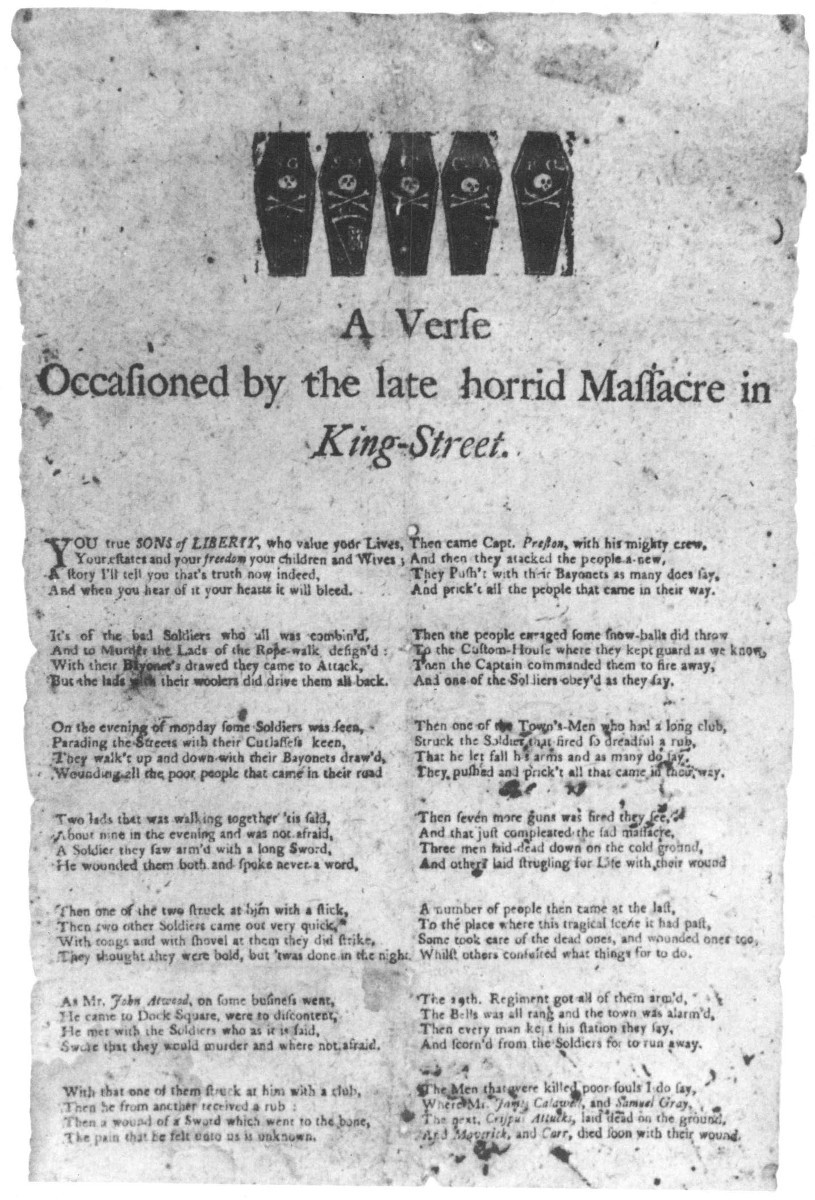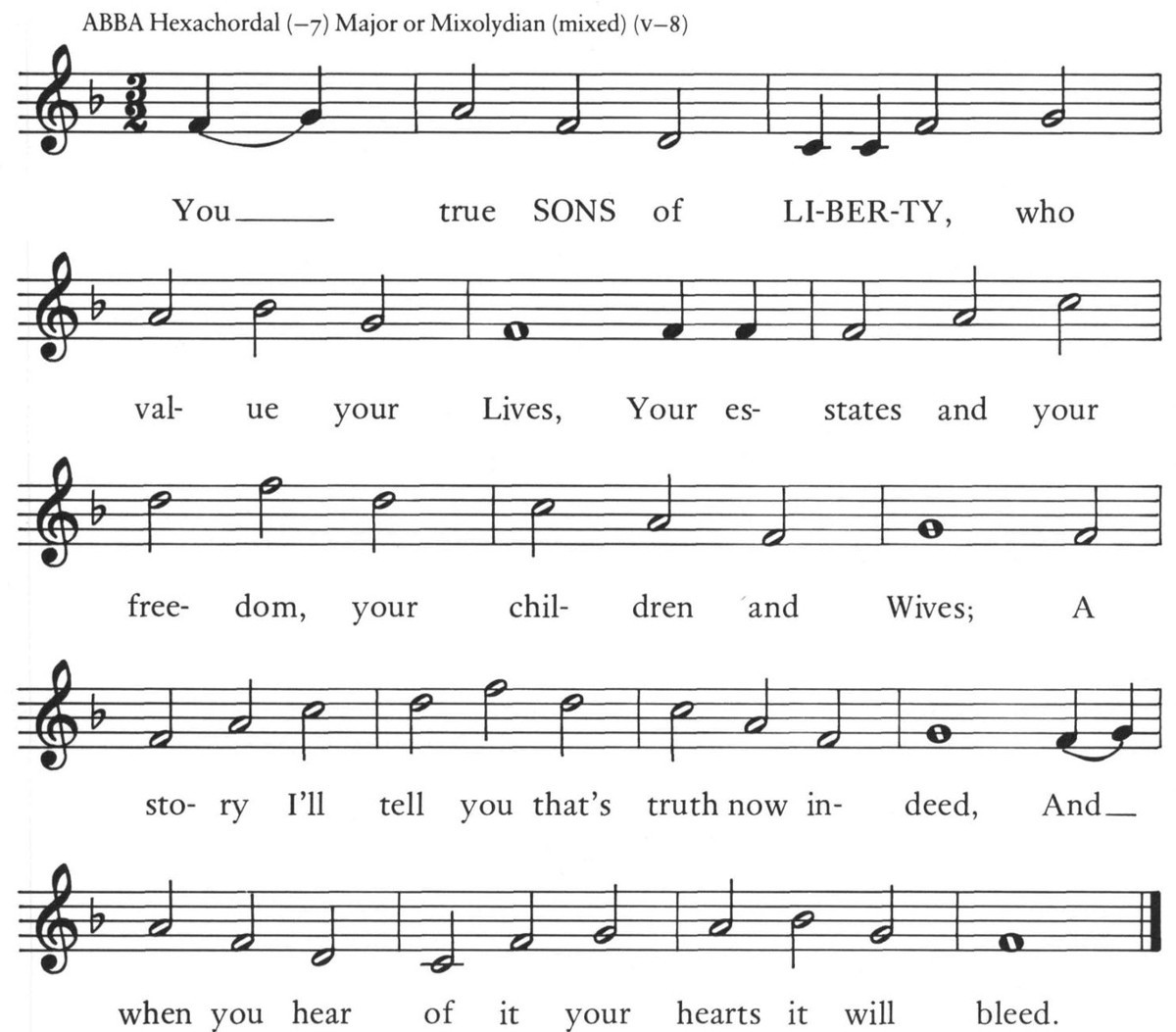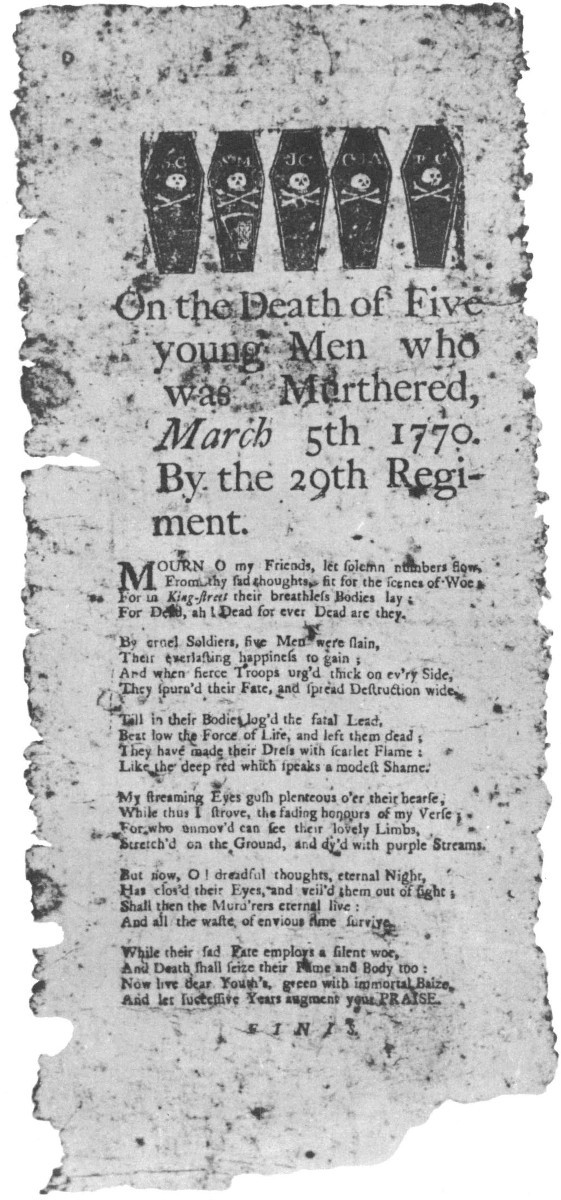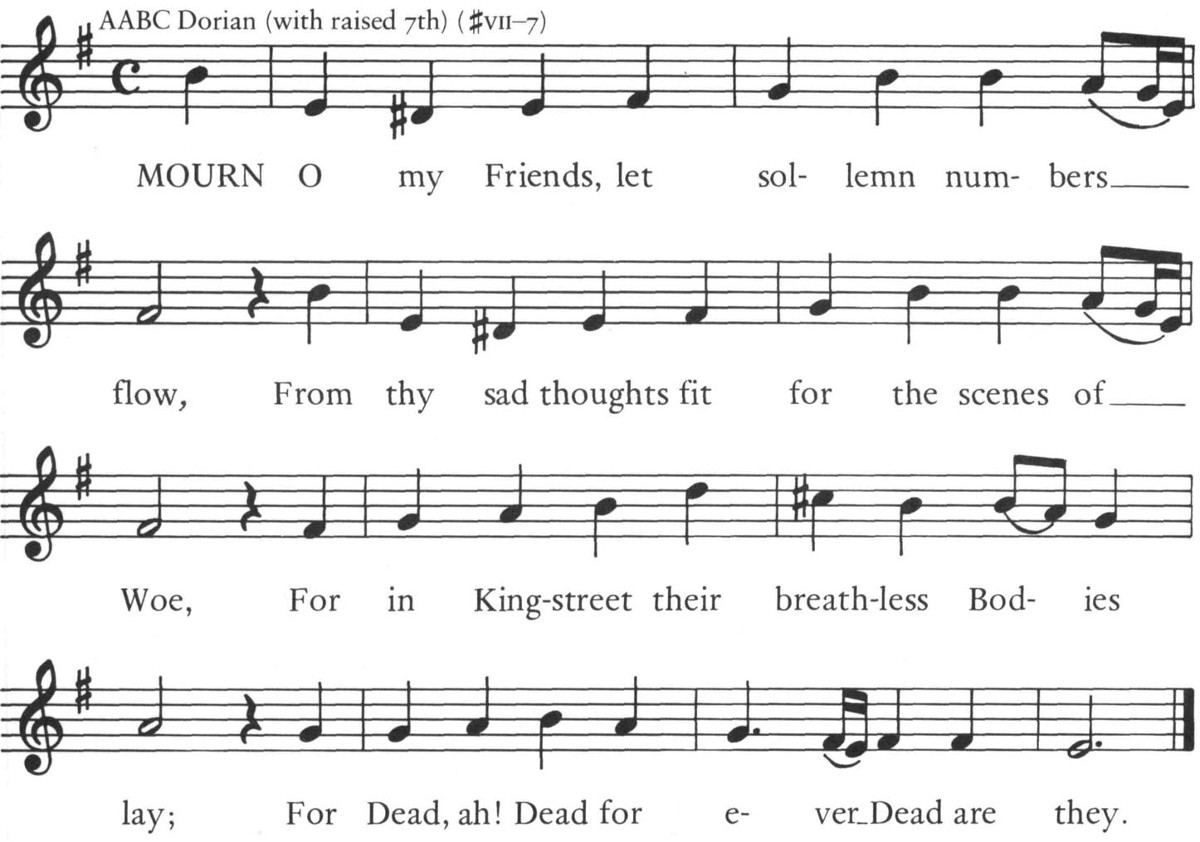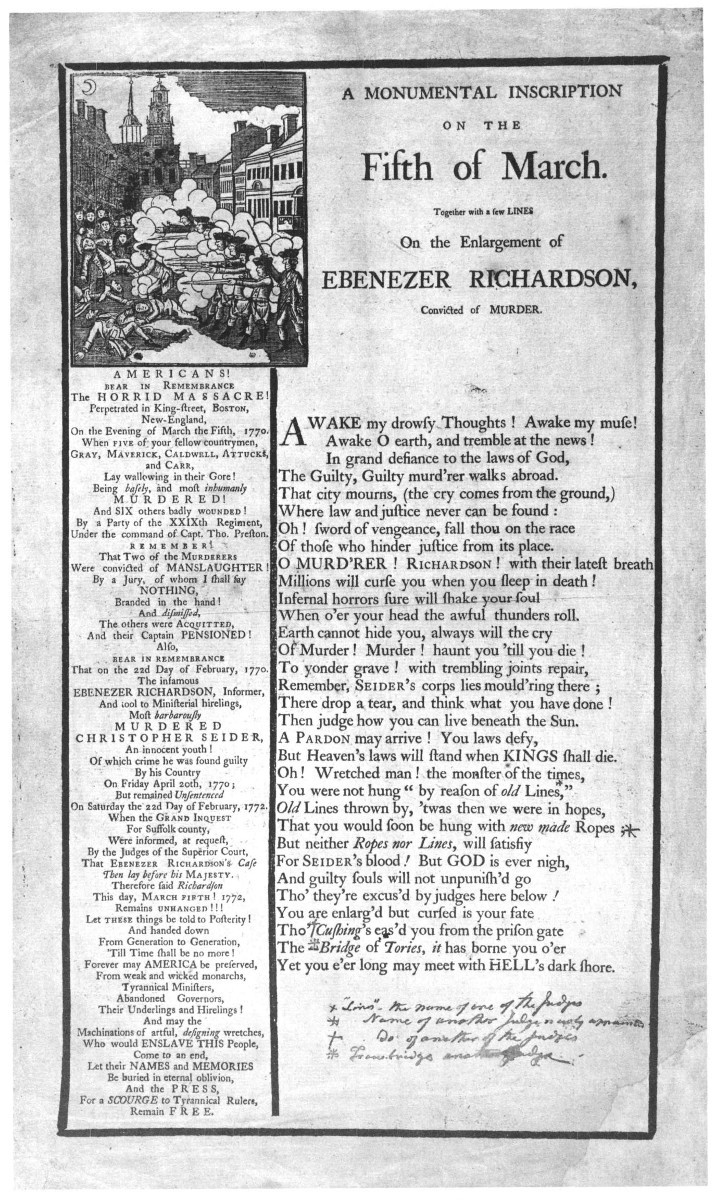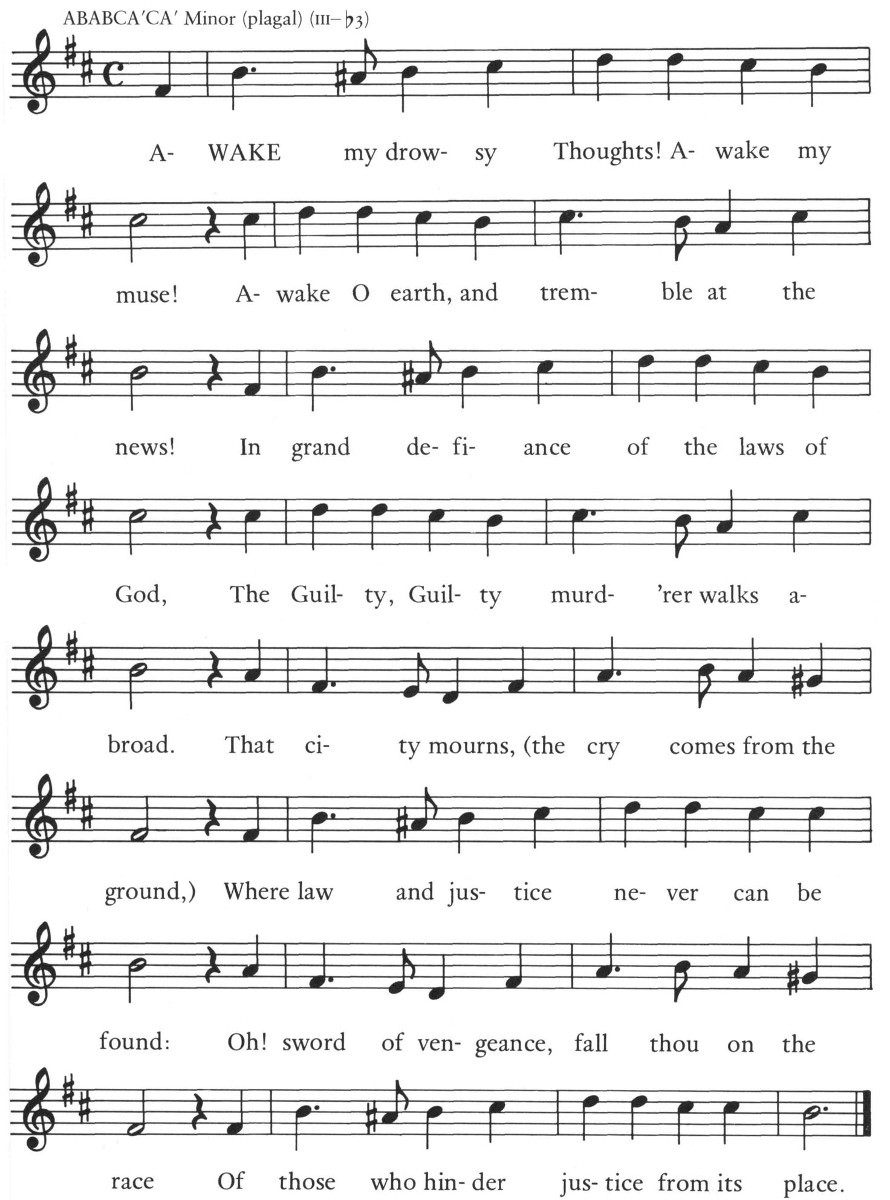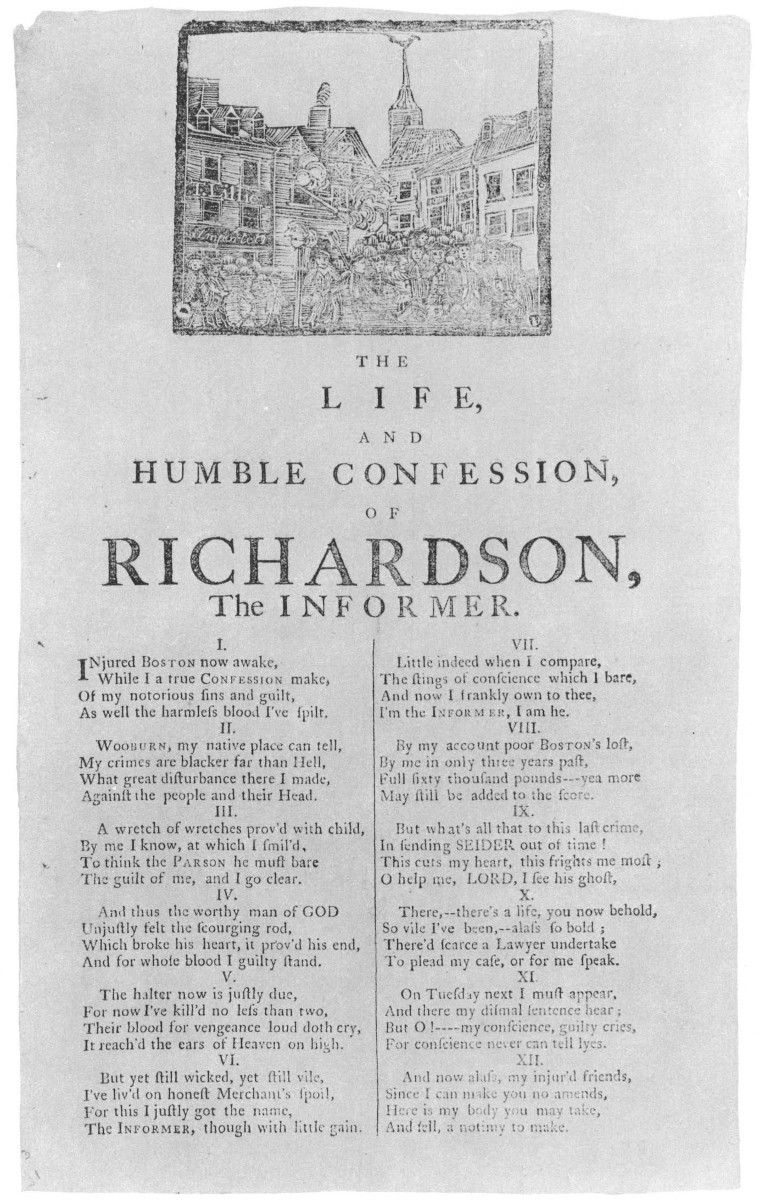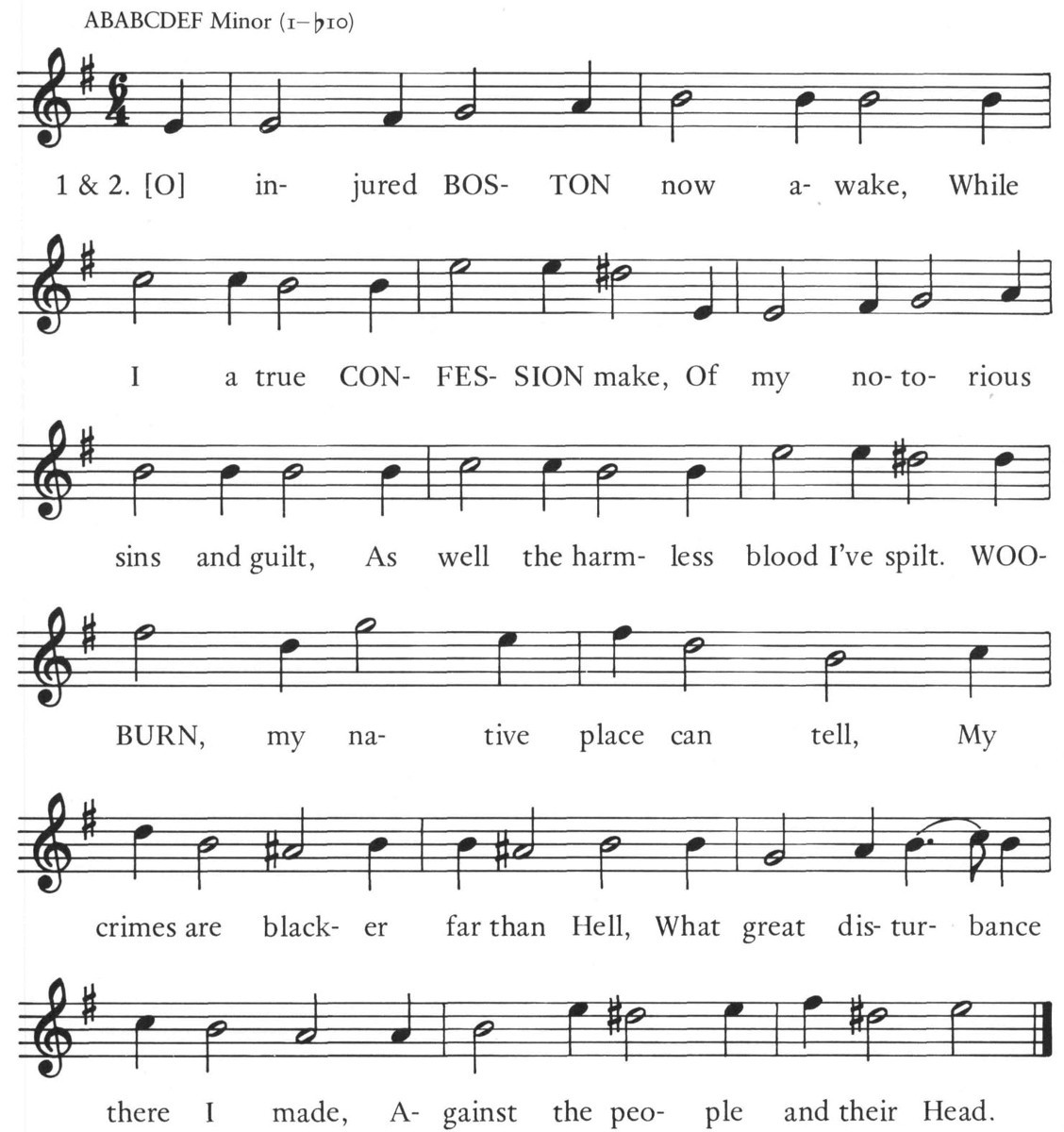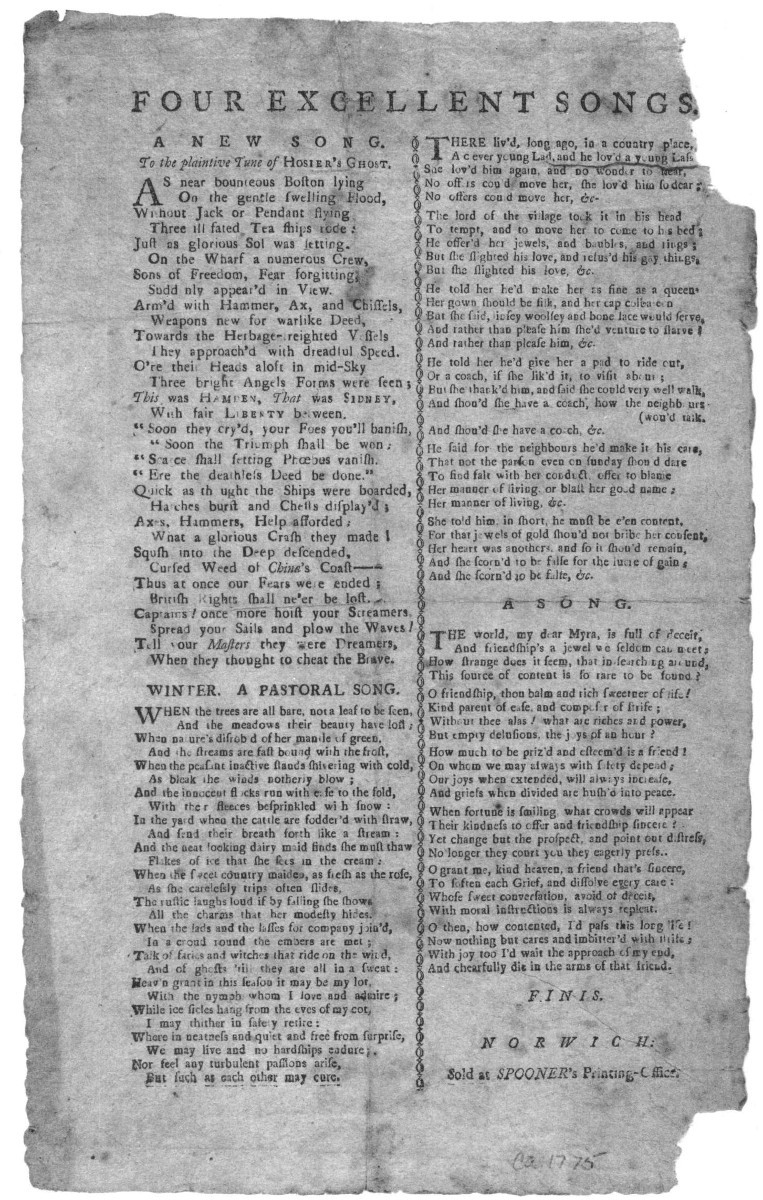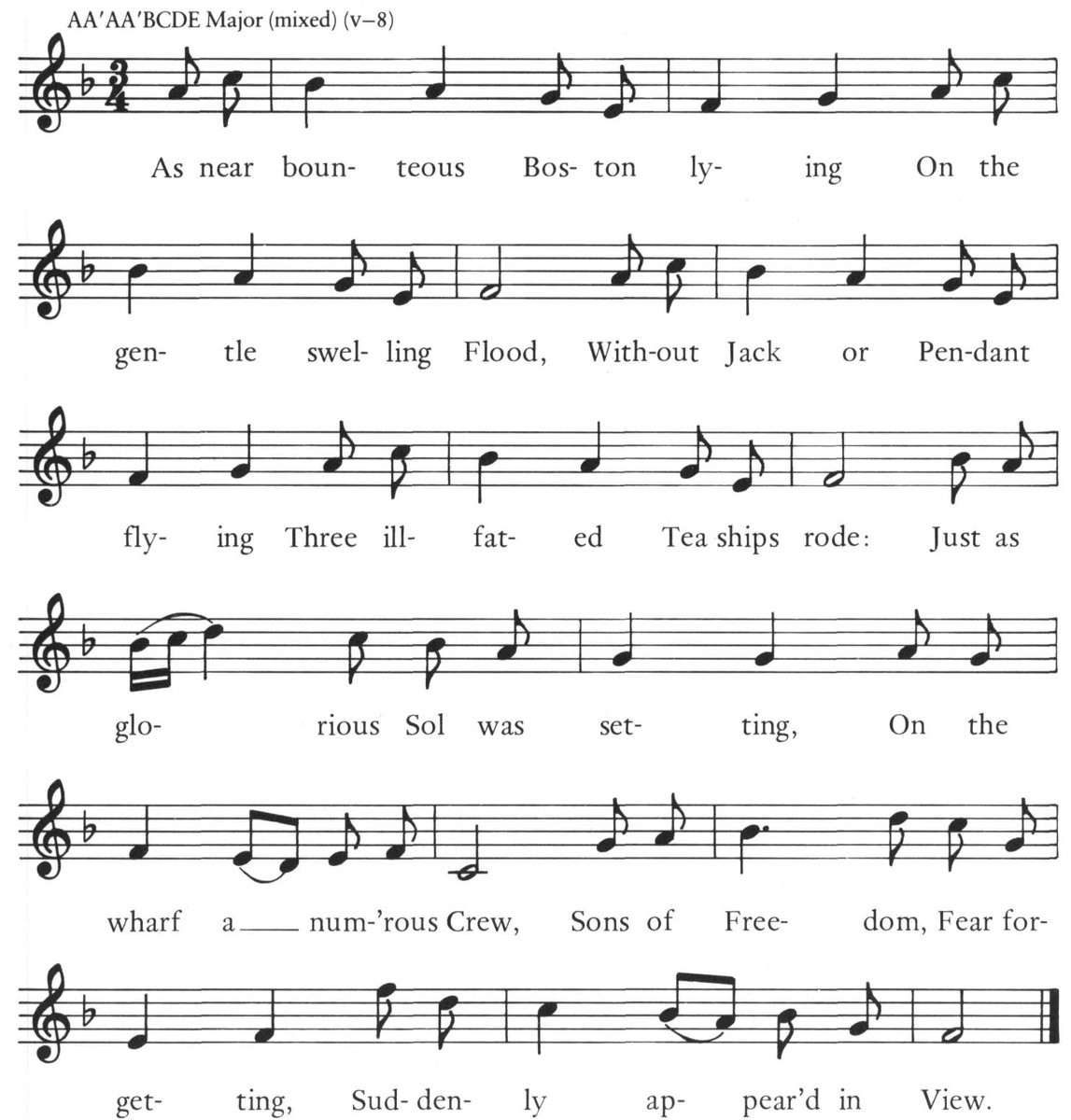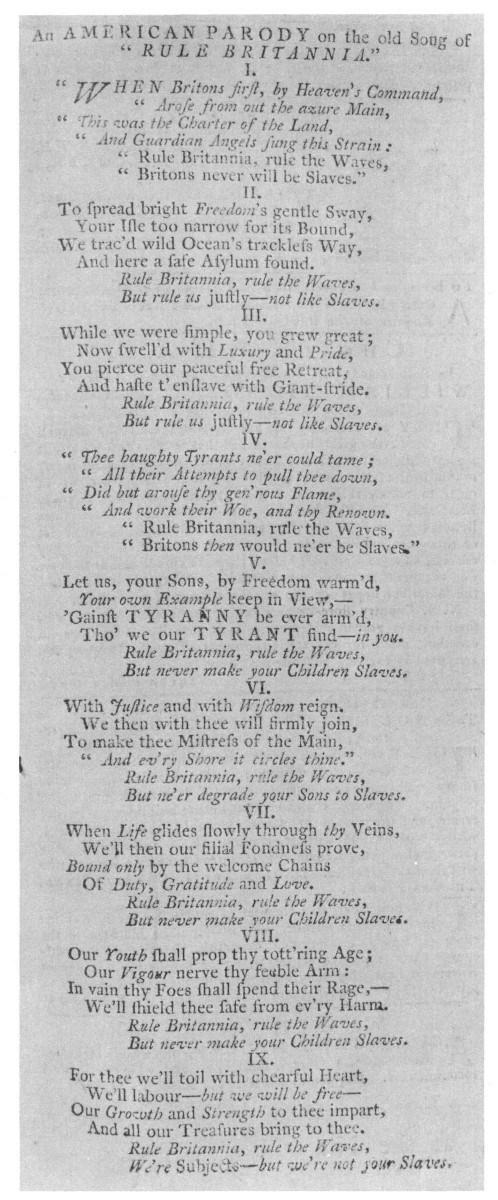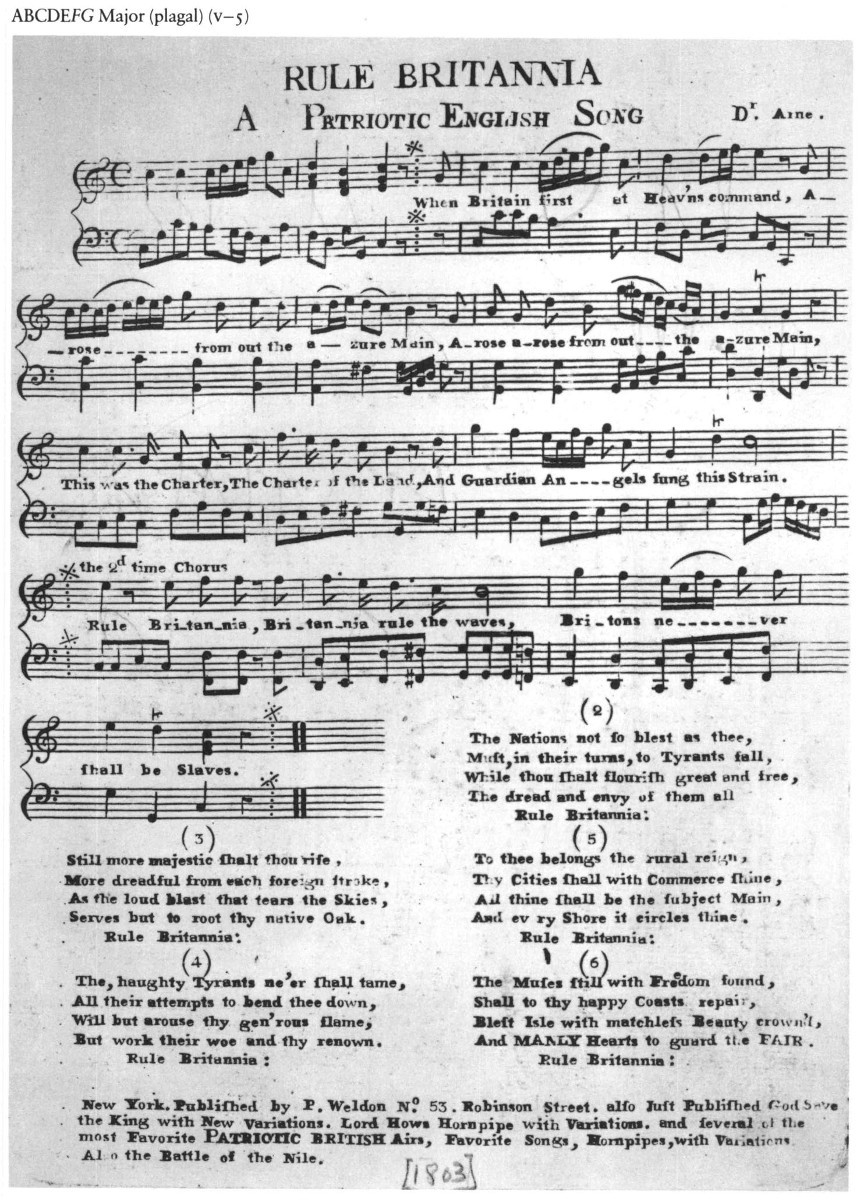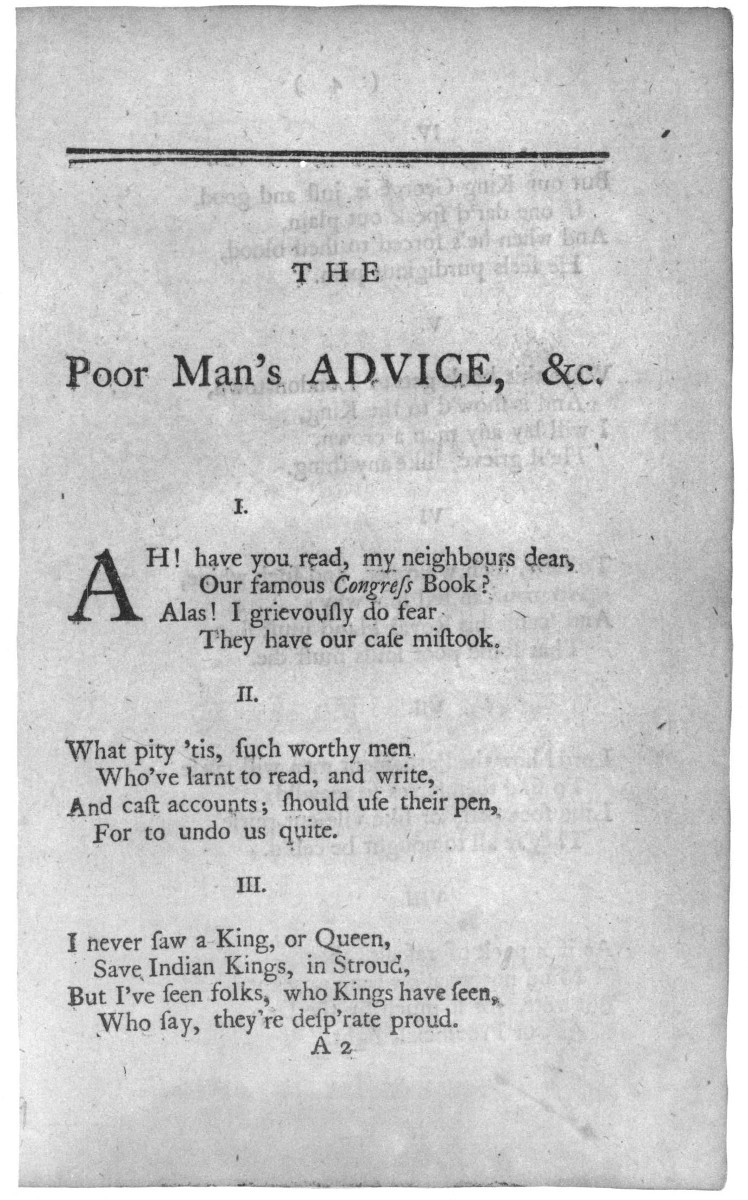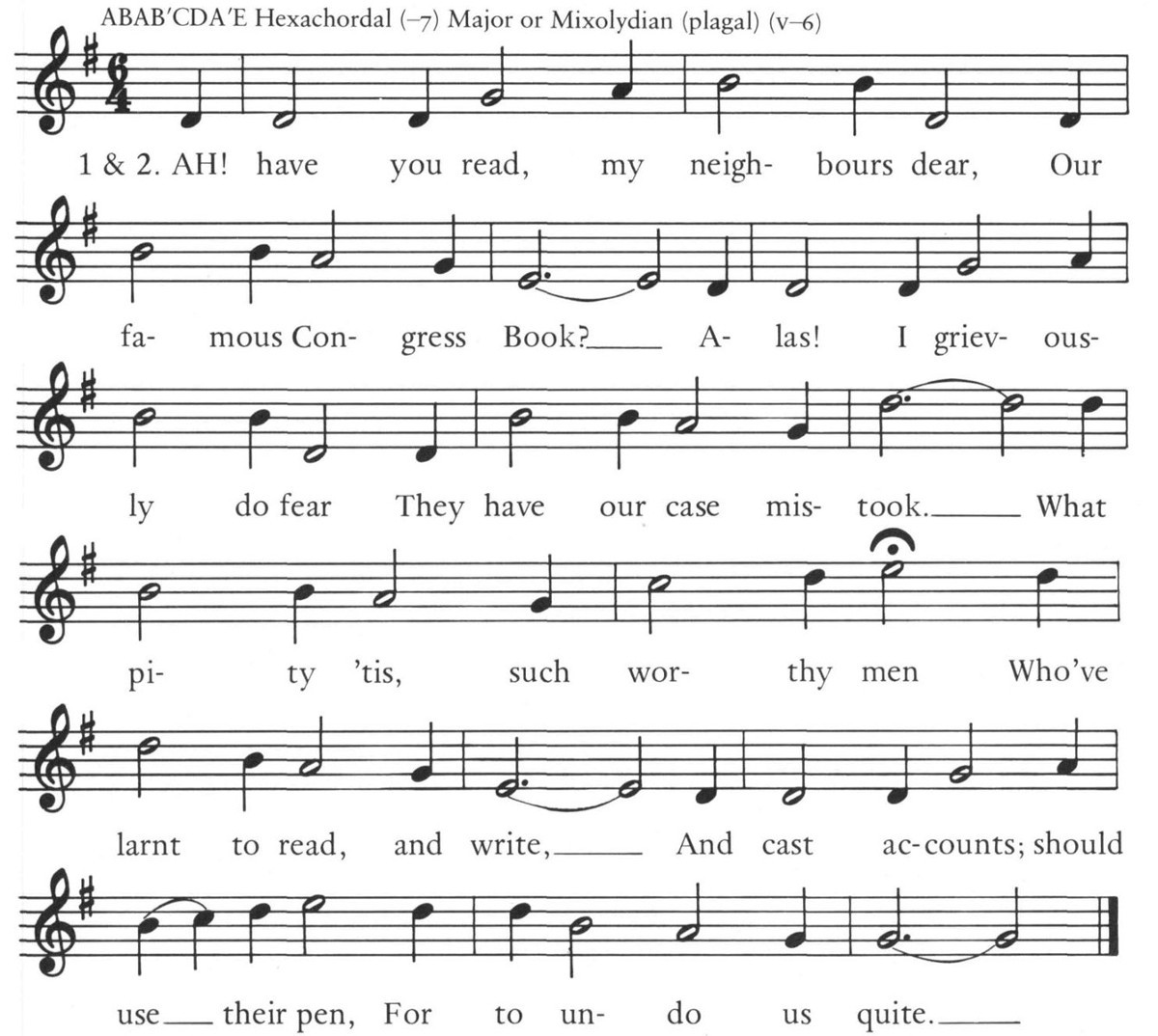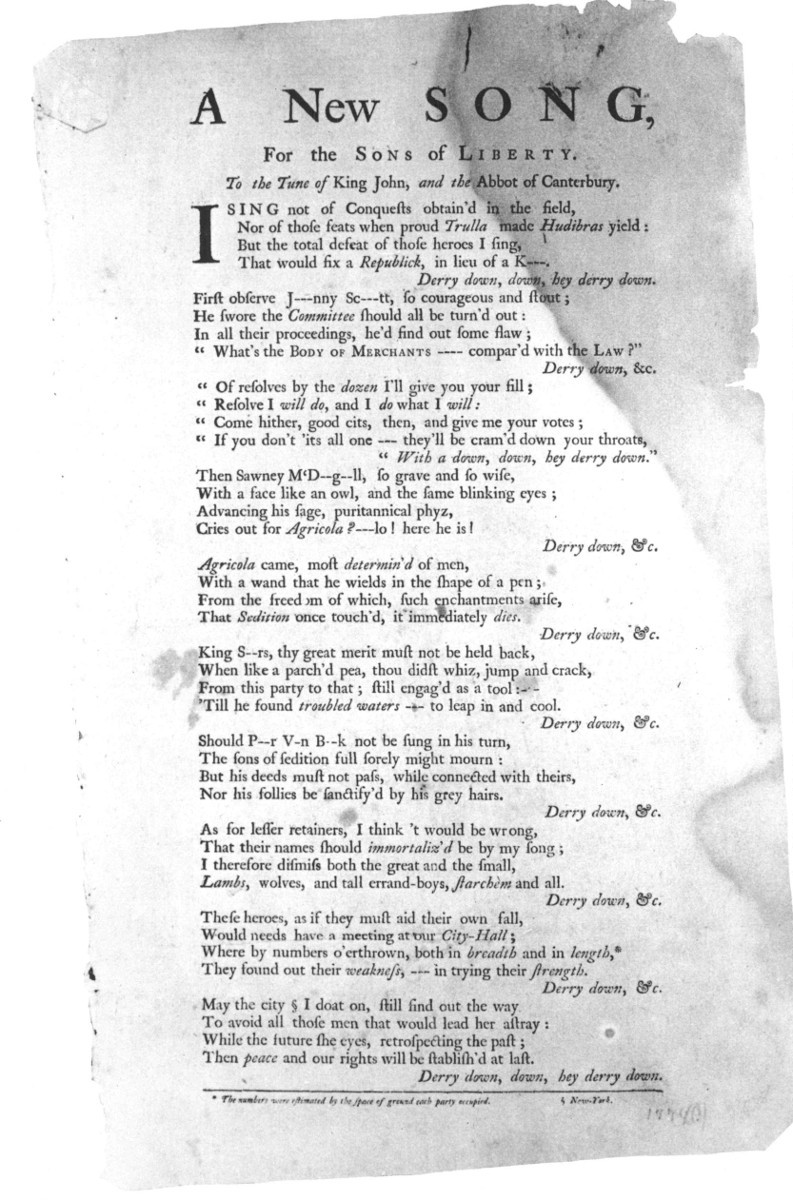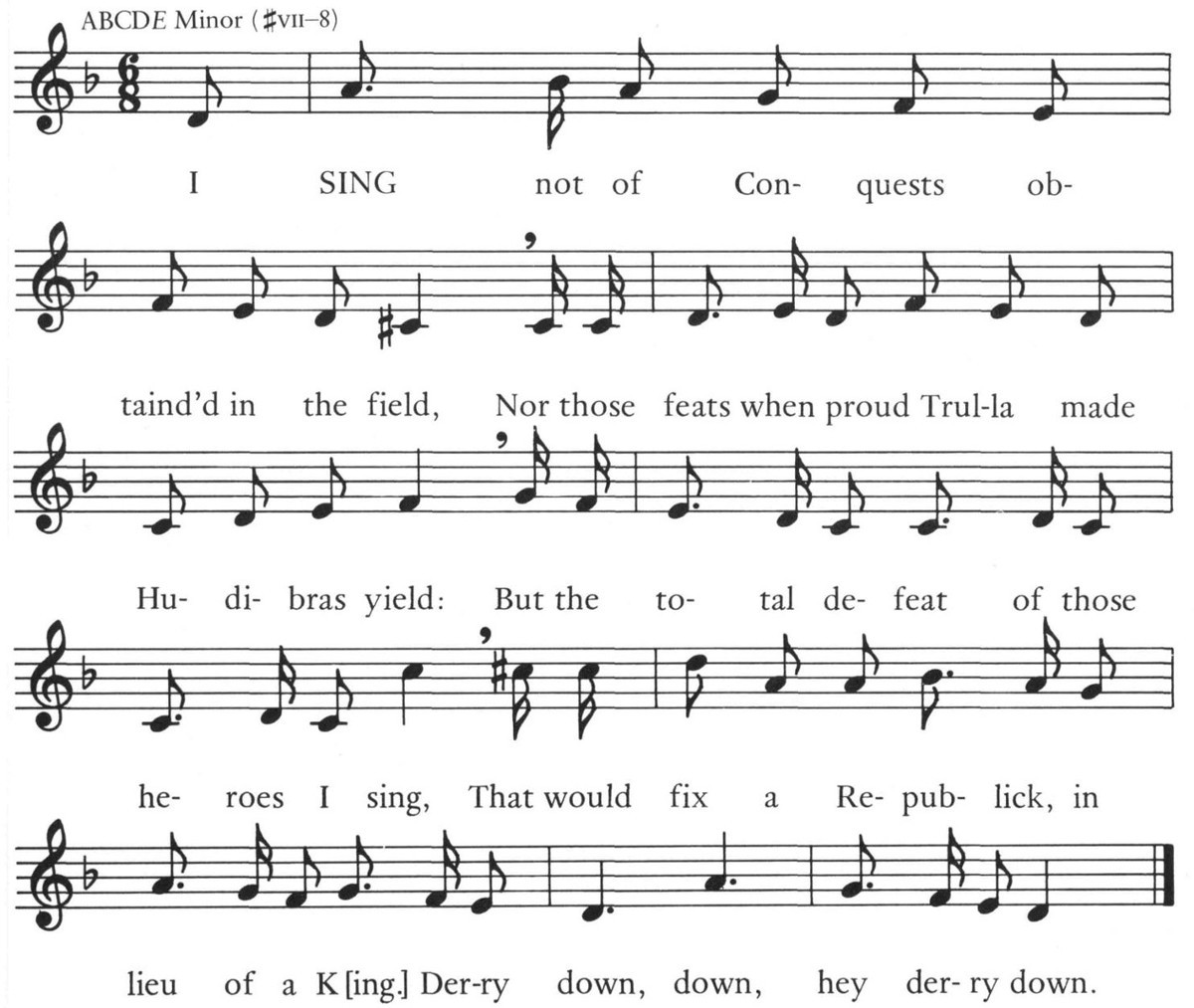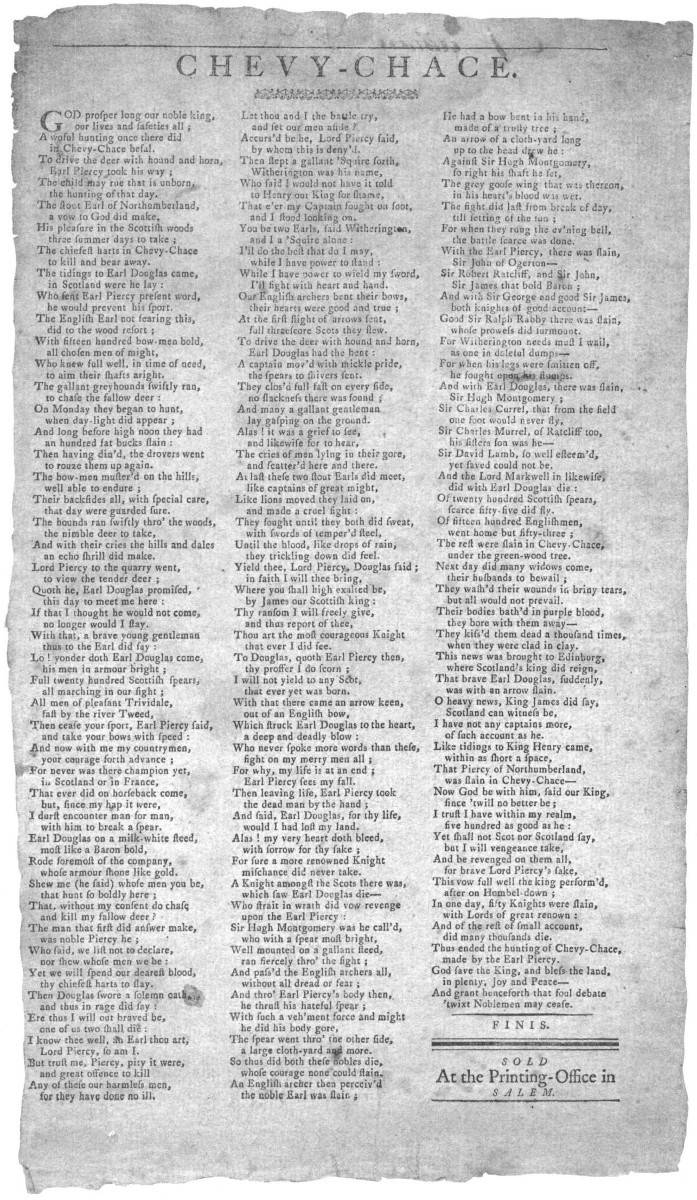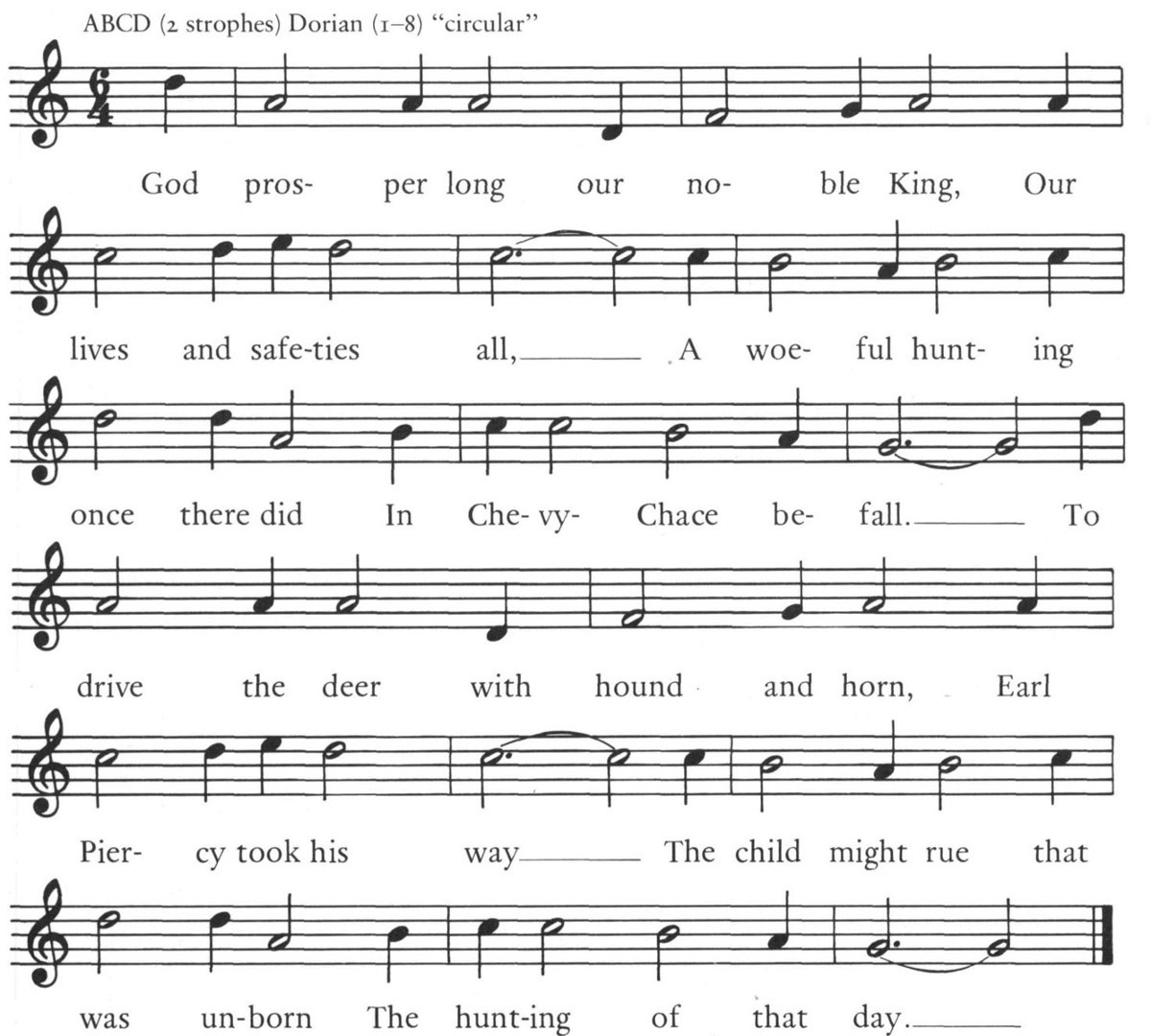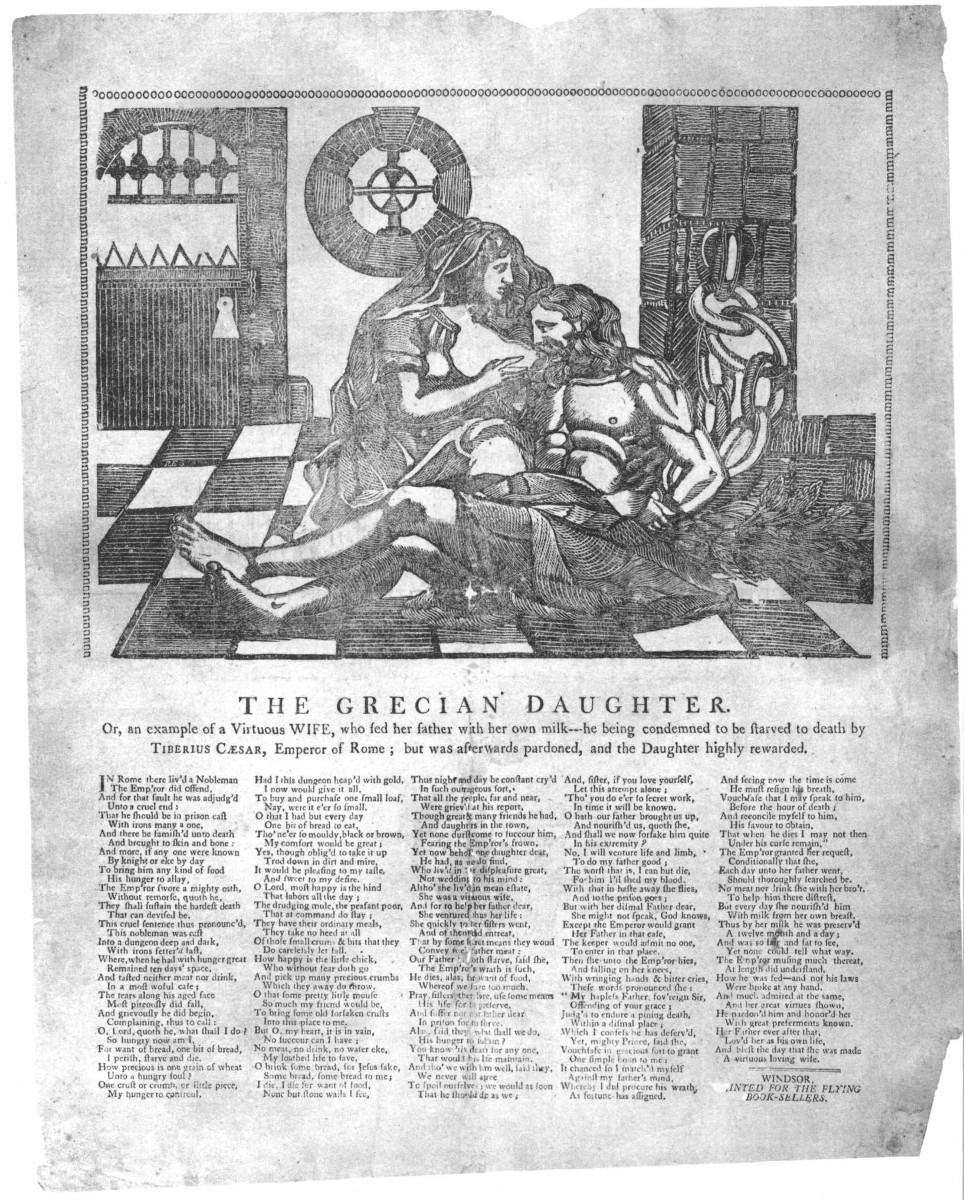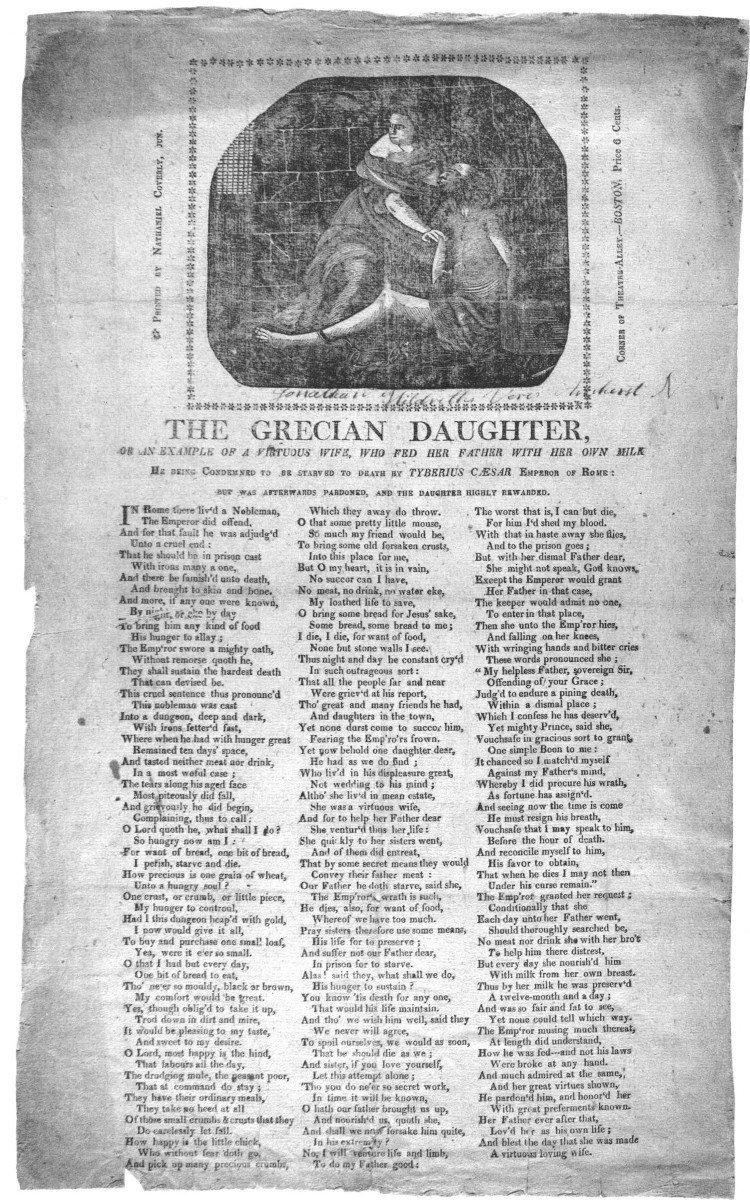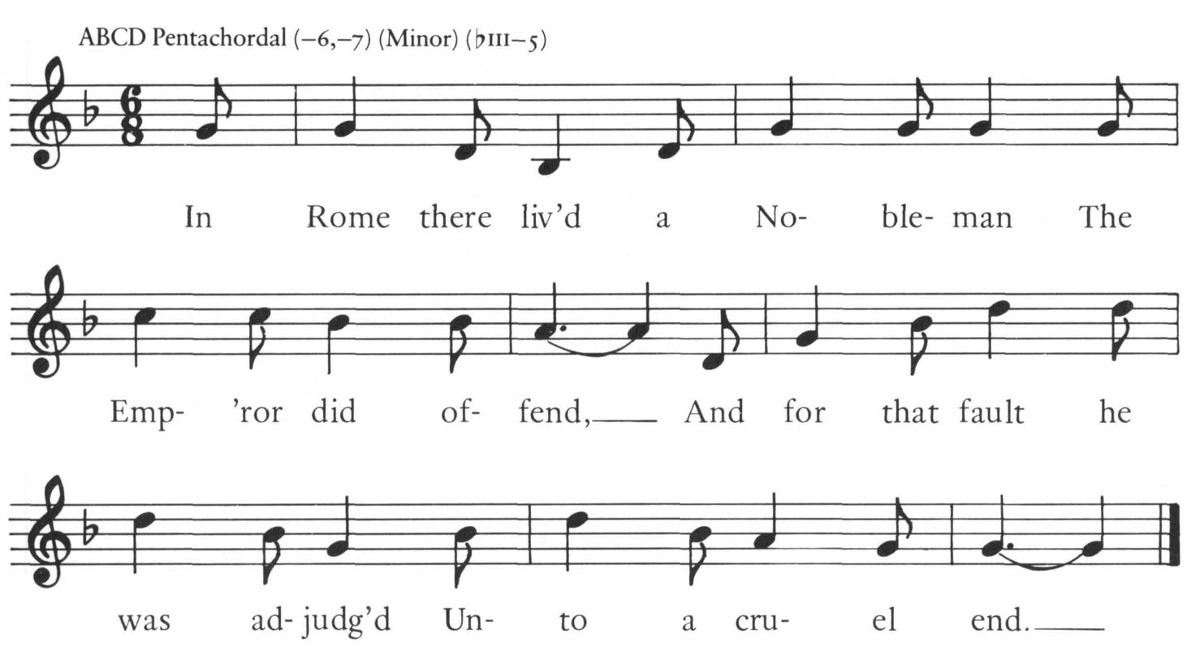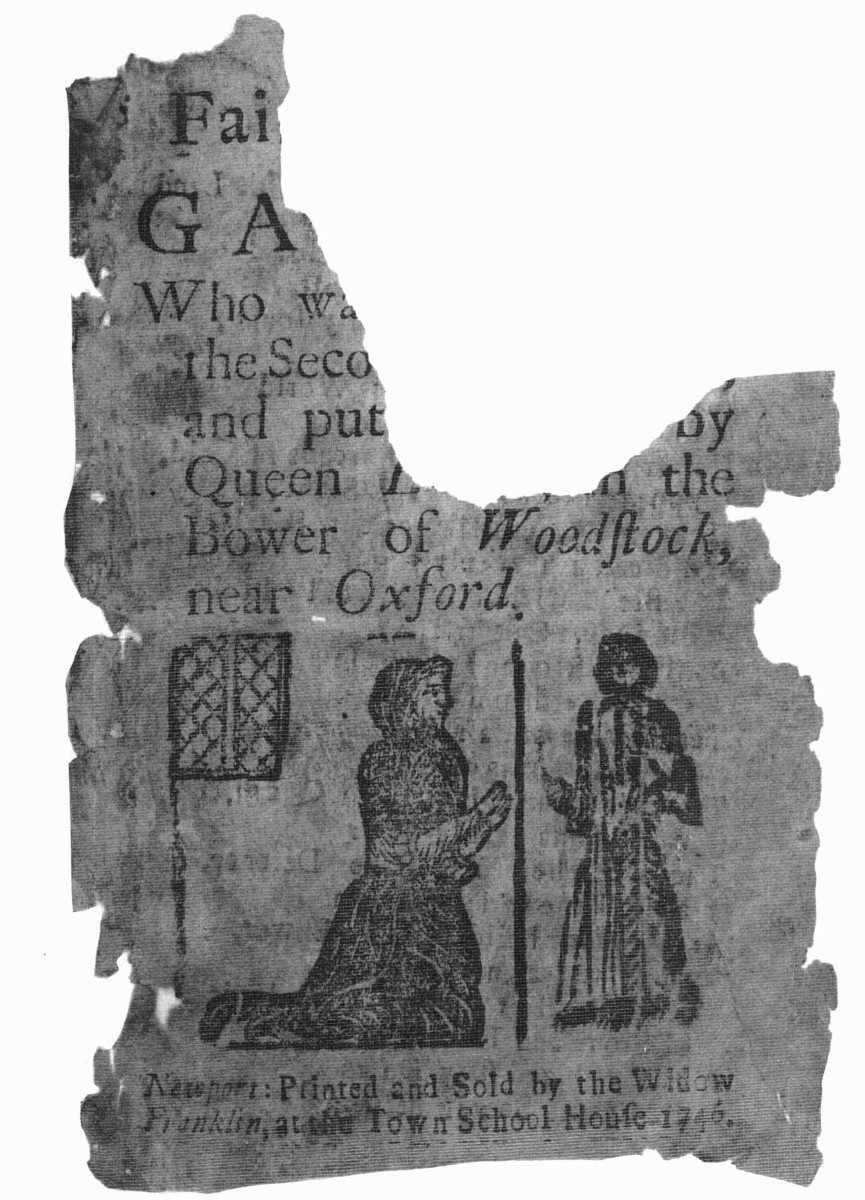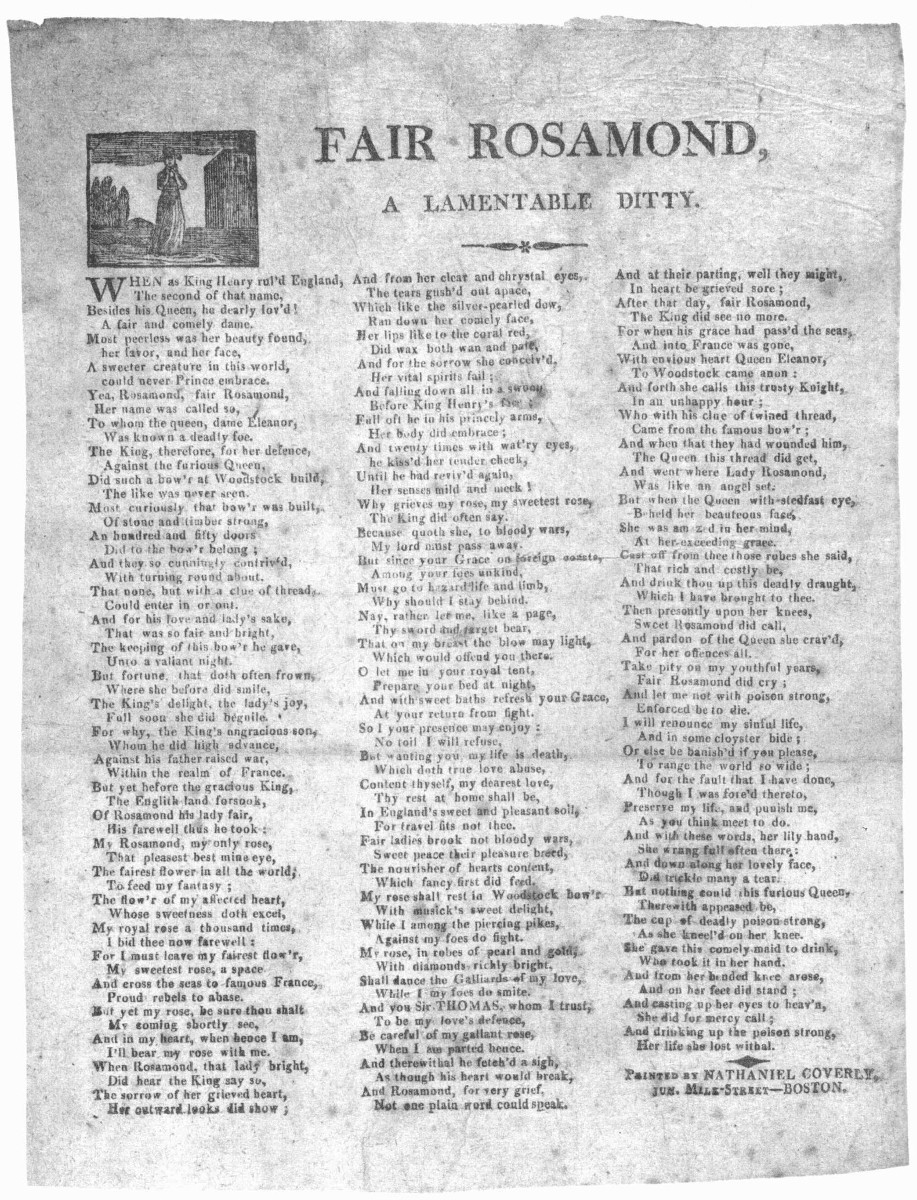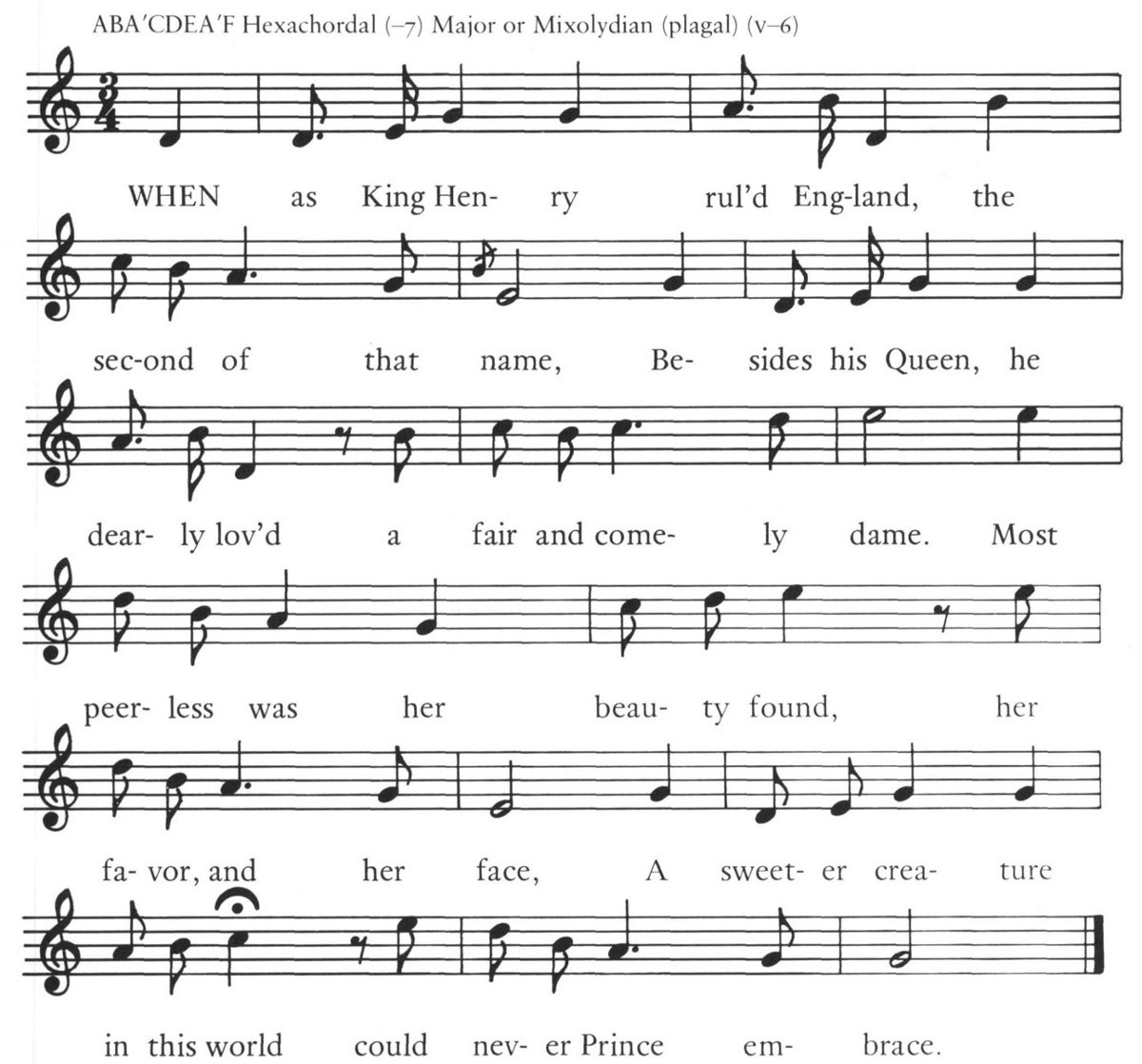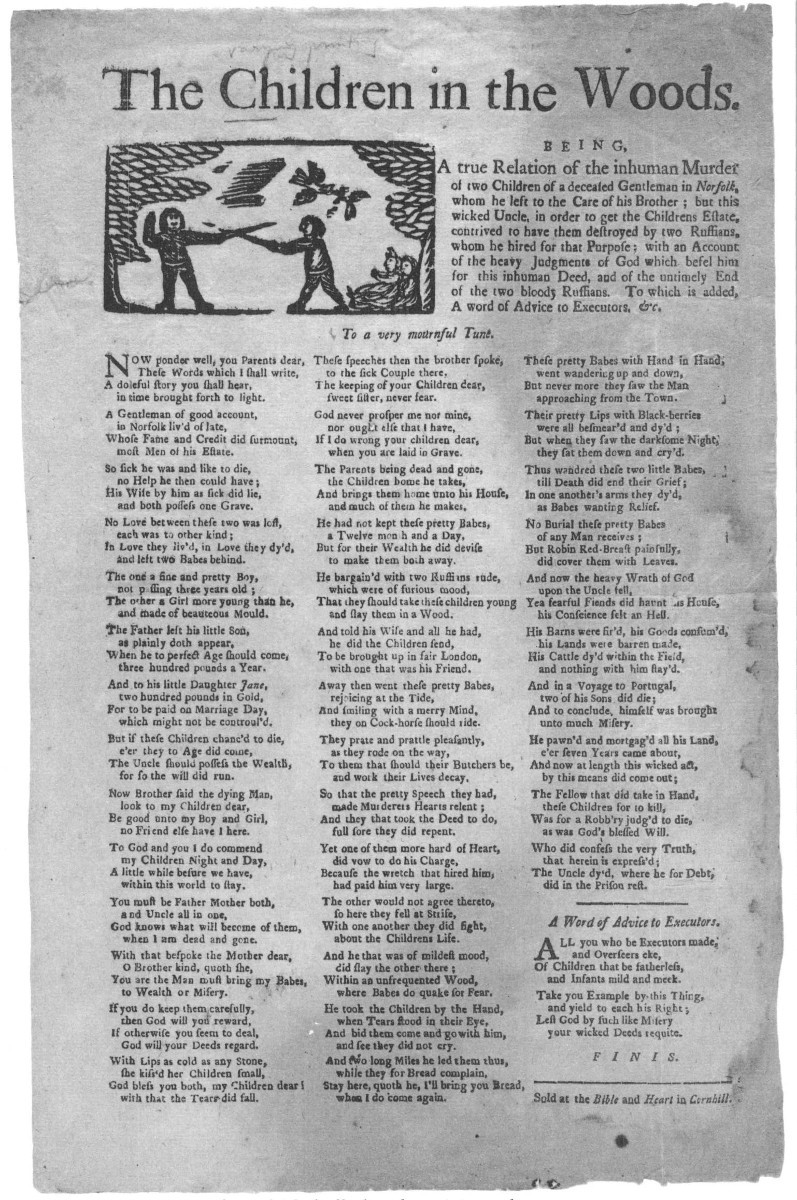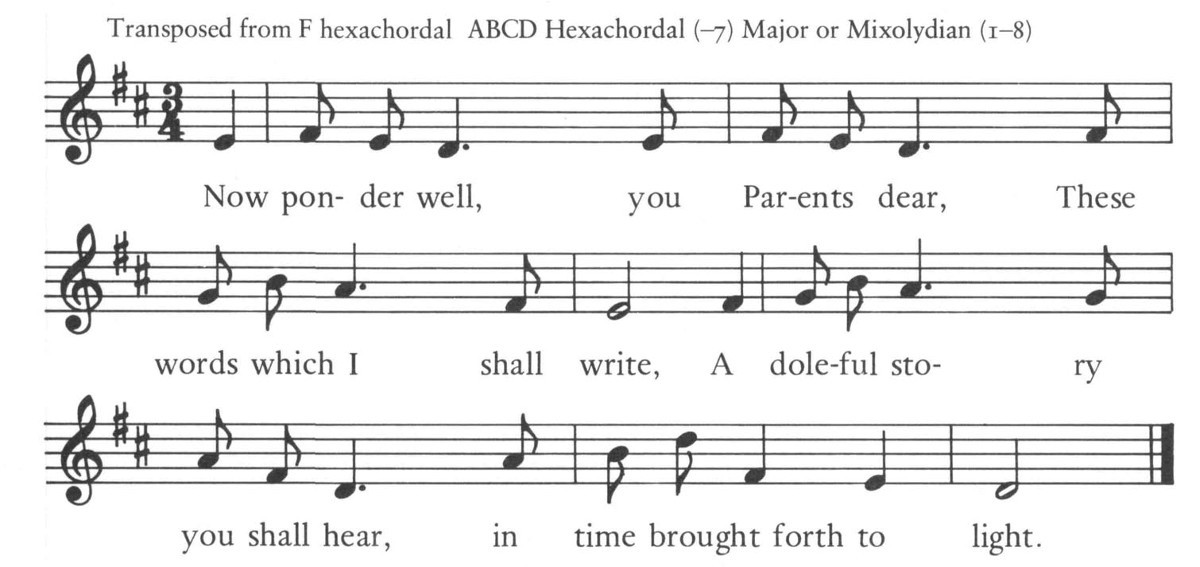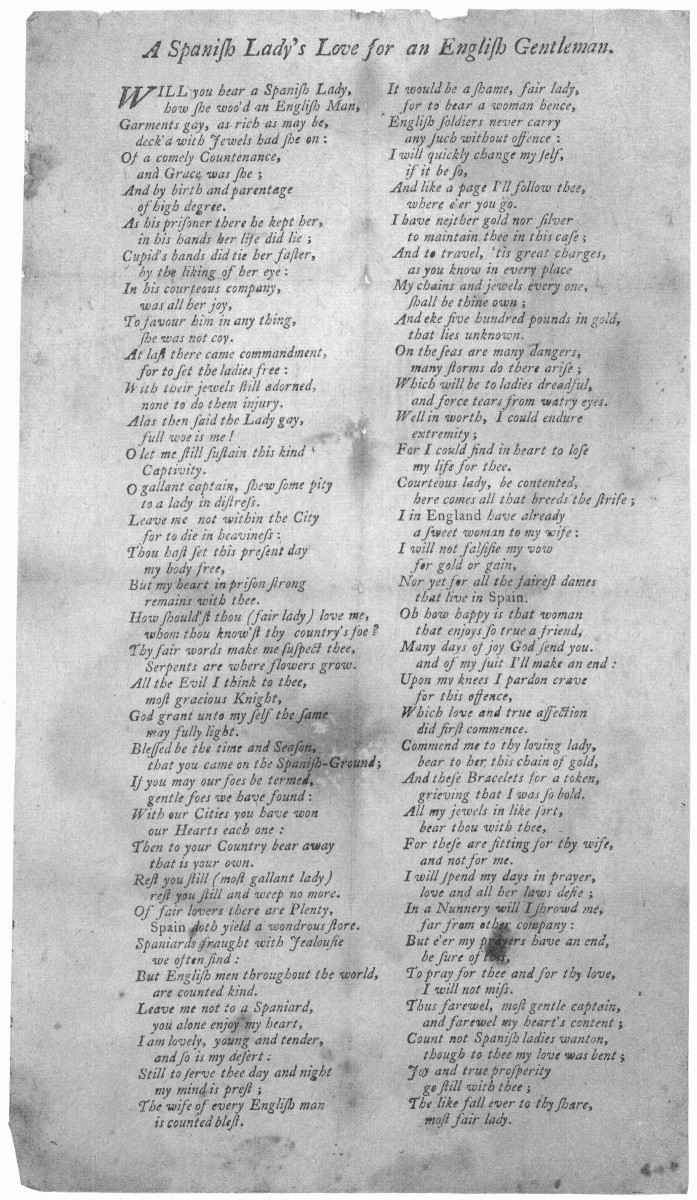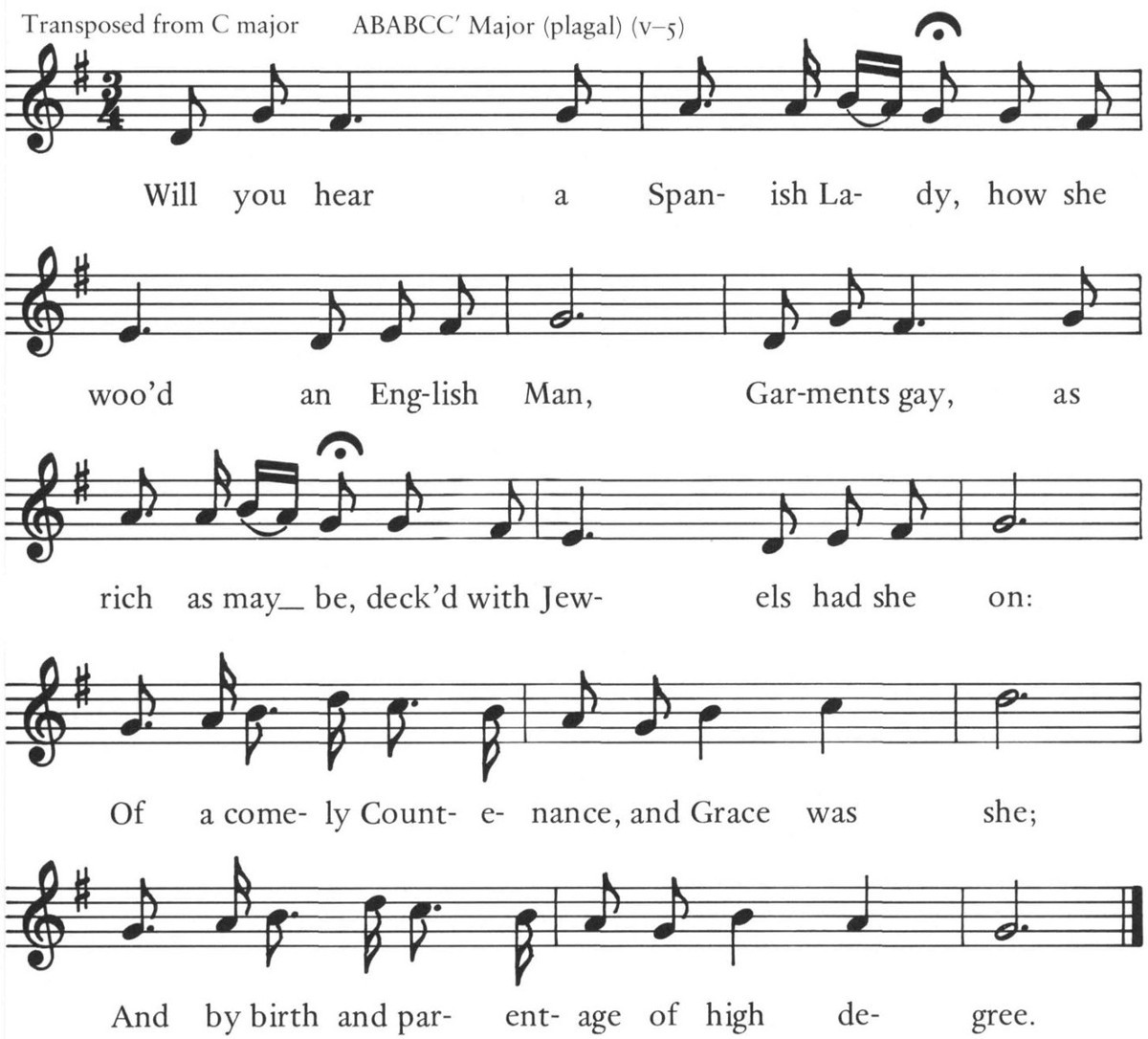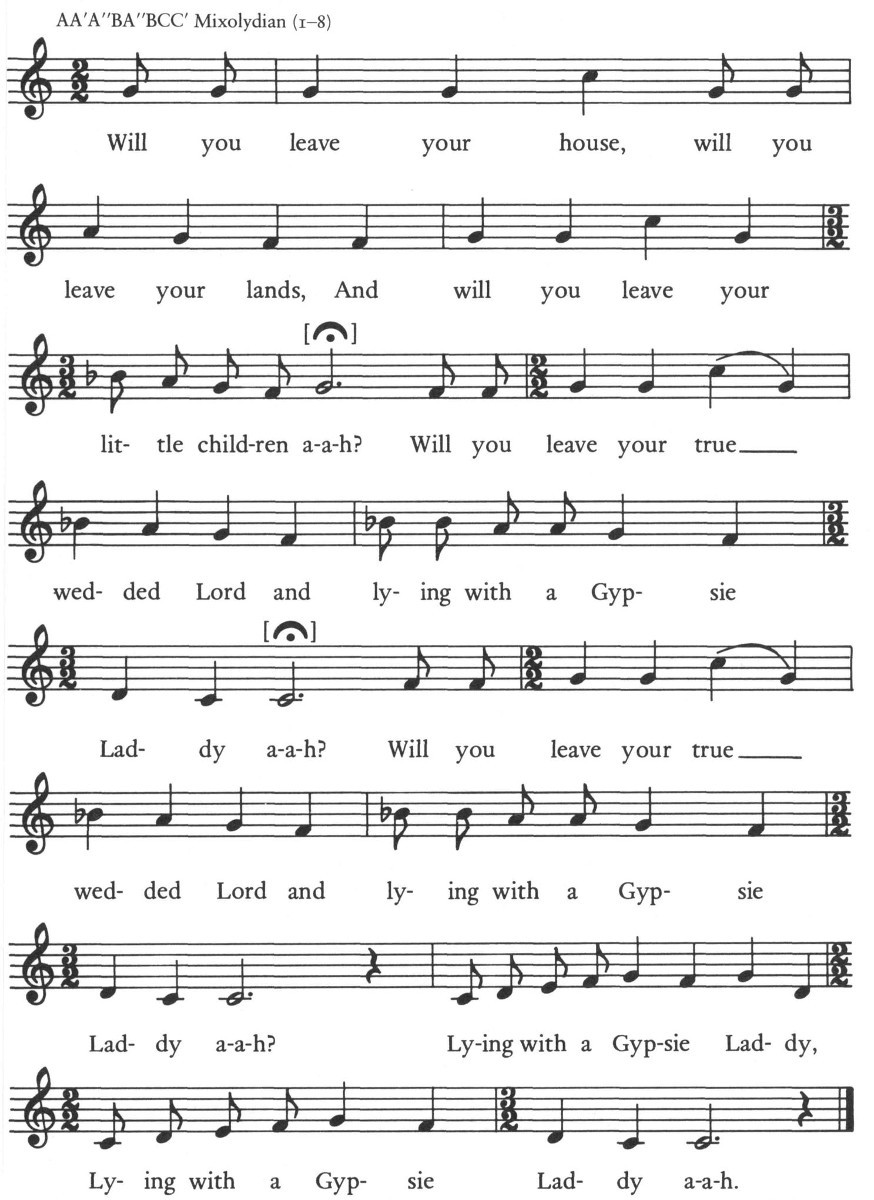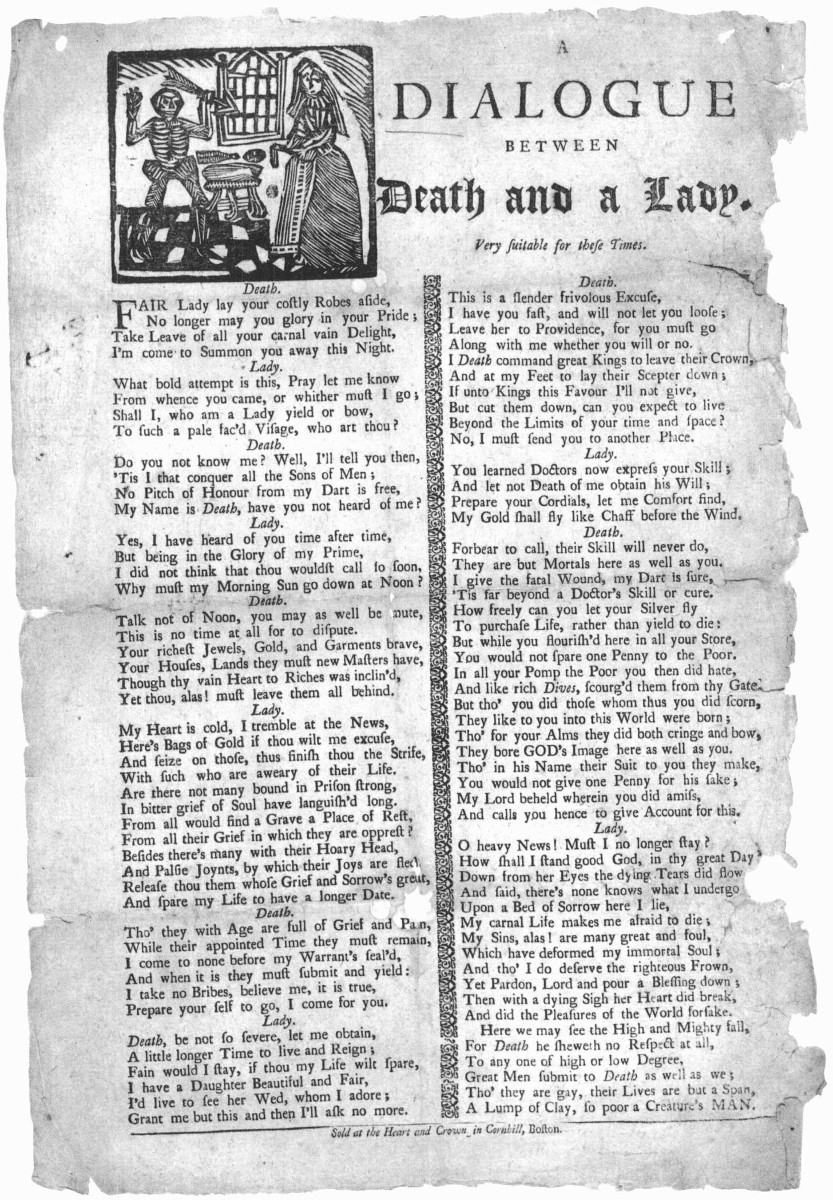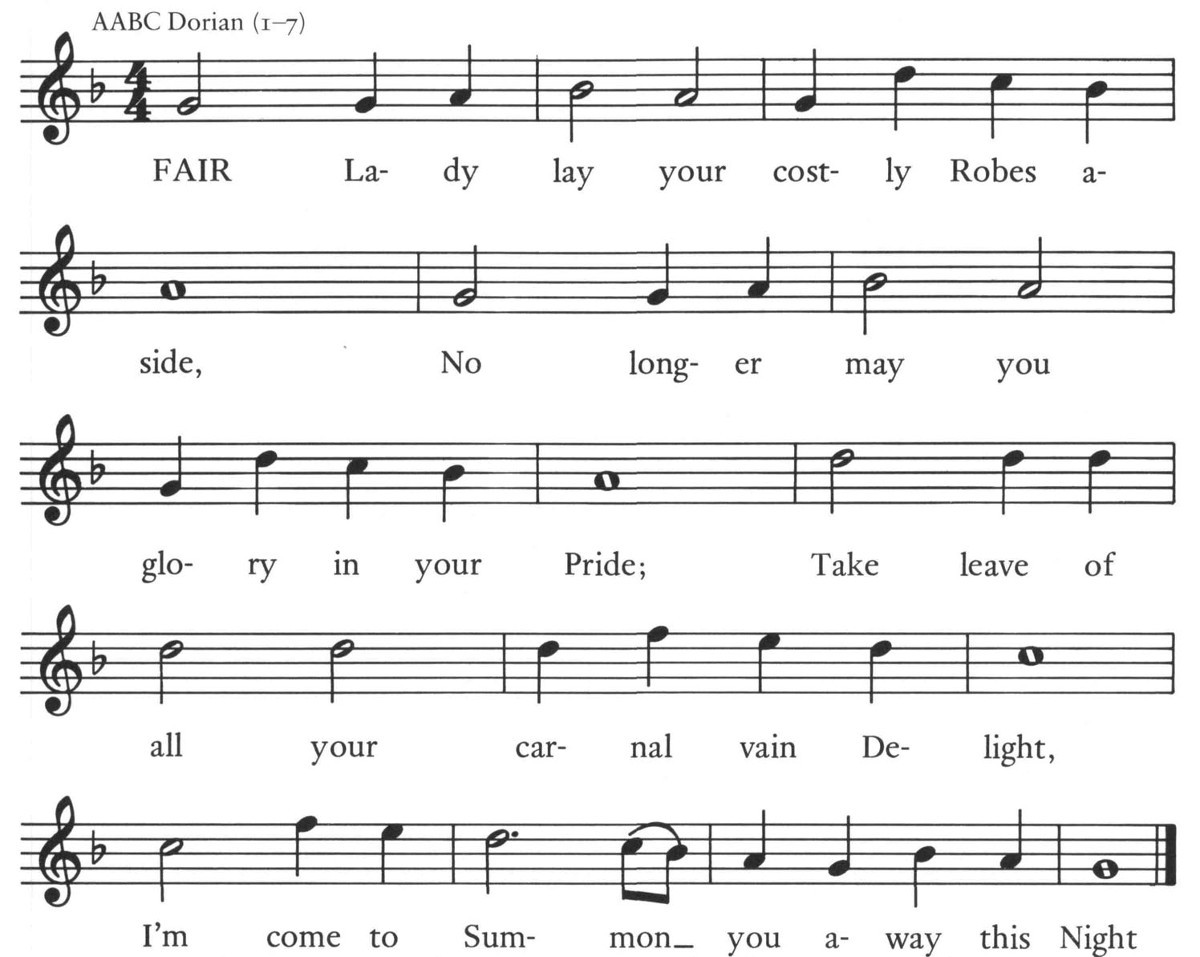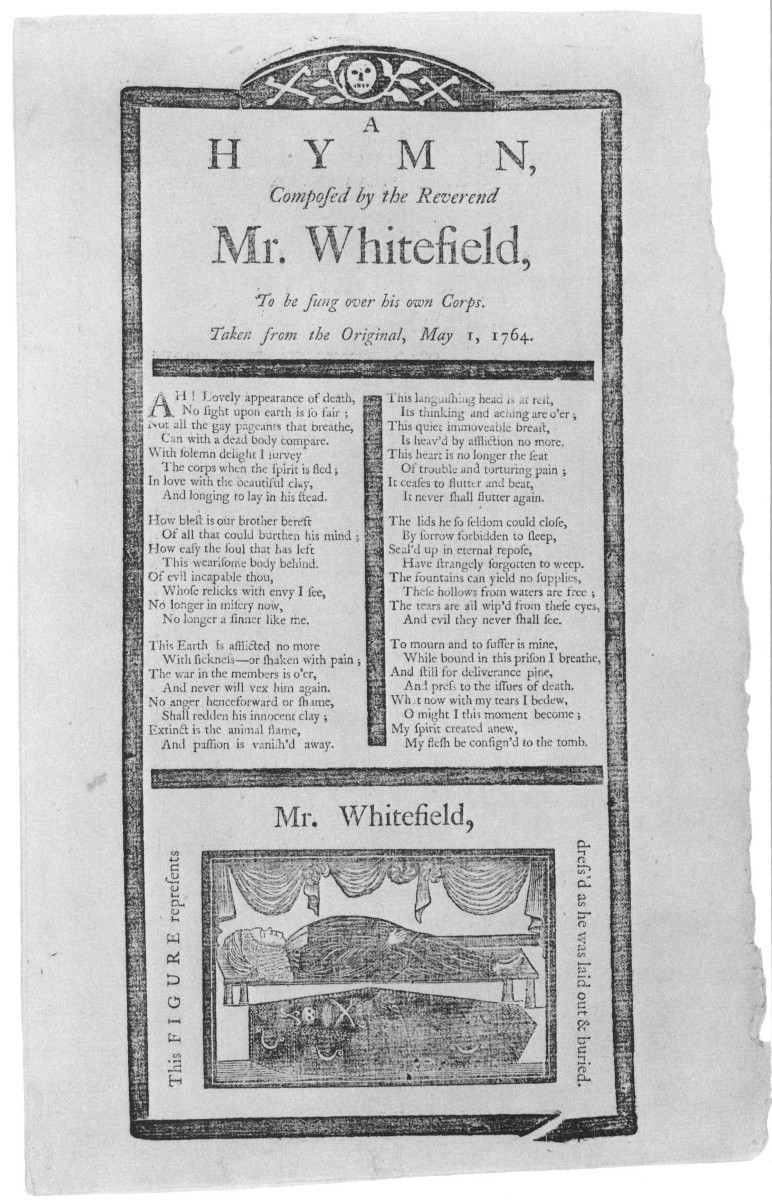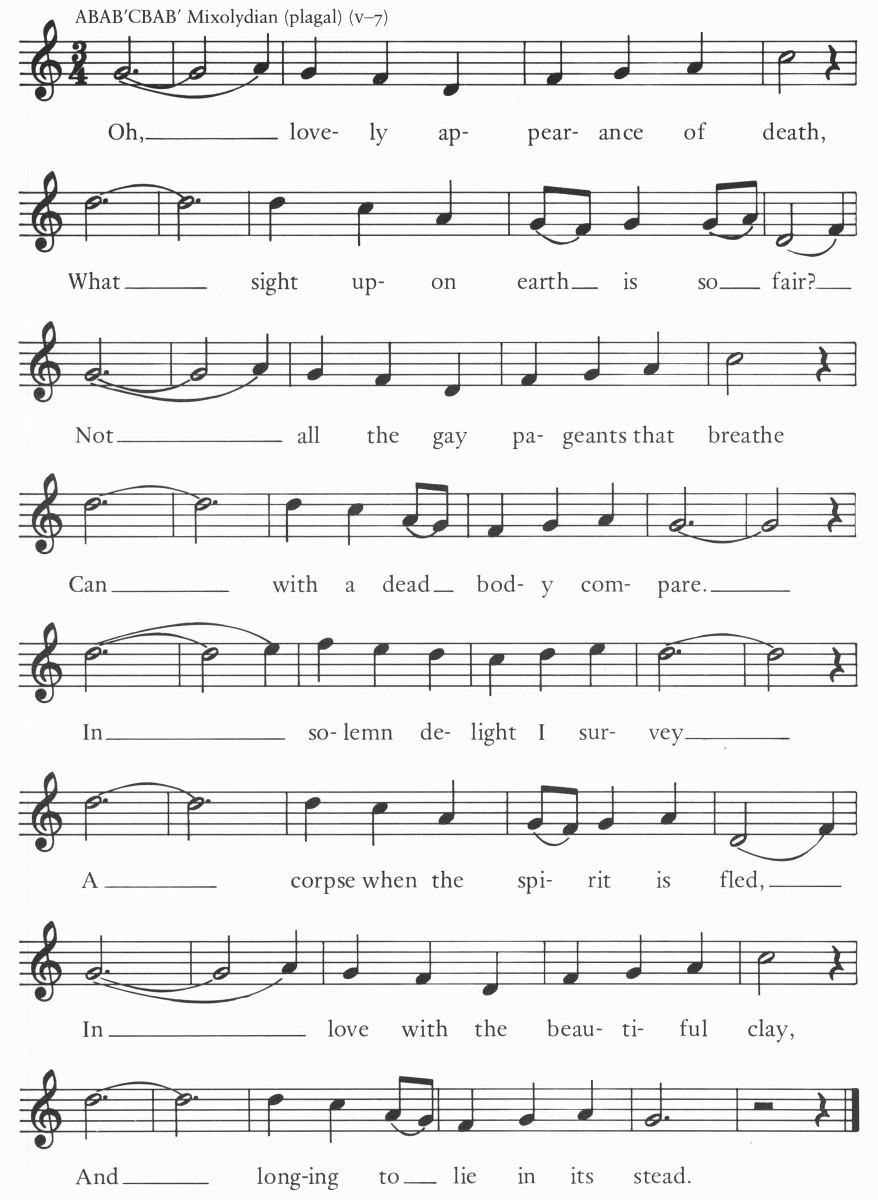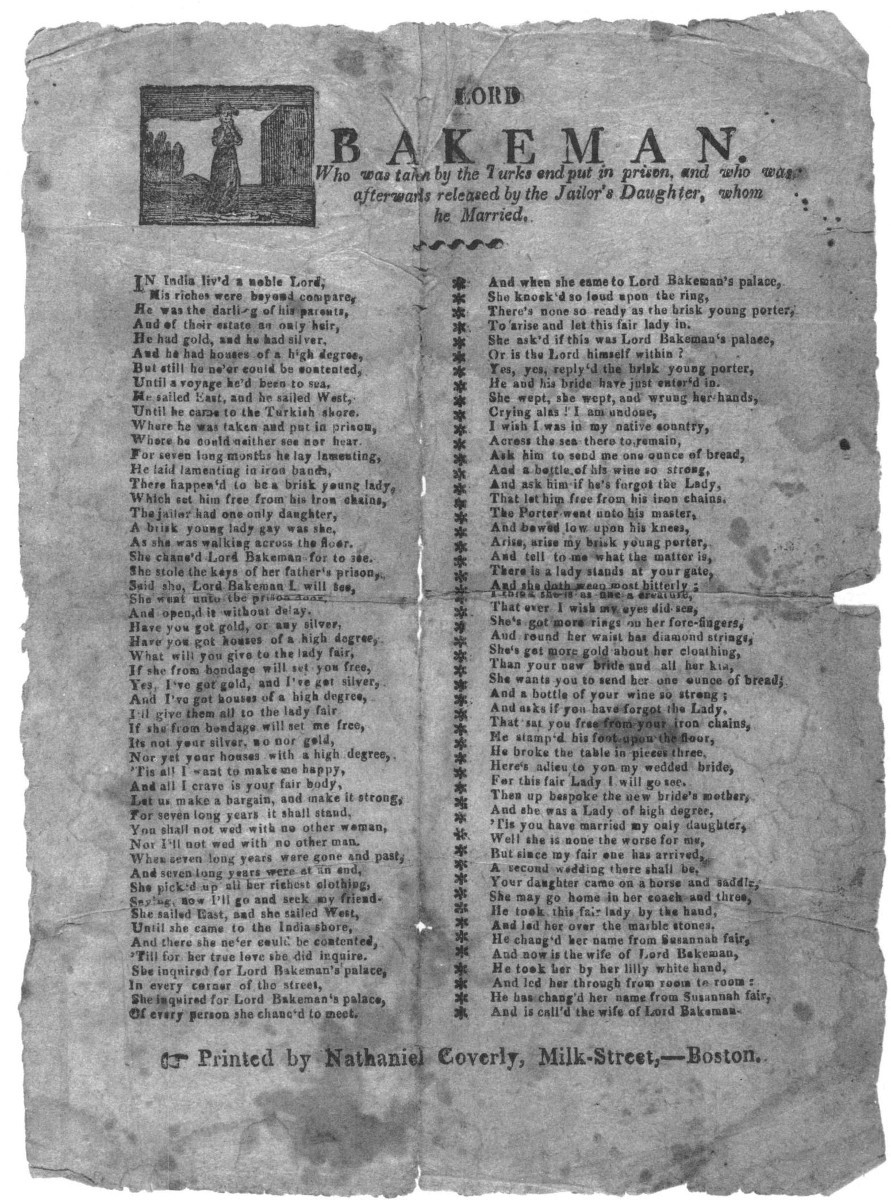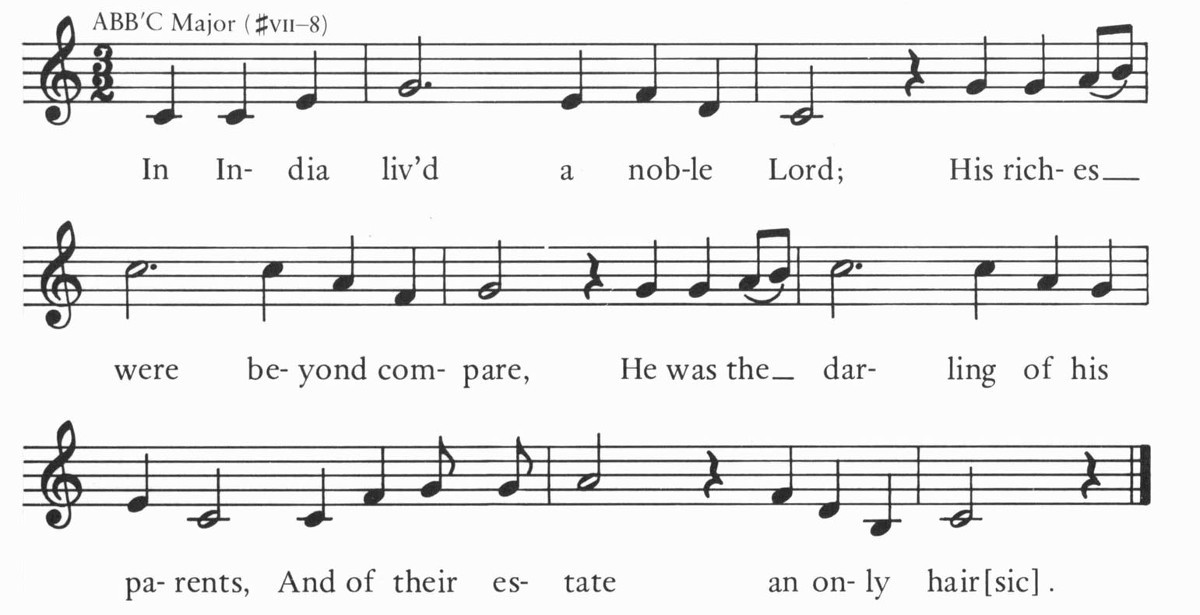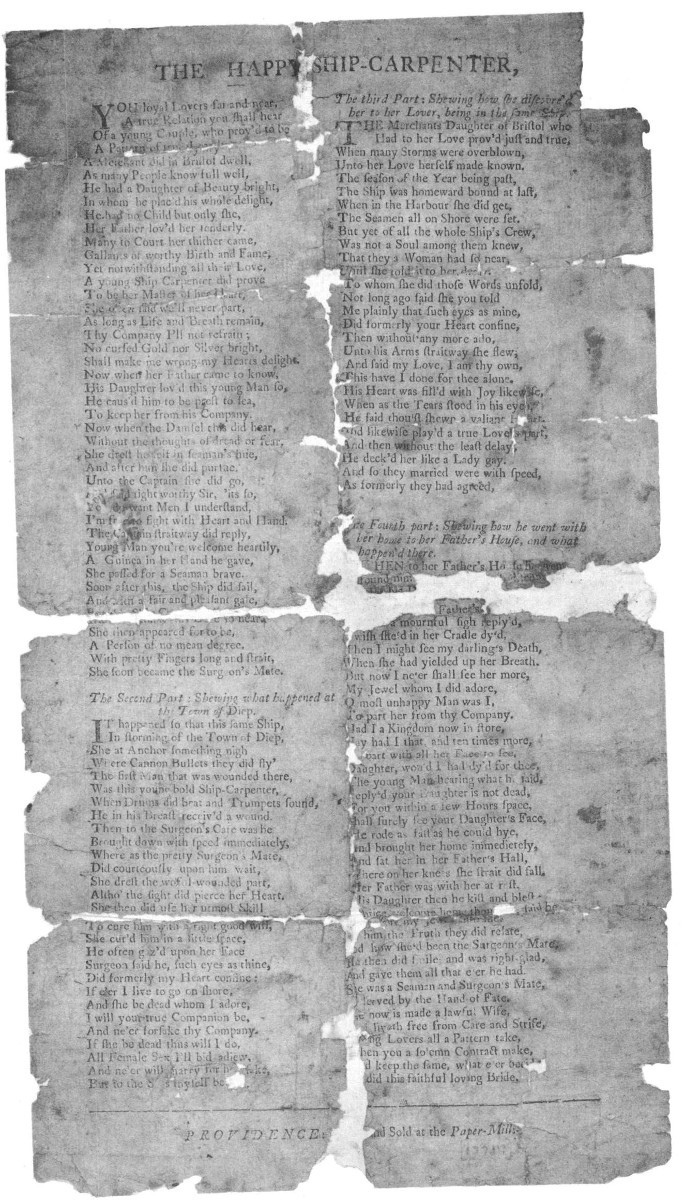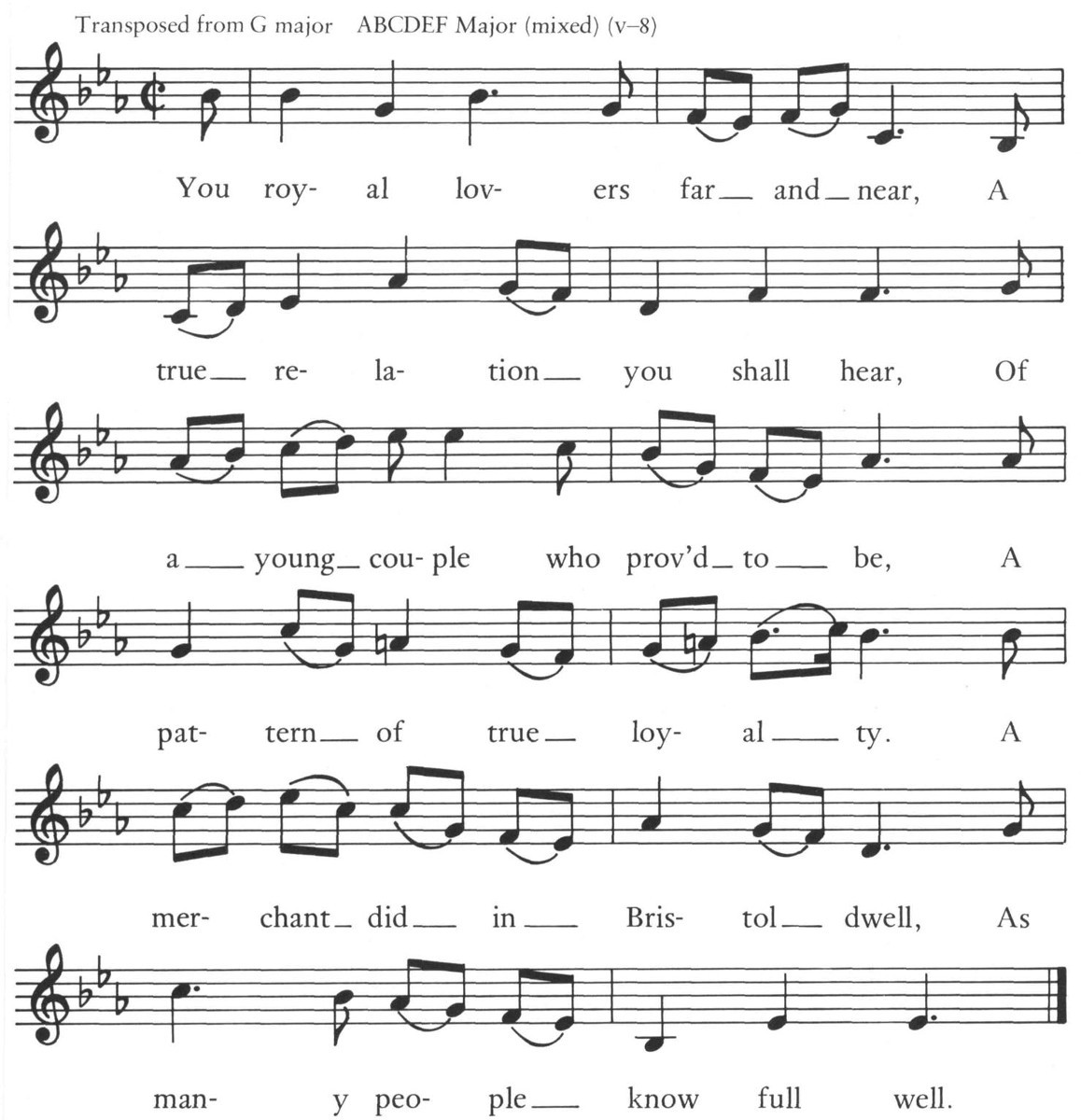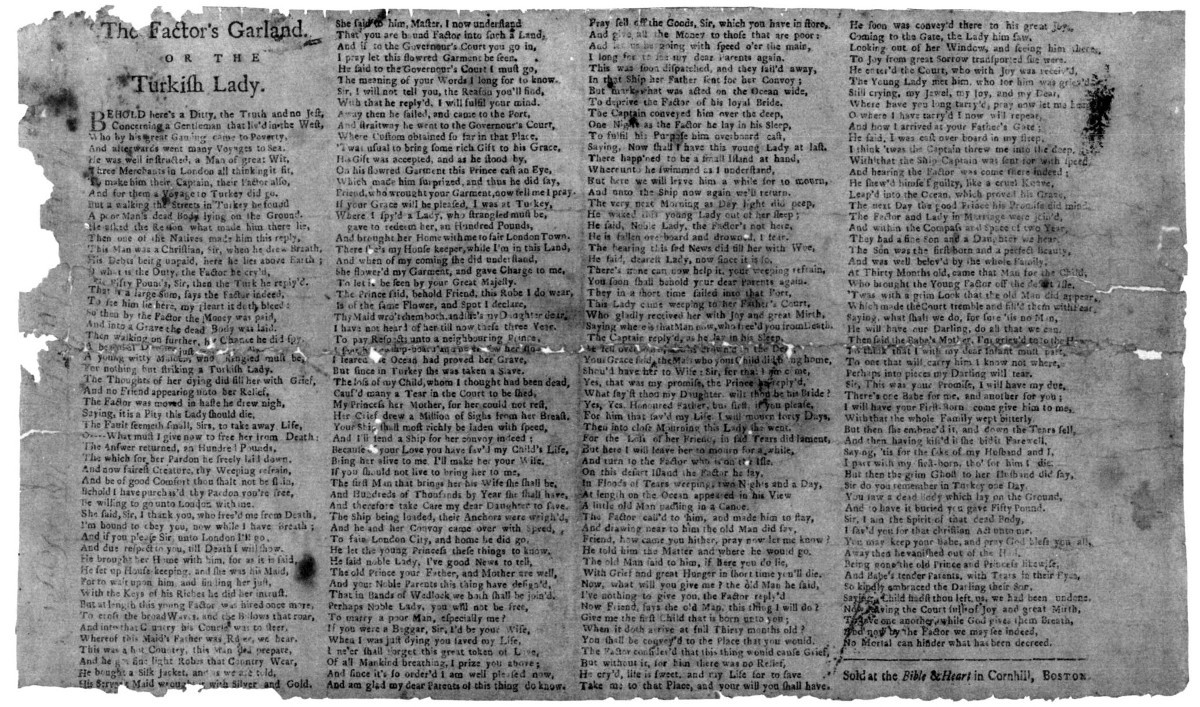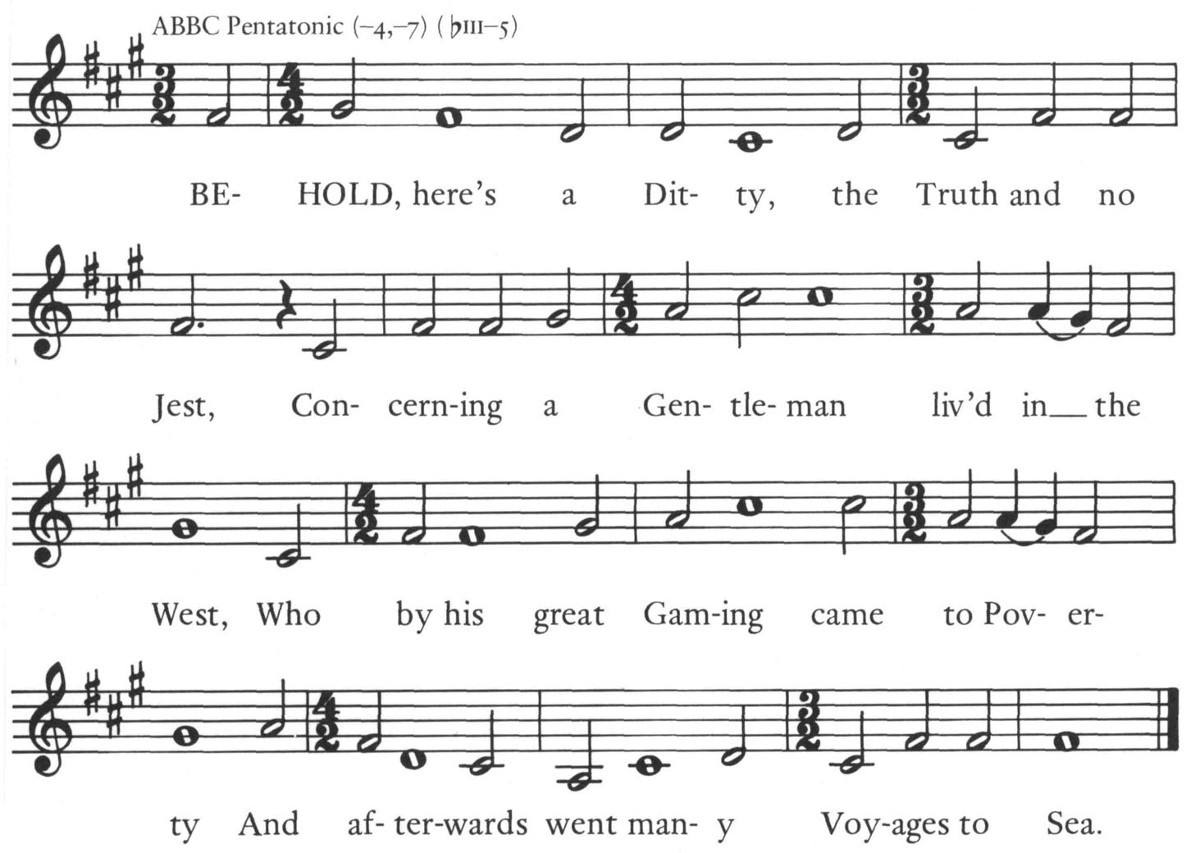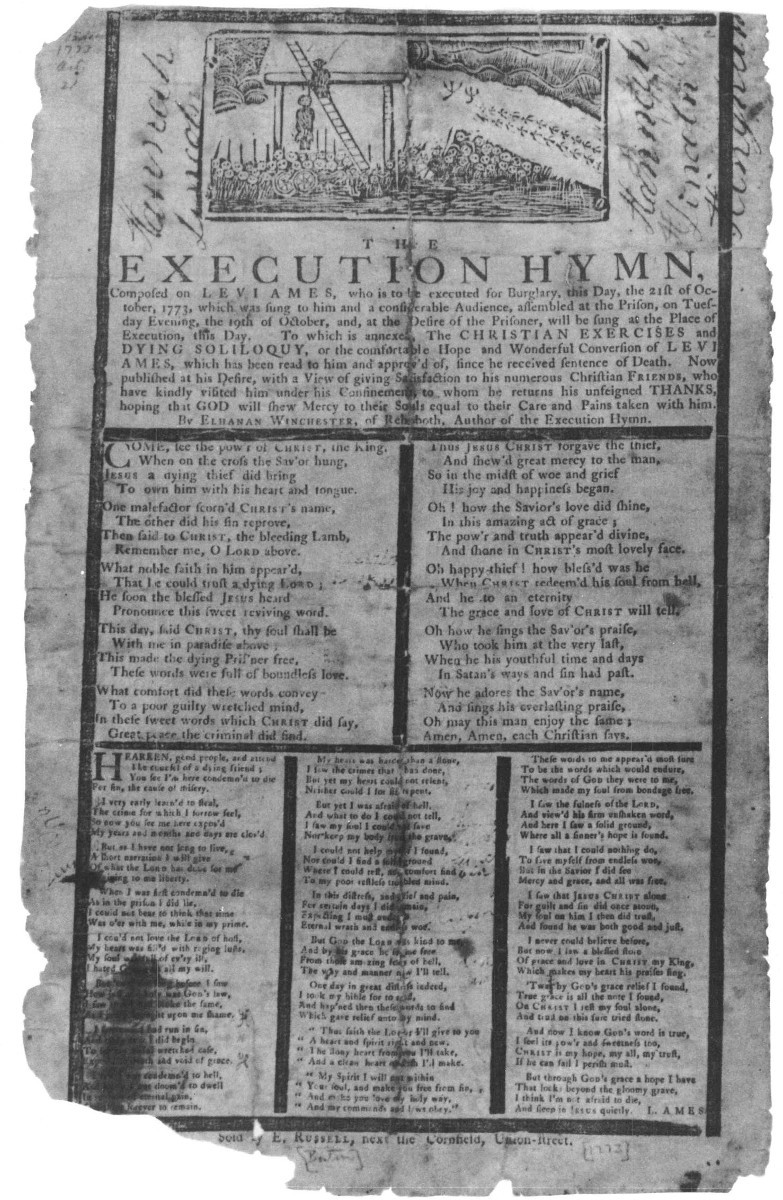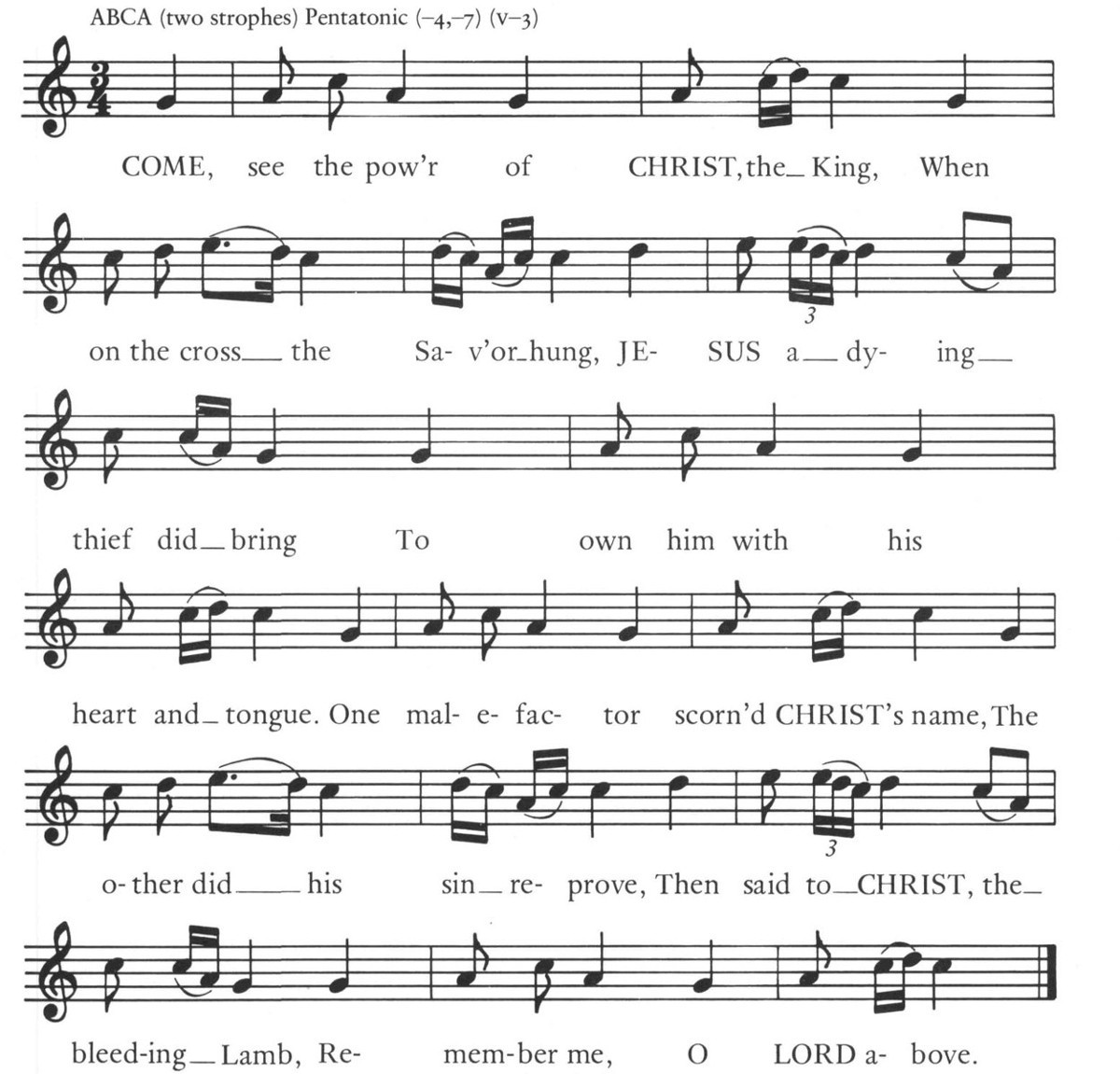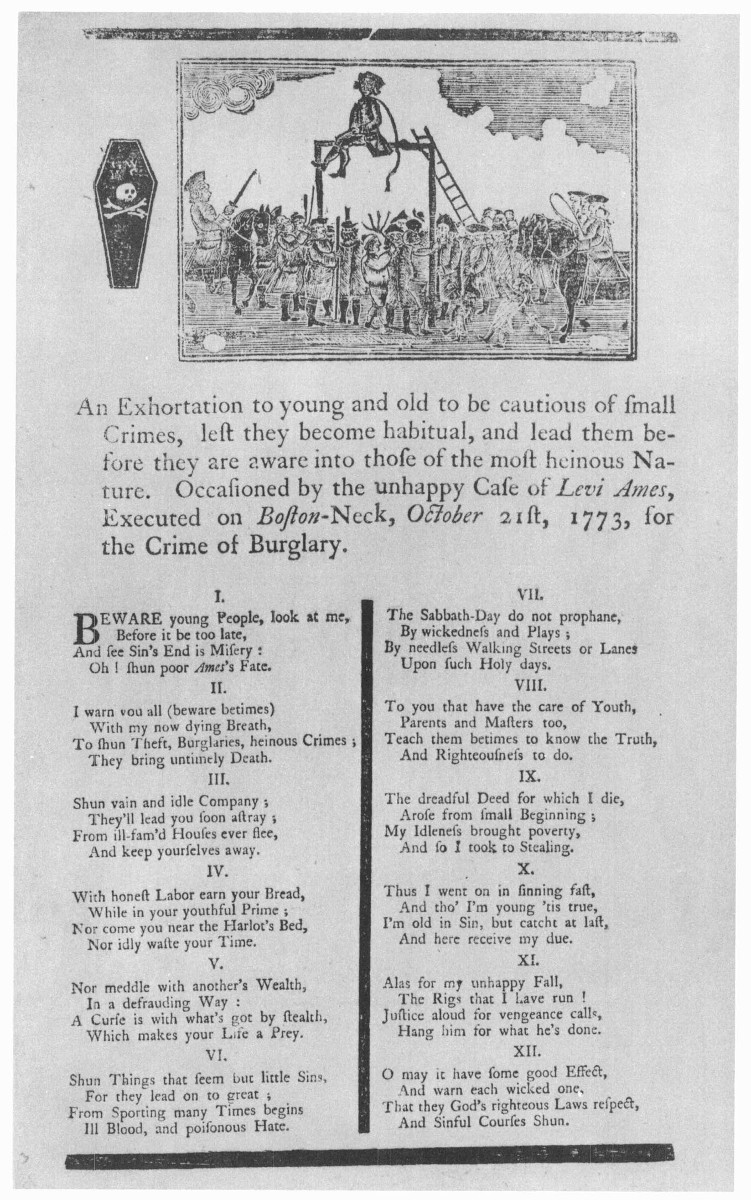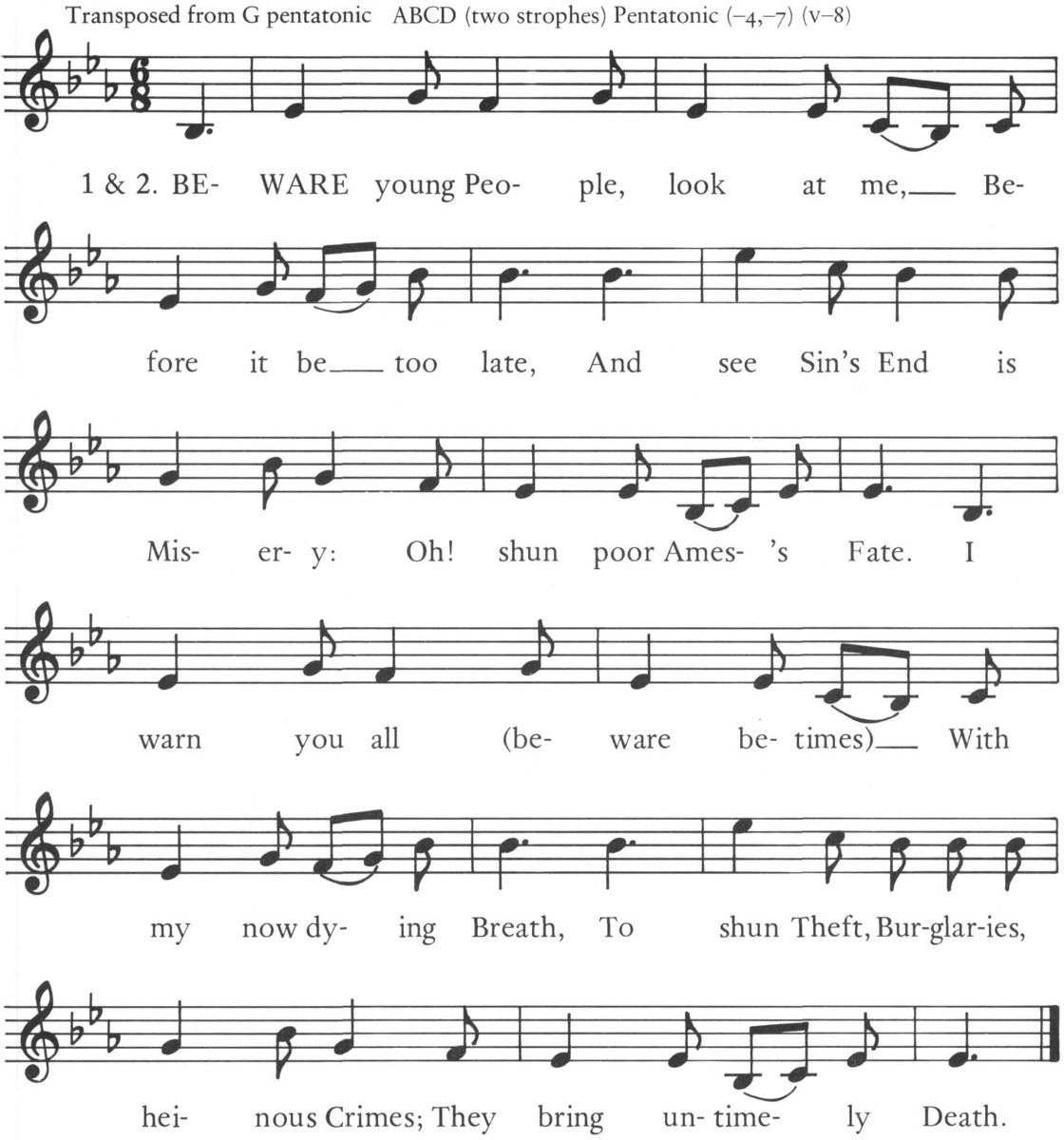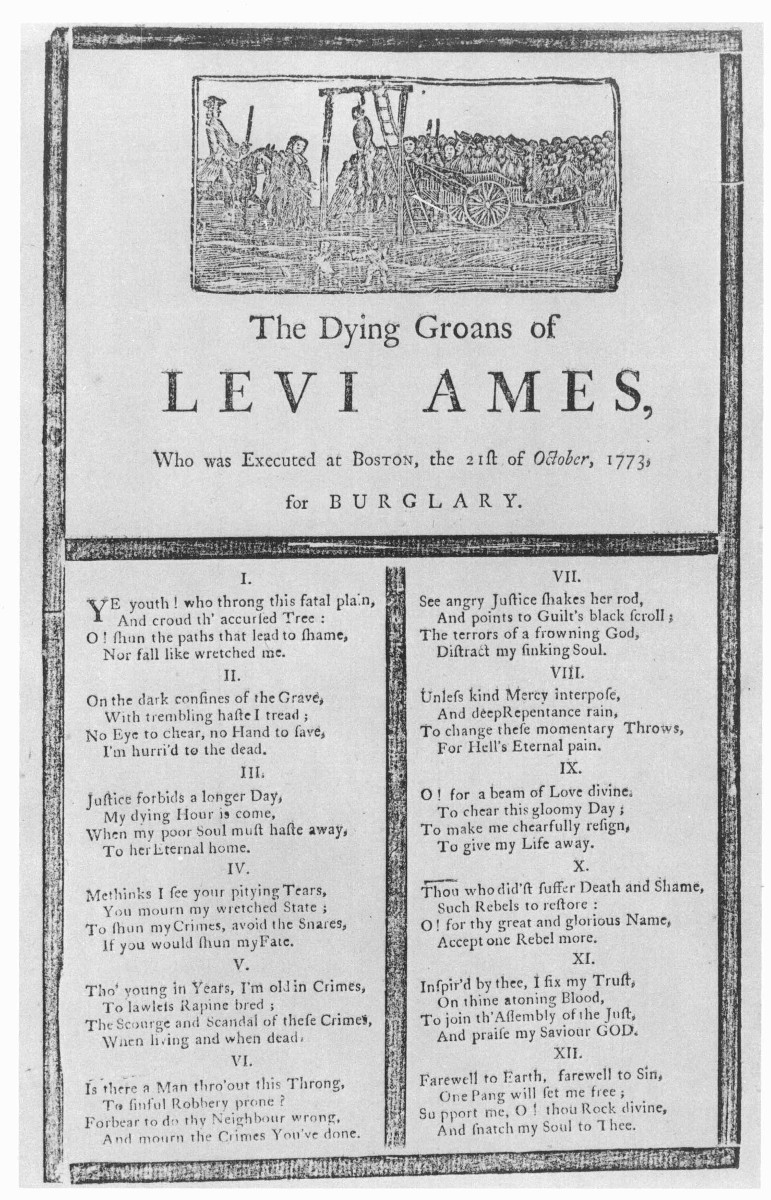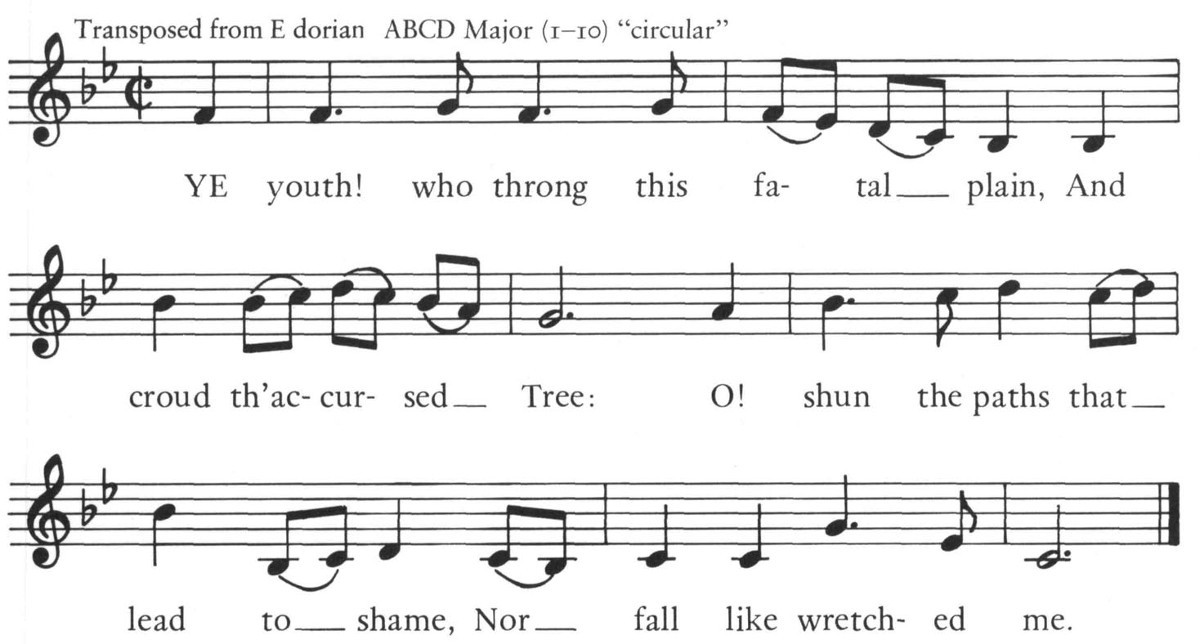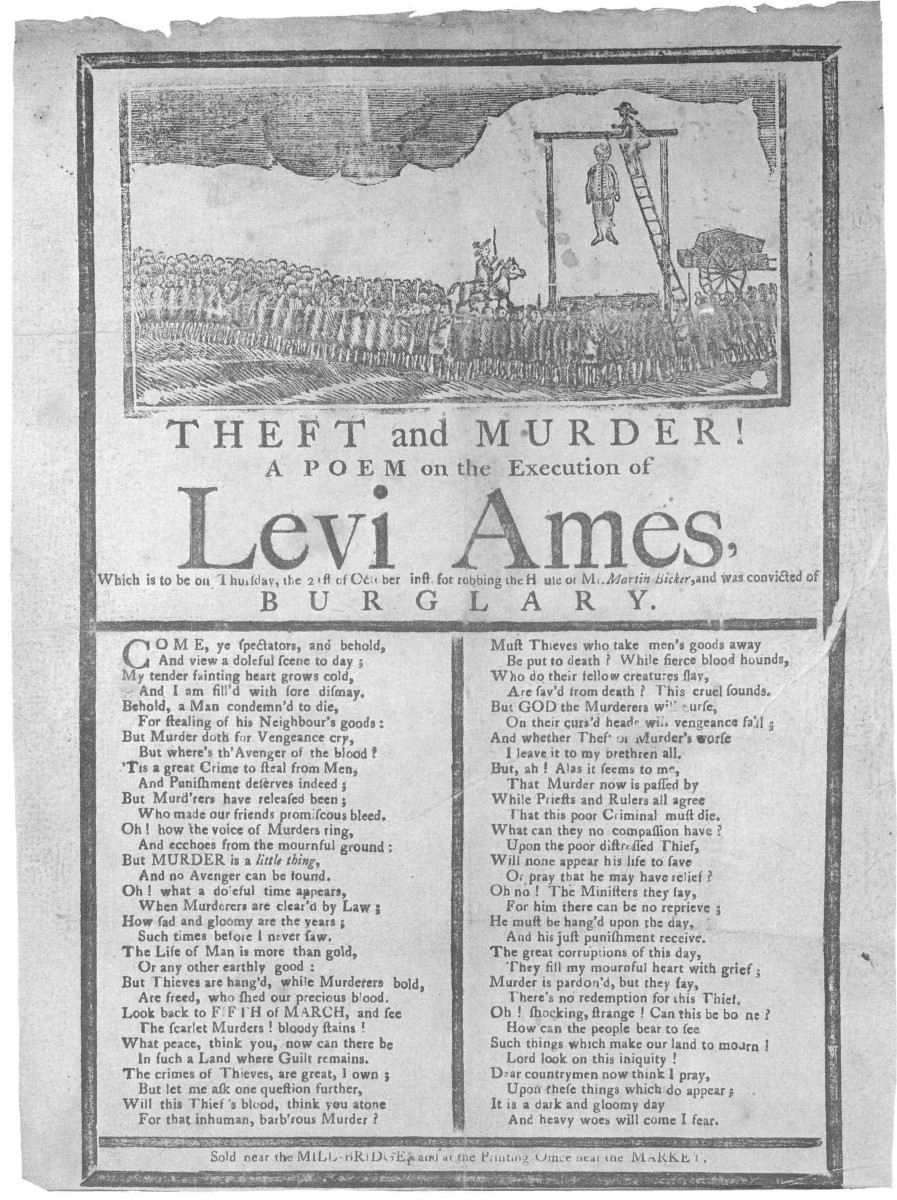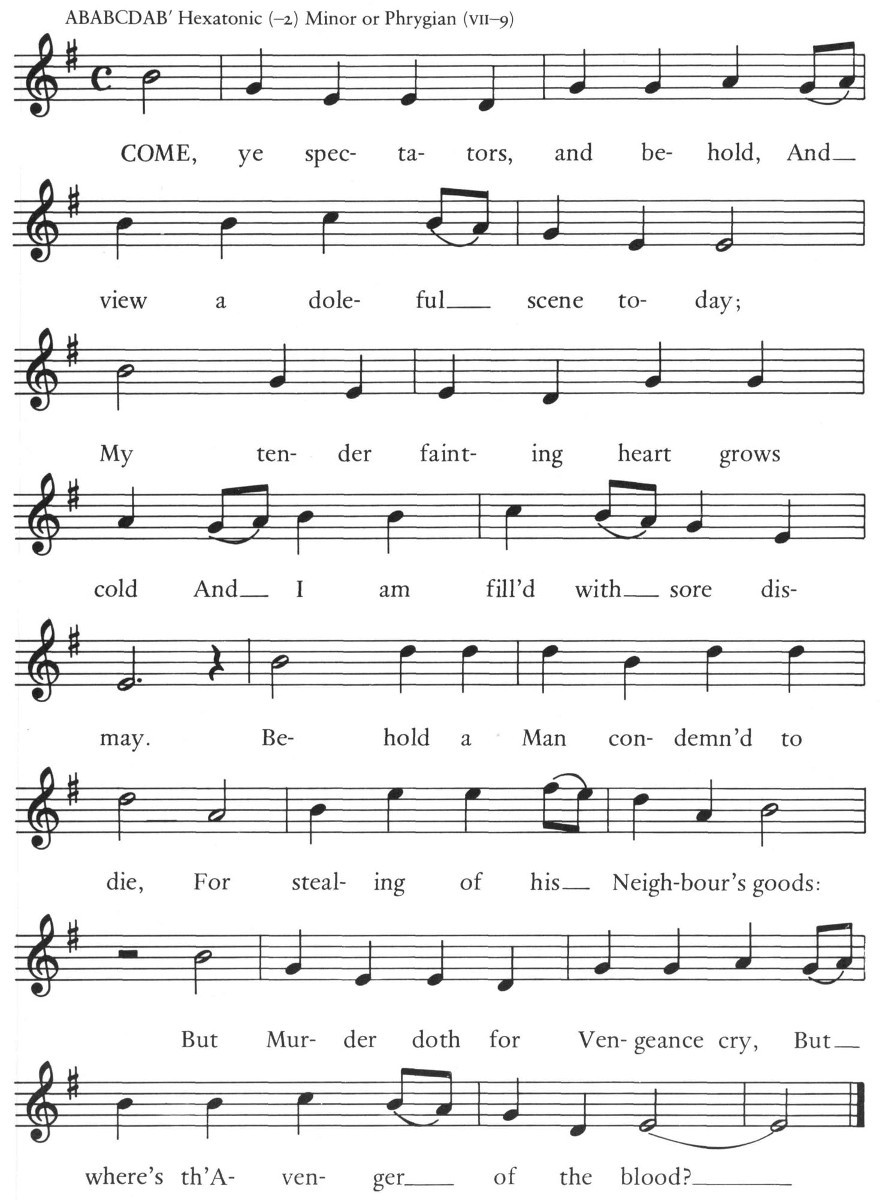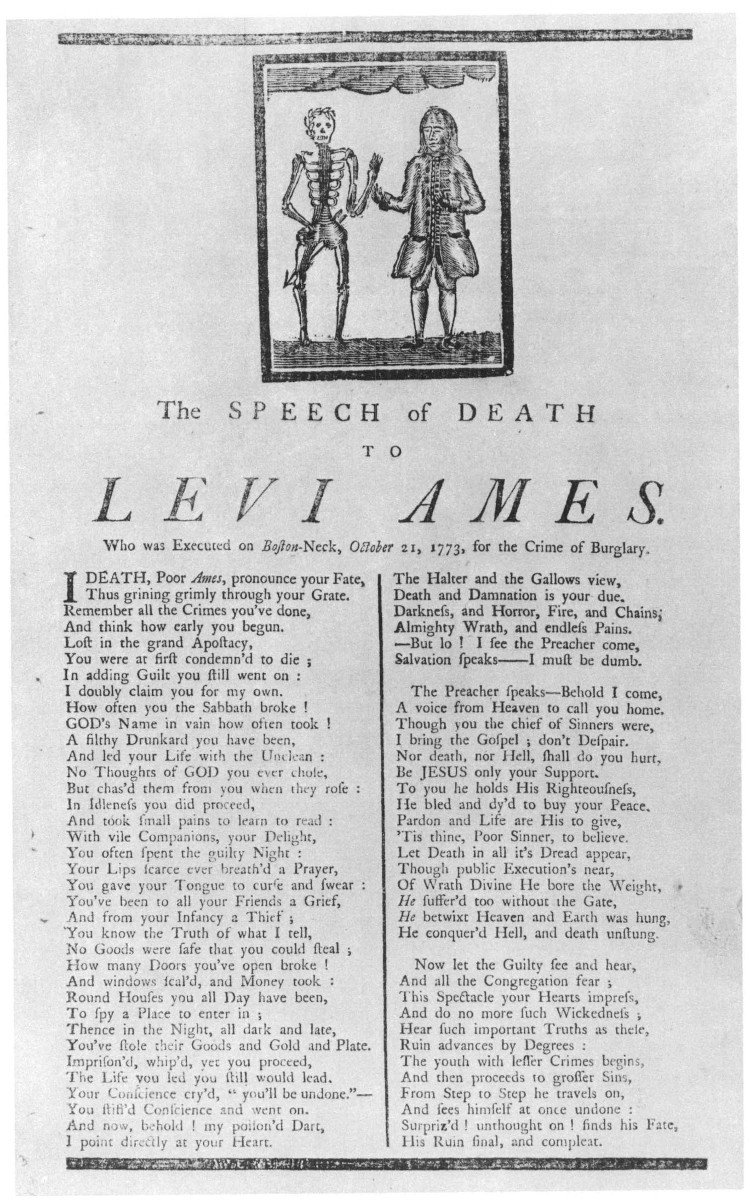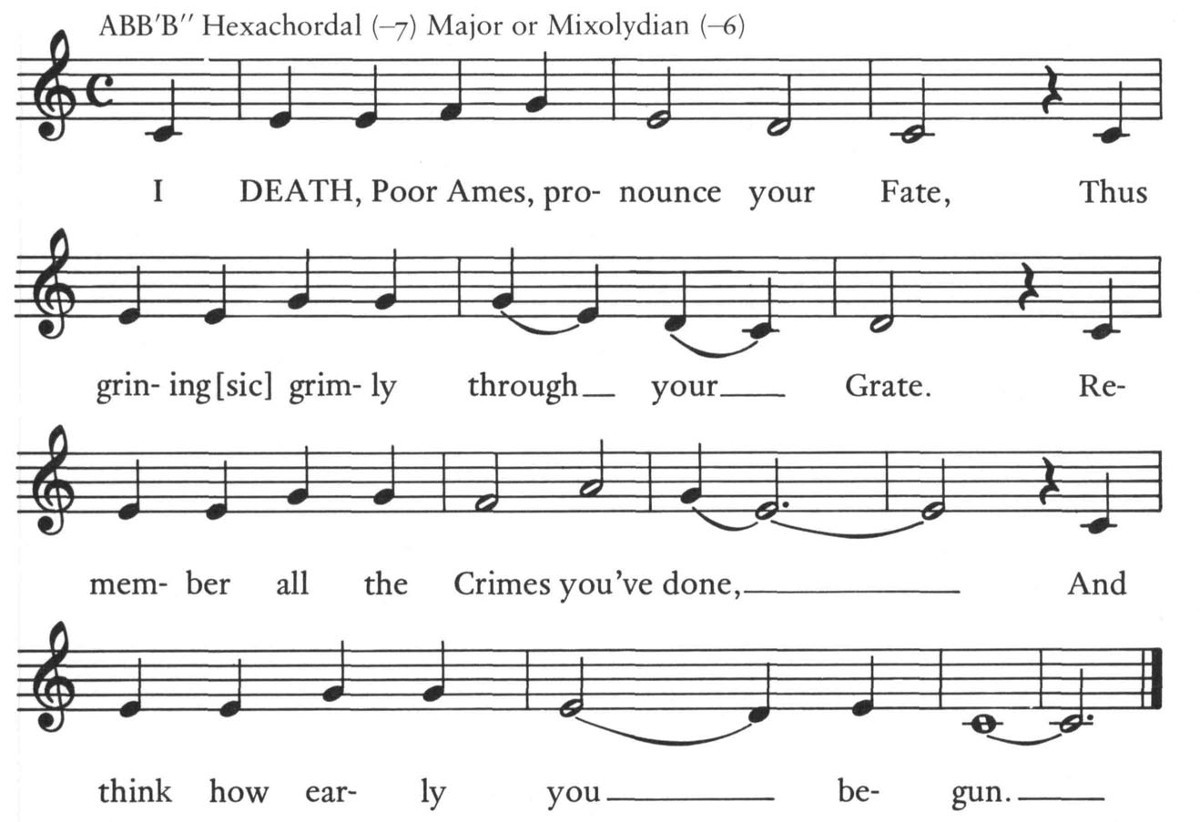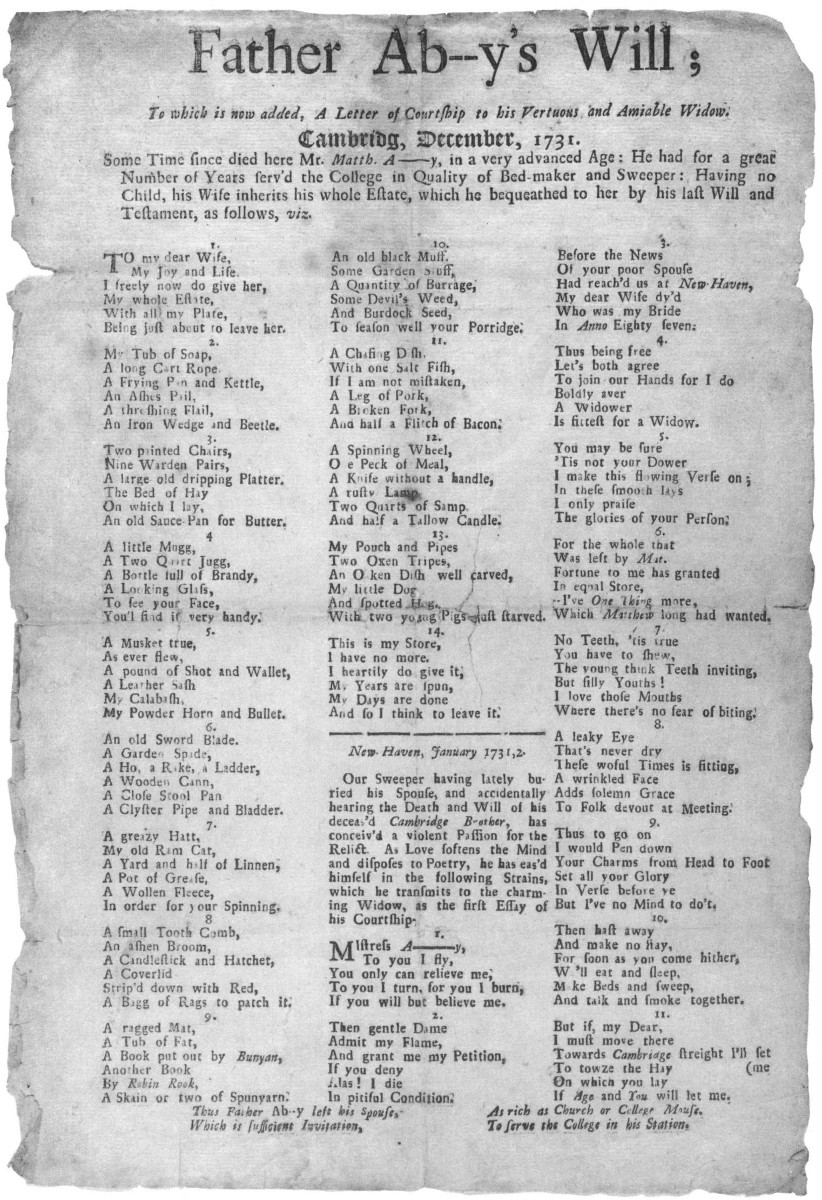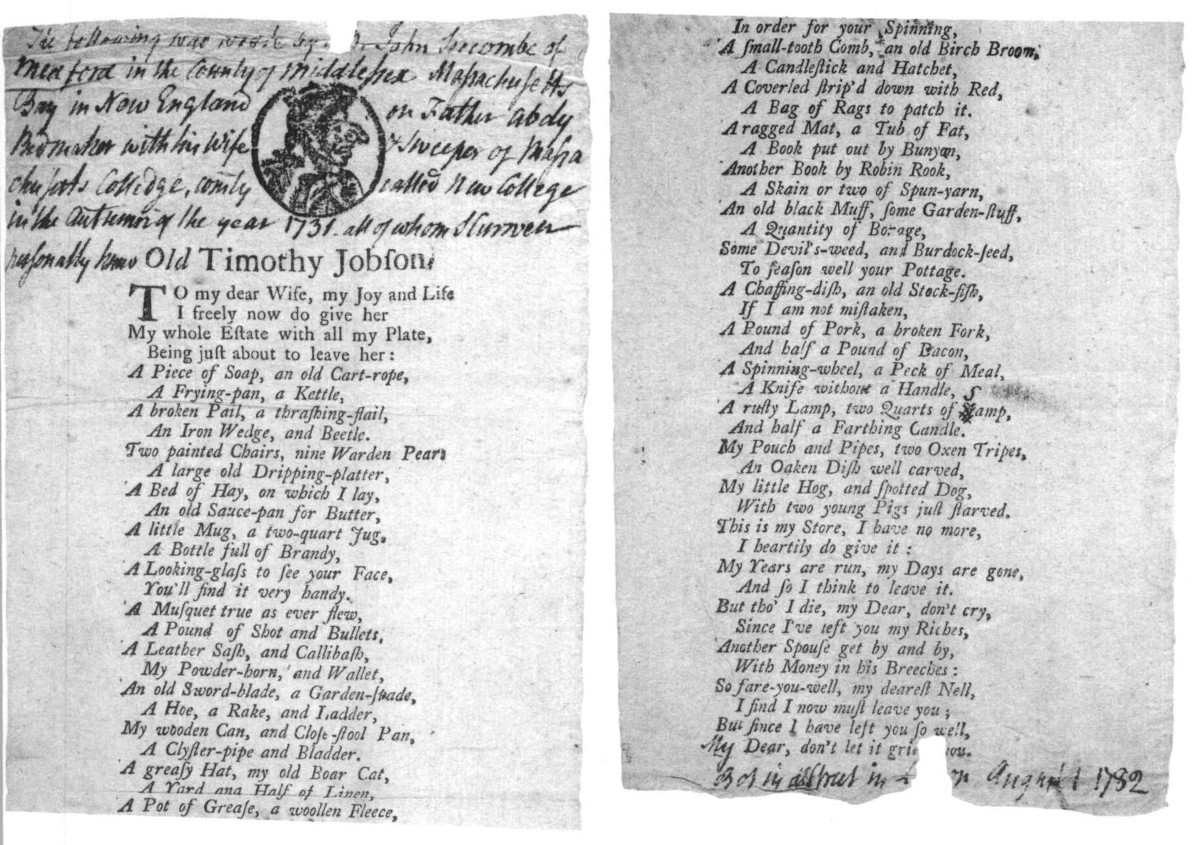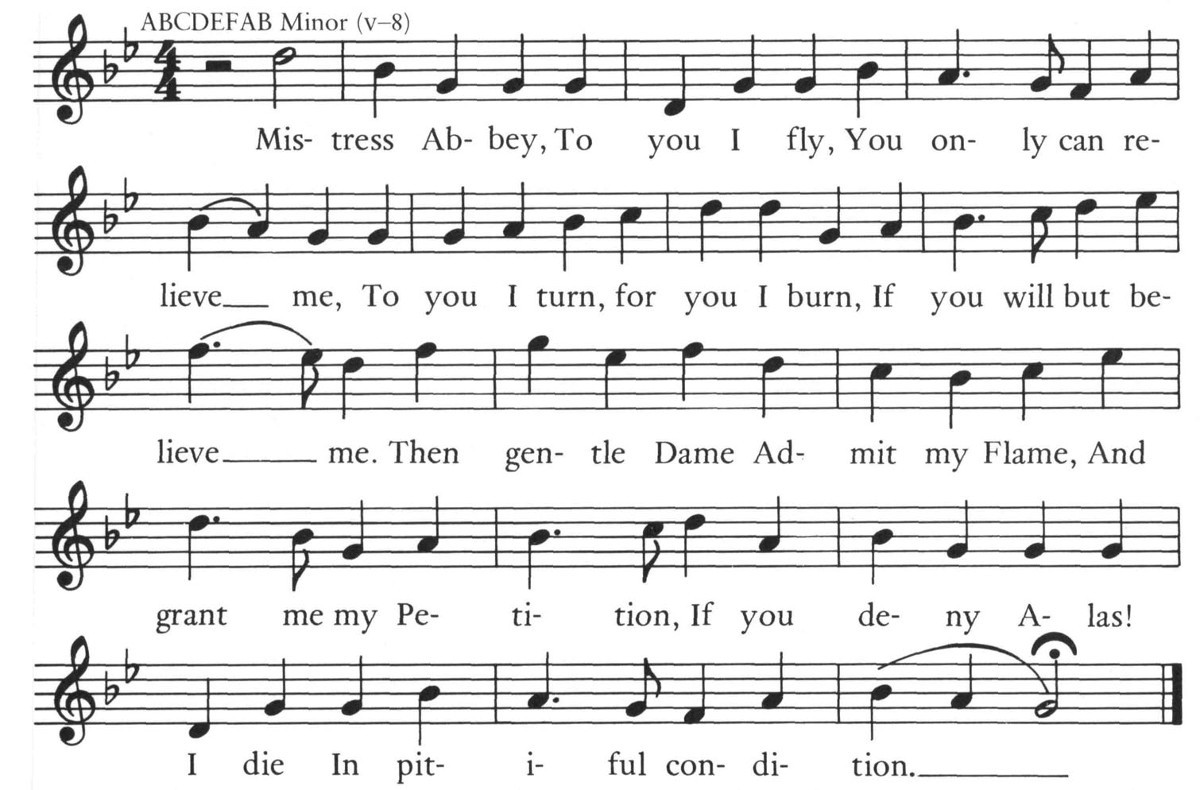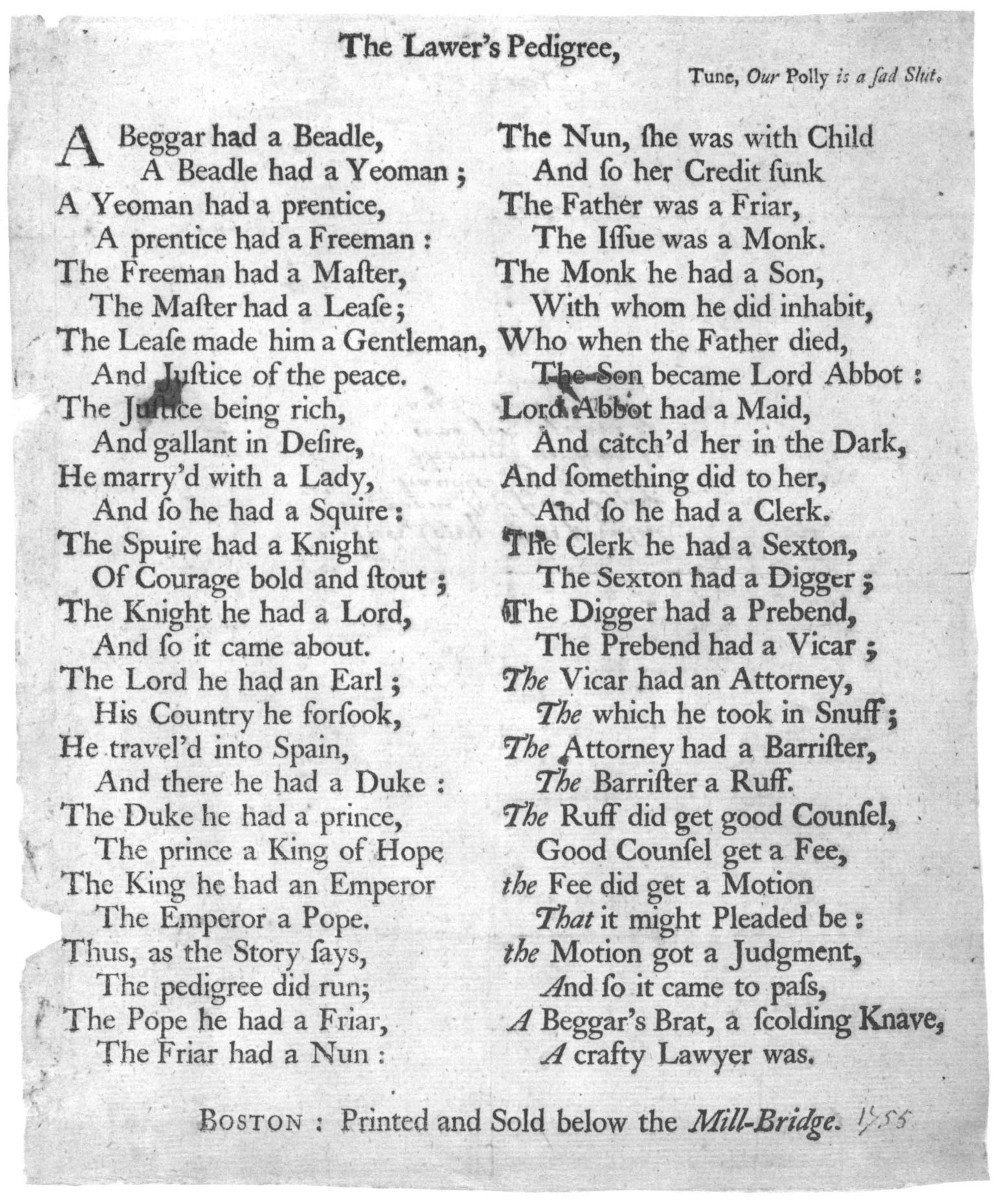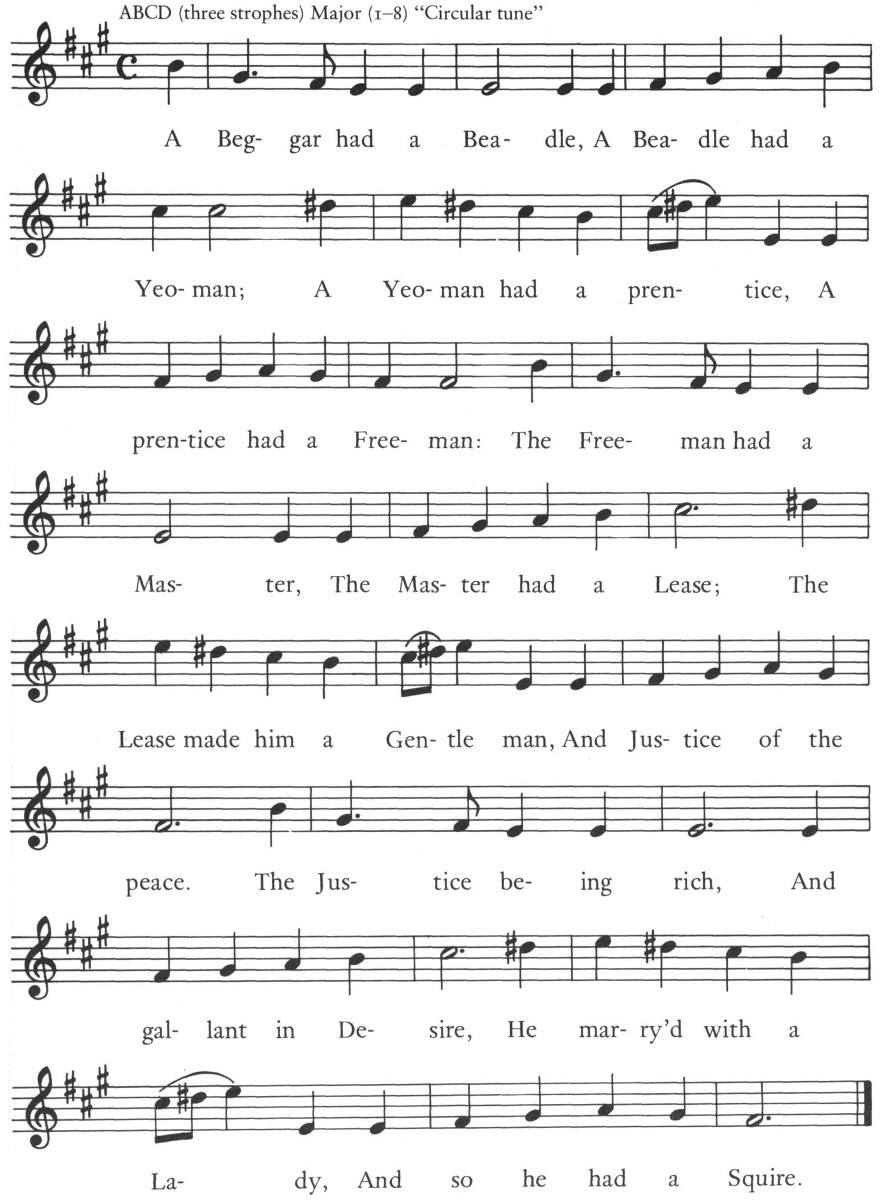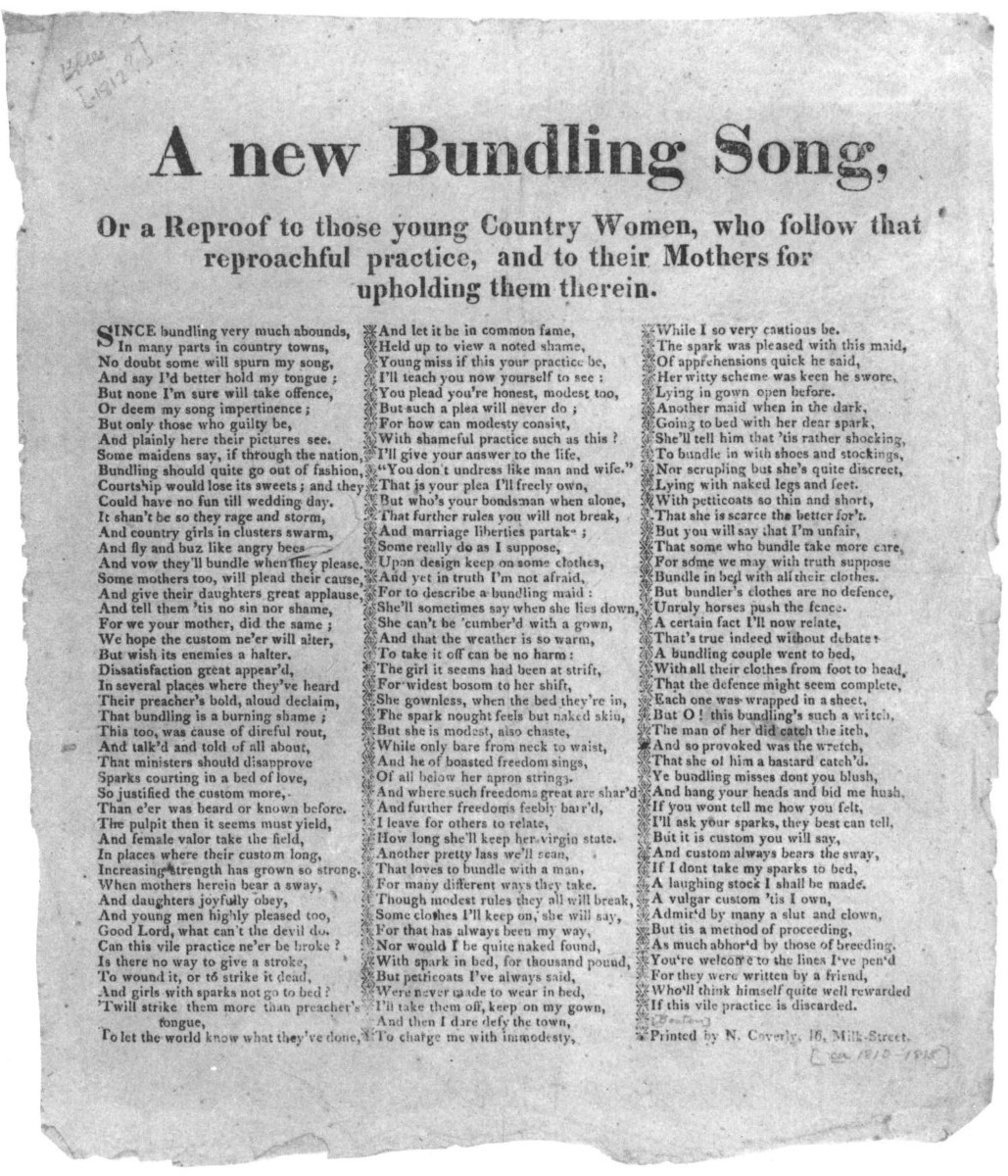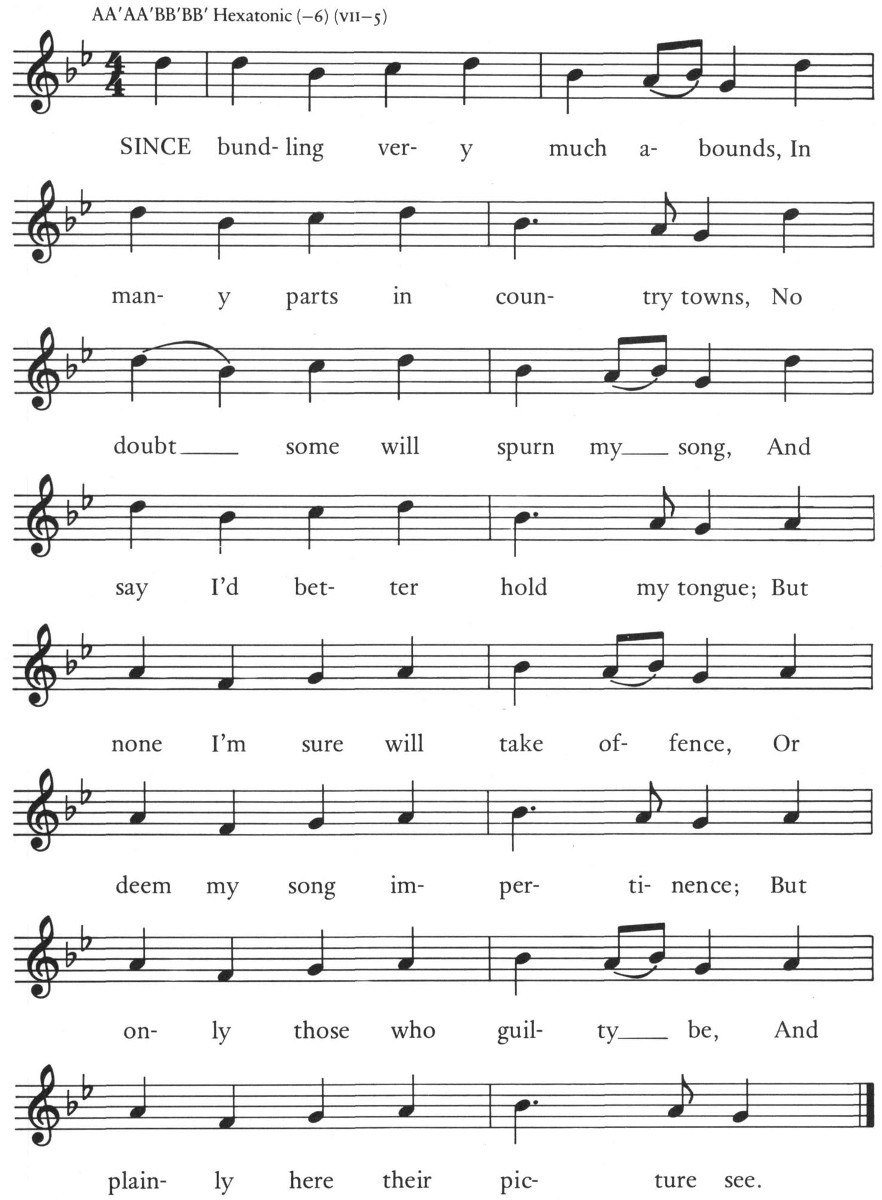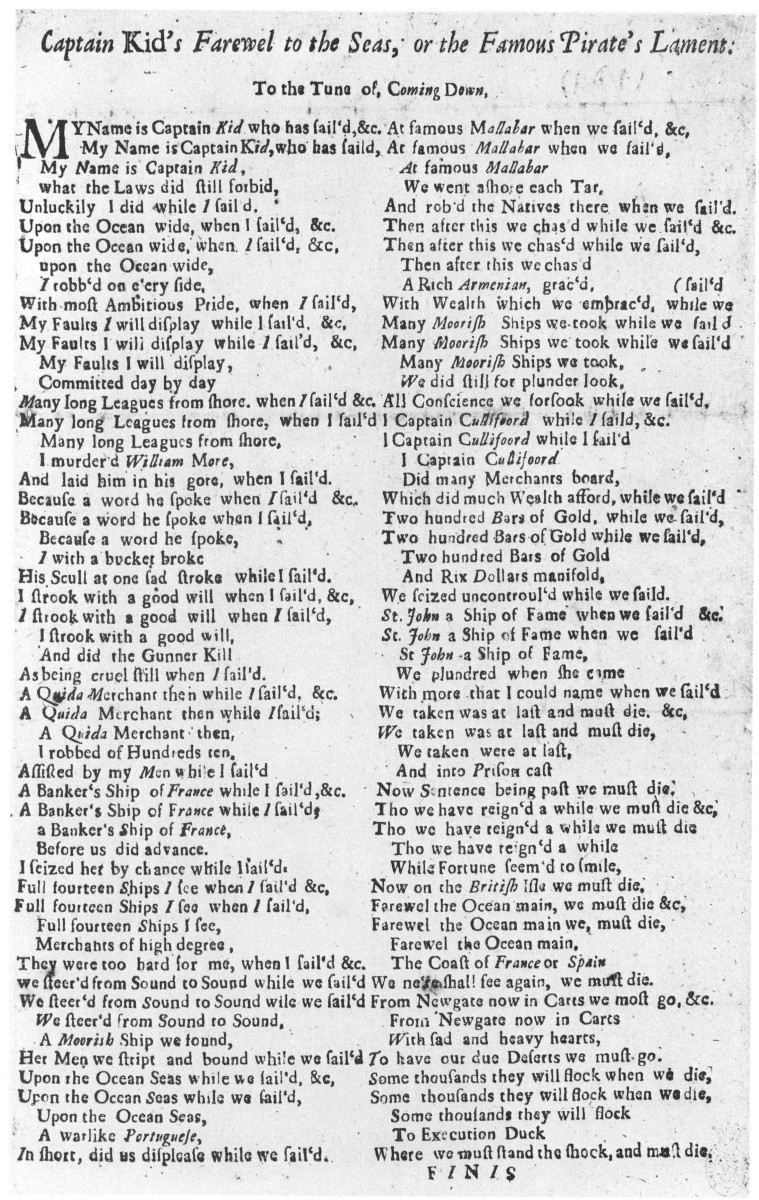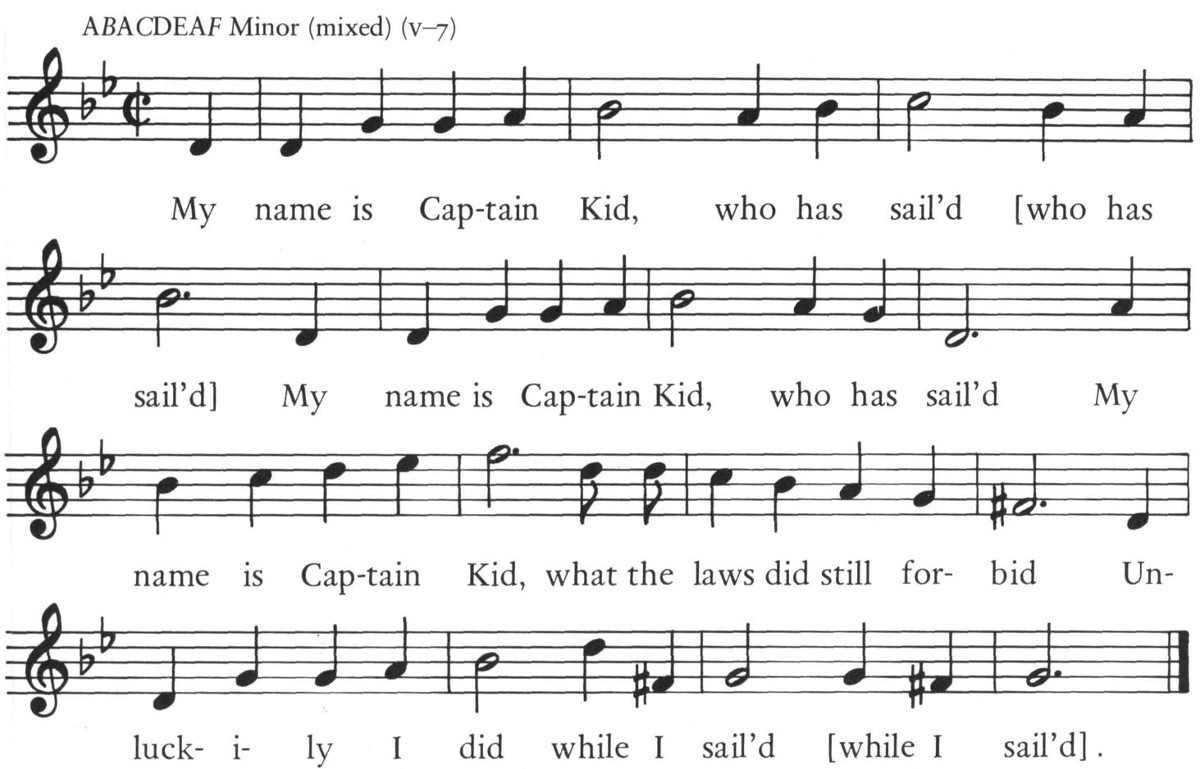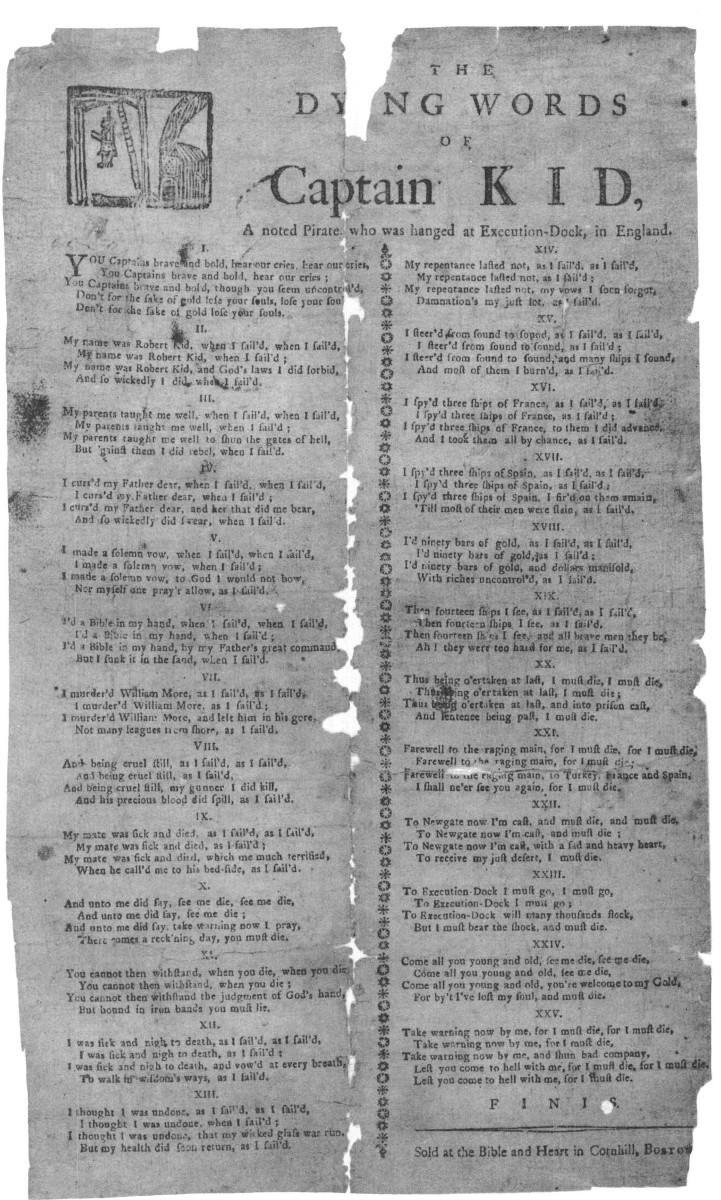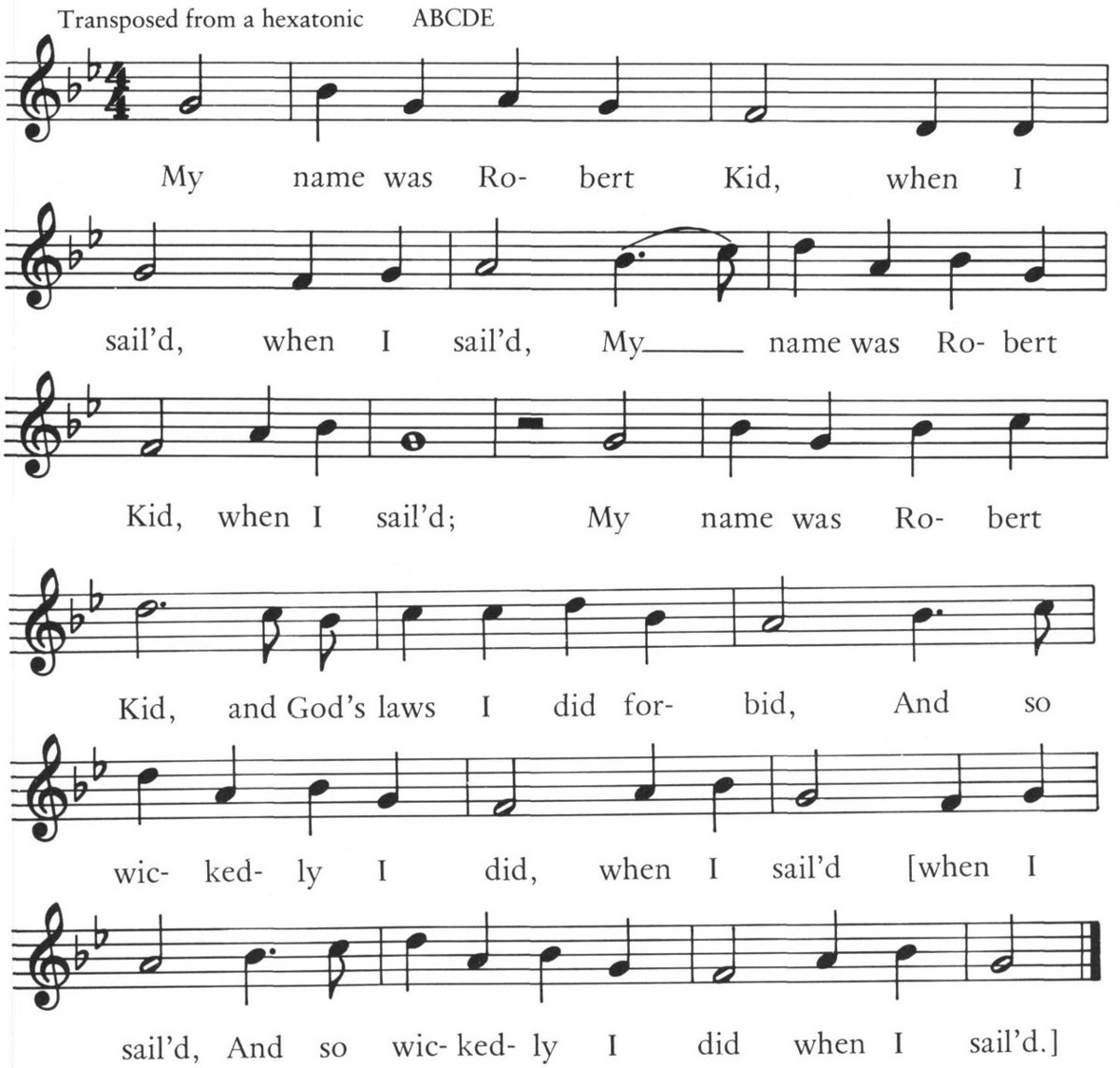Broadsides and Their Music in Colonial America
introduction
EARLY American secular folk song is a large and rich area still relatively unexplored. Seventeenth- and eighteenth-century broadsides in verse make up an important portion of that secular heritage, and they provide the historian with a musical resource reflecting special aspects of colonial life. Broadsides with metrical texts have received scant attention in studies of colonial music because the tunes to which the verses or ballads were sung were rarely printed and in a great number no tune is indicated.
For the purposes of this study, a broadside is defined as a single sheet of paper, usually printed on one side although occasionally on both. Broadsides were ephemeral in nature, inexpensive, and easily procured from booksellers and peddlers. Ballads and songs printed as broadsides likewise were circulated in newspapers, chapbooks, songsters, commonplace books, and manuscripts. They were even pasted on the walls of public houses as we learn from Izaak Walton’s The Compleat Angler: “I will now lead you to an honest alehouse, where we will find a cleanly room, lavender in the window and twenty ballads stuck about the walls.”1
Broadside ballads in verse with each stanza sung to a strophic melody are basically narrative and tell of victories, supernatural happenings, tales of love, sudden deaths or accidents, unusual adventures, and topical events. The peddling of ballads flourished in this country from the seventeenth century to the Civil War. Unfortunately there are scarcely any prints of our ballad hawkers, but the most vivid picture of the “species” ׳can be seen in genre scenes of eighteenth-century life. So numerous were peddlers that Connecticut received the nickname of “Nutmeg State” from its ambulant salesmen who reputedly passed off wooden nutmegs for the popular aromatic seed Myristica fragrans. Professional ballad-mongers sang the broadsides which they dispersed at fairs, markets, horse races, and elections and on their rounds from door to door. At public gatherings they often set up a stand or booth called a pitch. There is a revealing announcement in the Virginia Gazette for October 7, 1737, of a gathering in Hanover County on St. Andrew’s Day (November 30th) where, besides prizes for “Horse Races and other Diversions,” the organizers offered “a Quire of ballads [to] be sung for by a Number of Songsters, the best Songster to have the Prize, and all of them to have Liquor sufficient to clear their Wind-Pipes.”2 The ballad peddler’s pack included verses for people of all ages, and copies were sold to traveling chapmen, tinkers, knife sharpeners, and general hawkers as well.
Broadside ballads were found in nearly every household. Sarah Josepha Buell Hale (b. 1788) who grew up in Newport, New Hampshire, tells us in an autobiographical sketch written in 1837 that her mother, Martha Whittlesey (b. 1751), was thoroughly familiar with broadsides: “Innumerable were the ballads, songs and stories with which she amused and instructed her children.”3 Mrs. Hale, later the editor of Godey’s Ladies Book, in fact received most of her education at home, and in a period when memorizing was all important this was by no means a drawback. Children were indeed fascinated by ballads, and Isaiah Thomas actually set a broadside in type in 1755 when he was six years old.4
There is ample evidence that many broadsides in verse were meant to be sung. First, the name of a specific tune or a phrase, such as “to a new tune” or “to be sung,” often followed the title. Second, if no tune was indicated, or if the tune suggested on the ballad sheet was not known, it was understood that one might improvise a tune or choose a setting from a number of popular ballad tunes familiar through oral or written tradition. In this respect, the following telling observation appeared in the preface of the Restoration miscellany Rump; or An Exact collection of the choycest poems and songs relating to the late times (London: Printed for Henry Brome at the Gun in Ivy-lane, and Henry Marsh at the Prince’s Armes in Chancery-lane, 1662): “If thou read these Ballads (and not sing them) the poor Ballads are undone.”5
Bertrand Bronson speaks of the melodic invention which still exists among the country people of the Old and New World: “[A] vast number of beautiful tunes . . . have been gathered in our century from illiterate, or nearly illiterate singers on both sides of the water.” He adds: “It is possible for an uneducated, even a comparatively unintelligent singer to reach a level of comparatively high culture, within the circumscribed limits of traditional song, a power of melodic discrimination, a subtle sense of rhythmical effect, an artistic sensitivity of no mean musical order; to display, in fact, what may fairly be called creative ability, subject again to the unwritten canons of an ancient tradition.”6
Bronson’s monumental study The Traditional Tunes of the Child Ballads, 4 volumes (Princeton, N.J., 1959–1972), is an invaluable work. Its 5,000 tunes are basic to any research in the field of secular music in this country. Of unusual help also is Claude M. Simpson’s The British Broadside Ballad and Its Music (New Brunswick, N.J., 1966), which traces well over 500 tunes current prior to 1725. Although it does not cover American imprints, it is a splendid source for English airs, which were sung in the colonies.
The tunes selected for this collection come from a variety of sources and, in general, airs with a folk flavor have been sought. When a broadside gives the name of a tune which can be found in a seventeenth- or eighteenth-century publication or manuscript, or survives in oral tradition, one is on fairly firm ground. When no tune is mentioned one can often track down an air associated with the text. A large number of broadsides, however, do not specify a particular melody but fortunately there are various means available for discovering appropriate tunes. Printed or manuscript folk songs of the colonial period provide one source for locating tunes which suit the verse. Another method is to examine folk songs which have survived in the oral tradition and clearly bear the stamp of an earlier day. Besides those listed in Bronson, there are hundreds which have been republished in modern times by American and English collectors and scholars, and dozens of archives contain records and tapes of traditional songs as they have been sung by people in this country and abroad. Then there are folk songs preserved in our early nineteenth-century hymnbooks which bear the stamp of the eighteenth century. The late George Pullen Jackson noted a surprising number in this category; his observation and those of Anne G. Gilchrist are tremendously helpful to folk music specialists and music historians.7
If the reader is put off by the fact that tunes first documented in the nineteenth and twentieth centuries have been matched to colonial broadside texts, it should be understood that many folk songs have not changed their character greatly. Great care has been taken to cite exact tune sources. It is realized that the marriages of tunes to texts given here may not please all readers and new matches can always be sought. In a field such as this there is much room for debate.
Folk tunes which have been written down cannot be regarded as exact notations of their actual performance. Also, some singers tend not to sing a ballad twice the same way—they modify tunes and texts. No single word in English quite encompasses this meaning as does the term zersingen. Obviously if a different text is sung to a familiar air, adjustments are necessary. Stanzas with extra syllables and changing accents alter melodies to a lesser or greater degree and each ballad creates a particular mood.
Bronson’s monumental collection of melodies for the Child ballads clearly proves that there are no definitive airs or texts for folk music as there are for art songs. As folk song pioneer Phillips Barry said, “we do not rate any form of text or tune as ‘right’ to the exclusion of any other form of either.”8 Barry was highly amused by the early eighteenth-century Massachusetts music reformers, particularly the Rev. Thomas Walter, who, as spokesman for the “Society for promoting Regular and Good Singing and for reforming the Depravations and Debasements our Psalmody labours under,” waged a war on zersingen. “The good man put zersingen on a par with heresy: to sing York or Oxford with the slightest deviation from the ipsissima puncta of the composers of these tunes was as bad as being unsound on the cardinal doctrines of double predestination or the perseverance of the saints.”9
Even some significant collectors of the past ignored the fact that there is no conclusive version of a folk song or text. Over a century ago Patrick W. Joyce took his distinguished predecessor Edward Bunting to task on the matter. Joyce called Bunting’s statement, “‘an air once impressed on the popular ear, is unchangeable,’ an assertion utterly groundless, as every one knows who has the least knowledge of popular music.”10
Musical solutions for the tunes matched with broadsides in this study have been sought and some changes to the tunes have been made in keeping with the spirit of the words and the folk character of the melodies. When the writer refers to tunes which are (a) specified on the broadside, (b) indicated by the refrain, or (c) associated with the broadside through early sources, the phrase “set to the tune of” is used. When the writer supplies tunes for broadsides which are not associated with a particular melody, the phrase “matched to the tune of” is used. The phrase “fitted to” is added to the description when the tune has been significantly altered from the source given. Complete tune citations can be found in the list of figures. For an explanation of the tune analyses located at the top of each figure, see Appendix A. In order to distinguish titles of broadsides from those of tunes, which are sometimes one and the same, broadside titles are set in italics and tune titles are enclosed in quotation marks.
The popularity of secular songs and ballads in colonial America is well documented by complaints made against them. Writing in his diary September 24, 1713, Cotton Mather lamented:
I am informed that the Minds and Manners of many People about the Countrey are much corrupted by foolish Songs and Ballads, which the Hawkers and Pedlars carry into all parts of the Countrey. By way of Antidote, I would procure poetical Composures full of Piety, and such as may have a Tendency to advance Truth and Goodness, to be published and scattered into all Corners of the Land[.] There may be an extract of some from the excellent Watts’s Hymns.11
This attitude was hardly new, for as early as 1539 Coverdale exclaimed of his English compatriots, some of whose grandchildren were to become future emigrants: “Wolde God that our Mynstrels had none other thynge to play upon, neither our carters and plowmen other thynge to whistle upon, save psalmes, hymns and such like godly songes. . . . And if women at the rockes [flax distaffs] and spinnynge at the wheles, had none other songes to pass their tyme withall than such as Moses’ sister . . . songe before them, they should be better occupied than with ‘Hey, nonny, nonny—Hey, trolly, lolly,’ and such like fantasies.”12 Seven years after Mather’s alarm, the Rev. Mr. Thomas Symmes asked in a plea for establishing Singing Schools, “Would they not have a tendency to divert Young People . . . from learning Idle, Foolish, yea, pernicious Songs and Ballads and banish all such Trash from their minds?”13
Cotton Mather’s concern over the hawking of ballads makes it evident that many of the broadsides were published in England since the local presses could hardly have printed enough to be carried “into all parts of the Countrey.” The place of origin mattered little to the purchasers who were avid for songs of all types, including those which would not pass every Puritan test.
While love songs were more in the tradition of urbane London than Puritan Boston, the young people of Massachusetts were as intrigued as their English cousins by verses describing passion between the sexes. The Rev. Mr. Seaborn Cotton (Harvard class of 1651) kept a commonplace book from the time that he was an undergraduate, and during his student days he copied down the most sentimental stanzas imaginable from several broadsides, among them The Last Lamentation of the Languishing Squire; or Love overcomes all things, which was sung to either “Jockey’s jealousy,” or “The damask rose or omnia vincit amor,” and The Lovesick Maid; Or, Cordelia’s lamentation for the absence of her Gerhard. To a Pleasant new Tune. The latter opened with the melodramatic lines: “Be gone / Thou fatall fiery Feaver, now be gone” and was sung to the tune “Gerhard’s mistresse” which appeared in some eight contemporary versions, several with harmonizations.14
A number of folklorists scorn printed broadside texts because they do not fall within the category of a purely oral tradition. Yet for many ballads these are our only source. Should we neglect them because they have not survived as ‘molded folk songs’ and often have a grub-street rather than a rural flavor? Bronson remarked that “the spread of literacy has drawn off into other channels a large proportion of the creative (poetical) energy which once went into ballads” and of course many broadsides were produced by undistinguished hacks or uninspired amateurs.15 Still, as Albert B. Friedman, author of The Ballad Revival, pointed out: “Undeniably real and radical differences do exist between the broadside and the folk ballad; yet, setting all questions of aesthetic worth aside, the ballads are more alike in more respects than they are different, and in their mutual opposition to sophisticated poetry, the broadside and the traditional ballad come very near to uniting. Moreover, no matter what one may think of the similarity or divergence of the two classes in quality, in fact they have been intimately allied over the course of four centuries.”16
This study examines six categories of broadside ballads, roughly in chronological order: (i) Broadsides concerning the settlement of the North American colonies, the dawning of the eighteenth century, and a ballad on piracy perhaps by Benjamin Franklin; (ii) Border ballads describing the colonists’ struggle first with the Indians, and then with the French frequently aided by their Indian allies; (iii) Ballads illustrating the colonists’ dissatisfaction with the fiscal and political policies of the Crown; (iv) Ancient or popular ballads of the type collected by Francis J. Child; (v) Ballads dealing with crime and moral exhortations; (vi) Ballads dealing with humorous matters, concluding with a detailed examination of the circumstances surrounding a ‘confession ballad’ of Captain Kidd. Ballads concerned with love, religion, and related subjects are discussed in an article (in preparation) on “Poetry and Music in Colonial America.”
Although this study deals primarily with broadside ballads printed in Massachusetts, ballads from other geographical areas and from sources other than broadsides have been taken into account. What was current in one region was generally known elsewhere owing to the lively interchange among the colonists and between the colonies and England. And since the texts and tunes traveled widely, they frequently appeared in both print and manuscript. English imprints have received particular attention because of their integral part in the music of the provinces.
i broadsides and early settlement
From the initial settlement of the North American colonies Englishmen demonstrated in verse and song their widespread interest in the New World. A number of fascinating British ballads of this type were published in the seventeenth century; as early as 1638 A Friendly Invitation to a New Plantation appeared. Beginning “My brethren all attend / And list to my relation,” the first stanza continues:
Stay not among the wicked
Lest that with them you perish,
But let us to New England go,
And the Pagan People cherish.
Unfortunately copies of the original broadside have not survived, but the ballad reappears in 1662 as the first song in the Rump (London, 1662). There it bears a different name, The Zealous Puritan, for as historian Sir Charles Harding Firth explained, “the title was doubtless altered in 1662 to make the ballad a better introduction to the general collection of satirical verses against the Puritans.”17 Although no tune is named, Claude Simpson recognized from the rhythmic pattern that it was intended for the tune “Tom a’ bedlam” (fig. no).18
Other ballads about the New World in a satirical vein were The Summons to New England To the Tune of the Townsmens Cappe; A Song beginning “New England is preparing a-pace / To entertain King Pym, with his Grace”; A West-Country Mans Voyage to New England, with the first line “My Masters give audience, and listen to me”; and The Quaker’s Farwel to England; Or, their Voyage to New Jersey scituate on the Continent of Virginia and bordering upon New England To the Tune of “The Independents Voyage to New England,” which begins “Come friends, let’s away, / Since our Yea and Nay / In England is now slighted.”19
An appropriate introduction to the dawning of the eighteenth century are the verses published by the well-known Boston judge and diarist Samuel Sewall. They bear the heading Wednesday, January 1. 1701. / A little before Break-a-Day, at Boston of the Massachusets [sic] (fig. 111).20 In his diary Sewall noted, “Jany 1.  Just about Break-a-day Jacob Amsden and 3 other Trumpeters gave a Blast with the Trumpets on the com̄on near Mr. Alford’s [in margin: Entrance of the 18th Century.] Then went to the Green Chamber, and sounded there till about sunrise. Bellman said these verses a little before Break-a-day, which I printed and gave them. [In margin: My Verses upon New Century.] . . . The Trumpeters cost me five pieces 8/8.”21
Just about Break-a-day Jacob Amsden and 3 other Trumpeters gave a Blast with the Trumpets on the com̄on near Mr. Alford’s [in margin: Entrance of the 18th Century.] Then went to the Green Chamber, and sounded there till about sunrise. Bellman said these verses a little before Break-a-day, which I printed and gave them. [In margin: My Verses upon New Century.] . . . The Trumpeters cost me five pieces 8/8.”21
Sewall’s lines have an engagingly direct quality in their appeal to the Lord, and the six stanzas are most singable. The second verse is couched in words which show that the settlers were very conscious of their farms, and the final stanza is truly international. In long meter, Sewall’s stanzas have a sonorous sound when sung to the tune “The Ten Commandments” found in Sternhold and Hopkins, Ainsworth, and the Dutch and French Huguenot psalters. It was also mentioned specifically in “The Admonition to the Reader” in the first edition of the Bay Psalm Book (Cambridge, 1640) (fig. 112).22
One must be careful of Sewall’s phrase “said these verses” for it does not necessarily mean reciting aloud. Webster’s Imperial Dictionary quotes from The Living Church, March 12, 1904: “Whenever the word ‘say’ is employed in the Prayer Book, its use is not with the intent of requiring a reading inflection as distinguished from musical intonation, but merely that utterance be given in intelligible form to the words set forth.”23 An illustration showing that the word meant singing quite as much as speaking is found in the autobiography of the English composer Thomas Whythorne dating from the third quarter of the sixteenth century: “I wrote two Graces, the one to be said before dinner and the other to be said after dinner.”24 By publishing the texts and tunes in his Songes for three, fower and fine voyces (London, 1571), it is obvious that he envisaged a harmonic rendering all along, not a declaimed presentation.
One of our leading colonial figures, Benjamin Franklin, composed ballads on up-to-the-minute events when he was only thirteen or fourteen. In his autobiography he gives the names of two which appeared in 1719: The Light-House Tragedy: an Account of the Drowning of Captain Worthilake with his Two Daughters and A Sailor Song on the Taking of Teach or Blackbeard, the Pirate. The backgrounds of the two are as follows: George Worthilake was drowned November 3, 1718, and Edward Teach was killed November 22nd the same year “in a bloody sea-fight” when his vessel was boarded by men from two armed sloops sent out by the governor of Virginia. British pirates flourished in the later seventeenth and early eighteenth centuries. Some were active in the Caribbean and off the coast of Florida and even enjoyed the approval of certain corrupt colonial authorities. Teach spent a good deal of time in North Carolina sharing a part of his booty with the governor, the secretary of the colony, and the admiralty judge. If his piracy had been restricted to Spanish and French vessels his rapaciousness might have been condoned as overzealous privateering. But since he was unspeakably cruel and he and his men preyed on English vessels as well, Governor Spotswood of Virginia finally organized the expedition which ended the pirate’s unsavory career. Franklin disparages his ballads:
They were wretched stuff, in the grubstreet ballad style; and when they were printed he [my brother] sent me about the town to sell them. The first sold wonderfully, the event being recent, having made a great noise. This flattered my vanity; but my father discouraged me by ridiculing my performances and telling me verse-makers were generally beggars.25
Despite the remarks of the elder Franklin, most people prized songs and ballads not only because they reported the tragedies and exciting events of the day but also because they were vehicles for awakening virtue, satirizing society and generally “cheering the drooping mind.” In this connection it is interesting to read the comments which the famous printer wrote from London to his brother Peter in 1765:
Dear Brother: I like your ballad, and think it well adapted for your purpose of discountenancing expensive foppery and encouraging industry and frugality. If you can get it generally sung in your country [Newport, Rhode Island] it may probably have a good deal of the effect you hope and expect from it. But as you aimed at making it general, I wonder you chose so uncommon a measure in poetry that none of the tunes in common use will suit it. Had you fitted it to an old one, well known, it must have spread much faster than I doubt it will do from the best new tune we can get composed for it in London. I think, too, that if you had given it to some country girl in the heart of Massachusetts, who has never heard any other than psalm tunes or Chevy Chase, the Children in the Wood, The Spanish Lady and such old simple ditties, but has naturally a good ear, she might more probably have made a pleasing, popular tune for you than any of the masters here; and more proper to the purpose, which would be answered if every word could, as it is sung, be understood by all that hear it. . . . I will, however, get it as well done for you as I can.26
No New England imprints of the ballads of Peter or Benjamin Franklin have survived, but there was probably an English broadside issued in 1719 entitled The Downfal [sic] of Piracy. The reason for this belief is the inclusion of the ballad in The Worcestershire Garland; Compos’d of three excellent New Songs . . . (Newcastle, ? 1765) (fig. 113). Too much credence should not be given to the subtitle. Reprints were very common in the eighteenth century and an event which took place forty-odd years before would hardly have inspired a “new” set of words four decades later.
Franklin’s authorship of the sea song published in England has not been firmly accepted. However, judging from the “adolescent” style, so termed by Edward Everett Hale and more recently Charles O’Brien Kennedy,27 they believed The Downfal of Piracy to be A Sailor Song on the Taking of Teach or Blackbeard, the Pirate by the apprentice printer. It should be remembered that the dramatic sea fight occurred in American waters and that the surviving pirates were arraigned in Virginia. What more natural than a reprint of the Boston broadside in London? As will shortly be discovered, Good Newes from Virginia and Father Abbeys’s Will (both written in North America) were printed and fitted to tunes in the Mother Country.
Ten stanzas of the ballad are printed between pages 5 and 8 of The Worcestershire Garland (fig. 113). The heading of these stanzas reads: The Downfal of Pyracy [sic]. Tune of, What is greater Joy and Pleasure. This tune name, so often associated with tales of the sea, goes back to at least the beginning of George I’s reign. Soon after, the air was referred to as “The distracted sailor; or how happy are young lovers,” and “Come and listen to my ditty; or the sailor’s complaint.”28 Its 8.7.8.7 rhyme pattern was an attraction for writers of nautical ballads. In short, The Downfal of Pyracy, or A Sailor Song on the Taking of Teach or Blackbeard, the Pirate, was undoubtedly conceived with this maritime tune in mind.
About 1730 in England another set of verses, satirical in character, known as “Welcome, welcome brother debtor” began a long association with this melody. This title is particularly significant for Americans since Col. St. George Tucker of the Virginia militia, present at Yorktown in 1781, noted in his diary for “Fryday, October 19th”: “This Morning at nine o’Clock the Articles of Capitulation were signed and exchanged — At retreat beating last night the British played the Tune of ‘Welcome Brother Debtor’ — to their conquerors the tune was by no means disagreeable.”29 The words to this song, which ridicule eighteenth-century prison life, were said to have been written by the Jamaican black Francis Williams, “brought up by the Duke of Montagu.”30 In 1739 the air was again used by Richard Glover for another sea ballad, “Hosier’s Ghost.” This antigovernment song urged Admiral Vernon to avenge the Caribbean misfortune of his predecessor in 1726 and 1727 (see below pp. 284–285 and fn. 104), and from the 1750s on the tune generally was known as “Hosier’s Ghost” or “Welcome, welcome brother debtor.”31
There are a number of variants in the numerous editions of this tune although its basic structure remains much the same. It is a narrative air and meant for a solo voice. Air no. 7 from the ballad opera Robin Hood, first performed in London in 1730, identifies one rendition of this tune as “How happy are young lovers.” The Downfal of Pyracy is set to this version of the tune (fig. 114). Because broadsides with notated tunes were not common in eighteenth-century England and almost unknown in the colonies, a broadsheet of The Debtors welcome to their Brother is also given (fig. 115). It will be noticed that the melodic line in the second half of this broadsheet is somewhat different from that of the air found in the ballad opera Robin Hood.
ii border ballads
Curiously enough, the frontier or border ballad during the colonial period has been all but neglected as an area of study. Yet until well past the middle of the eighteenth century the colonists’ confrontation with the Indians in the forests and their conflicts with the French who were moving south and west from Canada were dramatic and heroic subjects for ballad verse. One of the earliest broadside ballads with a specified tune dates from 1623. It concerns the sudden war initiated by the Pamunkey tribe of the Powhatan Confederacy in Tidewater, Virginia, the previous year. Though these verses were published in England, their author was one of the colonists, as the title makes clear: Good Newes from Virginia, Sent from lames his Towne this present Moneth of March, 1623 by a Gentleman in that Country. To the Tune of, All those that be good fellowes (fig. 116).32

Fig. 117. Good Newes from Virginia set to the tune “All those that be good fellows.”
The good news was to relate the successful “just revenge” against King Opechancanough’s braves for the “great massacre” of March 1622. During the invasion 350 unsuspecting settlers were killed by Indians who infiltrated their houses apparently in friendly fashion and suddenly turned on them. Neither age nor sex was spared and many of the bodies of the victims were mutilated. Houses and barns were burned and horses, cattle, and swine destroyed. The colony took years to recover. The settlers did, however, wreak vengeance some months later “by setting upon the Indians in all places.” Palisaded villages and crops were burned, fishing-weirs destroyed, and corn stores taken to Jamestown for the benefit of the colonists. The early days were cruel. Bloodhounds traced the Indians to their hiding places in the forest and those that could left the Tidewater region. The refugees included Opechancanough, head of the confederacy and organizer of the massacre; he was also the uncle of Pocahontas. It is interesting to remember that the poet George Sandys, the treasurer of the Virginia Company who spent part of his time in the New World making an English version of Ovid, led one of the raids, as stanza 4 of the ballad describes. Still the settlers did not have the idea that the only good Indian was a dead one, as stanza 14 indicates.33
The tune “All those that be good fellows,” suggested for Good Newes from Virginia, is a fine militant melody of which “British grenadiers” is a descendant. It was used a number of times for warlike stanzas and had a variety of names. One of its more popular alternate titles was “The London prentice.” Dating back to the end of the sixteenth century there are harmonized versions of this air in The Fitzwilliam Virginal Book (ca. 1562–1612), where it is called “Nancie” in an arrangement by Thomas Morley, and “Nowells delight” on folio 7 in the Welde Manuscript Lute Book (ca. 1600) (library of Lord Forester, Willey Park, Shropshire). In 1603 it was published at Nürnberg in Valentin Haussmann’s Rest von polnischen und andern Täntzen as number 74, arranged in a five-part instrumental setting.34 In the eighteenth century the tune appears in Thomas D’Urfey’s Wit and Mirth; or, Pills to Purge Melancholy, 6 volumes (London, 1719–1720) and in Charles Coffey’s ballad opera The Devil to Pay (London, 1731). New England editions of The London Prentice broadside usually contain the advice “To the Tune of, ‘All you that love good Fellows’” (fig. 118).35 The first stanza of Good Newes from Virginia is set to a version of the tune found in the Shirburn ms, with alterations suggested by “Nancie” in the Fitzwilliam Virginal Book (fig. 117).
Our forefathers made attempts to christianize the northeastern Indians and both John Eliot and Roger Williams are remembered for their activities. The former translated the Bible into Algonquin, or Natick as it is also called, and published an Indian Psalter in 1663. The latter, in A Key into the Language of America, compared the native inhabitants favorably with his own countrymen: “It is a strange truth, that a man shall generally find more free entertainment and refreshing [sic] amongst these Barbarians, than amongst thousands that call themselves Christians.” He added the following verses which might have been sung to elaborate his sentiments:
Sometimes God gives them Fish or Flesh
Yet they’re content without;
And what comes in, they part to friends
and strangers round about.
.....
I have knowne them leave their House and Mat
to lodge a Friend or stranger,
When Jewes and Christians oft have sent
Christ Jesus to the Manger.36
The Pequot War of 1636–1637, and above all King Philip’s War, 1675–1676, ended native tribal life in Connecticut, Rhode Island, and Massachusetts and extirpated as well the “praying Indians” who lived in special Christian villages.
During King Philip’s War, late in December of 1675, the colonists attacked the Narragansett Indians’ fort in what is today South Kingston, Rhode Island. The episode is described in Some Meditations . . . Committed into Plain Verse . . . December 28, 1675 [by] W.W., a broadside ballad in common meter (fig. 119).37
Marching through knee-deep snow from Massachusetts and Connecticut, the troops captured and burned the fort and killed most of the Indians. The colonists’ losses were high, however. Well over a hundred militiamen died and a great many more were wounded in the fight. The following stanzas graphically describe the hardships which the troops endured.
Our Captains stout, they have gone out,
to fight them in the field:
But in the Wood they were withstood,
these Indians will not yield. (st. 8)
They had a Fight, in Heavens sight,
kept up as in a Pound,
Men strong & tall, were forc’d to fall,
and left upon the Ground. (st. 9)
And then at night, they left the Fight,
In Snow up to the knees,
And to their Tent, away they went
almost ready to freeze, (st. 11)
Some froze to Death, have left their Breath
with fierceness of the Cold,
Some Froze their feet, they being wet
’twas sad for to behold. (st. 13)
Brave Gentlemen, the which have been
brought up most tenderly,
Are now come out, Ranging about,
and on the Ground do ly[.] (st. 16)
Open your Eyes, and Sympathize,
with those brave Gentlemen,
A heart of Flint, it would Relent,
to think how it hath been. (st. 17)
Several historians have suggested that the initials W.W. on the broadside were those of Wait Winthrop, son of Connecticut Governor John Winthrop, yet the verses do not sound as if they had been written by the commander of the Connecticut forces.38 The original broadside, dated December 28, 1675, has not survived but it was reprinted at New London forty-six years later when a new border war with the Indians was imminent and the sentiments were again timely.
Some Meditations could have been sung to either a psalm tune or a folk song. The seventeenth-century air “The clean contrary way” (fig. 120) has been matched and fitted to the text. This melody has survived in the folk tradition with only slight differences as the moralizing ballad “Come all you worthy Christians,” and has an affinity to “Gilderoy” and the “Dives of Lazarus.” Cecil Sharp’s notation of the tune is instructive for anyone interested in the longevity and variation within tune families (fig. 121).
The third New England Indian war broke out in 1722, half a century after King Philip’s War and a hundred years after the Jamestown struggle. For some time there had been considerable uneasiness in Massachusetts regarding the Abnaki Indian Confederation. The Penobscot Indians, firm allies of the French, were the most numerous tribe involved.
One of the most important Abnaki villages was at Norridgewock on the Kennebec River above Skowhegan in central Maine. In actual fact it was a Jesuit mission directed by Father Sébastien Rasles (?1657–1724). A gifted scholar and a dedicated leader, Father Rasles had lived for thirty-seven years among the Indians, where, owing to his diplomatic skill, he was an able defender of France’s claim to the region. He also compiled a dictionary of the Abnaki language. When the colonial troops invaded the mission in 1721 they carried off the dictionary—ultimately published in 1833—but Father Rasles managed to escape.
The Indian tribes not unnaturally wished to attack the English settlements by way of reprisal, but for a time Governor Shute of New Hampshire managed to hold them off. Before long, however, incursions by members of various Eastern tribes began to develop. The English settlers, suspecting the worst of Father Rasles partly because he was a Jesuit, asked the Indians of Norridgewock in 1722 to deliver him up. This they refused to do. Meanwhile the provincial governors, fearing that the Abnaki might form permanent settlements of French “praying Indians,” determined to destroy Norridgewock and seize the priest, and an expedition consisting of about 200 men and a few friendly Mohawks was organized the following year. Because it was mid-August and most of the Abnaki braves were away, the raid caught the mission by surprise and those on hand were no match for the invading forces. A few survivors fled into the forest with their wives, but Father Rasles and four of the principal leaders, “Captain” Maug, “old Bombazene,” “Captain” Carrabusses, and “Captain” Wissemement were slain.
Fig. 124. The Rebels Reward and Captain Lovewell’s Battle set to the tune “All you that love good fellows” (a comparison setting).
All this was described in The Rebels Reward . . . To the Tune of, All you that love Good Fellows, &c., a broadside ballad decorated with a woodcut of the fort, its flag, canoes, and Indians drowning in the water (fig. 122).39
There are 212 lines or 26½ verses to the ballad. The author’s glee at the success of the undertaking is expressed in stanza 10, while stanzas 11 and 12 vividly describe the priest’s last moments. Strict orders had been given to capture but not to injure the French Jesuit. The ballad may be in part an apology for the soldiers’ action. Another contemporary account says that Father Rasles was killed while advancing toward the English in order to enable more of his flock to escape.40 In stanza 26 The Rebels Reward exults over the fact that twenty-eight scalps were taken (at £100 each) “which brings good store of chink,” and shows no more compassion for Indian squaws and children than for braves.
A second frontier ballad connected with the third New England Indian war appeared eight months later: The Voluntiers March; being a full and true Account [of] the bloody Fight which happen d between Capt. Lovewell’s Company and the Indians at Pigwocket. An excellent new Song [presumably Boston: Printed and sold by J. Franklin in Union-Street. 1725].41 One cannot be certain that this attribution is accurate, for the original imprint is lost. The title quoted is based on an announcement on the back page of the New England Courant for May 24, 1725, also published by J. Franklin. The Voluntiers March may have been associated with a popular contemporary tune whose identity is lost or the choice of a tune may have been left to the purchaser. A likely candidate would have been “All you that love good fellows,” an all-time favorite and in the same rhythmic cast.
One text, referred to here as version a, was Captain Lovewell’s Battle with the Indians at Pigwocket, reprinted as a broadside ninety years after the event (fig. 123).42 Another, referred to here as version b, gives more information but the description is not quite so clear; the differences between the two illustrate the folk molding of a ballad and for this reason both are included. The following text, version b, is from Farmer and Moore’s Collection, Historical and Miscellaneous; and Monthly Literary Journal, iii (February 1824), 64–66:
SONG.
1. Of worthy Captain Lovewell, I purpose now to sing,
How valiantly he served his country and his King;
He and his valiant soldiers, did range the woods full wide,
And hardships they endured to quell the Indian’s pride.
2. ’Twas nigh unto Pigwacket, on the eighth day of May,
They spied a rebel Indian soon after break of day;
He on a bank was walking, upon a neck of land,
Which leads into a pond as we’re made to understand.
3. Our men resolv’d to have him, and travell’d two miles round,
Until they met the Indian, who boldly stood his ground;
Then speaks up Captain Lovewell, “take you good heed,” says he,
“This rogue is to decoy us, I very plainly see.
4. “The Indians lie in ambush, in some place nigh at hand,
“In order to surround us upon this neck of land;
“Therefore we’ll march in order, and each man leave his pack,
“That we may briskly fight them when they make their attack.”
5. They came unto this Indian, who did them thus defy,
As soon as they came nigh him, two guns he did let fly,
Which wounded Captain Lovewell, and likewise one man more,
But when this rogue was running, they laid him in his gore.
6. Then having scalp’d the Indian, they went back to the spot,
Where they had laid their packs down, but there they found them not,
For the Indians having spy’d them, when they them down did lay,
Did seize them for their plunder, and carry them away.
7. These rebels lay in ambush, this very place hard by,
So that an English soldier did one of them espy,
And cried out, “here’s an Indian,” with that they started out,
As fiercely as old lions, and hideously did shout.
8. With that our valiant English, all gave a loud huzza,
To shew the rebel Indians they fear’d them not a straw:
So now the fight began, and as fiercely as could be,
The Indians ran up to them, but soon were forced to flee.
9. Then spake up Captain Lovewell, when first the fight began
“Fight on my valiant heroes! you see they fall like rain.”
For as we are inform’d, the Indians were so thick,
A man could scarcely fire a gun and not some of them hit.
10. Then did the rebels try their best our soldiers to surround,
But they could not accomplish it, because there was a pond,
To which our men retreated and covered all the rear,
The rogues were forc’d to flee them, altho’ they skulked for fear.
11. Two logs there were behind them that close together lay,
Without being discovered, they could not get away;
Therefore our valiant English, they travell’d in a row,
And at a handsome distance as they were wont to go.
12. ’Twas ten o’clock in the morning, when first the fight begun,
And fiercely did continue until the setting sun;
Excepting that the Indians some hours before ’twas night,
Drew off into the bushes and ceas’d a while to fight,
13. But soon again returned, in fierce and furious mood,
Shouting as in the morning, but yet not half so loud;
For as we are informed, so thick and fast they fell,
Scarce twenty of their number, at night did get home well.
14. And that our valiant English, till midnight there did stay,
To see whether the rebels would have another fray;
But they no more returning, they made off towards their home,
And brought away their wounded as far as they could come.
15. Of all our valiant English, there were but thirty-four,
And of the rebel Indians, there were about fourscore.
And sixteen of our English did safely home return,
The rest were kill’d and wounded, for which we all must mourn.
16. Our worthy Captain Lovewell among them there did die,
They killed Lieut. Robbins, and wounded good young Frye,
Who was our English Chaplain; he many Indians slew,
And some of them he scalp’d when bullets round him flew.
17. Young Fullam too I’ll mention, because he fought so well,
Endeavouring to save a man, a sacrifice he fell;
But yet our valiant Englishmen in fight were ne’er dismay’d,
But still they kept their motion, and Wyman’s Captain made,
18. Who shot the old chief Paugus, which did the foe defeat,
Then set his men in order, and brought off the retreat;
And braving many dangers and hardships in the way,
They safe arriv’d at Dunstable, the thirteenth day of May.
The opening, “Of worthy Captain Lovewell I purpose now to sing,” is a direct parody of The London Prentice (fig. 118), which begins, “Of a worthy London Prentice my purpose is to speak.”43 Since the latter was invariably sung to “All you that love good fellows,” there seems little doubt that the tune was also intended for “Lovewell’s fight.”
The expedition to Pigwocket (Pigwacket), near the present Maine township of Fryeburg on the Saco River near the New Hampshire line, was not a resounding success. Captain John Lovewell left what is now Nashua, New Hampshire, with forty-six men, planning to march eastward and destroy the palisaded Indian town. Some of the company fell ill and eight were left at Ossipee Lake to build a fort in case of a hasty retreat. Only thirty-four men went on toward Pigwocket. Owing to the exaggerated zeal of Parson Frye, who was eager to collect scalps so that he would have sufficient money to marry a thirteen-year-old girl,44 the party was induced to pursue a lone brave “Upon a neck of land, / That run into a pond / As I do understand” (version a), against the advice of Captain Lovewell and the older scouts. The company put their packs aside in order to be more mobile. After killing the “decoy” they returned to the spot where they had left their knapsacks to find them gone. As the captain had feared, they ran into an ambush. Lovewell and eight others were killed and three more seriously wounded. Twenty-three of the soldiers managed to stave off the enemy from a pine grove during the day and kill many who ventured too close, including the well-known Sachem Paugus or more accurately “the Powwow.” Then finally in the dead of night the English under Ensign Seth Wyman withdrew. Three men including the chaplain died during the retreat. Only sixteen survived.
Although the encounter had inflicted heavy damage on the English, the tribe’s losses also had been considerable. Fearing that the two provinces might pursue them more vigorously in view of the successful ambush, the elders decided to leave Pigwocket and settle on the headwaters of the Connecticut River. In the following year provincial commissioners made a treaty of peace with Governor Vaudreuil at Montreal and the English set up trading posts on the Saint George, Kennebec, and Saco rivers.
It was in the interest of the authorities to have Lovewell’s fight regarded as a victory, and in the opinion of some scholars Benjamin Franklin, Sr., may have been asked to write the verses. At the same time, although the date might be changed, the casualties could not be minimized as stanza 15 of version b admits. The ballad has been called the best-loved song in all New England, perhaps because Captain Lovewell was a famous Indian fighter and from his deathbed had encouraged the volunteers “with his warlike speeches.” Certainly one is stirred by the leader’s courageous words in stanza 9 of version b when the troops found themselves ambushed at very close quarters.
The version of the tune “All you that love good fellows” that follows is found in D’Urfey’s Pills, (1719–1720), volume 5, and as air no. 2 in Charles Coffey’s The Devil to Pay. The opening stanzas of both The Rebels Reward and Captain Lovewell’s Battle are set to it (fig. 124).
Lovewell’s fight continued to be remembered as an important frontier battle. Joseph Stow of Concord, Massachusetts, wrote a second ballad, The Brave Capt. Lovell of Dunstable, fifteen years after the event, according to a contemporary annotation in manuscript although handwriting on the sole surviving broadside indicates that it “came forth” only in “January 1739/40” (fig. 125).45 His account in thirty-two stanzas in common meter provides a few more details about the battle.
A Child ballad tune seems appropriate for this account of Captain “Lovell” and the men who “went Voluntiers to Pigwacket.” Joseph Stow’s verses have been matched to a melody originally called “The baffled knight”46 which was popular in the eighteenth century. Bronson, Traditional Tunes, ii, provides the example given here (fig. 126). Earlier versions of the tune can be found in Youth’s Delight on the Flagelet (London, 1697), and also as air no. 54 in the ballad opera Silvia by George Lillo (London, 1731).
Fights with the Indians were a continuing source of concern to the settlers, but even more important was the struggle with the French for the control of North America. The highlight of King George’s War (1744–1748) was a joint expedition of colonial land forces commanded by William Pepperell of Kittery, Maine, and a British fleet under Commodore Peter Warren, which resulted in the capture of France’s great fortress Louisbourg on Cape Breton island. This remarkable feat was celebrated in at least two broadside ballads.
The first was New England Bravery. . . . Tune of, Chivey-Chace (fig. 127). The twenty-three stanza broadside opens:
Come all New England’s gallant Lads,
and lend to me an Ear,
And of your Brethren’s mighty Acts
I will in short declare.
Stanzas 21 and 22 mention the return of the French troops and the inhabitants of the town to the Mother Country but make it clear that the war is by no means over.
They all are to be sent to France,
with all the Islanders,
Which needs must ease our Countrymen
of many Cares and Fears. (st. 21)
And all the Men are strictly bound
(that is as we do hear);
Not to bear Arms against King George
at least for one whole Year. (st. 22)
“Chivey-Chace” or “Chevy Chase,” also known as “Flying fame” in the seventeenth century, has been a favorite of the general public as well as sensitive poets and musicians since the days of Queen Elizabeth I. Few ballad meter tunes have been so universally popular; versions and variants were sung throughout the colonial period. Bronson divided them into five groups which are discussed below. The variant “In peascod time,” Bronson group b, number 4, has been chosen for the setting of New England Bravery (fig. 128).47 Whoever wrote New England Bravery, which deals with the frontier struggle between the French and English in the New World, instinctively chose the most famous ballad tune associated with the border rivalry of the Scottish and English.48
The second ballad describing the fall of Louisbourg was A Brief Journal Of the Taking of Cape-Breton, Put in Metre, by L.G. one of the Soldiers in the Expedition (fig. 129).49 Although no city is mentioned as a place of publication, the author must have come from the Nutmeg State for the opening stanza of the ballad reads:
The Regiment from Connecticut at New-London came down
And a Battalion drew up in the middle of the Town,
And Articles they were read off at the Head of all the men,
Which were well pleasing unto us all when we came to hear them.
This account squares with that of New England Bravery. Both describe the effectiveness of the colonial cannon in battering down the west gate and part of the walls, and the fascine battery which was placed on the Light House Point enabling the New Englanders to pour shells upon the island fort and to aim their guns to fire “briskly . . . right into the City” (st. 10). The final verse gives praise to the Lord of Hosts for His part in the British victory:
But now let us ascribe the Praise to whom it doth belong,
Knowing the Race is not to the swift, nor the Battle to the Strong;
But it was the Lord that fought for us, the world may see therefore,
And so let us ascribe the Praise to Him for ever more. (st. 16)
Although A Brief Journal Of the Taking of Cape-Breton does not mention a tune for the common meter double ballad rhythm, the fact that “L.G.” put it in rhymed couplets implies that the story was to be sung. Furthermore the Connecticut soldier’s final stanza praises God for his assistance, suggesting a religious air. Accordingly the verses have been matched and fitted with the narrative ballad-meter tune for Psalm 18 found in Sternhold and Hopkins’ Whole Booke of Psalmes (fig. 130). This collection, known as “The Old Version,” was used by Church of England congregations in the New World well into the eighteenth century. Psalm 18 is one of the songs in which King David, paraphrased here by Thomas Sternhold, speaks of his victories and thanks the Lord:
So I suppresse and wound my foes that they can rise no more
For at my feet they fall downe flat, I strike them all so sore. (st. 37)
Fig. 130. Of the Taking of Cape-Breton matched and fitted to the tune for Psalm 18 in the Sternhold and Hopkins psalter.
And for this cause, O Lord my God to thee give thanks I shall:
And sing out praises to thy name, among the Gentiles all. (st. 48)
After the fall of Louisbourg both the French and English planned to launch big campaigns. The former envisaged the seizure of Albany, further penetration down the Ohio River, and the recovery of Louisbourg (Cape Breton island) and Port Royal in Nova Scotia (now called Annapolis), which had been captured by New England troops in 1710. The British, encouraged by Governor Shirley of Massachusetts and Governor Clinton of New York, talked seriously of conquering Canada. An advance was to be made from Louisbourg against Quebec and another from Albany towards Montreal by way of Crown Point. Meanwhile the Iroquois Confederacy tribes agreed to make war as allies of the English. Their rivals, the Algonquins, Abnaki, Catholic Mohawks, and others, supported the French.
One episode that aroused the British colonists was the Indian raid on Saratoga in November 1745. It resulted in the destruction of the fort and twenty houses, the death of thirty persons, and the carrying off of sixty captives. A ballad appeared soon after with the intent of keeping up the enthusiasm of volunteer militiamen whose salaries were usually paid in arrears. The English Soldier Encouraged (fig. 131) bears neither date nor place of publication, but is possibly a Boston imprint. In stanza 7 the author describes himself as a veteran:
In Anna’s Reign a Soldier I have been;
But Years forbid that I should go again,
My hands are feeble yet my Heart is true,
With Prayers and Wishes it will go with you.
And in stanza 2 he urges militant action as old soldiers often do:
Now George commands drive back the encroaching Foe
That plot in Time your fatal Overthrow,
From Accadia to the Ohio River,
They seize your Lands where Jove is not the giver.
No doubt remembering the Indian attack on Deerfield, Massachusetts, in 1704, and the recent Saratoga incursion, the veteran inveighed melodramatically against the red man:
The Blood of Infants crying from the Ground,
With scalped Mothers scattered up and down[.] (st. 6)
Revenge, revenge our Blood and righteous Cause
Upon these Rogues who break all nature’s Laws[.] (st. 7)
They’ve murder’d thus in all our North Frontiers, (st. 8)
Fill’d Mother’s Hearts with Sighs, & Groans, and Tears,
And thus they’ve acted more than threescore Years[.] (st. 9)
The call to arms was shortly muted, however, when the continental powers and England made peace.
Along with the Sternhold and Hopkins psalter and the Bay Psalm Book, Henry Ainsworth’s Book of Psalmes (Amsterdam, 1612, 1618, 1644, and 1691) was a staple of the Pilgrim churches, especially Plymouth and Salem, during their first seventy-five years. Accordingly the stanzas of The English Soldier Encouraged have been matched to the melody for Psalm 94 found in Ainsworth (where the reader is directed to use the melody of Psalm 78) (fig. 132). Psalm 94 (78) derives from Psalm 120 in the French and Dutch psalters used in the colonial Huguenot and Dutch-speaking churches. It is a straightforward decasyllabic hypodorian tune suited for dramatic verse and, furthermore, passages from both Psalm 94 and Psalm 120 speak of enemies in much the same fashion as the veteran:
They doe the widow and the stranger slay
The fatherless eke, murder them doe they. (Ps. 94, st. 6)
Iehovah O thou God of vengeances:
O God of vengeances shine-with-clearness. (Ps. 94, st. 1)
My soul hath long dwelt with him that hateth Peace.
I am for peace: but when I speak, they are for war. (Ps. 120, st. 6–7)
The bellicose spirit of the colonists, however, was not dampened. There is a fascinating account in the diary of Henry Muhlenberg for May 7, 1752, of a stagecoach trip from Bordentown to New York:
At one o’clock in the afternoon we left and drove until two o’clock in the night, covering thirty miles amid continuous shouting and singing on the part of the company. . . . The English people have a kind of songs [sic] which are set to melodic music and describe all sorts of heroes and feats of arms on land and sea. Respectable people sing them as a pastime and regard it as a serious invasion of their liberty if one protests against these songs, etc. Now, if one rebukes them on account of their amorous songs, they believe that they can justify themselves by referring to these songs about heroes. The musical settings and melodies of these songs of heroic deeds are very similar to those which our Germans use for church music.50
Since this was written before the capture of Canada when many new songs of this type were composed, the distinguished German American Lutheran pastor must have been referring to some of the ballads previously discussed, as well as the melodies “Rule Britannia,” “Logan water,” “The granadier’s [sic] march,” and the traditional “Chevy Chase,” all of which will be discussed shortly.
Fig. 132. The English Soldier Encouraged matched to the tune Psalm 94 (78) in the Ainsworth psalter.
The capture of Louisbourg had cost both money and lives and New Englanders not unnaturally were furious when Cape Breton and its famous fort were returned to France by the Treaty of Aix-la-Chapelle in April 1748. Louisbourg had been garrisoned by New England regiments, and Lieut. Gen. Sir William Pepperell had to take money from his own pocket to pay the local debts and transportation home for the troops. The provinces now demanded reimbursement for their military expenses. In the summer of 1749 Parliament voted £153,649 to satisfy the claims.
Local merchants meanwhile were eager to improve Massachusetts’ fiscal position and to retire the inflated paper currency which had greatly decreased in value since 1702. Late in the year, 653,000 ounces of silver and ten tons of copper were landed in Boston for the benefit of the provinces but it received little publicity from the government. The rate of exchange of paper to silver had been eight to one early in 1749. Suddenly without warning the fiscal authorities authorized the redemption of the Old Tenor bills at one-fifth less than the current value. This was clearly unfair. The lower and middle classes saw that “a promise to pay was not paying and that the increment of promises was only an increment of debt.”51
The lieutenant governor, however, pushed ahead the hard money policy and forbade the circulation within Massachusetts of paper bills from the neighboring provinces. On January 26, 1749, a law was passed which decreed the withdrawal of the paper bills of credit from circulation. It was answered by a number of ballads satirizing or ridiculing the whole currency policy. As Worthington C. Ford wrote more than half a century ago, “it appears that there were two or three sets or renderings” of the verses and he added, “it is likely that the more offensive were not contained in the printed sheet[s].”52
Fig. 133. Broadside proclamation against the ballad A Sad and Deplorable Lamentation, etc., which poked fun at the government.
Fig. 134. Broadside ballad, a satire on the retirement of the Old Tenor currency, attributed to Joseph Green.
Fig. 135. A Mournful Lamentation set to the tune “Chevy Chase” as it appears on the broadsheet Wonders upon Wonders.
The reaction of the Crown authorities, however, suggests that at least one violent broadside saw the light of day for a Proclamation was issued April 18, 1751, offering a suitable reward for the apprehending of two suspects who had “published and dispersed within this Province, an anonymous Paper in the Form of a Ballad, called ‘A sad and deplorable Lamentation,’ &c.” (fig. 133).
Although no copy of A Sad and Deplorable Lamentation has yet been found, there is a broadside preserved with a very similar title: A Mournful Lamentation For the sad and deplorable Death of Mr. Old Tenor. . . . To the mournful Tune of, Chevy-Chace (fig. 134).53 J. Hammond Trumbull ‘suggested that the Boston wit and versifier Joseph Green was the author of this relatively mild satire and that may be so. The problem of the missing broadside which has a very similar title bears further investigation. Are they one and the same?
The ballad has been set to a version of the “Chevy Chase” tune (fig. 135) which is found on an engraved English broadsheet entitled Wonders Upon Wonders. . . . To the Tune of Chivy Chase (fig. 136) dating from the first decade of the eighteenth century.54
Two other ballads on the same subject seem to have been more biting but were not singled out by the authorities, perhaps because there were no clues as to their origin. The first is The Dying Speech of Old Tenor (fig. 137). No air is indicated for this twenty-five-stanza political parody written in decasyllabic quatrains as were many other ballads concerned with death. It has been matched to a traditional “Death and the lady” tune collected in Ireland in 1892 (fig. 138).
The second ballad was truly unflattering to the fiscal authorities: A Song On the Remarkable Resurrection. . . . To the Tune of Jack the Piper, or any other that suits (fig. 139). The author of the text attacked politicians and bankers bitterly:
Six shillings is a ‘boon’ Dollar;
And the most soft Address,
Of Hypocrites and Party Men,
Can’t make it more or less. (st. 2)
Dear Orphans small, if Legatees!
Lift up your little Hearts:
The Cunning and designing Man,
Is strip’t of all his Arts: (st. 3)
Whereby he took your Portions great,
But made you to believe,
You lost them by most dreadful Times,
Whilst he laugh’t in his Sleeve. (st. 4)
In case there is another War,
With Frenchmen on the Coast;
Cape-Breton for to take again,
We easily may boast; (st. 15)
Fig. 140. A Song on the Remarkable Resurrection matched to the tune “Come all you worthy Christian friends.”
And then succeed or not succeed,
’Tis but a Matter, small,
What tho’ Ten Thousand Lives be lost
Since we Old Ten can call. (st. 16)
A search for a tune entitled “Jack the piper” has not yet met with success; therefore a version of the tune “Come all you worthy Christians” from the “Dives and Lazarus” tune family collected by Cecil Sharp in 1905 has been matched to the ballad (fig. 140). The words usually associated with it warning the faithful to “Be watchful for your latter end / Be ready when you’re called” give an added piquancy to the mixolydian melody joined to stanzas 5 and 6 of the broadside.
The American phase of The Seven Years’ War, 1756–1763, really began a year earlier. Signaling it was an anonymous homespun twenty-three-stanza moralistic ballad in long meter entitled Verses Relating to the Events of 1755 which has survived only in a Paxton, Massachusetts, manuscript of ca. 1790.55
We that did live in fifty five,
That were preserved & kept alive,
We may record what god has done
Beneath the circuit of the sun. (st. 1)
First in the spring the wars begin,
To punish men then for their sin;
They beat their drums & so they cry,
Who will unto the battle fly? (st. 3)
They [the colonial militia] first arive in East-ward shores,
Where drums do beat and Cannons roar;
A hero Spirit they retain,
Which puts the french-men to great pain. (st. 6)
They [our soldiers] take their forts & so Possess
Their pastures and their Wilderness.
The Joyful News spreads O’r the land
That we have gain’d the upper hand. (st. 7)
But then a Cloud o’r spread the sky,
For braddock and his men did die; [July 9, 1755]56
They lost the day & so did fly
And fell before the enemy. (st. 8)
There foes rejoice & shout aloud,
And Anti-Christ grows very Proud;
While we are mourning in Distress
The widow and the fatherless. (st. 9)
After discussing the inconclusive but bloody battle of the summer the author dwells on earthquakes and concludes with a warning to all. One must not forget that this was the century of Jonathan Edwards, the American divine and metaphysician.
Hear the sad Noise from Lisbon town, [November 1, 1755]
Which shook & fell unto the ground;
And Multitudes there buried were
In the dark Reageons of Dispair. (st. 22)
And Now, O Land, New England Land,
Amased be & trembling Stand,
Because the Judge Stands at the Door;
Foresake your sins, repent therefore. (st. 23)
There is an added footnote:
These are the hints which I have made
In fifty five it Shall be Said.
The old Scottish tune “Gilderoy,”57 which originated with the famous outlaw drawn upon by Sir Walter Scott in Rob Roy, exists in a number of variants. Verses Relating to the Events of 1755 has been matched and fitted to an early version of the tune found in William Thomson’s Orpheus Caledonius, 2d edition, 2 volumes (Edinburgh, 1733) (fig. 141). As modified (fig. 142), the air is especially well suited for the moralistic stanzas.
Fig. 141. A traditional Scottish tune from William Thomson’s song collection Orpheus Caledonius (Edinburgh, 1733).
Not all that happened in 1755 was unfavorable to the English from a military point of view. On September 8, 1755, a French force led by Baron Dieskau fought British colonial and regular troops under Gen. William Johnson at Lake George in the foothills of the Adirondacks. The latter were fortunate to escape from an ambush in which their commander was wounded; Gen. Lyman, the second in command, then rallied the colonials. What might have become a rout became a distinct victory. The morale of the provinces again rose, having been downcast by Braddock’s 1754 defeat near Fort Duquesne (today’s Pittsburgh). Johnson received a gift of £5,000 from the British government and was made a baronet.
A broadside recounting the battle was called A Ballad concerning the Fight between the English and French, at Lake-George (fig. 143).58 There are thirty-two 8.7.8.7 stanzas. Frequently irregular, the ballad verse is also charmingly personal; various officers including their leader are mentioned by name, as in stanzas 6–7:
Fig. 144. A Ballad concerning the Fight . . . at Lake-George, 1755, matched to the tune “Now comes on the glorious year.”
Our enemies they pushed so close, and followed us so near,
We thought they were our own Men, a bringing up the Rear.
Brave Johnson then directs the Fight, as bold as Alexander,
Resolv’d to do his Country Right, as being chief Commander:
Although no tune is indicated, “Now comes on the glorious year” has been chosen for the setting (fig. 144). This popular patriotic melody is found in D’Urfey’s Pills, 1, 27, as well as in a number of ballad operas including James Ralph, The Fashionable Lady (London, 1730), air no. 5 (fig. 145). Ralph’s use of this tune is particularly appropriate for he was a Pennsylvanian who arrived in London at the age of twenty-five accompanied by Benjamin Franklin, who at nineteen was on his first trip to England. Ralph was the only colonial to write a ballad opera in London and he became active as a critic and manager with Henry Fielding of the New Theatre at Haymarket.
A famous song of quite different character seems to have emerged during the French and Indian War although it is difficult to document. A tradition concerning the origins of “Yankee Doodle” is described in Farmer and Moore’s New Hampshire Collection, July 1824. Dr. Richard Schuckburgh, a surgeon since 1737 of the “Four Independent Companies of Foot” stationed in New York, reportedly composed or arranged the tune and supplied it with satirical words while stationed at Albany in the summer of the historic year 1755. His purpose was to poke fun at the ill-clad colonial troops and to recommend the tune “with much gravity to their officers as one of the most celebrated airs of martial music.”59
Since “Yankee Doodle” is mentioned in Andrew Barton’s The Disappointment; or the Force of Credulity (Philadelphia, 1767), it is reasonable to suppose that it came into being a decade or so earlier. Still, if one is a stickler for detail, it must be pointed out that Dr. Schuckburgh could not have written his satire in Albany during the summer of 1755 since his regiment was stationed in Virginia. Whatever the date, whoever wrote it was making pleasant fun of untrained soldiers. The earliest surviving broadside dates from 1775.60
Fig. 146. Broadside ballad by Abiezer Peck, eulogizing Gen. John Winslow, who was ordered to deport the Acadians from Nova Scotia.
Little is known about Abiezer Peck of Rehoboth, Massachusetts, save that his father, Samuel Peck, was a Baptist minister. That Peck was a patriot is clearly proven by his fulsome ballad of April 5, 1756, on Gen. John Winslow (1703–1774) of Marshfield. For some reason he does not spell out the general’s name. Rather he gives the first and last letters W——w. Winslow was the American officer who had the unpleasant task of expelling the French Acadians from Halifax the year before, “more Grevious [sic] to me than any Service I was ever Employed in.”61 The ballad is entitled On the Valiant New-England General (fig. 146).62 The author was apparently not disturbed by the heartrending event, for stanza 14 implies that the general should continue to deport French Canadians from their homesteads:63
Come W——w, take the solemn Charge,
to lead our warlike Bands:
Go drive the Foes of sov’reign George,
to skulk in foreign Lands.
A logical tune for this song is “Souldiers life,” found in The Dancing Master from 1650 to 1725 (fig. 147).64 Besides being associated with “woeful wars,” the melody, with slight modifications, was also used for the ballads of “Lord Thomas and Fair Ellinor” and “Tomorrow is St. Valentine’s Day.”
One of the most pleasing ballads of the decade was written by Mather Byles. It is signed M.B. and bears the title An Endeavour to animate and incourage our Soldiers, for the present Expedition. Made, and Fitted to the Tune of George’s Coronation (fig. 148).65
The ballad refers either to the planned expedition of 1756, or the one carried out in 1758 to recapture Louisbourg. King George’s War had been concluded in 1748 with the Treaty of Aix-la-Chapelle, and as part of the settlement, England had returned Louisbourg to France.
The earlier date is more likely since the stanzas speak of Culloden, Cape Breton, Acadia, and Lake George, and no reference is made to any engagement after 1755. Stanzas 5 and 7 reprinted below are annotated with the dates of the battles mentioned.
|
Of late our Young, our Princely Duke, |
[Duke of Cumberland] |
|
Gave the Pretender a Rebuke, |
[Charles Edward Stuart] |
|
While vengeful Justice overtook |
|
|
Them in the last Confusion; |
|
|
With great Precipitance they Fled, |
[Culloden, April 16, 1746] |
|
And left near half their Armies Dead, |
|
|
And soon the bloody Plots they laid, |
|
|
Were brought to a Conclusion. |
|
|
Brave Hearts of Gold, lose not your Fame, |
|
|
Which at Cape-Breton you did gain, |
[1745] |
|
And George’s Rights did well Maintain, |
|
|
And gain’d his Royal Favour: |
|
|
Yea Accada [sic] we did Reclaim, |
[1755] |
|
And at Lake-George the Vict’ry gain, |
[1755] |
|
And sent the Gallics off with Shame, |
|
|
To teach them good Behaviour. |
The tune “George’s coronation” is unquestionably “The coronation day” first found in The Dancing Master, 10th edition (London, 1698), page 7. Probably planned for the crowning of William and Mary in 1689, it must have been renamed when the Hanoverians arrived. The New England words follow an 8.8.8.7 duple meter scheme and are set to a Cecil Sharp version which is drawn from the 10th edition mentioned above (fig. 149).
The year 1757 was not a happy one since Fort William Henry at the southern end of Lake George was captured by the French under the able Gen. Montcalm. To Montcalm’s dismay, however, his Indian allies murdered a number of the English prisoners. He was able to restore order only by risking his life and shooting some of his native allies.
Troops under Sir Jeffrey Amherst, with Admiral Boscawen in charge of the naval forces, succeeded in recapturing Louisbourg in July of 1758 and Fort Frontenac fell to Col. Bradstreet and his men in August of that year. Meanwhile William Pitt realized that this was an opportune time to conquer Canada and he poured men and material into the New World. The presence of a large contingent spending three days in Boston in September of 1758 was celebrated in the ballad On the Landing of the Troops in Boston, 1758 (fig. 150).66 The author was in a good mood and although he did not refer to the capture of Fort Ticonderoga in July, he strongly supported Pitt’s expansionist plans as stanzas 1, 18, and 19 indicate.
What Sounds are these of gen’ral Joy,
That on my Ear-Drums beat?
Each Face proclaims a merry Heart,
And Frolicks fill the Street. (st. 1)
The Drum now beats, “Prepare to Arms!:
They joyful at the Sound;
“We go to Victory,” (they cry);
And make our Name renown’d.” (st. 18)
“Lo CANADA shall soon be our’s,”
(They to each other say:)
Encouraging themselves in this,
They chearful go away. (st. 19)
A folk melody called “The volunteers,” first published in William Walker’s Christian Harmony (Spartanburg, N.C., 1866), has been matched to On the Landing of the Troops in Boston, 1758 (fig. 151). It has an eighteenth-century march flavor and is the sort of air which might have been created for the occasion.
The hero of the struggle for Canada turned out to be Gen. James Wolfe (1727–1759), the only British soldier to achieve international fame between Marlborough and Wellington. He had been second in command to Sir Jeffrey Amherst at Louisbourg and was placed in charge of the Quebec expedition the following year. It was he who led 5,000 men up precipitous paths from the riverbank of the mighty St. Lawrence to the Plains of Abraham during the night of July 31, 1759. This feat allowed him to engage the enemy when Montcalm’s troops imprudently sallied out from their fortifications in the morning.
Both Wolfe and Montcalm perished in the struggle but England was victorious. There are accounts of Wolfe’s singing “How stands the glass around” the evening before and it has often been stated that while floating across the river with his officers in the dead of night he recited a verse from Gray’s Elegy which was only too appropriate considering that he was to die within a few hours:
The boast of heraldry, the pomp of pow’r
And all that beauty, all that wealth e’er gave,
Awaits alike the inevitable hour:
The paths of glory lead but to the grave.
He added: “Gentlemen, I would rather have written those lines than take Quebec tomorrow.” The untimely death of the thirty-two-year-old general saddened the English speaking world.67
A number of ballads appeared which lamented his demise. One broadside called The Death of Gen. Wolfe (fig. 152), probably published in late 1759 or early 1760, contains two ballads.68 The first one refers not only to the battle but there are several stanzas about the general’s lady love. On his return to England following the siege of Louisbourg in 1758 he had become engaged to Miss Katherine Lowther.
It is not known what air the author of the broadside had in mind when he wrote it, but figures 153 through 156 serve to illustrate that several tunes were often associated with a popular ballad and even known by nearly the same name. A moving folk tune in the dorian mode, “Bold Wolfe,” became associated with the text. This melody and the words originating in the broadside have survived orally in a number of places such as Nova Scotia and Vermont, and were published as early as the 1840s. The version which appears here derives from a Newfoundland singer and was collected by Greenleaf and Mansfield (fig. 153).69
Fig. 152. Broadside with two sets of verses: the first set anonymous the second set written by Thomas Paine.
The second ballad of the pair, printed with its own subtitle, “Death of Gen. Wolfe,” is more literary in form than the first. This is not surprising for the words were written by the famous pamphleteer and lover of liberty Thomas Paine (1737–1809).70 A setting in the style of William Boyce was composed by a “gentleman of this country” and appeared in the Pennsylvania Magazine for March 1775 (fig. 154). It enjoyed a certain success and was followed by two other “heroic” tunes, one in the Baltimore Musical Miscellany, i (1804) (fig. 155), and the other in the American Patriotic Song Book (Philadelphia, 1813) (fig. 156). An instrumental version with figured bass, entitled Britannia; or the Death of Wolfe, was brought out by N. Stewart in Edinburgh in the nineteenth century. The Edinburgh tune is the same as that in figure 156 with the exception of two notes, probably misprints in the American edition. (See fig. 156 * and †.)
Fig. 154. The verses by Thomas Paine from The Death of Gen. Wolfe set to the tune “General Wolfe, a new song.”
Four broadsides celebrating the overall success of America’s part in the Seven Years’ War mark its virtual end. The first, which has not yet turned up, was Canada Forever. New Thanksgiving Song (Ports-mouth in New Hampshire: Printed by Daniel Fowle, 1759). The only known copy of the second, The Brave Grenadier . . . and the year 1759, is mutilated, the left side of the page having been torn off.71
Fig. 156. The verses by Thomas Paine from The Death of Gen. Wolfe set to the tune “Death of Wolfe.” (In Edinburgh edition: * g’, † a’.)
The third broadside, bearing the title Canada Subjected (fig. 157),72 was written not long after Montreal capitulated on September 8, 1760, to Gen. Amherst at the head of 10,000 regulars and provincials and Sir William Johnson with 1,000 Indians. Having no drawing of the event, the printer collected three woodcuts for the top portion of the broadside. In the center is a primitive delineation of a city with walls tumbling down which had been made for a Lisbon earthquake ballad of 1755. Below it to the left is a smaller woodcut of a savage with a bow and arrow to represent the heathen. In a third woodcut to the right, a woman reclines amid trees, perhaps to indicate honest husbandry. Its author most certainly hoped that his long meter ballad would be sung as stanza 5 indicates:
Let martial Music sound no more;
We have no Foes upon the Shore:
But now we joyfully will sing,
And drink a Health to GEORGE our King.
A martial tune going back to the time of William and Mary, “Logan water,” fits the verse of Canada Subjected (fig. 158). “Logan water,” much used by fifers, was connected with William III’s military campaigns; over a dozen ballads were set to it. Later it was used in eight ballad operas including John Hippisley’s Flora; or, Hob in the Well (London, 1729), which was often performed in the colonies. The version used here comes from William Thomson’s popular Orpheus Caledonius (1733).73
The fourth ballad celebrating the close of the French and Indian War is a large broadside with two small woodcuts at the top. Its title is A New Thanksgiving Song . . . The Glorious Conquest of Canada, Fitted to a Lively Tune, called The Granadiers March, proper for the Fife and Drums (fig. 159). Although some of the forty stanzas mock the vanquished there is also a feeling in stanzas 1, 23, and 24 that ultimately the inhabitants will get along together:
All loyal Hearts rejoice,
The Power of France is shaken,
With one united voice.
With Feasting and Thanksgiving,
Our grateful Hearts are fed;
Which gratifies the Living,
And can’t offend the Dead. (st. 1)
No more shall Party Passion
Destroy the Publick Weal;
But it shall be the Fashion
Our duty to Fulfil.
Industry’s sure of Profit;
And Knowledge of Esteem;
Virtue of Veneration;
Although She drives a Team. (st. 23)
No longer rail at Neighbours,
Who are as good as we’re;
But mind our proper Labours.
Serviteur, Monsieur Pierre.
Monarchy Universal
Shall not be brought about,
But laugh’d at, as a Farce. All
French Politicks is out. (st. 24)
“The granadiers march” can be traced to the 1680s and there are a number of different tunes. One is in Nathaniel Thompson’s A Choice Collection of 180 Loyal Songs . . . To which is added, The Musical Notes to each Song (London, 1685). Since this version does not fit the verse form of Canada Subjected, a version from Playford’s Musick’s Recreation on the Viol, Lyra Way (London, 1682), entitled “The granadee’s march,” has been adapted (fig. 160). With very slight adjustments (adding an upbeat at the beginning of the piece—there is one at the start of the second section—and dividing a half note into two quarters) it fits admirably.74
One or the other, or perhaps both, of these tunes became popular in the British Army and Navy, and in the epilogue of George Farquhar’s comedy The Recruiting Officer, first performed at Drury Lane in April 1706, the author writes:
Beat the Granadeer March—Row, row, tow—an Overture to Battel . . . perform’d with wonderful Success, at the great Operas of Vigo, Schellenberg and Blenheim; it came off with Applause of all Europe, excepting France; the French found it a little too rough for their Delicatesse.
Some that have acted on those glorious Stages,
Are here to witness to succeeding Ages,
That no Musick like the Granadeer’s engages.75
Farquhar’s The Recruiting Officer was probably performed in Williamsburg as early as 1718. We know with certainty that it was given there in 1736.76
The phrase “proper for the Fife and Drums” printed on the broadside suggests that the troops were accustomed to march and sing “The granadiers march”77 while the tune was reinforced by high-pitched fifes, and the rhythm marked by resounding drums. “The British grenadier tune” to be discussed shortly might also have served for A New Thanksgiving Song but it is believed it would have been mentioned accurately if the author of the song had wanted it. Furthermore the air used here has definite elements of a fife tune and it is a pleasure to restore it to the Boston broadside. The onomatopoeic words row, row, tow imitating a drum roll were taken into the text of “The British grenadiers” some time in the early eighteenth century. The earliest version of the modern tune found by Frank Kidson dates from 1735 or 1740. It is quite possible that the row, row, tow rhythm was beaten by drums as a connecting ritornello between verses in all the “Grenadier” tunes.
iii ballads and colonial dissatisfaction
Although gratified by victories over the French and their Indian allies and by the presence of British regiments, which did more fighting than the local militia, the colonists had long been critical of British administration in the provinces. When it came to a firm hand in defense of the frontier there was general agreement that Crown authority was necessary. If local matters were decided without discussion by the elected representatives of the colonists there were vociferous objections. Although Protestantism was assured after the Revolution of 1688, William and Mary and the Hanoverians had no intention of perpetuating the seventeenth-century charters any more than did James II. Governors continued to be appointed and the Church of England was introduced where it had not previously existed. Aggravating the situation was the fact that some of the governors did not possess the attributes required of their office.
Col. William Cosby, who became governor of New York in 1732, was primarily interested in making a fortune from his position. The aldermen and popular party were critical. Their sentiments were soon made clear in the New-York Weekly Journal published by Peter Zenger78 in which there were articles spelling out the reasons for the general dissatisfaction. Matters came to a head in October 1734 when Zenger issued a broadside containing two ballads, A Song made upon the Election of new Magistrates for this City. To the tune of, To you fair Ladies now on land and below on the same sheet, A Song made upon the foregoing Occasion. To the Tune of, Now, now, you Tones all shall stoop (fig. 161).
The Governor’s Council decided that four issues of the journal together with the broadside were libelous and should be “burnt by the common hangman” and they ordered the recently elected magistrates to preside at the ceremony. When the magistrates refused, copies of the broadside and journals went up in smoke before the eyes of lesser officials. Soon afterwards Zenger was arrested and put in prison for “diverse, scandalous, virulent, false and seditious reflections.”79
At the trial, the distinguished Philadelphia attorney Andrew Hamilton made the point that the jury had the right to determine the facts. He challenged the Crown prosecutor saying, “You will have something more to do before you make my client a libeller; for the words themselves must be libellous, that is, false, scandalous and seditious.”80 His eloquence persuaded the jury that its members were indeed competent to decide the case and they rendered a verdict of “not guilty.” The overwhelming majority of the citizens approved this decision. Hamilton was given the freedom of the city and a salute was fired in his honor when he departed for Philadelphia. The trial resulted ultimately in the abolition of the Exchequer Court and was the first great victory for freedom of the press in English-speaking America.
Fig. 161. Broadside with two scandalous songs by Peter Zenger, 1734, which led to his memorable trial.
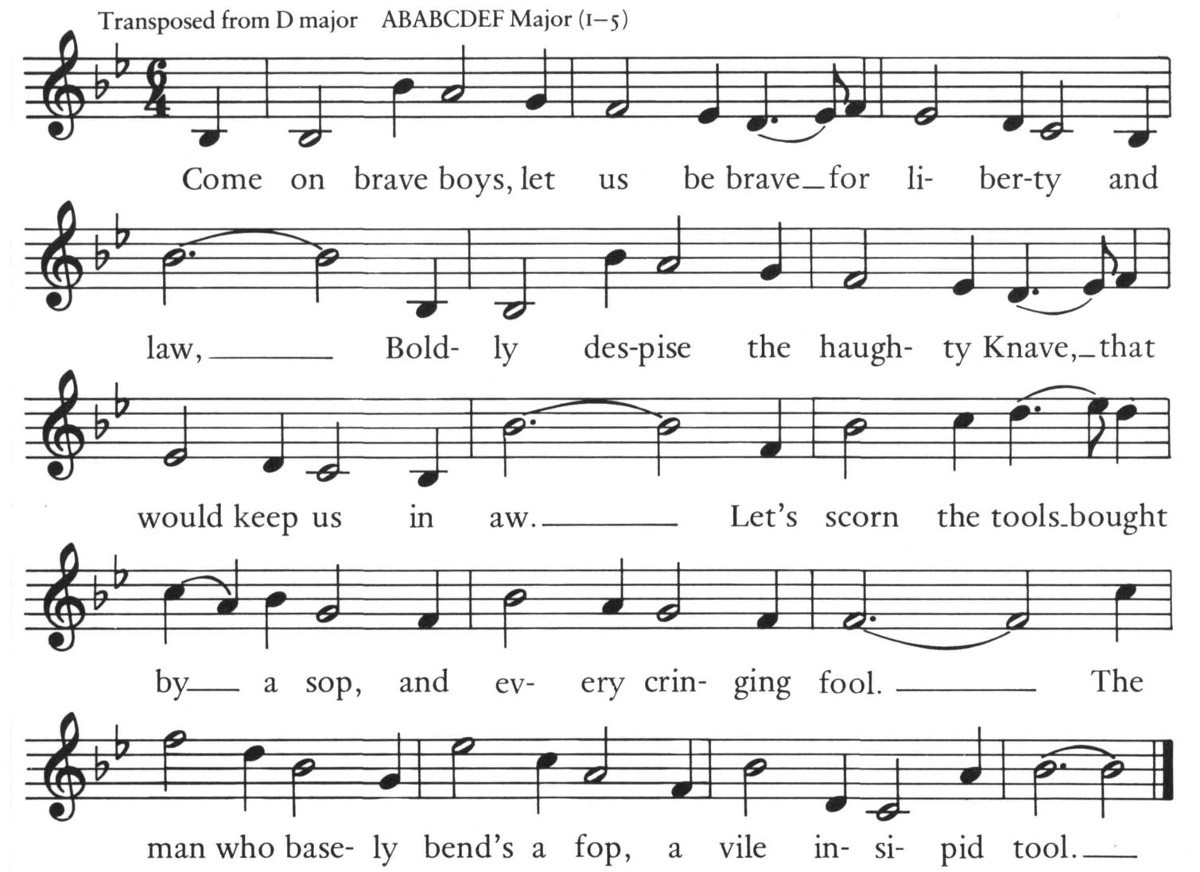
Fig. 163. A Song made upon the foregoing Occasion set to the tune “Now, now you Tories all shall stoop.”
“To all you ladies now at land,” also known as “Schackley hay,” is found in a variety of eighteenth-century sources including Pills (London, 1714), v, 168, as air no. 7 in Lacy Ryan’s The Cobler’s Opera (London, 1729), and as air no. 1 in act 3 of Coffey’s The Beggar’s Wedding (London, 1729), as well as in seventeenth-century sources. The author has adjusted air no. 45 from The Jovial Crew (1731) to fit the opening stanza of Zenger’s first song (fig. 162).81
“Now, now you Tories all shall stoop,” or “Hey boys up go we,” was printed in D’Urfey’s A New Collection of Songs and Poems (London, 1683), in Pills (London, 1719–1720), ii, 286, and in a number of ballad operas including Coffey’s The Devil to Pay (1731). The author has modified slightly the Coffey version in setting the verses of A Song made upon the foregoing Occasion (fig. 163).82
Successful military victories as we have seen were enthusiastically applauded and it might well have been expected that the euphoria following the conquest of Canada would last a number of years. The fiscal policies of Parliament in the 1760s, however, conflicted with practices which had grown up in the colonies for over a century. The French and Indian Wars had cost a great deal of money and many members of Parliament felt that since the North Americans were the immediate beneficiaries they should share the expenses. It turned out that these included not only the campaigns of Braddock, Amherst, and Wolfe but also the English Hanoverian victories of Quiberon Bay and Minden on the Continent. The provinces had paid for equipping their own militia. Nearly 30,000 young men had died. However, the prosperity of Massachusetts, Connecticut, New York, Pennsylvania, Virginia, and the Carolinas was evident to the English authorities, particularly since much of Britain’s trade was with the New World. In England the elder Pitt spoke out against British opportunism: “The profits to Great Britain from the trade of the colonies is two millions a year. This is the fund that carried you triumphantly through the last war. You owe this to America.”83
Despite the Great Commoner’s stand, there was a sufficiently large group in Parliament to push for colonial taxation. In March 1765 George Grenville’s Stamp Act was passed. Every business document in the colonies was declared illegal and void unless written on paper bearing the British government stamp. The cheapest stamp cost a shilling; for important documents one paid much more. For over a year the colonists had warned the English authorities that the taxation of each province was an internal matter. When the bales of stamped paper and the commissions for the new officers who were to sell the stamps arrived, demonstrations broke out in the seaport towns. The collectors were hanged in effigy and the provincial assemblies declared the Stamp Act illegal. So strong were the sentiments that Massachusetts invited the other provinces to a congress which met in New York in October 1765. The resolutions adopted were clear. The two most important ones were: “that it is inseparably essential to the freedom of a people, and the undoubted right of Englishmen, that no taxes be imposed on them but with their own consent, given personally or by their representatives”; and “that the only representatives of the people of these colonies are persons chosen therein by themselves, and that no taxes ever have been or can be constitutionally imposed on them but by their respective legislatures.”84
Soon afterwards associations called the Sons of Liberty were established up and down the eastern seaboard. Owing to their vociferous protests, the opposition to the new tax became almost universal and the majority of the stamp distributors resigned from office. For one of the earliest and most vehement protests see figures 83–84, in Arthur F. Schrader, “Songs to Cultivate the Sensations of Freedom.”
Reaction to the Stamp Act not only led to peaceful protests and satirical songs but also to riots, the burning of unpopular figures in effigy and the destruction of property. In a letter of August 29, 1765, from Newport, Rhode Island, William Almy wrote to Elisha Story in Boston about a number of individuals, among them Mr. Martin Howard, Jr., “who had made himself very busy with his Pen (by all accounts) writing Against the colonies and in Favour of the Stamp Act etc. In the Morning of the 27th Inst. between five and six a Mob Assembled and erected a Gallows near the Town House” on which there were effigies of Mr. Howard, the Stamp Man, and a Dr. Moffatt:
. . . Upon Mr. Howard’s Breast was wrote, that fawning, insidious, infamous miscreant and paracide martinus scriblerius etc. And upon one of the Posts of the Gallows was wrote, We have an Heriditary Indefeasible Right to a Halter, Besides we Encourag’d the Growth of Hemp you know. And Underneath that, was a New Song (made upon the Occasion) which I have here Inclos’d. . . . After the Effigy’s [sic] were Burnt the Mob Dispers’d and we thought it was all Over. But last Night about Dusk they all Muster’d again, and first they went to Martin Howard’s, and Broke Every Window in his house Frame and all, likewise Chairs, Tables, Pictures and every thing they coul’d come across. They also Saw’d down two Trees which stood before his door and Bro’t them and Stuck them up in two Great Guns which have been fix’d at the Bottom of the Parade some Years as Posts. When they found they had Entirely Demolish’d all his Furniture and done what damage they Coul’d, They left his house, and Proceeded to Doctor Moffatts where they Behav’d much in the Same manner.85
It is clear why Alexander Hamilton referred to the people as “a great beast.” It is probable that a printed broadside rather than a manuscript sheet of the new Stamp Act song beginning “He who for a post or base sordid pelf” was tacked to the gallows and copies distributed to the crowd. None has survived, but the text was published in the Boston Evening Post for September 2, 1765 (see Schrader, fig. 83). The “Tantara rara” refrain indicates that the New Song made upon the Occasion (of the August 27th demonstration) was to be sung to a version of the “Tantara rara tantivy” or “Hyde Park frolick” tune family. It was a staple of The Dancing Master and is found in all editions of Pills. The air used here (fig. 164) comes from Chappell.86
In January of 1766, William Pitt, who had been absent from Parliament when the Stamp Act was passed, spoke eloquently against it: “It is my opinion that this kingdom has no right to lay a tax upon the colonies. . . . The Colonists are the subjects of this kingdom, equally entitled with yourselves to all the natural rights of mankind, and the peculiar privileges of Englishmen, and equally bound by its laws. Taxation [of the colonies] is no part of the governing or legislative power [of Parliament].”87 Gen. Conway, one of the few who had voted against the act in Parliament, rose and supported Pitt. The ministry was won over. Witnesses, including Benjamin Franklin, familiar with the situation spoke out before the House and the Stamp Act was repealed in March 1766.
A fourteen-stanza broadside came out shortly afterwards entitled A New Song, On the Repeal of the Stamp-Act, Tune, A late worthy Old Lyon (fig. 165a). Grenville is the villain in the piece and Pitt the hero. The melody remained unidentified for many years but, thanks to the research of Arthur F. Schrader, it has at last been brought to light. Among the single sheet folios in the Julian Marshall Collection of eighteenth-century songs at Houghton Library, Harvard University, he discovered one published in Glasgow entitled Old Leo. A Favourite Song in Memory of the Glorious Year 1759 (fig. 165c). A New Song, On the Repeal of the Stamp-Act has been set to an American edition of the tune in the American Musical Miscellany (Northampton, 1798) where it is called “The hobbies” (fig. 165b).88
The victory of Wolfe at Quebec and Britain’s other successes in 1759 had inspired an unusually famous English song, “Heart of oak,” to words by David Garrick and music by the eminent composer William Boyce. The opening lines were characteristic of the enthusiasm of the day: “Come cheer up, my lads, ’tis to glory we steer, / To add something more to this wonderful year.”89 The refrain, “Heart of oak are our ships, heart of oak are our men,” gave the song its name and for a few years the North American colonists sang it as loudly as anyone. However, when strong feeling for the Mother Country had cooled it was natural for new words to be put to the tune.
A set of verses which came to be known as The Liberty Song was put together early in 1768 by John Dickinson of Pennsylvania, who had previously written against the Stamp Act. He established a connection with Massachusetts when he wrote James Otis on July 4th: “I inclose [sic] you a song for American freedom. I have long since renounced poetry, But as indifferent songs are very powerful on certain occasions, I venture to invoke the deserted muses. . . . My worthy friend, Dr. Arthur Lee, a gentleman of distinguished family, abilities, and patriotism in Virginia, composed eight lines of it. . . .”90 The first broadside of The Liberty Song was printed in Philadelphia by Hall and Sellers. Shortly thereafter A New Song[.] To the Tune of “Hearts of Oak, &c.” (fig. 166) appeared.91 On July 18, 1768, the Boston Gazette reprinted the words (see Schrader, fig. 79).
The first broadside with music has disappeared but an advertisement in the Boston Chronicle for August 29, 1768, verifies its appearance (fig. 167). A New Song, otherwise known as The Liberty Song, became the official song of the Sons of Liberty, expressing well their views. Mein and Fleeming published the words under the tune in Bickerstaff’s Boston Almanack for 1769, preserving the version of The Liberty Song as sung by patriots prior to the Revolution.92
Not long afterwards a Tory parody appeared with the opening lines: “Come shake your dull Noddles, ye Pumpkins, and bawl” (see Schrader, fig. 81). The Sons of Liberty could not let this slip by without response so The Parody Parodized; or The Massachusetts Song of Liberty, by Dr. Benjamin Church, the famous double agent, was published as a broadside or handbill. Unfortunately it has not survived but the text was included in the Boston Gazette for October 3, 1768 (see Schrader, fig. 82), and the “Heart of oak” tune with this second set of words appeared in Bickerstaff’s Boston Almanack for 1770 (fig. 168).93 The opening line was amusingly derisive while the final verse summed up the attitude of the colonists.
The leading student of American Revolutionary ballads during the last century, Frank Moore, greatly admired Dr. Church’s parody although he was unaware of his spying activities for the British. He wrote: “This loyal song is much the best of those composed during the earliest struggles of the Colonists, and is forcibly illustrative of the nature and spirit of the times in which it was written.”94
The British Crown failed to realize that reform rather than force was the only hope for a political and economic settlement of the argument. Although the Stamp Act was repealed, the Townshend Acts of 1767 provided for British revenue through customs levied on glass, lead, paper, and tea. The atmosphere was charged. To cap the climax the ministry decided to quarter British troops in Boston. This so raised the ire of the citizens that the ninety-two members of the Massachusetts House of Representatives called a general assembly or convention against the governor’s order and debated the question for nine days. The chief object of “the ninety-two” was to preserve the civil rights and privileges of the province and they refused to rescind a circular letter they had sent to the other colonies protesting the Townshend Acts. During August 1768 a ballad appeared in praise of their defiance: A New Song, address’d to the Sons of Liberty. . . . Tune “Come jolly Bacchus &c.” or “Glorious first of August” (fig. 169). At the bottom of the page are the words “a son of liberty.”
Fig. 168. Broadside song text by the double agent Benjamin Church set to the tune “Hearts of oak,” from Bickerstaff’s Boston Almanack (1770).
The legislators were commemorated in silver as well as song. The renowned silversmith Paul Revere made a silver drinking bowl in July 1768 (fig. 170) on which he placed the inscription
To the Memory of the glorious ninety-two: Members of the Honbl House of Representatives of the Massachusetts Bay who, undaunted by the insolent Menaces of Villains in Power from a strict Regard to Conscience and the liberties of their Constituents, on the 30th of June 1768 Voted NOT TO RESCIND
Fig. 169. Anonymous broadside song, Boston, 1768. The Ninety-Two refused to rescind the Massachusetts circular letter.
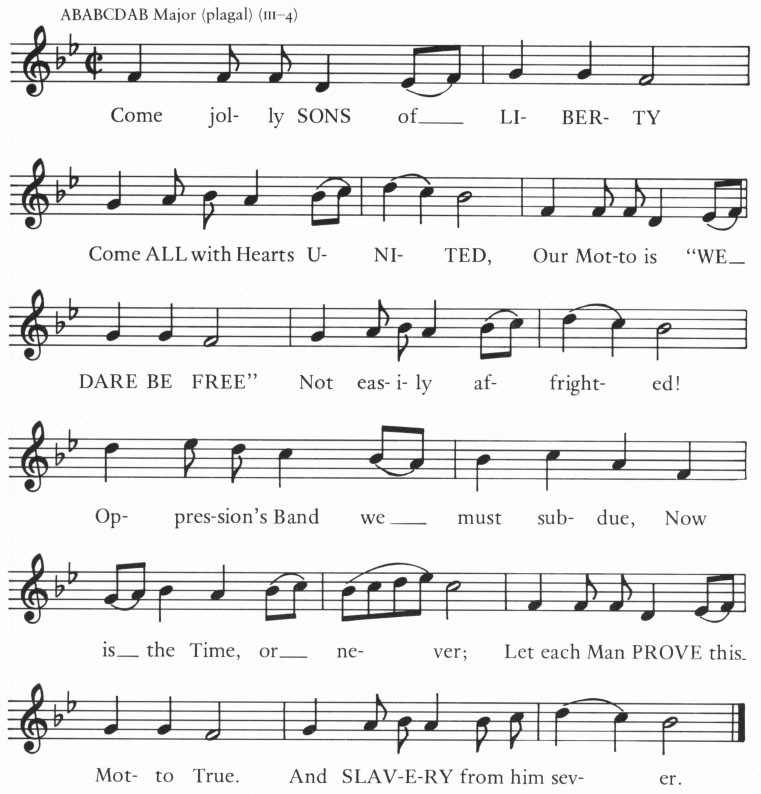
Fig. 171. A New Song, Address’d to the Sons of Liberty set to the tune “Come jolly Bacchus.”
On the opposite side is a circle with a scroll and foliated frame topped by a Liberty Cap flanked by flags inscribed respectively “Magna / Charta” and “Bill of / Rights.” Inside the circle is inscribed: “No. 45. / Wilkes & Liberty” over a torn page labeled “Generall / Warrants.” Revere also engraved the names of fifteen of the principal legislators below the rim of the bowl, which has been called the United States’ third most cherished historical treasure, preceded only by the Declaration of Independence and the Constitution.
“Come jolly Bacchus” or “Glorious first of August,”95 also known as “Glorious Charles of Sweden” because Charles XII was greatly admired as a brilliant general, was a favorite during the eighteenth century for political and military songs. The version of the melody “Come jolly Bacchus” used here (fig. 171) is adapted from Coffey’s The Beggar’s Wedding (1729).
Early in 1770 Dr. Joseph Warren, the revolutionary patriot who on April 18, 1775, was to dispatch Paul Revere on his famous ride, wrote The New Massachusetts Liberty Song, To the Tune of the British Grenadier (fig. 172; see Schrader, figs. 91–93).96 Josiah Flagg, known for his tune book of 1764 engraved by Revere and popular for having organized a militia band several years previously, gave one of the first performances of this song at Boston’s Concert Hall on February 13, 1770. The vocal parts were “performed by four voices” with the audience en masse undoubtedly reinforcing the chorus accompanied by a band of instruments. This practice was probably more common in the eighteenth century than it is today. “British grenadiers” derives from “All those that love good fellows” and must have attained its present form sometime in the 1740s for there is a stanza from that decade reading:
But of all the world’s brave heroes
There’s none that can compare
With the Noble Duke of Cumberland
And the British Grenadier.97
The version of the famous tune to which Joseph Warren’s New Massachusetts Liberty Song is set (fig. 173) was written in a mid-eighteenth-century hand and bound with other tunes in the back of Thomas Walter’s The Grounds and Rules of Musick (Boston, 1760), beginning on page 62.98 The tune has been adjusted slightly to fit the words of the text.
The presence of troops in a town inevitably presents problems and Boston was no exception. Matters came to a head in March 1770. By prearrangement a group of ropemakers from the wharves met a party of soldiers to settle their differences by an encounter of clubs. Men on both sides were badly beaten and mutual feelings were not improved.
Two nights later, on the evening of March 5th, a riot broke out when two men refused to answer a sentinel’s challenge. As a mob gathered a few members of the 29th Regiment were called out and they faced the crowd with fixed bayonets. Cries of “Damn you, you sons of bitches, fire” and “Damn you, you dare not fire”99 filled the night air. Then one of the soldiers was hit severely on the head. This was too much for military patience and the guardsmen fired. During the next few minutes three civilians were killed outright and two more died later.
Fig. 175. A Verse Occasioned by the late horrid Massacre matched and fitted to the tune “Christ in the garden.”
Samuel Adams and others fanned the flames; the unfortunate affair came to be called the Boston Massacre, a rather pretentious title for the death of five people. The rabble rousers were for lynching the soldiers during the next few months, but, owing to the courageous and extremely unpopular defense of the accused by John Adams and Josiah Quincy who convinced the jurors that the troops had acted primarily in self-defense, all but two were acquitted. These two, although convicted of manslaughter, were punished only to the extent of having their hands branded. Soon after this incident the troops were withdrawn.
Ballad writers meanwhile screamed for vengeance and Paul Revere made a woodcut of the event. Two of the broadsides were illustrated with five coffins at the top; emotional indignation was at a high pitch. The first broadside, A Verse Occasioned by the late horrid Massacre in King-Street (fig. 174), has a folk flavor.
The tune “Christ in the garden” (fig. 175), which the author has matched and fitted to the verse, belongs to a group which began to be used as a setting for religious music about 1800. Its secular usage is suspected to be considerably older. The air was published in 1842 in Revival Hymns, collected by H. W. Day (Boston). Its reassignment to a secular narrative text is more in keeping with its origins.
The second ballad, On the Death of Five young Men (fig. 176), is melodramatic and lurid in its imagery, and was intended to arouse the emotions of the citizenry. The author’s concern with “eternal night” which closed the eyes of five “breathless bodies” suggests, as in several earlier ballads, an air from the “Death and the lady” tune family. “Oh, have you heard,” noted down at Pembridge, Herefordshire, in 1905 has been selected (fig. 177). It must be remembered that tunes which flourished in the English-speaking world during the eighteenth century are preserved not only in this country but also in Great Britain and that both belong to our cultural heritage.
An accidental death also occurred in March 1770. Christopher Seider, a boy of eleven, was killed by an unpopular customs officer, Ebenezer Richardson, who fired a random shot into a crowd that tried to prevent him from removing a wooden statue which some citizens had set up in front of a shop. Referred to as “an informer and tool to ministerial hirelings” because his duty required him to report smugglers, Richardson was convicted of murder by a jury that was anything but impartial. Because Governor Hutchinson felt that the charge should have been manslaughter rather than murder, and that the customs officer should not hang, Richardson spent several years in prison. Finally he was granted a release or “enlargement” pending a royal pardon. This angered the extremists.
The broadside describing the affair was called A Monumental Inscription (fig. 178). It was decorated in the upper left-hand corner with a reduced version of Paul Revere’s familiar engraving of the Boston Massacre and below it was printed a prose summation of the March 5th tragedy and Richardson’s story. The poet was extremely eager to see his villain hanged.
The air “Union hymn” (fig. 179) has been matched and fitted to A Monumental Inscription. The folklorist Anne Gilchrist noted: “It derives from the class of ballad-tunes to which ‘execution-songs’ and ‘farewells’ used to be sung through the streets . . . [and] it recalls ‘Fortune, my foe’.”100
A “moral fakement” or confession purporting to come from the “murderer” with penitent stanzas in long meter appeared in still another broadside connected with Richardson. The woodcut shows a group of people demonstrating in a town square and below it the title, The Life, And Humble Confession, Of Richardson, The Informer (fig. 180).
Because “Confesse”101 (no. 19 in The English Dancing Master [London, 1651, and in subsequent editions]) suits the imaginary confession of the customs officer, it has been chosen as the setting for the broadside. The author has adjusted it to fit the ballad (fig. 181).
Although most of the Townshend Acts were repealed in 1770, partly owing to the pamphleteering of John Dickinson, the one on tea was kept. This was largely because Parliament could not admit that it did not have the right to tax the colonies and also because the East India Company was in financial straits. The issue came to a head in 1773 when, with seventeen million pounds of tea in warehouses, the company pleaded to be allowed to sell its tea in America free of duty while it paid the Exchequer sixpence a pound, the amount prescribed by the authorities. Lord North, however, said that a principle was involved. The company reluctantly acceded, although skeptical that the law could be enforced. Immediate resistance arose. The Sons of Liberty made certain that consignees of tea did not accept shipments, or, if vessels managed to land chests, that they were kept in storehouses and not sold.
The famous Boston Tea Party came about when three ships carrying the precious leaves sailed into the Charles River late in November and early December 1773 but were not allowed by the citizens to unload. Governor Hutchinson thereupon refused to give the vessels passes enabling them to sail out of the harbor and return to London. A citizens’ meeting was held at the Old South Church. Instead of the hoped-for word from the governor stating that he had reconsidered his decision, the messenger brought his refusal. The crowd led by Samuel Adams, Paul Revere, and others headed for Griffin’s wharf. Meanwhile, a group of young men, disguised as Indians with their faces blackened so as not to be recognized, boarded the ships, split open the chests, and poured the tea into the harbor. Although the task took most of the night it was carried out efficiently without cheering or demonstrations from the watching crowd.
Here was another chance for balladry. Soon after the event a “Song of the Tea Party” was sung at the Green Dragon, the well-known meeting place for the Sons of Liberty. It began, “Rally Mohawks! bring out your axes. . . .”102 Another song with an attractive cut of a sailing vessel at the top was Tea Destroyed By Indians. Although probably sung to a well-known decasyllabic tune of the day, it has so far escaped identification. One of the favorites, published both in the Virginia Gazette for January 20, 1774, and as a broadside in Connecticut, A New Song To the plaintive Tune of Hosier’s Ghost, is the first poem on a broadsheet entitled Four Excellent Songs (fig. 182).103 (For an alternate text from the Massachusetts Spy of January 27, 1774, see Schrader, fig. 94.)
As mentioned above, “Hosier’s ghost”104 was a mid-eighteenth-century name for the melody first known as “What is greater joy or pleasure” linked to the ballad about the noted pirate Captain Teach or Blackbeard, a figure responsible for one of Benjamin Franklin’s earliest poetical efforts. Likewise, it was pointed out that by the 1730s one of its names was “Welcome, welcome, brother debtor” which derided the lot of prisoners in British jails. Furthermore the air has a particular interest for Americans since it was played by a British band at Yorktown the evening before the articles of capitulation were signed. The anonymous author of the Tea Party text obviously felt that the “plaintive tune” of “Hosier’s ghost,” long connected with the sea and satire, was appropriate for describing the fate of the three ships lying in Boston harbor. The tune given (fig. 183) is from The Muses Delight (Liverpool, 1754) with a bass “set by Mr. Handel.”
An even more famous tune also inspired new verses at this time: “An American Parody on the old Song of ‘Rule Britannia.’” Not known as a broadside, it was published in the newspapers and as might have been expected met with success (fig. 184).105 The author was by no means an advocate of breaking with Britannia but he insisted that the colonists had a right to decide their own destinies.
“Rule Britannia”106 was composed by Thomas Augustus Arne for the masque Alfred, and first performed at the residence of Frederick, Prince of Wales, on August 1, 1740. It became popular in 1745 during the Jacobite uprising. The next year Handel quoted the following phrase from the tune in his Occasional Overture which celebrated the victory of the Hanoverian monarchy:

Two stanzas of An American Parody are placed under an 1803 edition of the tune by P. Weldon (fig. 185). The tune had long been known in the colonies through such collections as Clio and Euterpe (London, 1758–1762). The Weldon edition has been selected because it shows the shortened form of the tune, probably more often sung in public than the original version. The longer form can be seen in an earlier American printing of “Rule Britannia” which bears the imprint “Printed and sold at B. Carr’s Musical Repository, Philadelphia, J. Carr’s, Baltimore, and J. Hewitt’s, New York, 1797–1799.”
Fig. 182. Broadside with four anonymous ballads, the first on the subject of the Boston Tea Party, ca. 1775.
Fig. 187. The Poor Man’s Advice set to the tune “Chevy Chase,” also known as “I’ll never love thee more.”
From the evidence presented it is clear that the provincials sang both ancient and modern tunes. They enjoyed the new stirring military airs of the eighteenth century, while at the same time the old melodies survived with extraordinary vitality. The reader will remember the 1745 broadside New England Bravery which called for the famous border ballad tune “Chevy Chase.”
Another set of words to the old ballad air was The Poor Man’s Advice . . . To the Tune of Chevy-Chace (fig. 186). This extended plea of eighty-two verses called for the colonists not to break with Britain. Too long to be printed as a broadside, it was issued in chapbook form and filled nineteen pages. Written by a Tory, it accused the colonial Congress of misleading the poor, and attacked both the well-to-do and the politicians in power.
Ah! have you read, my neighbors dear,
Our famous Congress Book?
Alas! I grievously do fear
They have our case mistook. (st. 1)
What pity ’tis, such worthy men
Who’ve larnt to read, and write,
And cast accounts; should use their pen,
For to undo us quite. (st. 2)
They’ve all laid in great stock of things,
To last them many a year,
For they’re as rich as any Kings,
But what shall poor folks wear? (st. 34)
A version of “Chevy Chase” from Bronson’s group d has been selected for the setting (fig. 187). In England the melody often went by the name of “I’ll never love thee more” and is so designated in John Gamble’s manuscript “Commonplace Book” of 1659 at the New York Public Library, and in The Dancing Master from the sixth edition (1679) on. However, William McGibbons’ Collection of Scots Tunes (Edinburgh, 1742–1755), page 108, and James Johnson’s The Scots Musical Museum, 6 volumes (Edinburgh, 1787–1803), v, 464, call the air “Chevy-Chase.” It is obviously a variant of that famous melody.107
Another traditional air, “Derry down” or “King John and the abbot,” was set to A New Song, For the Sons of Liberty. To the Tune of King John, and the Abbot of Canterbury (1776) (fig. 188).108 Originating in New York, the text was concerned with that province’s situation when, in 1774, a Committee for the City was formed to work with the Sons of Liberty in the other colonies, particularly that of Massachusetts. There were two patriot groups in New York, one calling itself The Sons of Liberty and the other the Friends of Liberty and Trade. The latter included merchants who did not wish to break entirely with Britain and some Tories sympathetic with this point of view. Some individuals outside those two groups were more authoritarian in outlook and were critical of both. They believed that differences could be settled only be decree or compulsory arbitration. The author of A New Song For the Sons of Liberty held to the latter for he ends the first stanza:
But the total defeat of those heroes I sing,
That would fix a Republick, in lieu of a K——
Derry down, down, hey derry down.
The final stanza, however, indicates that he felt some changes were necessary:
May the city [New York] I dote on, still find out the way
To avoid all those men who would lead her astray:
While the future she eyes, retrospecting the past;
Then peace and our rights will be stablish’d at last.
Derry down, down, hey derry down.
A New Song, For the Sons of Liberty is set to the tune “King John and the Abbot of Canterbury” (fig. 189), alias “Derry down,” alias “A cobler [sic] there was,” found in both Bronson and Chappell. The tune, under one of these names, was frequently mentioned in the colonies as proper for new texts.109
iv ancient and popular ballads
The traditional or “ancient” ballad has been the concern of reflective people since Elizabethan times. Sir Philip Sidney, Samuel Pepys, Joseph Addison, Bishop Percy, Sir Walter Scott, William Chappell, Francis J. Child, and a galaxy of twentieth-century folklorists, as we have seen, have written about the subject. This study has already referred to the use of “Chevy Chase” tunes for topical broadside ballads and we should now discuss the Chevy Chase text as found on early American broadsides.110
The story that unfolds in A memorable song upon the unhappy hunting in Chevy Chase or The Hunting of the Cheviot, Child ballad no. 162, a border ballad theme, has been as popular here as in England and Scotland, and Tristram B. Coffin, Arthur Kyle Davis, Phillips Barry, Claude Simpson, and Robert S. Thomson, among others, have written about its wide dissemination.111 The feuding element may have had a particular attraction for people constantly on the alert for Indian raids, battles with the French on the northern and western frontiers, or confrontations along the southern border with the Spaniards, but it also had a universal appeal. Addison referred to Chevy Chase as “the favourite Ballad of the common People of England.” He was also one of the first modern men of letters to point out the merit of traditional ballads. Although his words are known to many, they deserve to be quoted again: “An ordinary Song, or Ballad, that is the Delight of the common People, cannot fail to please all such Readers as are not unqualified for the Entertainment by their Affectation or Ignorance; and the Reason is plain, because the same Paintings of Nature which recommend it to the most ordinary Reader, will appear beautiful to the most refined.”112
The earliest colonial printings of the Chevy Chase ballad with traditional words have not survived, but there are a number from the later eighteenth century both in chapbook and in broadside form. One of the former, consisting of eight pages, is entitled The Hunting Of Chevy-Chace. The second page, containing eight of the traditional sixty-two stanzas, begins the ballad with the famous
God prosper long our noble King,
Our lives and safeties all,
A woeful hunting once there did
In Chevy-Chace befal. (st. 1)
Two additional verses, however, can be found towards the end of a broadside printing of the ballad (n.d.) (fig. 190).
The tune selected for the traditional words has been traced to the seventeenth century and is number 3 of group a in Bronson’s classification (fig. 191). His source was a manuscript at the University of Edinburgh dating from the time of Charles II, and most scholars believe that the earliest form of the tune is of Scottish origin. While lacking the beauty of some ancient melodies, this air has a narrative quality that neither folk singers nor their listeners ever forget. It is known to many as the nursery song “When good Arthur ruled this land.”
Two traditional broadside ballads which were sung to tunes associated with “Chevy Chase” have been published many times: The Grecian Daughter and Fair Rosamond. The story of the first, known to Boccaccio, derives from a tale of the Roman writer Valerius Maximus. The dramatic legend, also known as Roman Charity, describes the incarceration of Myco, a Greek nobleman (Cimon in the Latin version) whose loving daughter Pero (Piro) made daily visits to the prison and “fed her father with her own milk—he being sentenced to be starved to death by Tiberius Caesar.” Following the Renaissance the Roman author was translated into a number of European languages including English and the story was widely disseminated. Sculptors and painters were inspired by the tale and, as early as 1596, a broadside entitled The Grecian Daughter was licensed in London by the Company of Stationers. The moving account of Pero’s filial devotion was celebrated in song for several hundred years and a number of American broadsides were issued. One from a press in Windsor, Vermont, has the most remarkable cut published in this country prior to 1800: The Grecian Daughter . . . Printed for the Flying Book-Sellers (Alden Spooner, ca. 1798) (fig. 192a).113
The engraver has not been established but, whoever he was, he must have seen the John Smith (1654–1742) print Roman Charity after Peter Paul Rubens’ painting Cimon and Piro.114 The Windsor design drawn in white line on type metal possesses an archaic folk flavor which could never be mistaken for the Flemish master or the English engraver. The Vermont Grecian Daughter is an original work; the American artist was not simply making a copy. He placed a round window in the middle of the cell, lacking in the European cuts; his column is square, not round; the chain attached to the unfortunate prisoner is several times the size of those depicted by his predecessors; and the floor consists of white and black squares, not earth with straw upon it. Finally, on the border of the black tile, in front of the entrance door to the cell, again a new feature, one can just distinguish the letters RES, perhaps an abbreviation by the New England artist indicating the source of his inspiration: R(ubens) E(xcudit) S(mith).115
Another illustrated broadside of The Grecian Daughter, printed by Nathaniel Coverly, Jr., of Boston (1796–1801), has the same text, also engraved on type metal, and is nearly as dramatic (fig. 192b). Although not so moving as the more primitive Windsor imprint, it is a striking rendition of the scene and both deserve further study by art historians.
Fig. 192c. The Grecian Daughter set to a folk version of the tune “Flying fame,” an earlier name for “Chevy Chase.”
At the Houghton Library, Harvard University, there is yet another edition of The Grecian Daughter with the following printed at the bottom of the broadside: “Printed for Ezra White, Ballad-Pedler, who keeps a general assortment of ballads constantly on hand, and intends selling them cheaper than they can be had of any other person in the State.” That a vendor found it worthwhile to call attention to his stock and terms at the bottom of his Grecian Daughter broadside attests to the popularity of the ballad.
The proof of the tune association comes from early English broadsides. In the Roxburghe Collection there is one entitled A worthy example of a Vertuous / Wife who fed her Father with her own milk, [he] / being condemned to be famished to death, and after- / wards pardoned by the Emperor. To the Tune Of, (When) FLYING FAME. London, Printed for E[dward] W[right] (n.d.).116 “Flying fame” was also named on many seventeenth-century editions of the Chevy Chase ballad; however, no seventeenth-century notation of the tune entitled “Flying fame” has been discovered. The tune probably survived under the name “Chevy Chase,” owing to the great popularity of the ballad. The version of the tune to which The Grecian Daughter has been set (fig. 192c) belongs to group b in Bronson’s “Chevy Chase” classification. The text was written down in 1914 and the tune notated in 1931. The melody is barred in  time as Bronson suggested instead of the
time as Bronson suggested instead of the  time of an earlier editor.
time of an earlier editor.
The second ballad concerns the old story told by Thomas Deloney in 1607, originally entitled A mourneful Ditty on the Death of Fair Rosamond, King Henry the Second’s Concubine. To the tune of When Flying Fame. The earliest American edition is an eight-page chapbook with a woodcut on the title page showing a woman kneeling before an approaching figure. A large section of the top has been torn off but it seems to read: Fai[r Rosamond] / GA[RLAND] / Who wa[s King Henry] / the Seco[nd’s Concubine] / and put [to death] by / Queen E[linor i]n the / Bower of Woodstock, / near Oxford. The imprint is “Newport: Printed and Sold by the Widow Franklin, at the Town School House 1746” (fig. 193).117 Fortunately only the second and last stanzas, or sixteen lines, are missing. A later edition in broadside form and lacking a woodcut reads simply Fair Rosamond. A Lamentable Ditty (n.p., n.d.) (fig. 194). One hundred seventy-six lines are printed on the broadside.
Fair Rosamond has been set to a “Chevy Chase” tune found in Robert Bremner’s Second Set of Scots Songs (London, 1757) (fig. 195).
Fig. 195. Fair Rosamond set to a version of the tune “Chevy Chase” related to “I’ll never love thee more.”
Franklin, Jefferson, and many colonial Americans were fascinated by Scottish folksongs and owned collections of them, and Francis Hopkinson knew and corresponded with Robert Bremner.118 It will be observed that the melody is similar to the tune family which Bronson calls group d and which is definitely related to the old air “I’ll never love thee more.” A distinctly Scottish flavor in Bremner’s rhythmic pattern is noticeable.
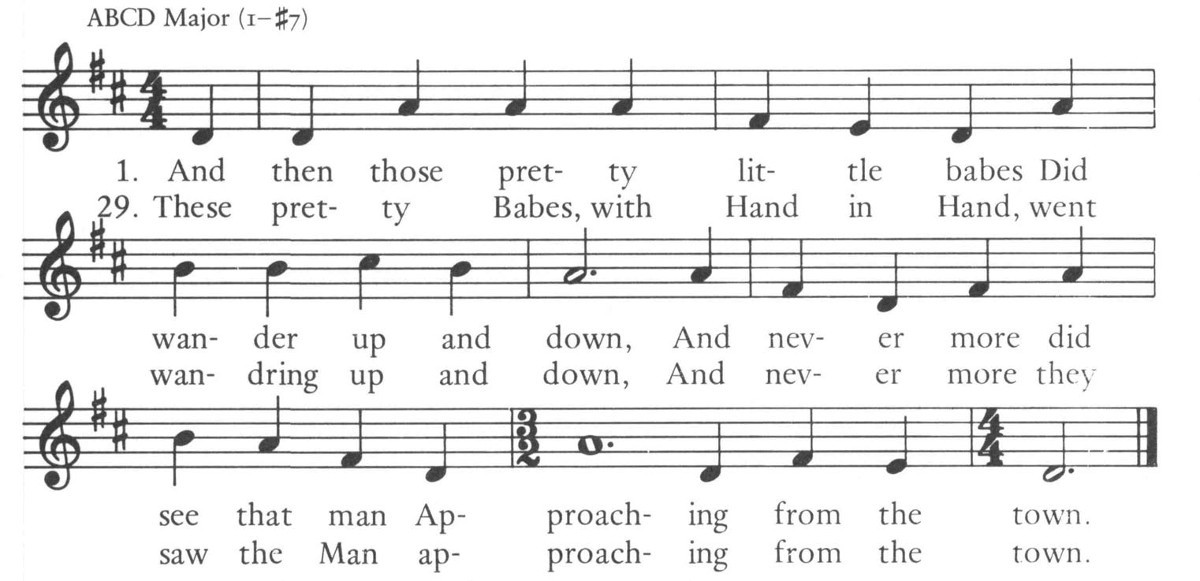
Fig. 198. “The babes in the wood,” a Virginia folk song, with its first verse above stanza 29 from Children in the Woods (a comparison setting).
Equally popular in New England was The Children in the Woods which Benjamin Franklin mentioned in his letter of 1765 quoted earlier, along with Chevy Chase and The Spanish Lady. This mournful ballad with its plaintive tune also known as “Rogero” and “Now ponder well” was entered in the London Stationers’ Register as early as 1595. It has been a favorite for several centuries and is found on a dozen broadsides before 1800. That reproduced here, an undated Salem imprint, has a woodcut in the upper left-hand corner with two gentlemen crossing swords and two children watching under a tree (fig. 196).119
In an issue of The Spectator, Joseph Addison spoke of walls decorated with ballad broadsides and added:
The last Piece that I met with upon this Occasion, gave me a most exquisite Pleasure. My Reader will think I am not serious, when I acquaint him that the Piece I am going to speak of was the old Ballad of the “Two Children in the Wood” which is one of the Darling Songs of the Common People and has been the Delight of most Englishmen in some Part of their Age.
The Song is a plain simple Copy of Nature, destitute of all the Helps and Ornaments of Art. The Tale of it is a pretty Tragical Story, and pleases for no other Reason but because it is a Copy of Nature. There is even a despicable Simplicity in the Verse; and yet, because the Sentiments appear genuine and unaffected they are able to move the Mind of the most polite Reader with inward Meltings of Humanity and Compassion. The Incidents grow out of the Subject, and are such as are the most proper to excite Pity; for which Reason the whole Narration has something in it very moving, notwithstanding the Author (whoever he was) has delivered it in such an abject Phrase and poorness of Expression, that the quoting any part of it would look like a Design of turning it into Ridicule. But, though the Language is mean, the Thoughts as I have before said, from one end to the other are natural.120
Fig. 201. The Gypsie Laddy, Elisha Bostwick’s version of a traditional ballad, ca. 1775, set to a Tennessee folk tune of the same name.
The famous essayist did not state that the total effect could be realized only when the ballad was sung, but he must have been aware of the fact. Two early melodies, “Now ponder well” and “In peascod time,” were associated with The Children in the Woods.121 The former which received its title from the first line of the ballad was more often used. The latter is also associated with the Chevy Chase ballad. “Now ponder well,” found in over a dozen ballad operas, was air no. 12 in The Beggar’s Opera (London, 1728) and air no. 35 in the comic opera version of The Jovial Crew (London, 1731). Following this tradition, The Children in the Woods has been set to The Beggar’s Opera variant (fig. 197).
Cecil Sharp recorded a quite different tune in the southern Appalachians which shows the inventiveness of folk singers and the way that ballads acquire different melodies. It too, known as “The babes in the wood,” is given here (fig. 198) with words taken down by Sharp and the comparable stanza from the broadside.
Like Fair Rosamond, The Spanish Lady goes back to Thomas Deloney who published its verses in his collection of Garland of Good Will (London, 1631). The Spanish Lady broadside, however, was entered in the London Stationers’ Register as early as 1603 and went through many editions during the next two centuries.
The tune is found in several ballad operas including The Jovial Crew (1731), where it appears as air no. 34, “Did you not hear of a Spanish lady etc.?” At the end of the libretto to Thomas Hall’s The Spanish Lady. A Musical Entertainment in two acts; Founded on the Flan of the Old Ballad (London, 1765), one finds the unusual appearance of the full song text on which the ballad opera is based. A Spanish Lady’s Love for an English Gentleman (fig. 199) was known to Bishop Percy through an ancient black-letter copy “corrected in part by the editor’s folio ms” and was included in his Reliques of Ancient English Poetry (London, 1765),122 a classic source for balladry. It is a happy coincidence that Benjamin Franklin spoke in his aforementioned letter of the same year, saying that The Spanish Lady was commonly sung in Massachusetts. Its fame spread through oral tradition and ballad sheets carried about by hawkers and pedlars. Perhaps its popularity was due to its unusual rhythm and the haunting quality of the melody. The melody used here (fig. 200) is air no. 34 from The Jovial Crew (1731).123
Besides Chevy Chase (Child ballad no. 162), the texts of a number of the traditional ballads such as The Baffled Knight (Child ballad no. 112), The Bailiff’s Daughter of Islington (Child ballad no. 105), Lord Thomas and Fair Annet (Child ballad no. 73), and Derry Down or King John and the Bishop (Child ballad no. 45) circulated in both broadsides and in oral tradition. The extraordinary popularity today of Bonnie Barbara Allen (Child ballad no. 84), as Coffin pointed out, is “due to its inclusion in ten or more early nineteenth-century songsters and on innumerable broadsides.”124
One is always grateful for eighteenth-century quotations about balladry. Occasionally one runs across a description of actual ballad singing. From the evidence available it seems clear that while marching, soldiers sang such martial songs as Lovewell’s Fight to the tune “All you that love good fellows,” The Death of Wolfe to a haunting folk melody by the same name, and A New Thanksgiving Song to the “Granadee’s march.” It is particularly interesting, however, to read of soldiers singing traditional as well as patriotic verses. An account by an American revolutionary veteran, Elisha Bostwick of New Milford, Connecticut, relates a story in connection with The Gypsy Laddie (Child ballad no. 200). It will be remembered that the Gypsy lures or persuades a lady to leave her “true wedded Lord,” continually asking if she really is willing to give up everything including her children for him. The Connecticut soldier who served under Washington describes his experience thus:
. . . while on our March with the prisoners a part of whom while under my immediate care were Spreading their blankets upon the floor for the nights lodging [when] I saw a woman or two with them. I enquired into it & was told that it was sometimes allow’d a Sergt. to have his wife with him who drew rations the Same as a Soldier[,] were very Serviceable and Supported virtuous characters & about Midnight when all was Still one of the Prisoners arose up & Sung what he Call’d the Gypsie laddy, Some of the lines I always retain’d in memory among which were these.
Will you leave your houses, will you leave your lands,
And will you leave your little children a-a-h[?]
Will you leave your true wedded Lord
& lying with a Gypisa Lady a-a-h
Will you leave your true wedded Lord
& lying with a Gypsie Lady a-a-h
Yes I will leave my houses[,] I will leave my lands
And I will leave my little children a-a-h
I will leave for you my true wedded Lord
& lying with a Gypsie Lady a-a-h
I will leave for you my true wedded Lord
& lying with a Gupsie Lady a-a-h
Last night I slept on a Silken bed of down
Alongside my lawful & true wedded Lord
But now I sleep in an ashy corner
happy with my Gypsie Laddy a-a-h
But now I sleep in an ashy corner
happy with my Gypsie Laddy a-a-h
And then lay down again. The tune was of a Plaintive Cast & I always retain’d it & Sung it to my Children but that must die with me.125
Bostwick could not have known that this ballad would live on to become one of the most popular folk songs of the twentieth century. Figure 201 is an adaptation of the folk tune called “Gypsy laddie,” notated in Tennessee in 1916 by Cecil Sharp. The text Bostwick recorded has been substituted for that recorded by Sharp.
Another favorite ballad which went through a number of broadside editions in the eighteenth century belongs in the religious and moralist category. It also generated a number of doleful woodcuts, some of which may have been copied from seventeenth-century originals. Death and the Lady, a ballad whose origins must be sought in the traditional Dance of Death, appealed to religious New Englanders who knew that “the great Messenger of Mortality,” a severe critic of mankind’s vanity, would appear to all sooner or later.
Anne Gilchrist observed that Death and the Lady “was especially popular in the eighteenth [century], and esteemed by both gentle and simple. It is mentioned by Goldsmith in The Vicar of Wakefield as one of Farmer William’s songs.”126 Still earlier Francis Quarles, a specialist in religious dialogues concerning death, who sent versions of the psalms to John Winthrop and John Cotton, had inspired Michael Wigglesworth, the author of the Day of Doom (1662) and Meat out of the Eater; or Meditations Concerning the Necessity, End, and Usefulness of Afflictions Unto God’s Children (1669). In short there was an eager public for this broadside. The edition selected which depicts a lady in seventeenth-century costume accosted by a skeletal man with an arrow in his hand is entitled A Dialogue Between Death and a Lady (n.d.) (fig. 202).127
Although the American imprints do not suggest a tune, the Roxburghe Ballads edited by J. Woodfall Ebsworth (Hertford, [England], 1893), specifies “Farewell my heart’s delight.”128 No melody by this title is known, but a William Byrd setting of “Fortune my foe” has a second title, “Farewell delighte.”129 The “Fortune” tune to which the voice of Death is matched (fig. 203) fits the decasyllabic quatrains of Death and the Lady admirably and probably was the original melody. There is a second melodic tradition associated with the seventeenth-century ballad tune known as “Death and the lady.” It was revived in Lacy Ryan’s The Cobler’s Opera (Dublin, 1729) and used in James Ralph’s The Fashionable Lady (London, 1730). The second melody has been assigned to the Lady’s dialogue with Death (fig. 204). Both airs are eminently suitable for the ninety-six-line colloquy.130
Fig. 203. The voice of Death from A Dialogue between Death and a Lady matched to the tune “Fortune my foe.”
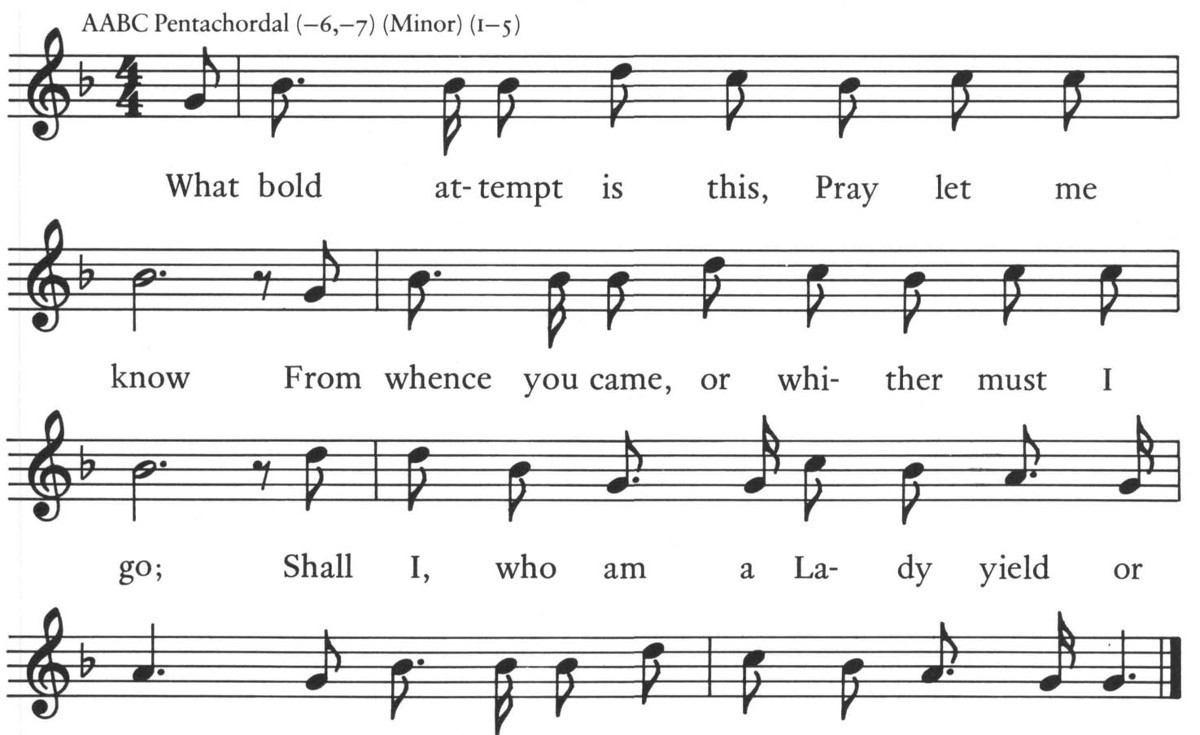
Fig. 204. The voice of the Lady from A Dialogue between Death and a Lady set to the tune “Death and the lady.”
The Lady of the previous ballad was not a New Englander. In her final words she lamented,
My carnal Life makes me afraid to die . . .
And tho’ I do deserve thy righteous Frown,
Yet Pardon, Lord, and pour a Blessing down.
The true believer had quite a different attitude and welcomed a release from the cares of life. This attitude is expressed with almost baroque fervor in the broadside A Hymn, Composed by the Reverend Mr. Whitefield (n.p.) (fig. 205).131 The words were actually written by Charles Wesley132 and not by the popular evangelist who died at Newburyport, Massachusetts, on his seventh trip to the colonies. The lines, however, expressed the latter’s thoughts. At least three eighteenth-century New England composers including William Billings set these words to music and a number of folk tune versions also came into being. Here the verses are set to a melody with interesting held “gathering notes” on the first words of each line. The air was notated from the singing of two Baptist Church elders in Clay County, Kentucky, in 1937 and is one of the few eighteenth-century broadside ballad texts surviving in the oral tradition (fig. 206).133
Lord Bakeman or Young Beichan (Child ballad no. 53) which circulated as a broadside seems to have enjoyed greater popularity the older it became. It was one of a large folk song category about maidens who rescue heroes from dire plights. Young Beichan has become Lord Bakeman, a nobleman from India in the undated broadside discussed here (fig. 207).134 Presented with it is a Vermont version of the tune collected by Helen Hartness Flanders (fig. 208).
A ballad relating a dramatic story of life aboard a naval vessel was published as The Happy Ship Carpenter (n.d.) (fig. 209).135 The verses describe the adventures of a young seaman who falls in love with a merchant’s daughter, but:
Fig. 208. Lord Bakeman set to a Vermont folk tune of the same name, collected in the twentieth century.
Now when her father came to know,
His daughter lov’d this young man so,
He caus’d him to be press’d at sea,
To keep her from his company. (pt. 1, st. 6)
Disguising herself as a surgeon’s mate, however, the enterprising daughter joined the vessel on which the object of her affection was a ship’s carpenter. When he was wounded in a naval fight she looked after him and was responsible for his recovery. At last both returned and all was forgiven.
According to an early British broadside in the Pepys Collection at Magdalene College, Cambridge, England,136 the ballad was sung to “The spinning wheel.” Although the long meter four-line American imprint requires some stanza adjustment to the long meter six-line air from Pills (fig. 210), such inconsistencies did not worry colonial ballad singers.137
Ballads concerned with the sea were understandably popular in England and New England. Found in both chapbook138 and in broadside form, The Factor’s Garland (n.d.) (fig. 211) was another favorite. Margaret Olney notated a charming melody in Mattawamkeag, Maine, in 1941, from a singer who remembered fifty-two of the fifty-seven stanzas (fig. 212). The story matches the adventures of Sinbad the Sailor. At one point a jealous captain throws the hero into the sea, but fortunately
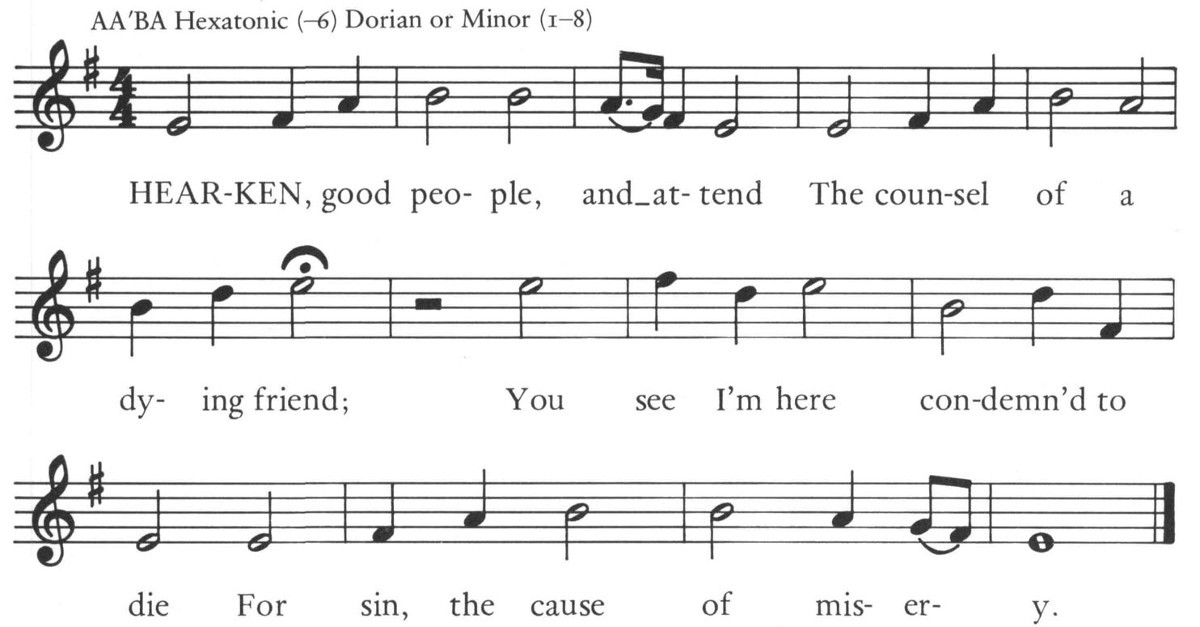
Fig. 215. Christian Exercises, second part of The Execution Hymn, matched to the tune “Retirement.”
There happ’ned to be a small Island at hand,
Whereunto he swimmed as I understand,
But here we will leave him a while for to mourn,
And unto the Ship now again we’ll return. (st. 32)
The very next Morning as Day light did peep,
He waked this young Lady out of her sleep;
He said, Noble Lady, the Factor’s not here,
He is fallen overboard and drowned, I fear. (st. 33)
Sea chantey broadsides are not included, because they were practically nonexistent. The chantey sung in chorus to give a rhythmical beat for men pulling ropes or pushing the capstan was certainly important; Blow the man down, Rio Grande, The Wide Missouri, and Haul on the Bowline belong to a significant part of America’s folk tradition, but they would not have been of much interest to country maids in the heart of Massachusetts. Chanteys were legion but they seldom got into print, partly because some were indecent and partly because others were local in character, dealing with life at sea including the unpleasant habits of unpopular officers. They were heard on rivers and they migrated to lumber camps where living conditions were similar and crudeness was not an affront.
v ballads of crime and moral exhortation
The category of moralist ballads includes both hymns and funeral elegies which were sung as well as read.139 Death by drowning and fire caused versifiers to produce broadsides; likewise, criminal offenses had a large audience. Hanging ballads too go back many centuries and American colonists continued the tradition. To have a culprit confess his sins and ask forgiveness was welcomed by law-abiding, churchgoing citizens. Even if a prisoner did not relent, “moral fakements” were frequently produced by versifiers spurred on by clergymen anxious to gain credit for saving souls. Sometimes a number of recantations were printed before a convicted person went to the gallows.
The hanging of Levi Ames, for instance, resulted in at least five broadsides, the initial one containing a special hymn sung to the prisoner in jail together with a “dying soliloquy” on his “wonderful conversion.” The others consisted of three moral fakements and a death speech by the condemned man. The first is The Execution Hymn . . . By Elhanan Winchester (fig. 213) whose verses stressed a theme which was most apt for a conversion:
Come, see the pow’r of Christ, the King,
When on the cross the Sav’or hung,
Jesus a dying thief did bring
To own him with his heart and tongue. (st. 1)
Thus Jesus Christ forgave the thief,
And shew’d great mercy to the man,
So in the midst of woe and grief
His joy and happiness began. (st. 6)
Oh how he sings the Sav’or’s praise,
Who took him at the very last,
When he his youthful time and days
In Satan’s ways and sin had past. (st. 9)
The woodcut on the broadside of a man on the gallows and the executioner descending a ladder must have helped the sale of the broadside.
Although Elhanan Winchester did not indicate an air, the ballad has been matched to the pentatonic tune “Penitent” (fig. 214), which Gilchrist compares with Cecil Sharp’s recoveries of “Little Musgrave,” variants b and h.140 The words set to “Penitent” in the early nineteenth century were similar to those of The Execution Hymn: “Show pity Lord! O Lord, forgive.”
In the lower portion of the broadside the verses entitled The Christian Exercises and Dying Soliloquy and signed L. Ames are an example of a “ghosted” confession and conversion. The Rev. Winchester stated in the broadside’s “foreword” that it had “been read to him and approv’d of since he received sentence of Death” and furthermore that it was “now published at his Desire.” The condemned burglar was probably only too ready to sing the ballad if it might help him enter the Kingdom of Heaven.
A tune entitled “Retirement” (fig. 215) is appropriate to the sentiments of The Christian Exercises and Dying Soliloquy. “Retirement,” lacking a text and related to the tune “Davisson’s retirement” in Kentucky Harmony (Harrisonburg, Va., ca. 1815),141 was found by Annabel Morris Buchanan in an eighteenth-century American manuscript tune book.
The first of Levi Ames’ three moral fakements was An Exhortation to young and old (n.p., n.d.) (fig. 216).142 The religious folk song tradition so perceptively studied by George Pullen Jackson again suggests a ballad tune. A pentatonic air appropriately called “Converted thief” or “Deep spring” and reminiscent of “Lord Thomas and fair Eleanor” and “Little Musgrave and Lady Barnard” has been selected (fig. 217). Its printed source is the Knoxville Harmony of 1838.
The second moral fakement ballad with words of warning, again in common meter, was The Dying Groans of Levi Ames (? Boston, ? 1773) (fig. 218). The old Scottish folk song “The broom, the bonny broom”143 fits well the mood of the verse; it is given in figure 219 as it is found in The English Dancing Master (1651). This tune also appears as air no. 6 in Andrew Barton’s The Disappointment (Philadelphia, 1767).
The third moral fakement, historically the most interesting of the broadsides connected with the unfortunate burglar, is Theft and Murder! (Boston, ? 1773) (fig. 220). The author, more concerned with the Boston Massacre of 1770 than the burglary of 1773, juxtaposed the punishment of Levi Ames with the fact that the British troops who killed five civilians on March 5, 1770, had not been hanged. The soldiers, guilty only of manslaughter, were vilified as murderers in stanzas 3 and 8.
The text has been matched to a folk song entitled “Shouting hymn” from Ingall’s Christian Harmony (Exeter, N.H., 1805) (fig. 221) and it can be found in six or seven nineteenth-century collections. This hortatory, heptatonic, aeolian tune shows a kinship to such carols as “Come all you worthy Christians.”144
The last Levi Ames broadside is The Speech of Death to Levi Ames (Boston, ? 1773) (fig. 222). Ames is warned by Death of damnation, darkness, horror, fire, chains, almighty wrath, and endless pain. At the top of the sheet there is a woodcut depicting a skeleton and a gentleman with a wig dressed in early eighteenth century clothes. The apparition introduces himself and comes right to the point:
I[,] Death, Poor Ames, pronounce your Fate,
Thus grining grimly through your Grate.
Remember all the Crimes you’ve done,
And think how early you begun.
Lost in the grand Apostacy,
You were at first condemn’d to die;
In adding Guilt you still went on:
I doubly claim you for my own. (st. 1)
Two-thirds of the way through a preacher breaks into the conversation and promises salvation to the burglar if he will allow Jesus to be his only Support.
Pardon and Life are His to give,
’Tis thine, Poor Sinner, to believe.
Let Death in all it’s Dread appear,
Though public Execution’s near. (st. 7)
The musical setting used here, “Stinson the deserter” (fig. 223), derives from a folk song associated with the “Death and the lady” tune family. A performer’s edition is given. It is in the tradition of “Fortune my foe” and has a mournful melisma suiting the spirit of the execution.145
vi humorous ballads and The Dying Words of Captain Kid
Part ii above included songs of political satire such as Peter Zenger’s A Song made upon the Election and Dr. Benjamin Church’s The Parody Parodized; or, the Massachusetts Song of Liberty. Americans have also enjoyed satirical and humorous songs bordering on the ridiculous. The earliest example of appreciation for the absurd in broadside form, found on paper watermarked “1739,” is Father Ab——y’s Will and A Letter of Courtship (n.p., after 1739) (fig. 224).146
John Seccomb (Harvard class of 1728)147 was responsible for Father Abbey’s stanzas while John Hubbard of New Haven is generally credited with “A Letter of Courtship” to Father Abbey’s relict from the Yale sweeper. The evidence found by George T. Goodspeed, however, led him to believe that Seccomb was the author of the second part too.148
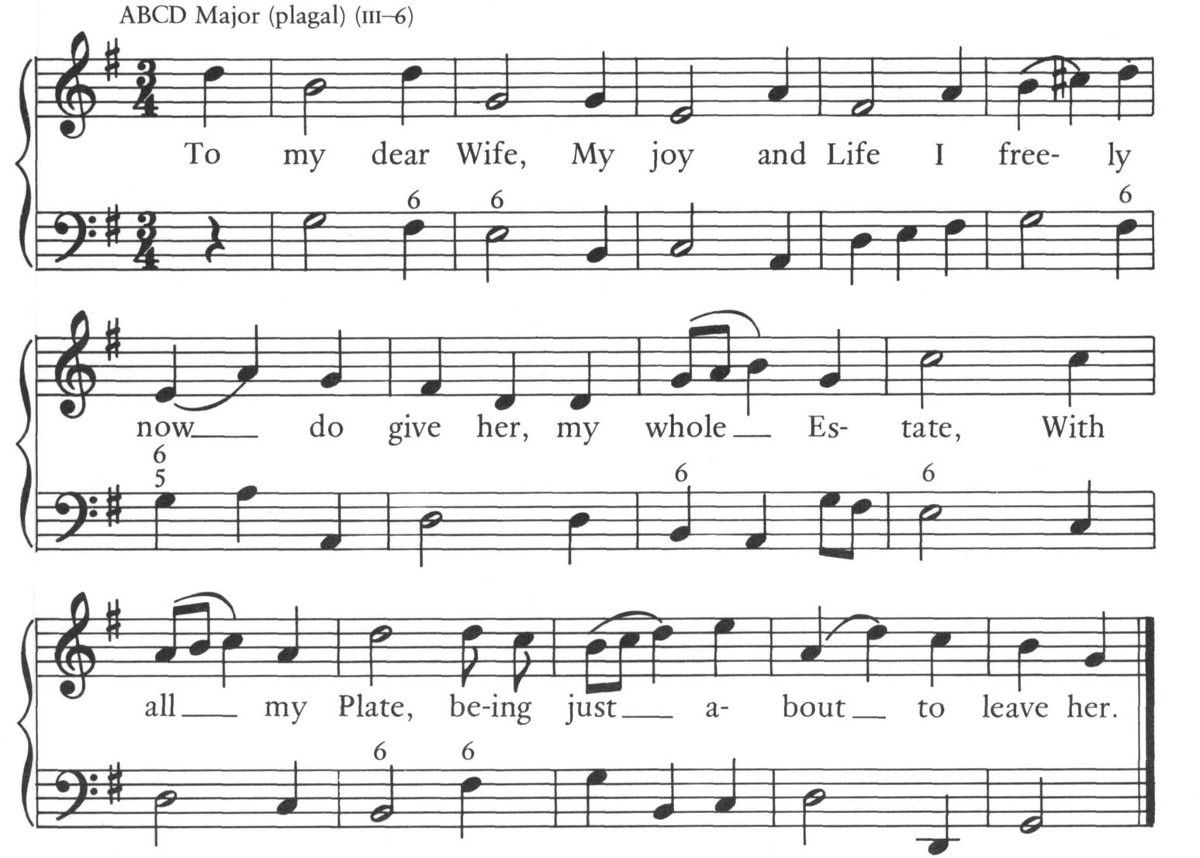
Fig. 226. Father Abbey’s Will, part i, set by W. Markham to the tune “The last will and testament of Mr. Matthew Abdy [sic]. . . .”
Goodspeed’s extremely useful paper delivered at the Massachusetts Historical Society in 1961 lists twenty-five broadsides and seven or eight early printings in newspapers and magazines. Although they are difficult to date, no more than ten editions appeared prior to 1790. The spelling and text of figure 120 most closely follow the first printing of “Father Abbey’s Will” in the Boston Weekly Rehearsal for January 3, 1732, which did not include the Yale sweeper’s strains.
As ties between England and the colonies were close, part i was published in the Gentleman’s Magazine in May 1732, and the sequel “from the Sweeper of the College of New Haven” followed suit in June. The former also appeared in the London Magazine for May 1732, and part ii in the same periodical for August—all in all rather unusual coverage for a humorous ballad. The ridiculous verses continued to be published well into the eighteenth and nineteenth centuries. In London in 1782 the loyalist Samuel Curwen (Harvard class of 1735) bought an English edition (ca. 1780) of “Father Abbey’s Will” considerably altered and without the New Haven epitaph; it is entitled Old Timothy Jobson (fig. 225).149
Goodspeed did not discuss the musical aspects of “Father Abbey’s Will,” and judged the stanzas as poetry rather than as rhymes for a song. This led him to conclude that it was “a wretched exercise in bad taste, deserving oblivion.”150 He had clearly forgotten Bronson’s “Question: When is a ballad not a ballad? Answer: When it has no tune.”151
Writers of broadside verse in the colonies knew that musical tunesmiths could be found in London. It was there that the earliest musical setting of the stanzas known to this writer appeared in 1732. The final song, entitled “The last will and testament of Mr. Matthew Avery”—an obvious misspelling of Abbey’s name—was printed in The Merry Mountebank . . . by Timothy Tulip of Fidlers-Hall in Cuckhold-Shire . . . London 1732.152 The setting by W. Markham, about whom nothing is known, has a pleasant lilt in  time. The Merry Mountebank was among a sizable inventory including instruments as well as music offered for sale in the Boston Gazette for June 28, 1764, by an unidentified gentleman from London. Part i of Father Ab——y’s Will has been set to this melody (fig. 226).
time. The Merry Mountebank was among a sizable inventory including instruments as well as music offered for sale in the Boston Gazette for June 28, 1764, by an unidentified gentleman from London. Part i of Father Ab——y’s Will has been set to this melody (fig. 226).
Although the verses of Father Ab——y’s Will have persisted in the folk tradition of the United States, they have not been found with Markham’s air. A version set to “Yankee Doodle” was published by Oliver Ditson about 1850; Helen Hartness Flanders heard the verses sung to “The girl I left behind me” in Rhode Island in 1945.153 This marching melody which can be traced to the 1790s has a pleasant casual feeling but is not quite right for the text.
A fiddle-tune flavor, however, is in keeping with the spirit of this broadside, for fiddle tunes were frequently adapted to secular and even sacred words. For this reason “Mecklinburg” or “The rose tree” has been chosen as an alternate to Markham’s air (fig. 227). A somewhat more impatient tune, it fits appropriately the Yale sweeper’s “Letter of Courtship” and its infectious gaiety gives variety and contrast to the second part of the broadside.
Another song which satirized society in general as well as civil and Christian hierarchy was known as The Pope’s Pedigree, the verses harking back to Wit and Drollery: Jovial Poems (London, 1656). In the colonies, coarse verses ridiculing lawyers were not unwelcome; it was to this end that those from The Pope’s Pedigree were turned. They appeared in New England in 1755 entitled The Lawer’s Pedigree, Tune, Our Polly is a sad slut (1755) (fig. 228).154
The tune specified is air no. 7 from The Beggar’s Opera (1728) in which Peachum and his wife revile their daughter for marrying Captain MacHeath. John Gay and his musical colleague J. G. Pepusch had taken the popular tune “London is a fine town” or “Watton’s end” into their celebrated musical satire, but the words and melody of Peachum’s song became so well known that the air was more often referred to as “Our Polly is a sad slut.”155 The version to which The Lawer’s Pedigree is fitted (fig. 229) is derived from a 1729 edition of the famous ballad opera.
The last witty broadside to be discussed was actually issued in the early nineteenth century and concerns the practice of bundling. Bundling began in colonial days when people paid calls on winter evenings. Rooms were cold and the older people preempted the best places by the fire; the young people often got into bed together under covers without undressing to keep warm. This practice evoked criticism and led to the publication of the broadside A new Bundling Song (Boston, ? 1812) (fig. 230). The author, while censuring the practice of bundling, is primarily poking fun at country people, and his satire is indeed amusing.
No tune is indicated, but “A la mode de France”156 is found in all eighteen editions of Playford’s Dancing Master between 1651 and 1728, and also in volume i of Loyal Songs (London, 1731), page 25. The version given here (fig. 231) is based on tune variants found in both Sharp, Country Dance Tunes, and Simpson, British Broadside Ballad. The original text to the tune was a Puritan satire on monarchy. Playford’s collection greatly influenced colonial folk tunes, and this saucy air, which suits the spirit of the Bundling Song, has an appealing eighteenth-century flavor.
Fittingly, the last broadside to be considered concerns the most famous pirate in American history, Captain Kidd.157 William Kidd was born in Scotland about 1645; by the 1680s he had established himself as a shipowner with a family and property on Manhattan Island. His success against French privateers in the West Indies gained him a reputation as a “mighty man,” and in 1691 he received a gift of £150 from the New York Provincial Assembly for his services against the insurgent Jacob Leisler.
The British Navy in the early 1690s, preoccupied with war against the French, was unable to attend to the many complaints of English merchants regarding piracy and one way of combatting the situation was by licensing privateers to capture them. Kidd, who had run a packet line between the colonies and the Mother Country, happened to be in London in 1695 when Robert Livingston, a member of the New York Council, was there; the latter recommended the sea captain to Richard Coote, Earl of Bellomont, about to be appointed governor of New York and New England, as “a bold and honest man, and he believed fitter than any other to be Employ’d”158 for eliminating piracy and capturing foreign merchant vessels unfriendly to England. Bellomont created a joint stock company with Lord Chancellor Sir John Somers, the first lord of the admiralty, two secretaries of state, Livingston, and Kidd. By the articles of agreement Kidd became captain of a new ship with thirty-four guns, the Adventure Galley, his task to capture or kill pirates and bring in enemy ships as prizes. At the last moment the British Navy impressed most of the carefully chosen crew and Kidd had to be satisfied with “men of desperate fortune and necessitous in expectation of getting vast treasure.”159 A contemporary predicted, “’twill not be in Kidd’s power to govern such a hord of men under no pay.”160
In time the adventurers captured six ships. The richest prize, the Quedagh Merchant, an Armenian vessel of four hundred tons with the French flag at her masthead, yielded a cargo worth some £70,000. Kidd later discovered, however, that the registration was specious; she was actually in the employ of the East India Company and sailing under false colors. Flying the French flag, the Quedagh Merchant was a legitimate prize for an English privateer. But when news regarding the huge merchantman reached London, the East India Company’s directors complained violently of “this act of piracy”161 and arranged to have a warrant issued for the arrest of Kidd and his men.
Just when Kidd became aware of the warrant is not clear, but in due course he paid off his crew and returned with a few of the more loyal men to Hispaniola, where he left the Quedagh Merchant with the bulk of the “treasure” in a secluded cove. His next step was to purchase a small sloop and after a few weeks he dropped anchor in Oyster Bay, Long Island, where he got in touch with an admiralty lawyer, John Emmot. The latter went to Boston to talk with the Earl of Bellomont, carrying a letter from Kidd stating that he could prove his innocence. The governor showed it to members of the council and with their approval the Captain was given a safe-conduct.
He arrived in Boston early in June 1699, having entrusted a small treasure to John Gardiner of Gardiner’s Island. Bellomont questioned Kidd, his partner of the joint stock company, and tried to find the exact location of the Quedagh Merchant. In view of the warrant and Bellomont’s hostility, Kidd refused to reveal its whereabouts, although he spoke of the gold and silver and jewels left at Gardiner’s Island. A few days later he found himself in jail; Bellomont had broken his word. Kidd then offered to go “as a prisoner” to the West Indies and return with £40,000 insisting that otherwise all would be lost. Bellomont, however, refused, and, after eight months in prison, the captain was returned to England for trial.162
Kidd’s capture offered the opposition party excellent opportunity to discredit the Whig governor and his associates. If the captain were to accuse those who had financed the major costs of the undertaking, he was told he would go free. This he refused to do; and after eleven months in Newgate, Kidd was brought to trial at Old Bailey. As matters unfolded, Kidd was charged with the death of a mutinous gunner, William Moore, and “the judge directed the jury that it was done with malice prepense and was therefore murder.”163
He was also accused of piracy, but since the admiralty had confiscated the captain’s papers immediately upon his arrival in England, Kidd had no way of proving that some of the vessels he had captured had flown the French flag. “Over 200 years later, the originals were discovered among manuscripts of the Public Records Office. The papers, it seems, had been deliberately suppressed.”164
Captain Kidd had his own code of ethics. “Had he given evidence against the Lords who had contributed to the venture he might have been pardoned, but he proclaimed his innocence and was truculent.”165 English justice in this matter was politically biased. Kidd “had no properly constituted legal adviser as counsel; the only witnesses against him were two of the Adventure Galley’s men”166 who were eager to save their own necks. Found guilty of murder and piracy on May 8th, he was hanged at Execution Dock on May 23, 1701.
Kidd’s death was unusually dramatic. The first time he was suspended, the rope broke and the gallows became unusable. Awaiting a new cord, he addressed the crowd and “expressed hopes of salvation through the merits of his Redeemer,” saying that he “dy’d in Christian Love and Charity with the world.”167 As was to be expected, ballads circulated after his death on both sides of the Atlantic. The Rev. Mr. Paul Lorraine had tried to extract a confession from the privateer captain before his demise but was unsuccessful.168 Indeed, immediately after the judge sentenced him, Kidd had declared: “I am the innocentest Person of them all, only I have been sworn against by prejudiced Persons.”169 This did not bother the clergy or the authors of confessional ballads; the “moral fakement” produced almost overnight became world famous.
The oldest extant broadside is an English edition probably dating from 1701: Captain Kid’s Farwel to the Seas. . . . To the Tune of Coming Down (fig. 232). Early editions of the Captain Kidd broadsides in this country have not survived, but there is a relatively late eighteenth-century version, The Dying Words Of Captain Kid (fig. 235). A comparison between the English and American verses is instructive:
My name is Captain Kid, who has sail’d (who has sail’d)
My name is Captain Kid, who has sail’d
My name is Captain Kid,
What the laws did still forbid
Unluckily I did while I sail’d (while I sail’d). (st. 1, London imprint)
My name was Robert Kid, when I sail’d, when I sail’d,
My name was Robert Kid, when I sail’d;
My name was Robert Kid, and God’s laws I did forbid,
And so wickedly I did, when I sail’d. (st. 2, Boston imprint)170
The amoral, mocking tone of the British imprint is in direct contrast to the moral, confessional tone of the North American version.
No contemporary copy of the “Coming down” air specified in Captain Kid’s Farwel has survived, but there is evidence to connect it with a tune called “Chimney sweep,” associated with a sweep by the name of Jack Hall who was hanged for burglary in the same year as Kidd.171 The “Chimney sweep” is mentioned by D’Urfey in Pills (1719–1720), ii, 182; unfortunately, however, the tune is not notated there. Simpson suggests that the tune “Put in all,” from Pills (1714), v, 117 (also in Pills [1719–1720], vi, 251), and The Dancing Master, 2nd ed., ii, 121, is suitable for both the ballad written by D’Urfey to be sung to the “Chimney sweep” tune and the ballad Captain Kid’s Farewel to the Seas. Over thirty years ago Bronson suggested that the “Chimney sweep” was probably the same tune as “Put in all.”172 Captain Kid’s Farewel has been set in accordance with the above to the tune “Put in all” from Pills (fig. 233).
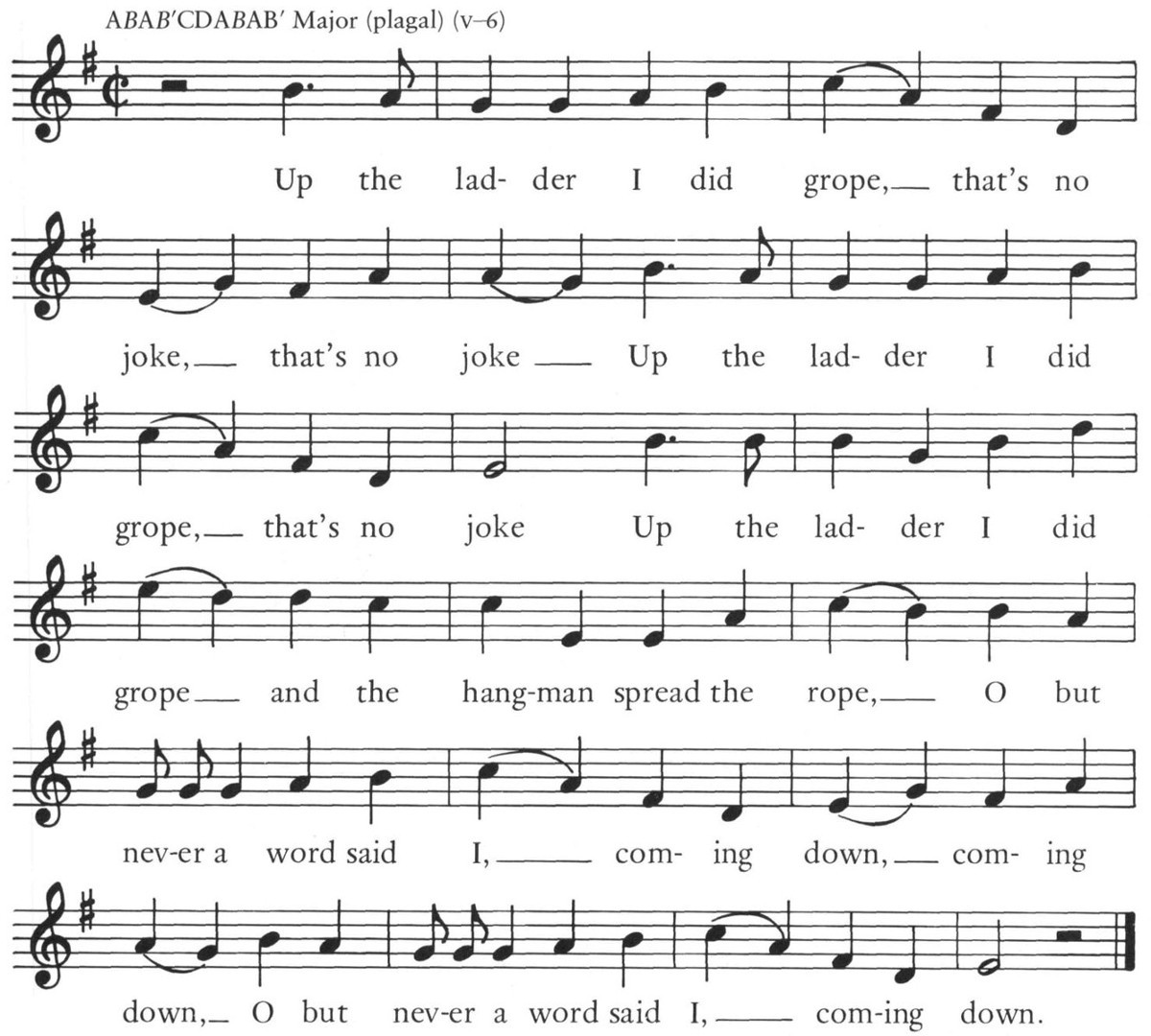
Fig. 234. “Jack Hall,” a folk song collected by Cecil Sharp.
A later folk song associated with the chimney sweep Jack Hall was collected by Cecil Sharp ca. 1907. It is interesting because it contains the key phrase “O but never a word said I, coming down.” Sharp’s version, quite different from the Pills version, is entitled “Jack Hall” (fig. 234).
The use of the same tune for secular, moral, and sacred verse is very old; the final example illustrates this point. George Pullen Jackson, as might have been expected, called attention to a tune in the Columbian Harmony (Cincinnati, 1825) entitled “Captain Kidd,” with the text “Through all the world below.” It is in the same unusual stanzaic pattern as “Jack Hall” and fits The Dying Words of Captain Kid perfectly (fig. 236). Variants of the melody are still current in our folk tradition coupled with the moralizing words placed in the mouth of the unfortunate Scottish-American sea captain.173
conclusion
Some purists have felt that for a ballad to be “genuine,” an oral tradition is mandatory, for when a folk song is circulated on paper essential ingredients may be lost. Folk singers have also objected when their ballads were published and none more strenuously than Mrs. Hogg after examining Sir Walter Scott’s Minstrelsy of the Scottish Border (Edinburgh, 1802–1803):
There was never ane o’ ma sangs prentit till ye prentit them yoursel’ and ye hae spoilt them a’ thegither. They were made for singing and no for reading, but ye hae broken the charm now and they’ll never be sung mair. And the warst thing o’ a’, they’re nouther right spell’d, nor right setten down.174
Despite these objections, most investigators recognize, perhaps reluctantly, that there are well-known folk songs which have evolved from print and especially from broadsides. This process is as old as the development of printing by Gutenberg and Caxton. Furthermore, it is not uncommon for a ballad to move from oral tradition to print, then back to the oral tradition. A good example of such a “rebirth” is William and Margaret, whose origins are found in Fair Margaret and Sweet William (Child ballad no. 74), mentioned as early as 1611 in Beaumont’s The Knight and the Burning Pestle. David Mallet’s more sophisticated treatment of the traditional stanzas was published in 1724 and immediately became popular. George Saintsbury even wrote, “no single copy of verse deserves so much credit for setting the eighteenth century back on the road of true romantic verse by an easy path, suited to its tastes and powers.”175 This ballad has survived in unwritten tradition, and Coffin, Simpson, and Bronson attest to its popularity in the United States.
Problems of many kinds are presented by the transmission of ballad tunes from flexible, oral performance to printed song sheets and broadsides and even to the findings of the most sensitive collector. A printed text, however skillfully executed, cannot capture completely the exact nature of the performance of a ballad. Nevertheless and despite the fact that singers usually learn from other singers, they do refer to written sources to refresh their memories and improve their songs; this practice is of long-standing, as we know from the many manuscript collections of “song ballets” used by medieval folk singers. And precisely because each performance by a singer may differ to a greater or lesser degree, to say nothing of differences from singer to singer, one cannot find a definitive text and tune even with modern recording equipment.
This study has presented some seventy tunes matched to nearly as many broadsides, the majority of whose verses are related to events and customs both historic and domestic in the life of the American colonies. Broadside verses were to be sung, either to a traditional tune or one currently popular which not only had the same meter but also conveyed the mood of the words, or to one fashioned for the occasion. The verses were usually presented to a group of listeners by a singer who knew how to tell a story. The singer was most frequently unaccompanied; on occasion, however, he or she was assisted by a dulcimer or cittern. In the case of some of the more militant ballads, a fife and drum provided an appropriate accompaniment.
When music was grafted onto the verse of a broadside, certain effects were inevitable. Aside from the sheer entertainment it provided, music helped the singers and listeners to remember the verses, and contributed to a rapid dissemination over the countryside, as a catchy tune does even today. The melody also served to emphasize and heighten the meaning of the poem. Finally, one must not forget the physical and emotional effects produced by various kinds of music, rhythms, and instruments in marching songs, hypnotic revivalist hymn tunes, and dirges.
Broadsides with metrical verse have long occupied a low position in the art of poetry. This is because they have been judged from a literary point of view. The fact is, however, that broadsides in meter were not generally recited or read aloud, nor were they meant for perusal or for contemplation and the unfolding of deeper meaning. They are like librettos. When their metrical rhymed lines are put to appropriate tunes they take on an immediacy and have a genuine appeal, especially for rural people. Before the era of radio and television they were one of the most important vehicles for disseminating news, and they also afforded pleasure and entertainment.
The topical ballads in this volume were chosen to provide the reader with an opportunity to examine the relationship between music and society. Because broadsides with metrical texts are rarely an eloquent literary or artistic mode of expression—such eloquence being largely the presence of the upper classes with the opportunity to indulge in refinement—they have long been neglected. And, because broadsides provided a cheap medium, they were available to all. In particular, they found a response in the man in the street, whose feelings, interpretations, and reactions were reflected in them.
In addition to topical ballads, there were hundreds of others dealing with such general subjects as vice, virtue, the supernatural, and faithful or unfaithful lovers. These have not been dwelt upon in this study partly for lack of space, and partly because insofar as the oral tradition is concerned, they have already received a great deal of attention from folklorists.176
A final word should be said about the critics of broadside dissemination. The ministers did not object to “news” or “moral” ballads (in fact, the Rev. Mr. Symmes was probably involved in the publication of The Voluntiers March), but they thoroughly disapproved of salacious broadsides. The latter have not been analyzed here, but Seaborn Cotton, who became a minister, included verses in his Commonplace Book that Admiral Morison in his article on Cotton’s manuscript177 felt it necessary to censor by replacing original words with dots! There are also lines in some eighteenth-century editions of Yankee Doodle, to name a well-known song, which are not fit for the drawing room. In an age when Puritan theocratic values were eroding and the spiritual leaders were vainly trying to keep the people “on course,” it is not surprising that “vulgar” songs and ballads were condemned. In fact, they still are.
The tunes in this study have several factors in common: a number are specified by, or have been used with, more than one broadside text, and have endured over several generations. The tune “Chevy Chase” is a good case in point. In this study alone, eight broadside texts either specifically call for it or have appropriately been fitted to variant forms. These imprints cover a span of nearly two centuries and were issued in both the colonies and England.178 The same characteristics are also found in several tune families which have been used in this study: “All those that be [or love] good fellows,” “Come all you worthy [or faithful] Christians,” “Death and the lady,” “Grenadiers march,” and “Little Musgrave” which includes here the variants “Penitent” and “Converted thief.”
Tunes are also capable of conveying associations. “Yankee Doodle,” the most familiar example, as well as “Heart of oak” were early employed to encourage patriotic fervor among the colonists. During the Revolution, “Yankee Doodle” was taken over by the Sons of Liberty as a national anthem, while the British set “Heart of oak” to Come Shake Your Dull Noddles, ridiculing the colonial patriots who, in Parody Parodized; or, the Massachusetts Song of Liberty returned the thrust. The conclusion: a good tune provides a means for conveying ideas, meanings, or associations; once it has proved its worth it is used repeatedly, and is not restricted by time, place, or nationality.
This investigation has brought to the fore a good number of broadsides and identified many of the tunes to which they were sung. Although additional research is required, enough information survives to fit ballads lacking specific tunes with appropriate melodies. Broadsides should not be deprived of the life instilled in them by music for when resuscitated they take their rightful place in the stream of our folk song heritage.
The author’s special thanks are due Barbara Lambert, who was involved beyond the call of duty over a long period with research assistance for and the editing of this study. The description of each broadside and tune as well as the footnotes owe a great deal to her.
Paul Cole reviewed all the tunes, transposed some of them, and prepared them for engraving.
The author is also most grateful to Israel Katz for analyzing the tunes and indicating their place in colonial music.
Finally, Richard J. Wolfe and Roy Lamson were good enough to look over the galleys, and the former, particularly, made a number of helpful suggestions which were heeded.

